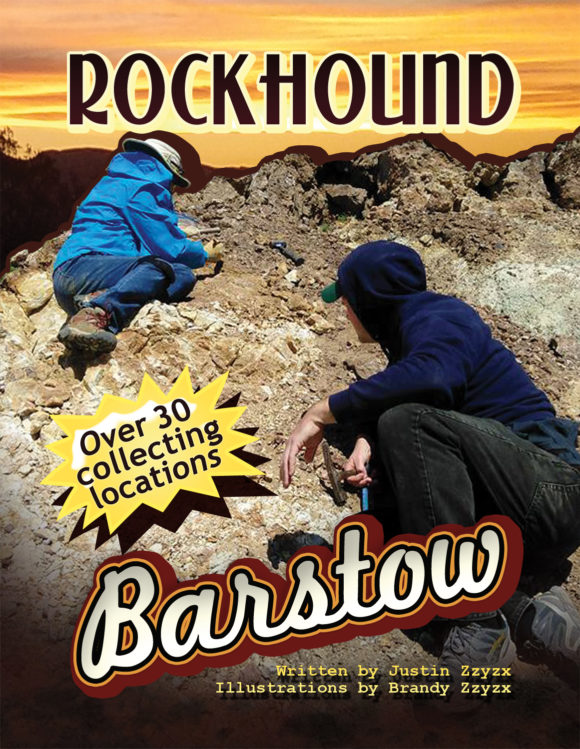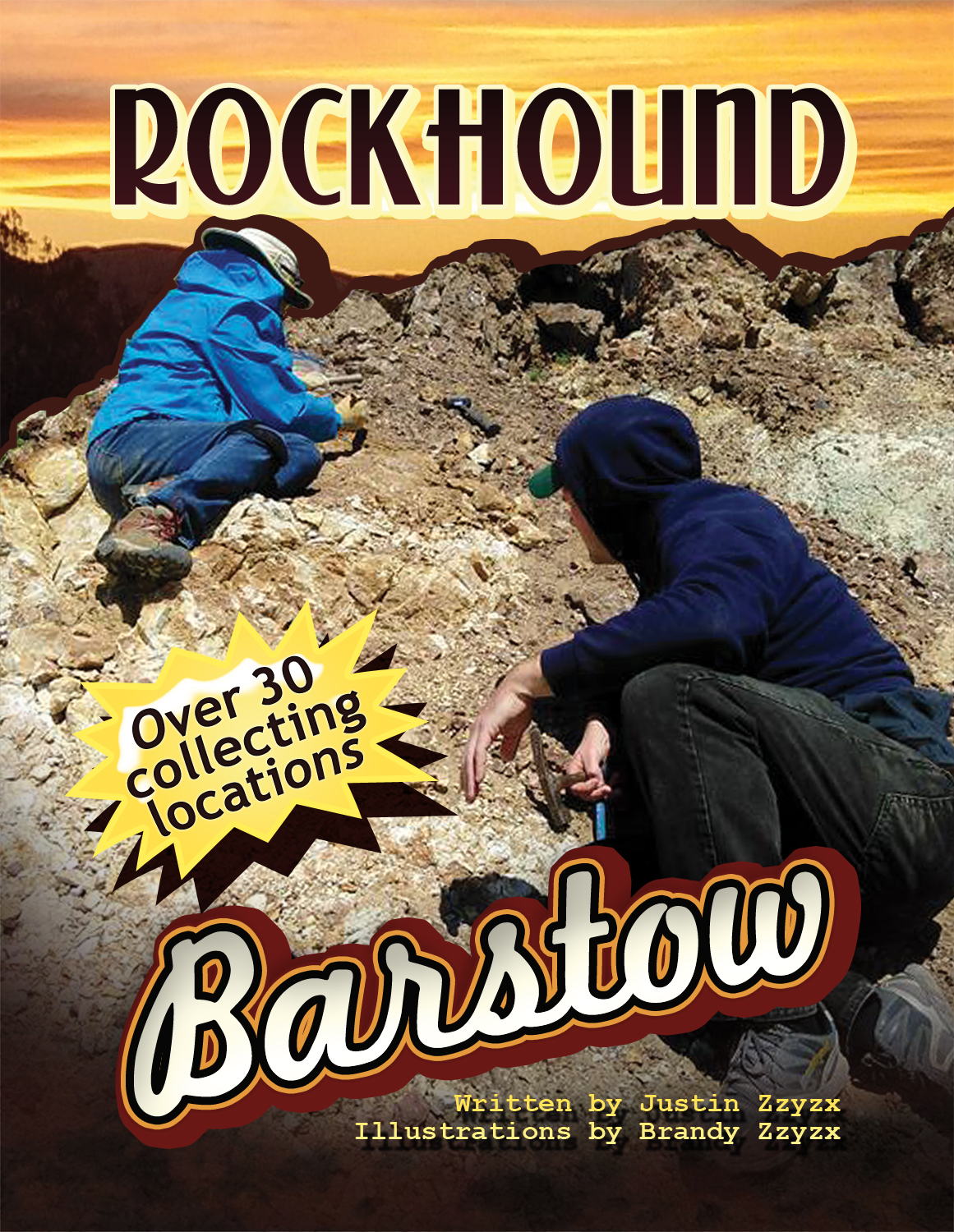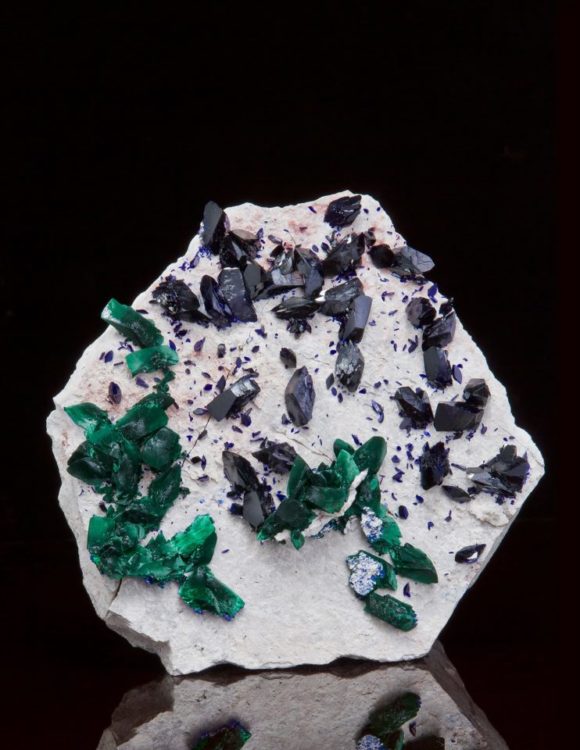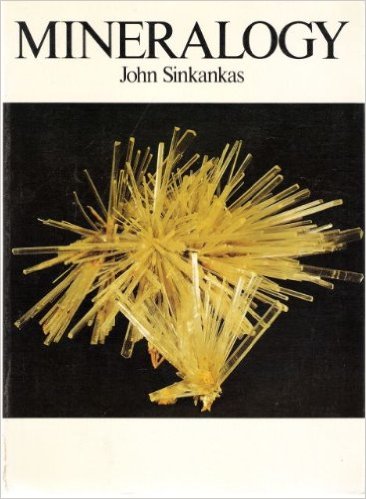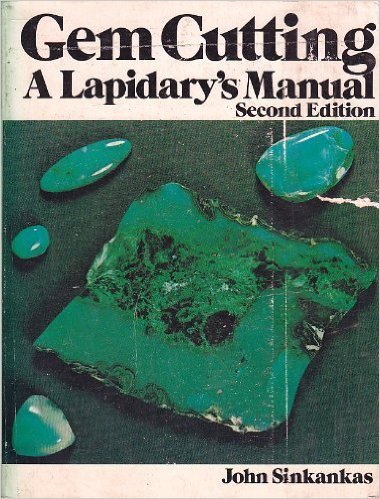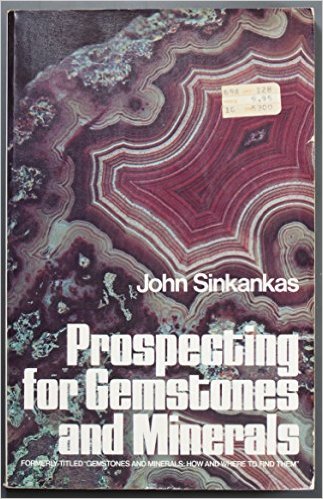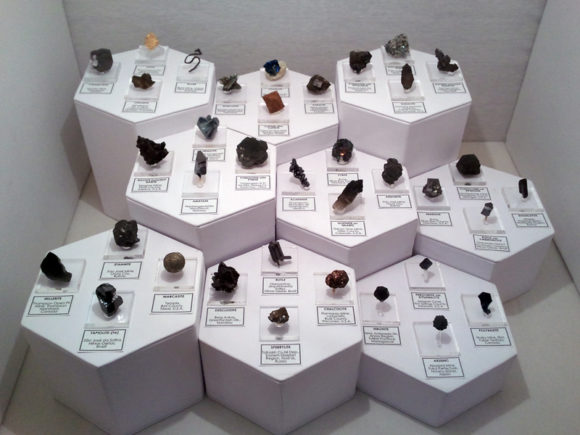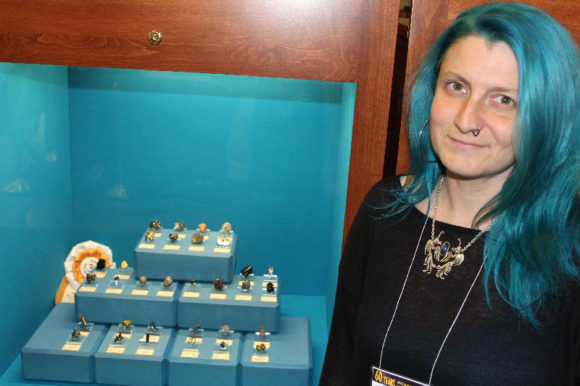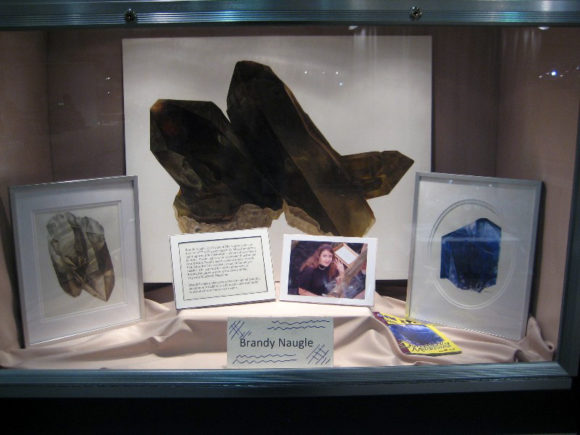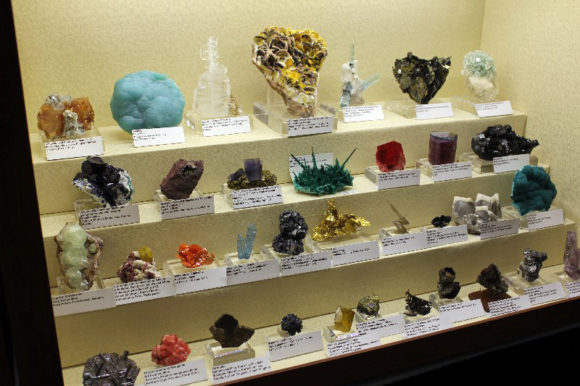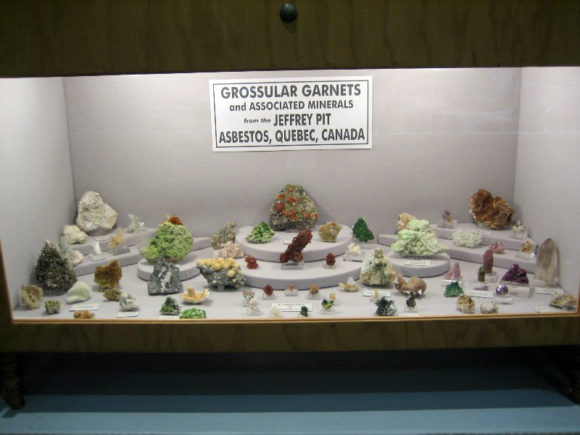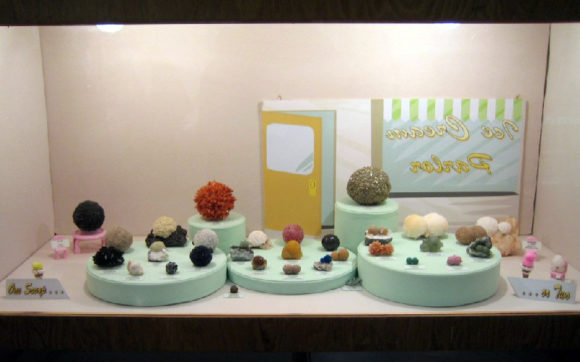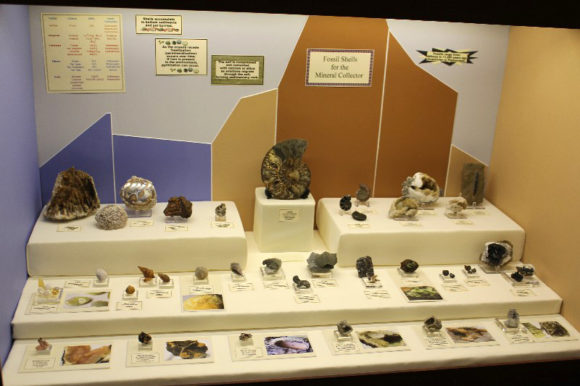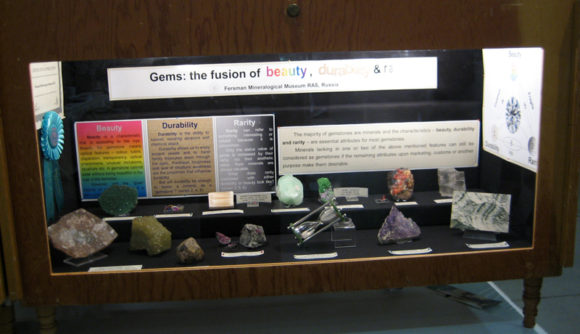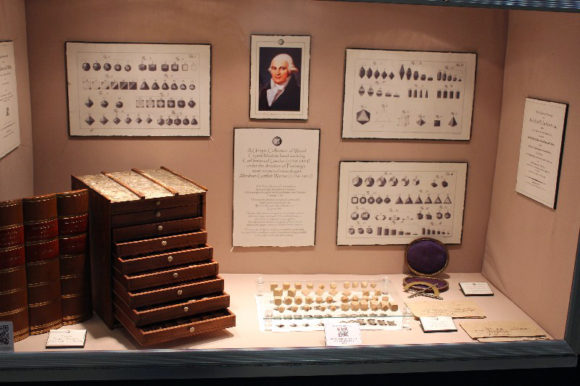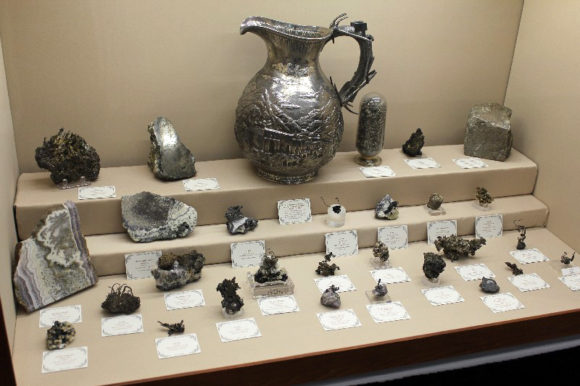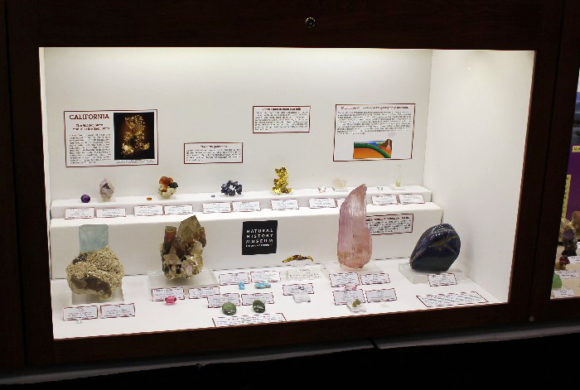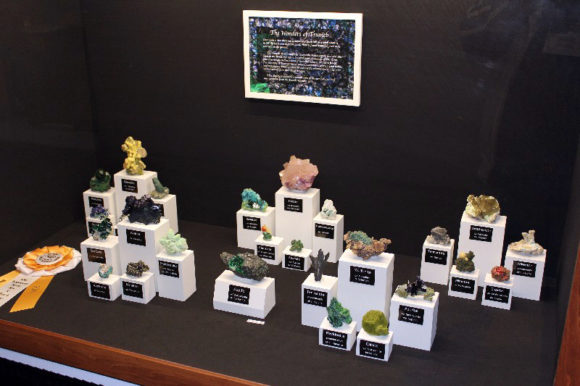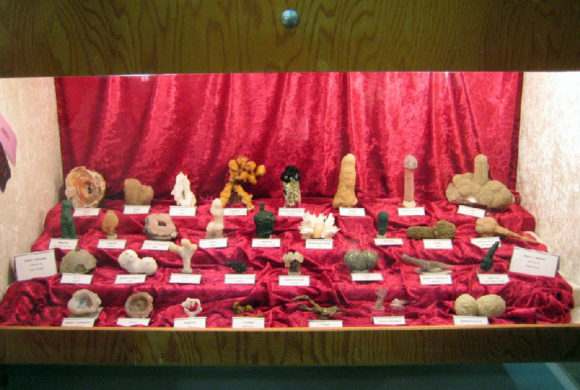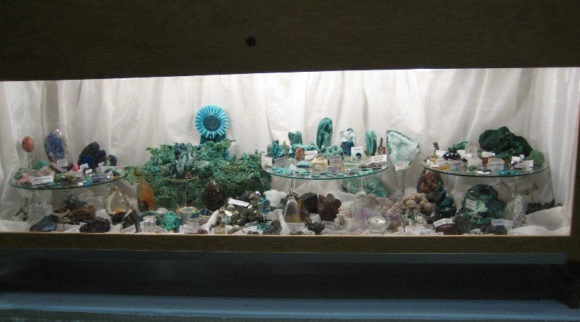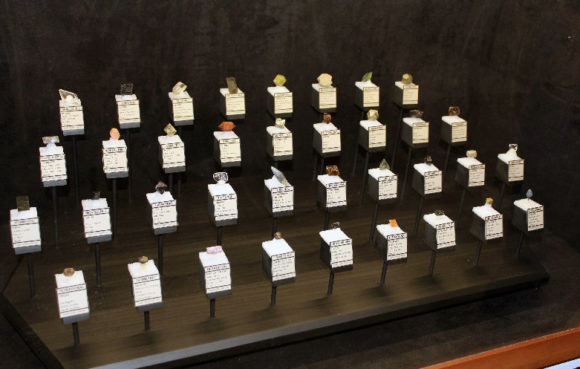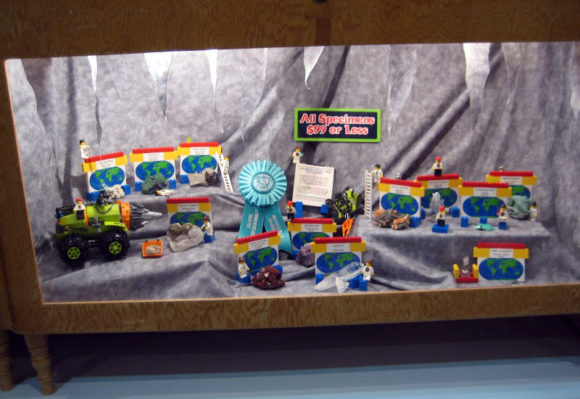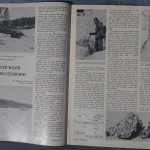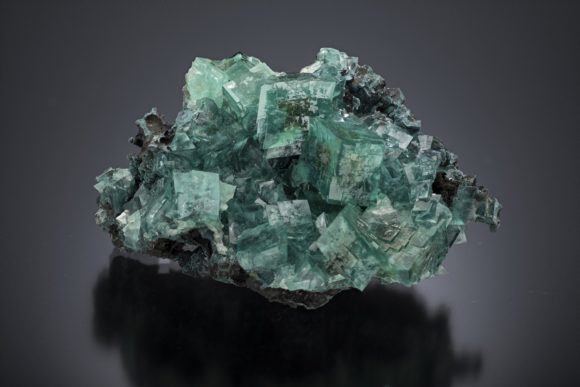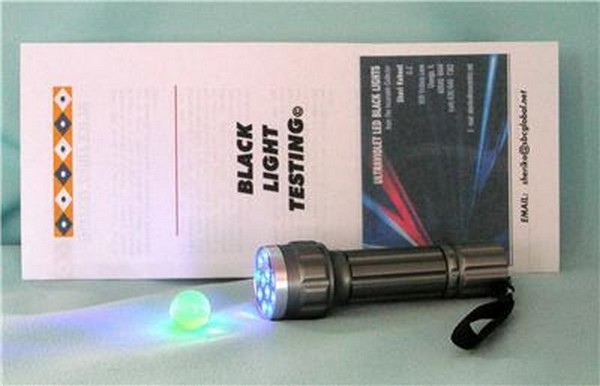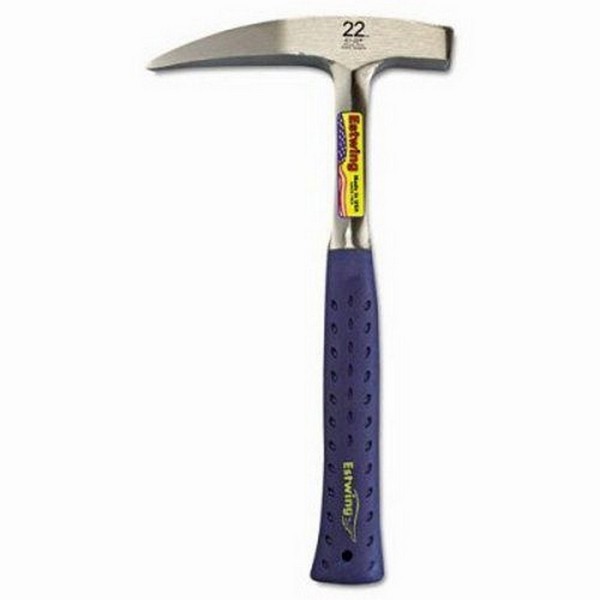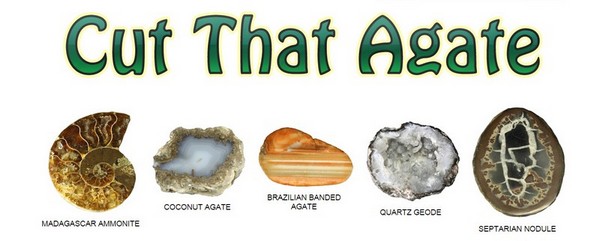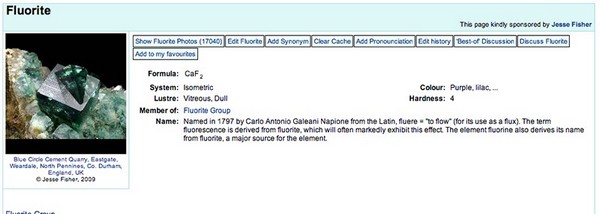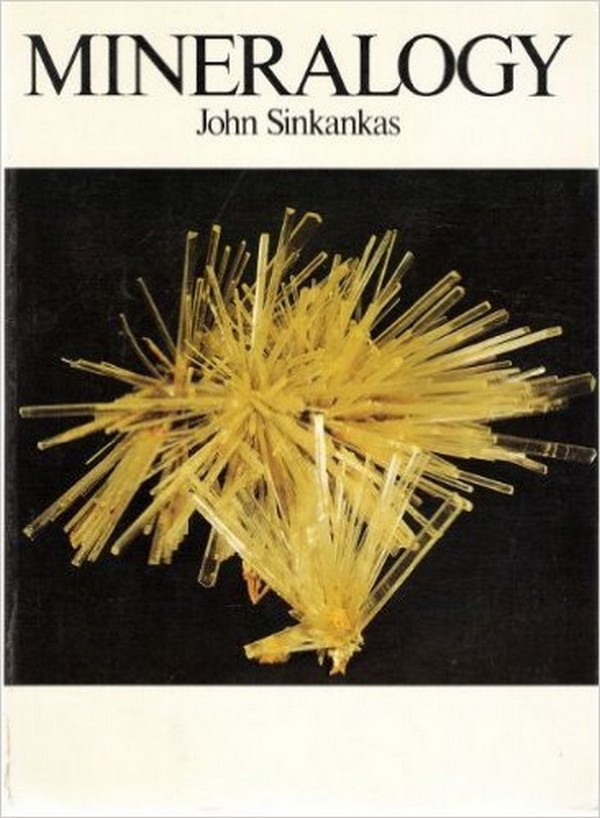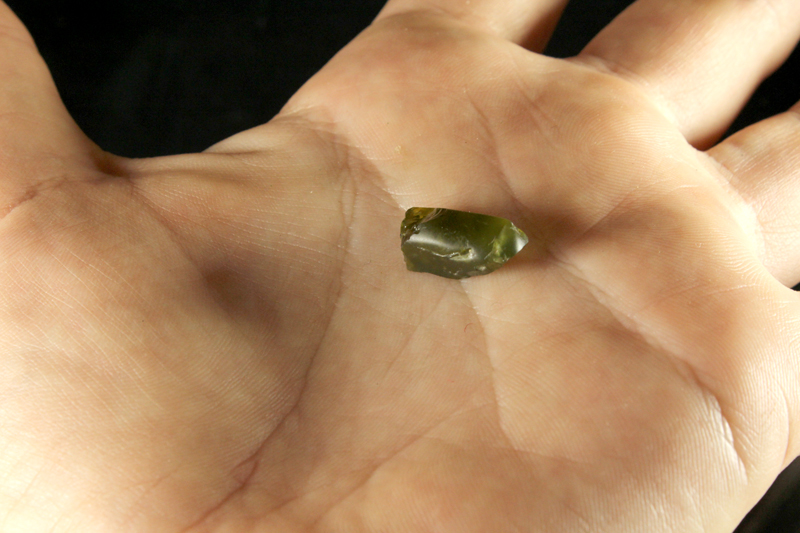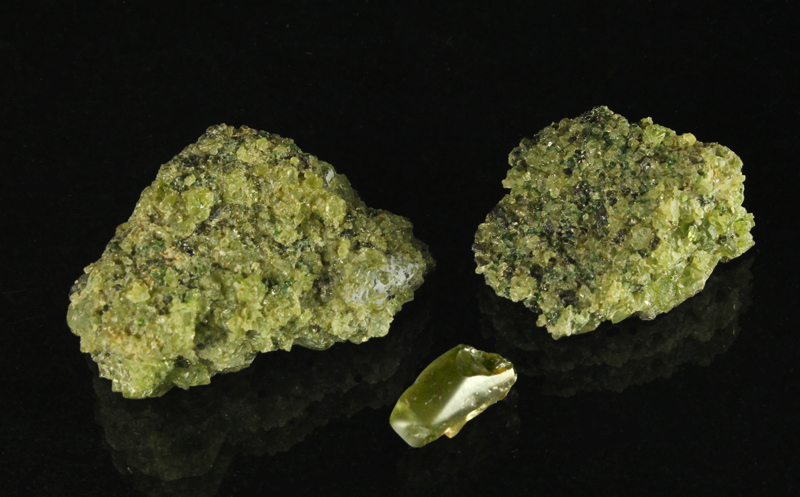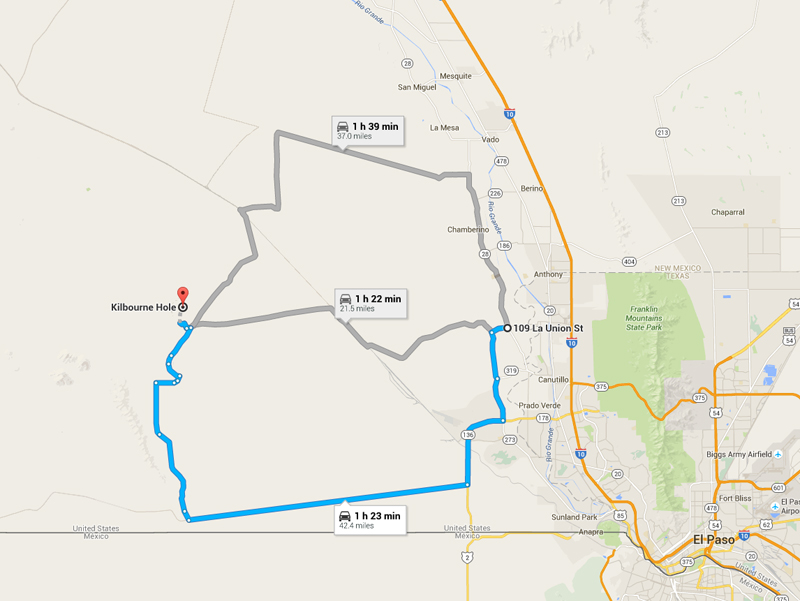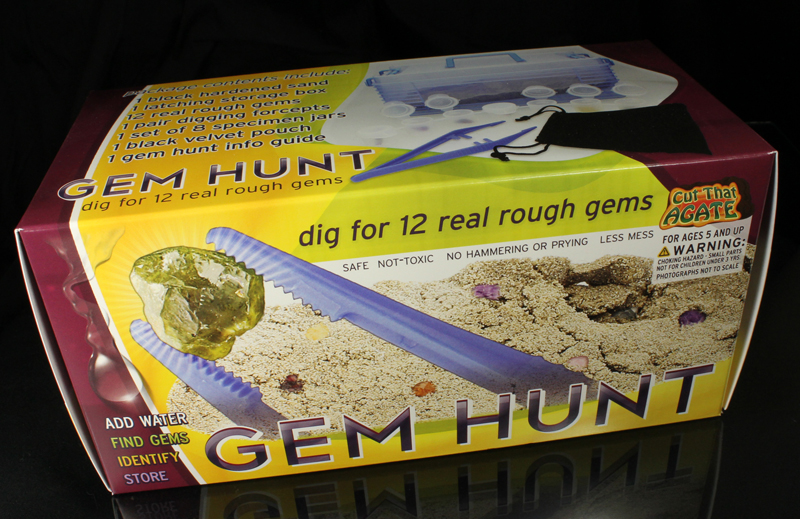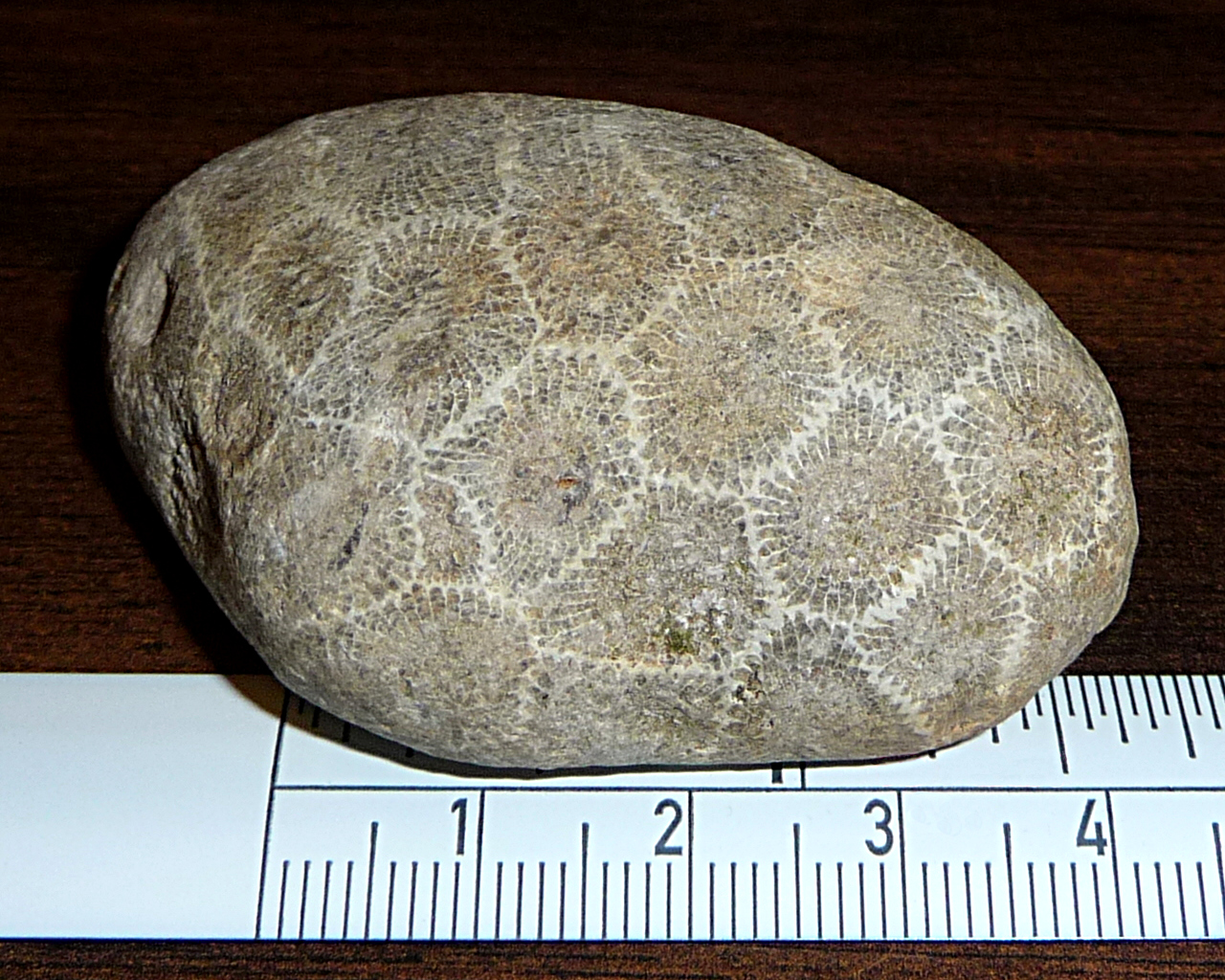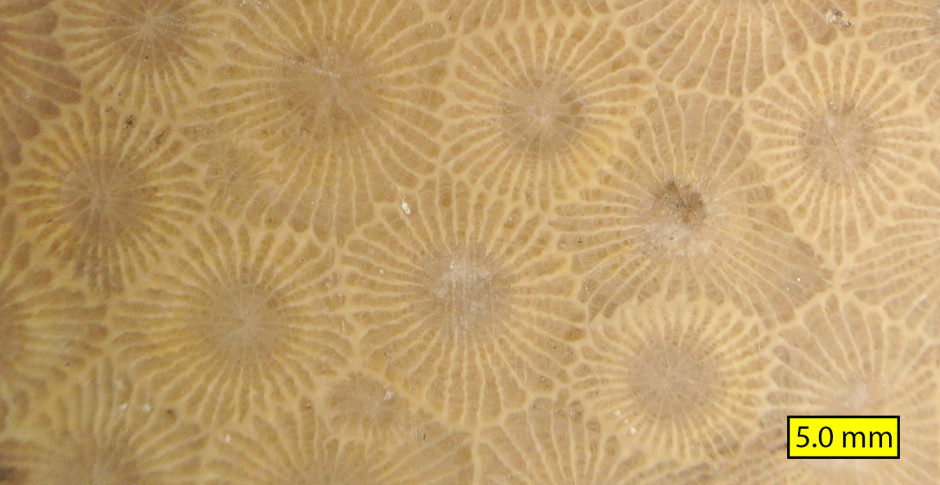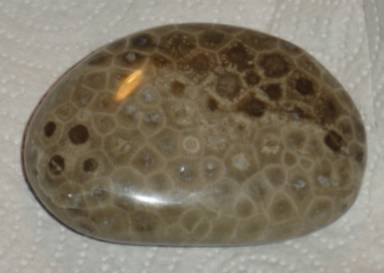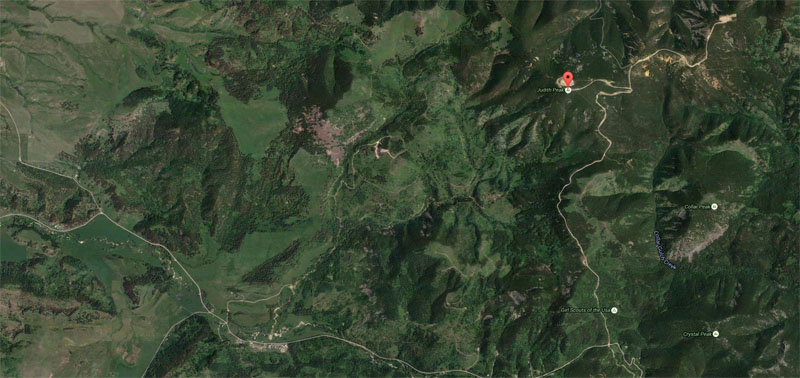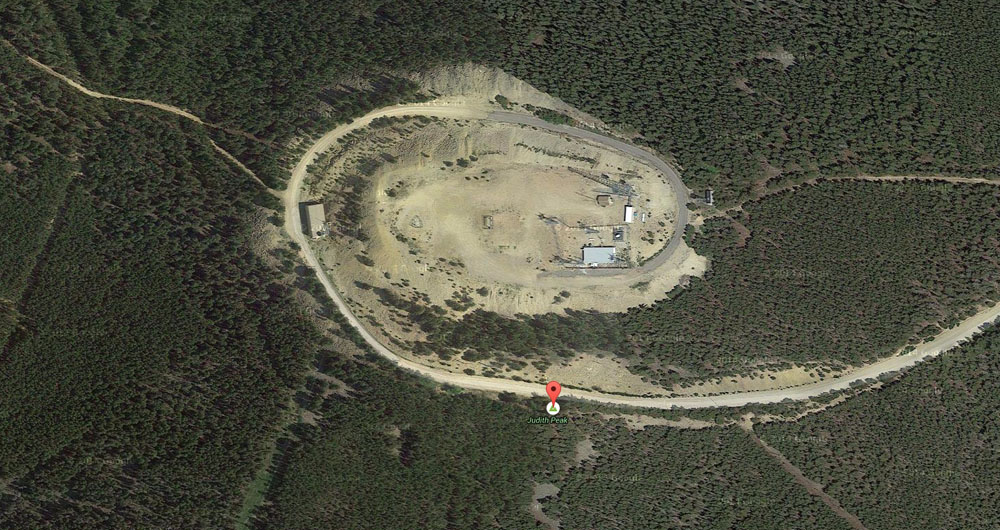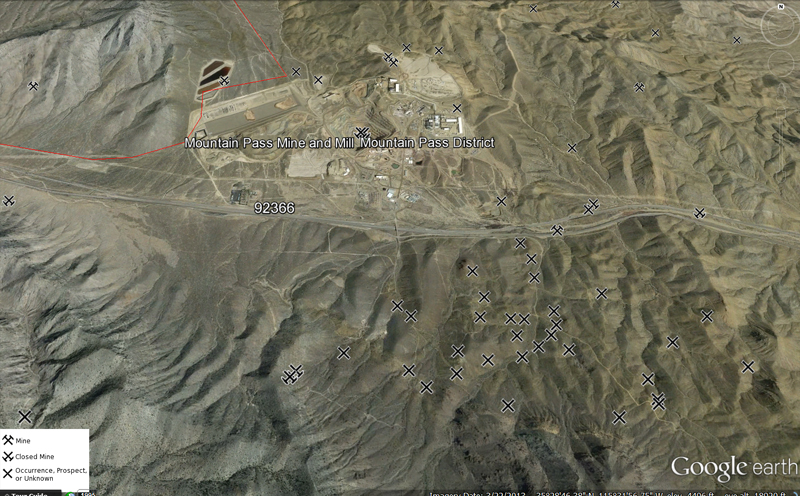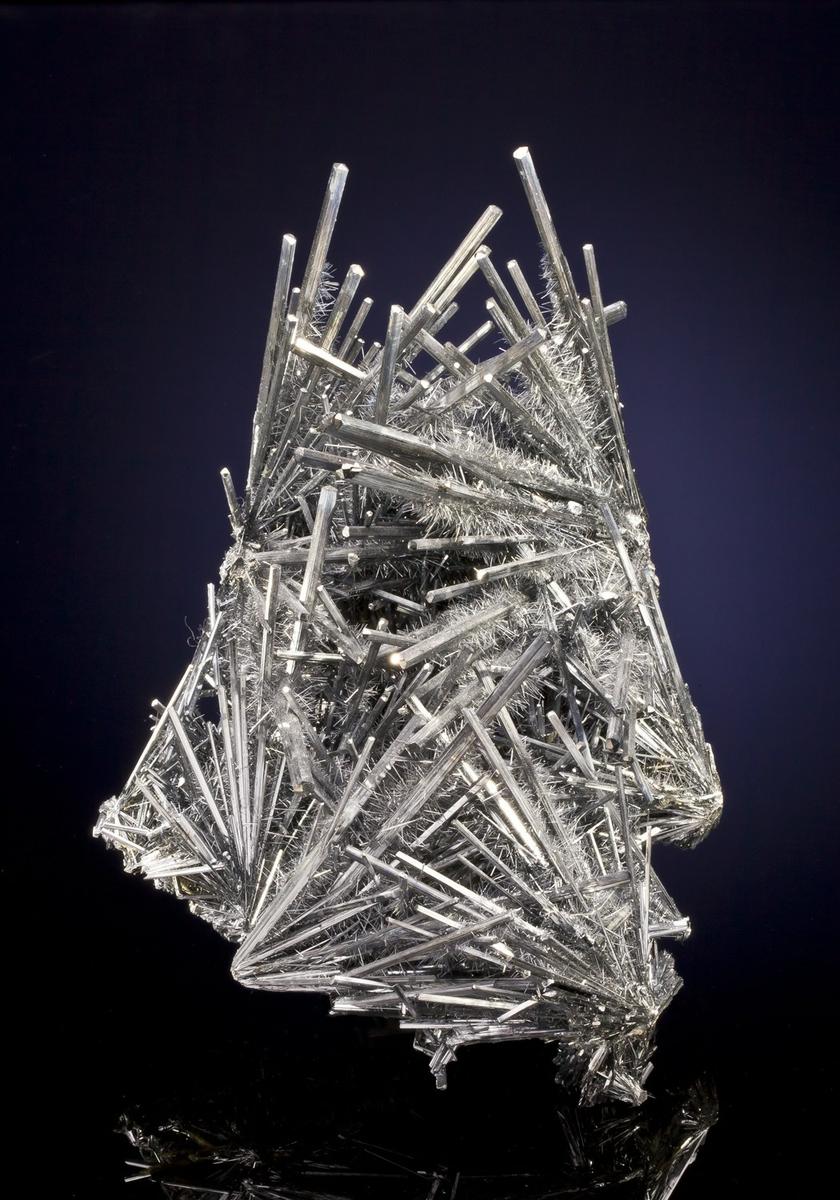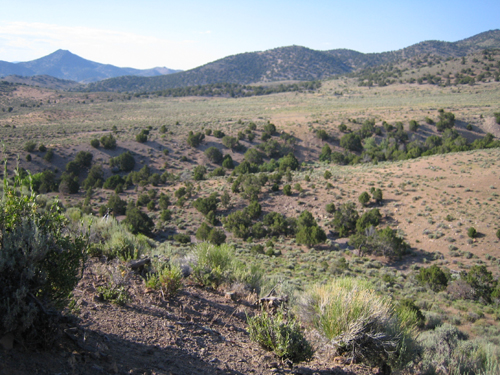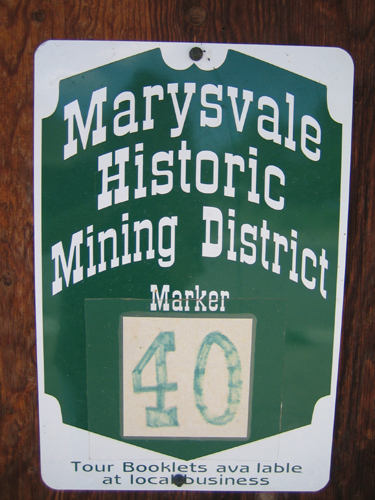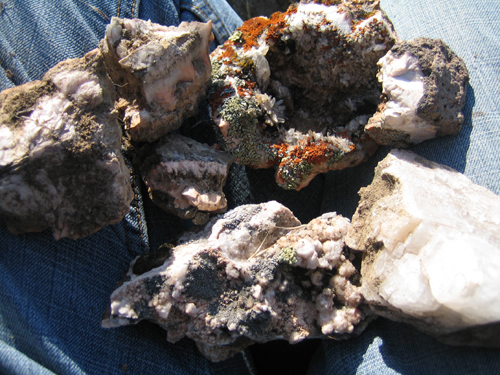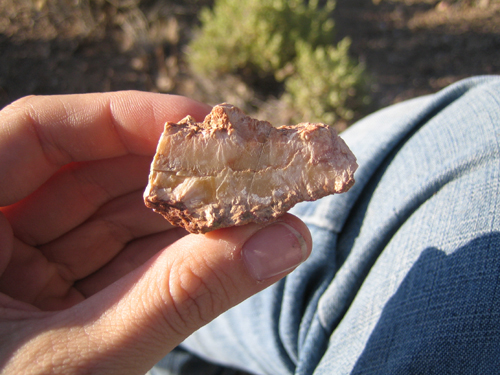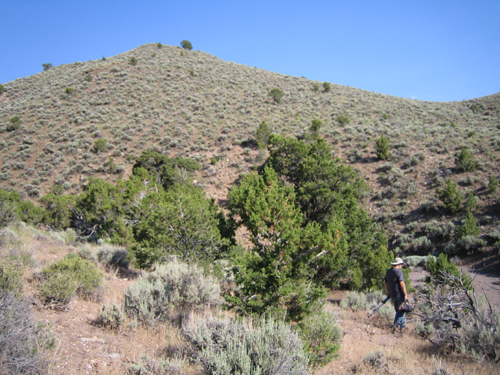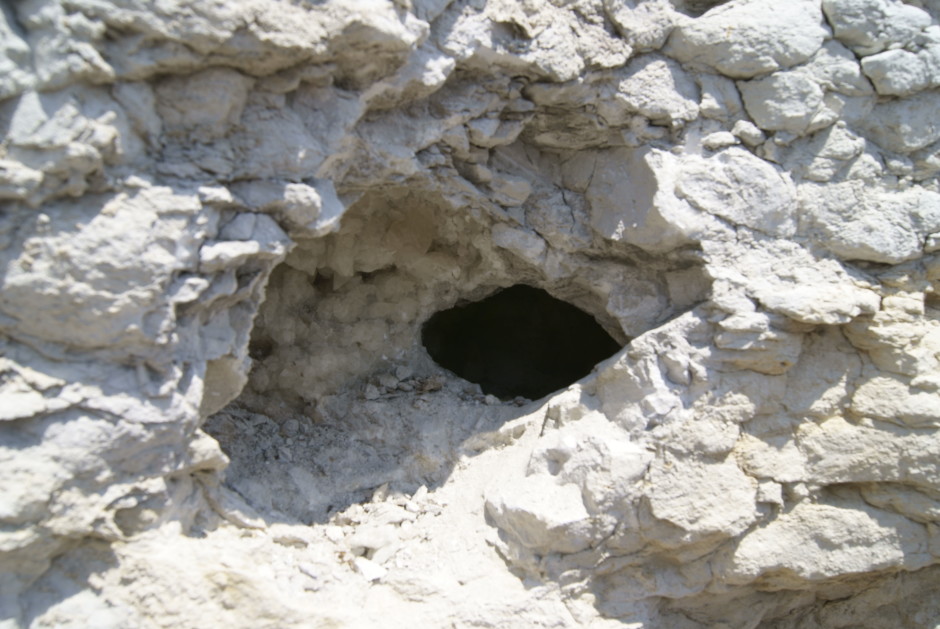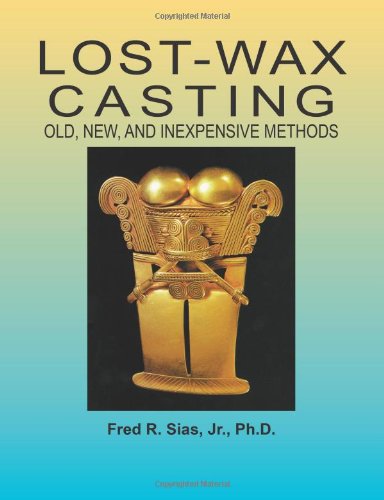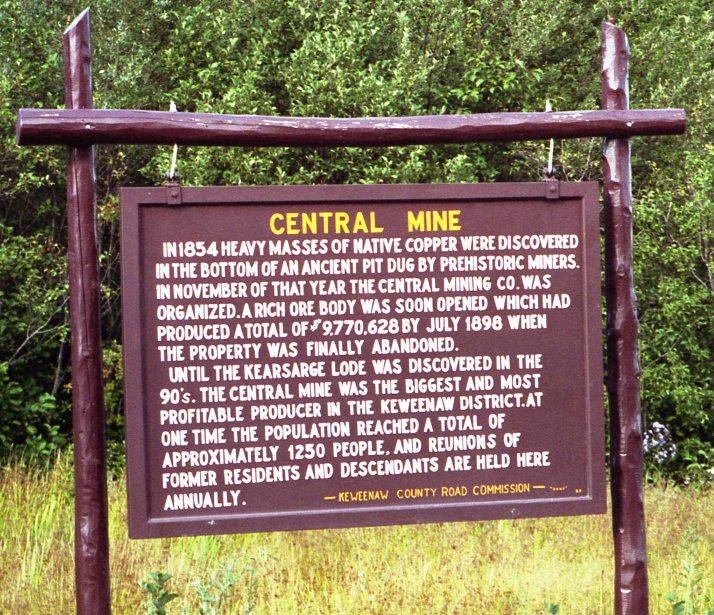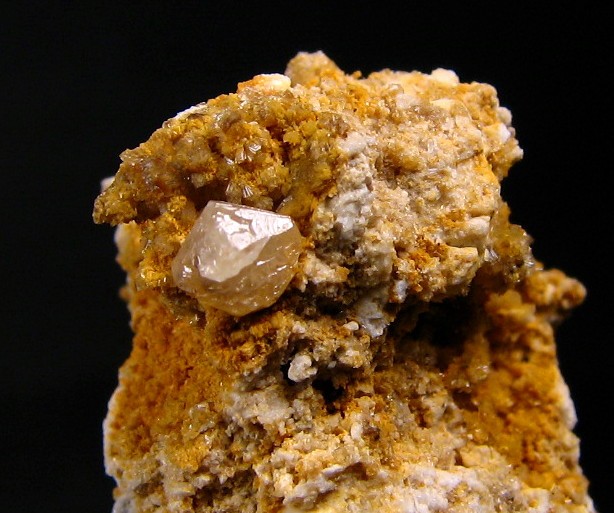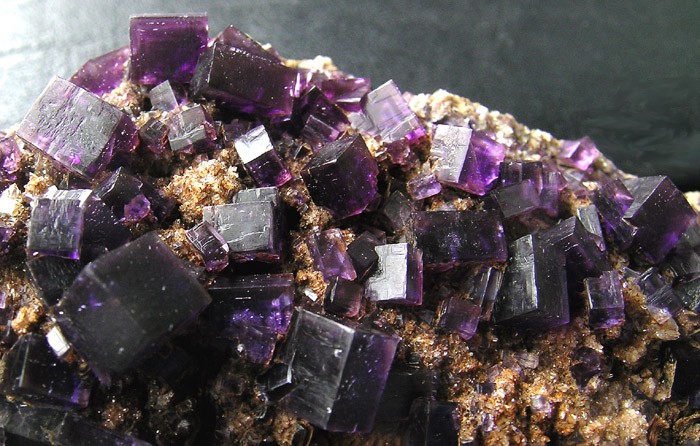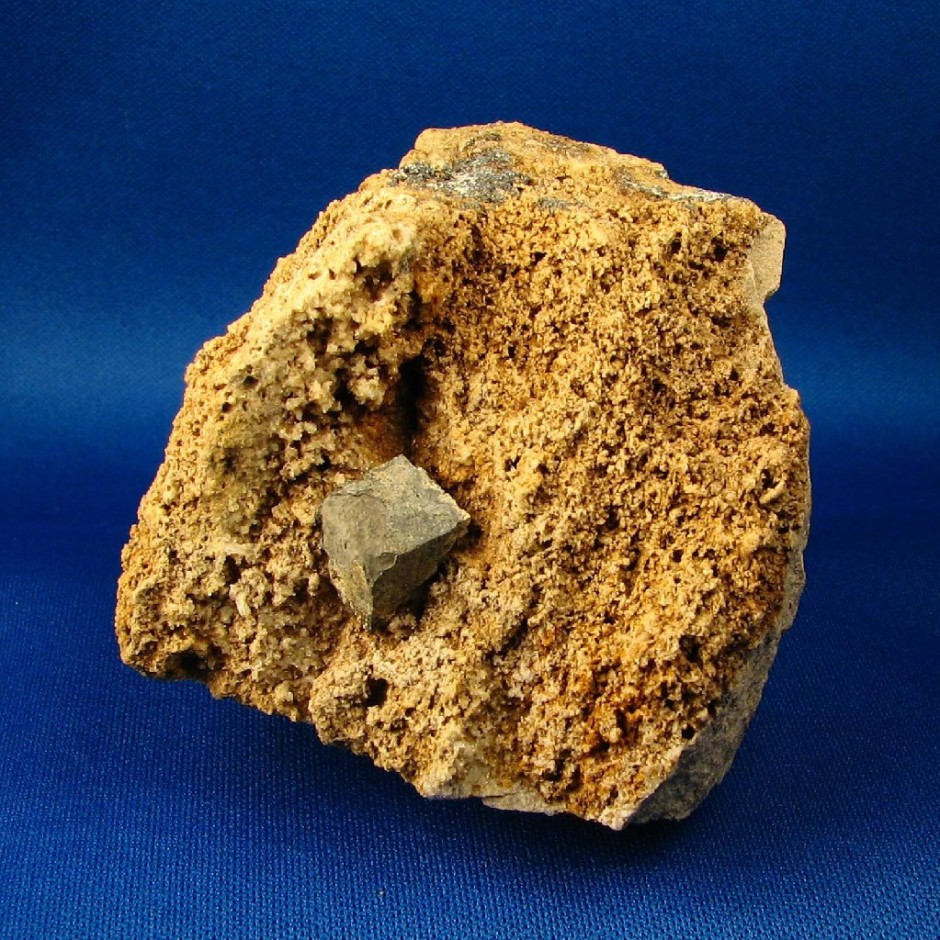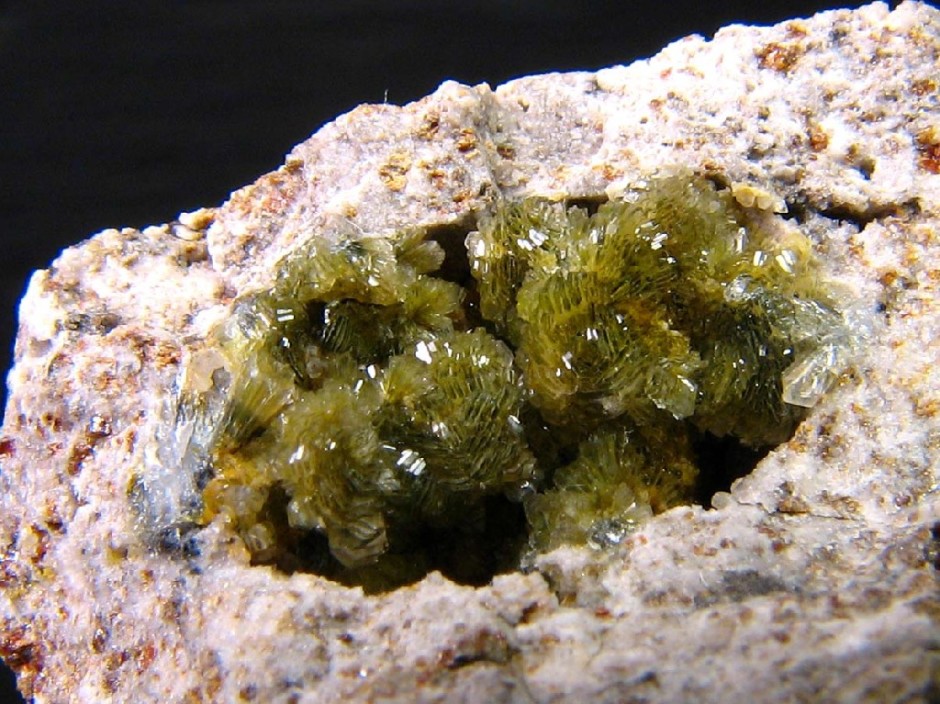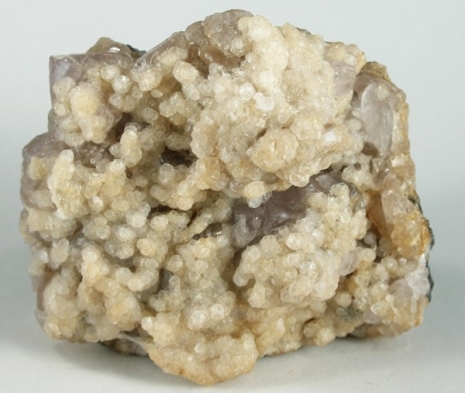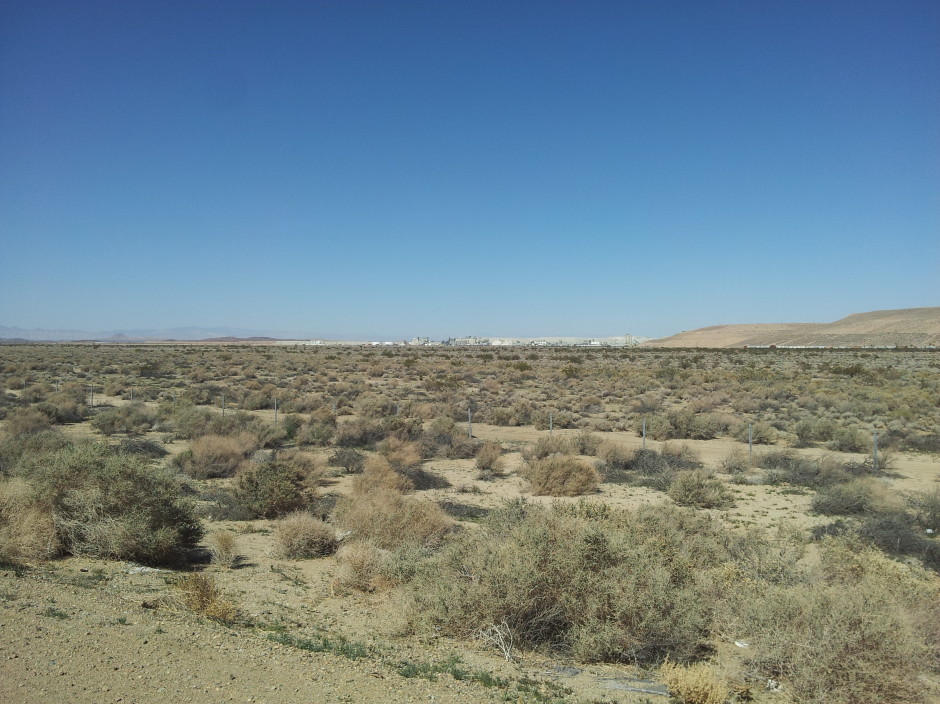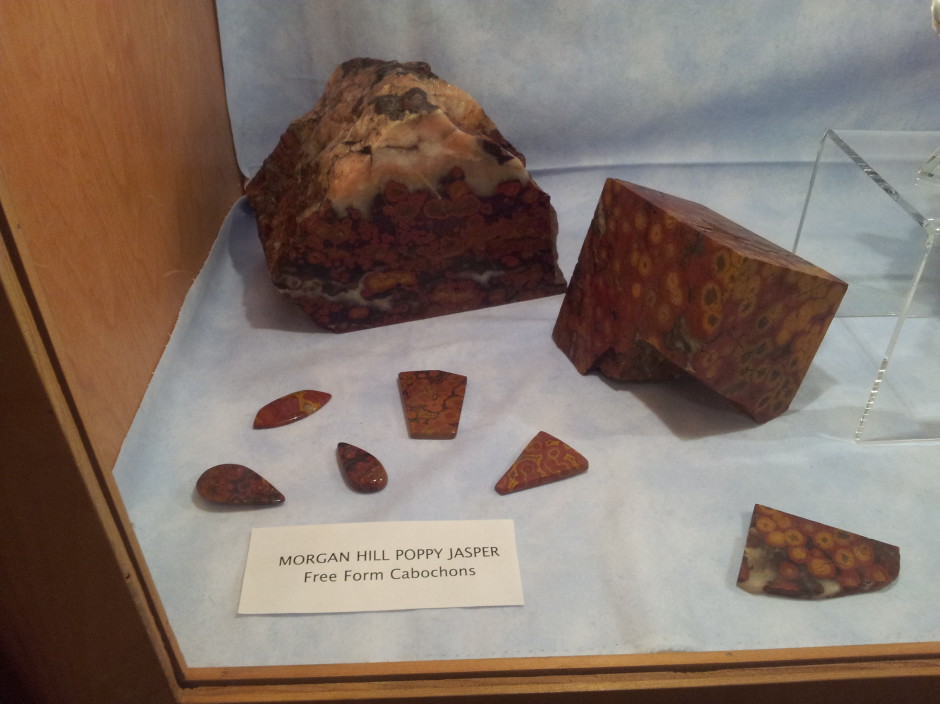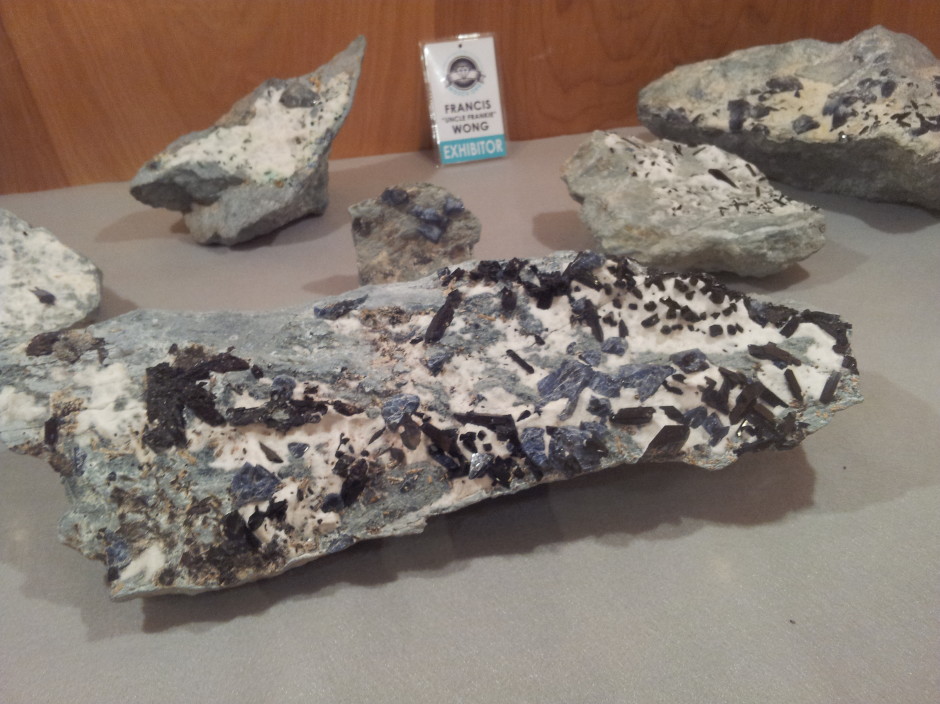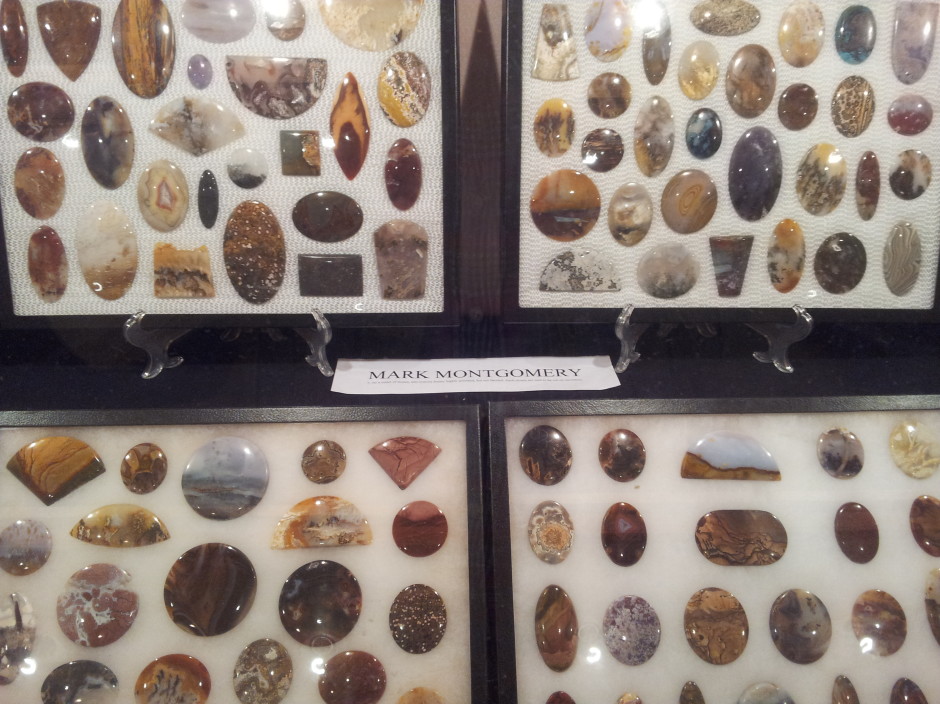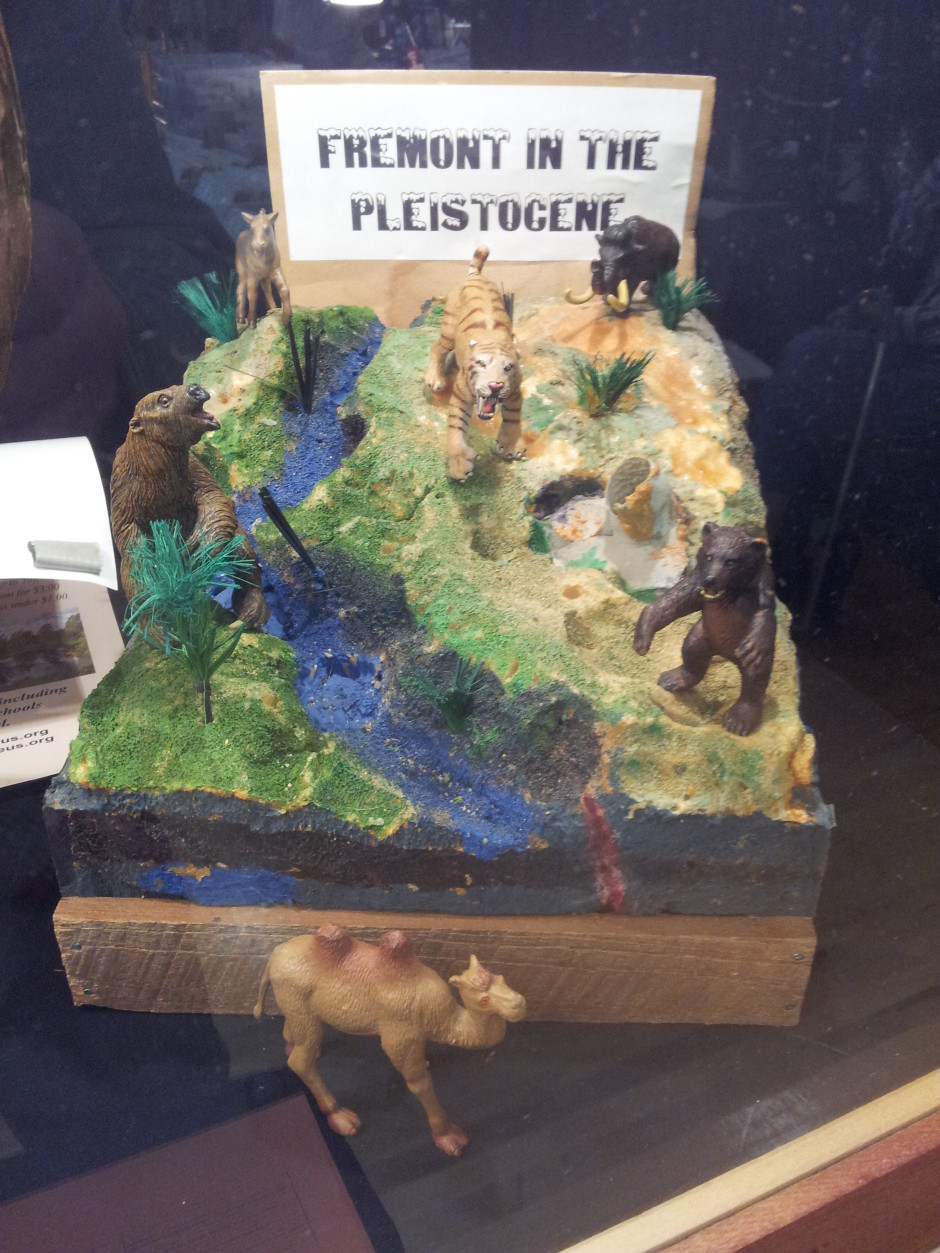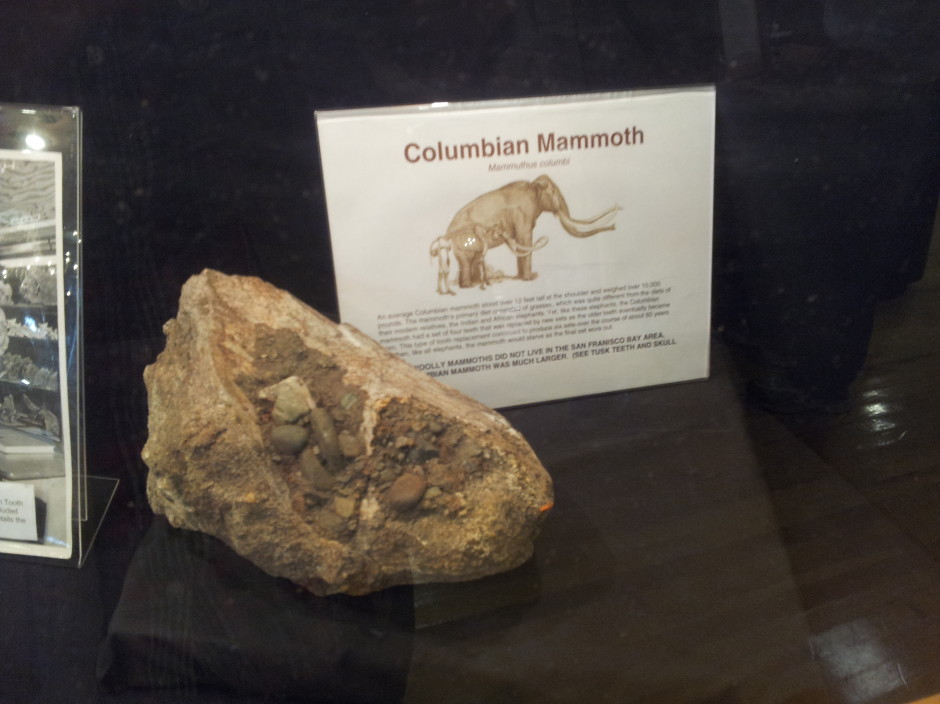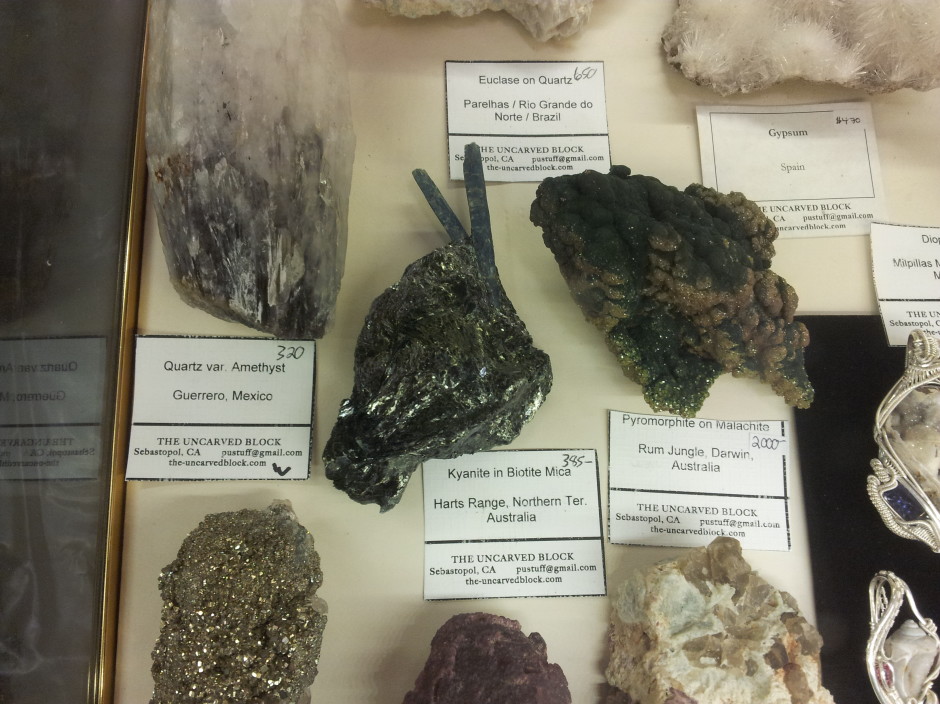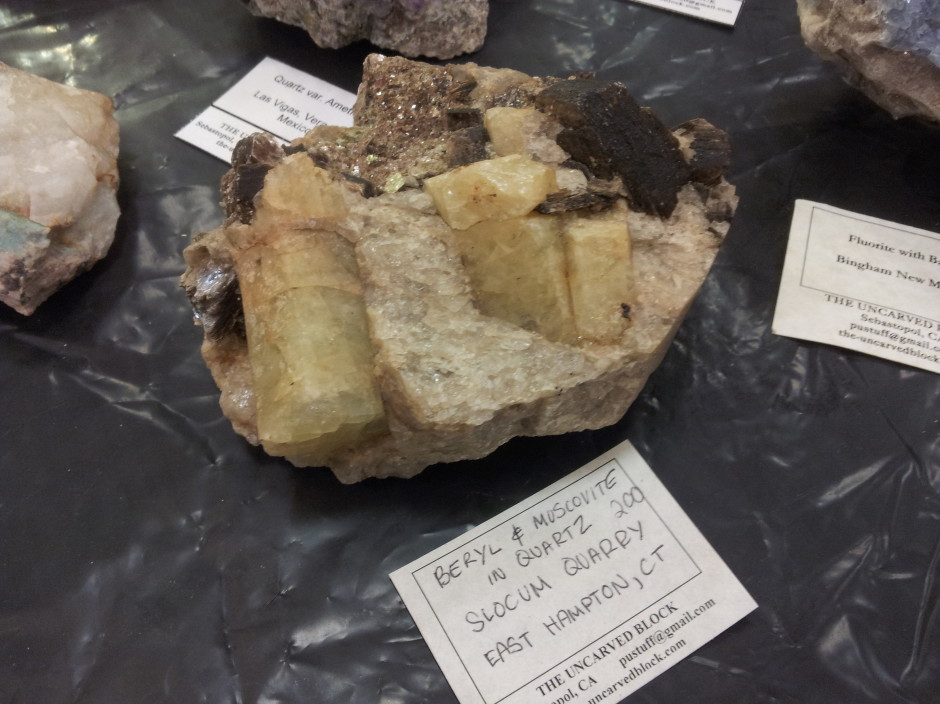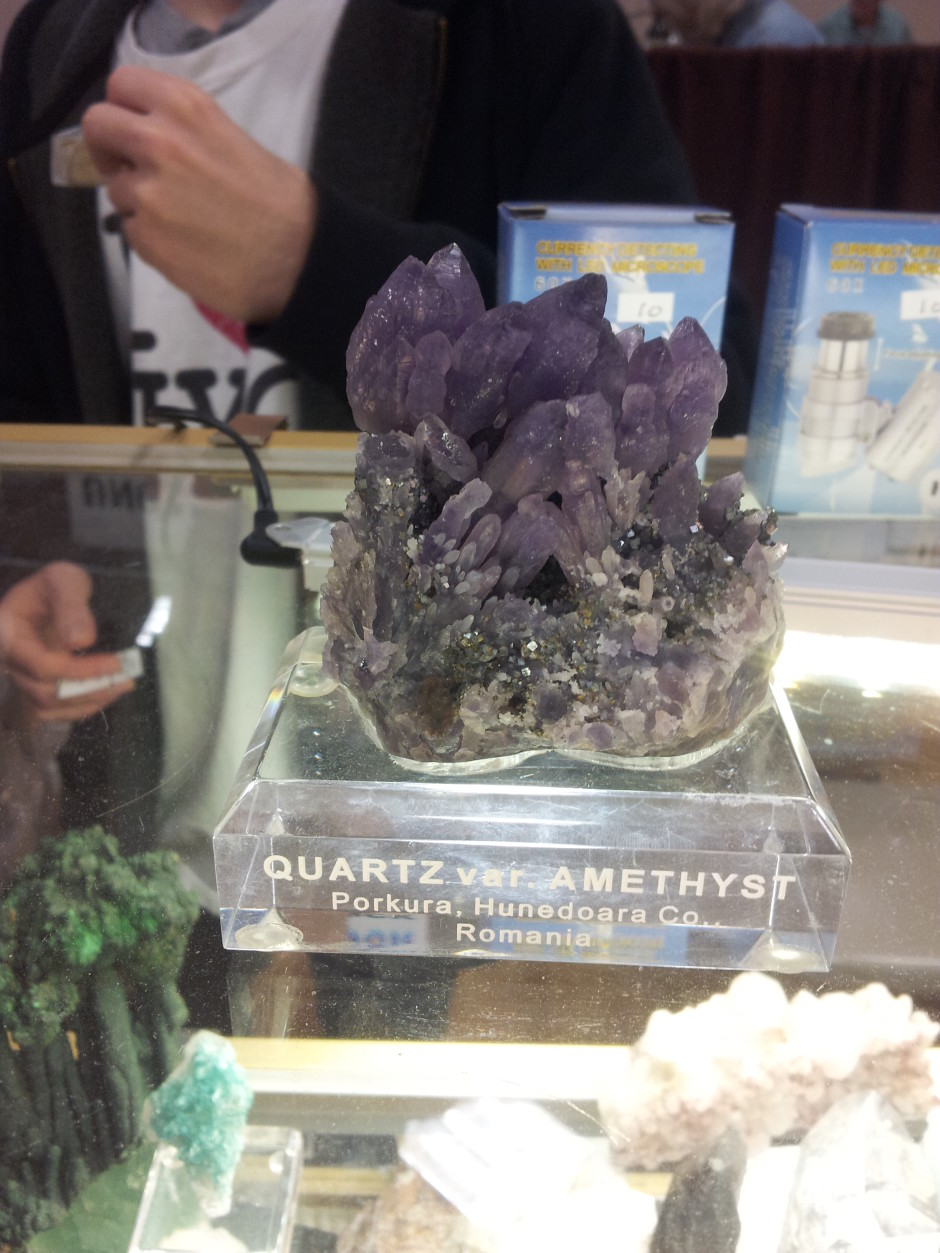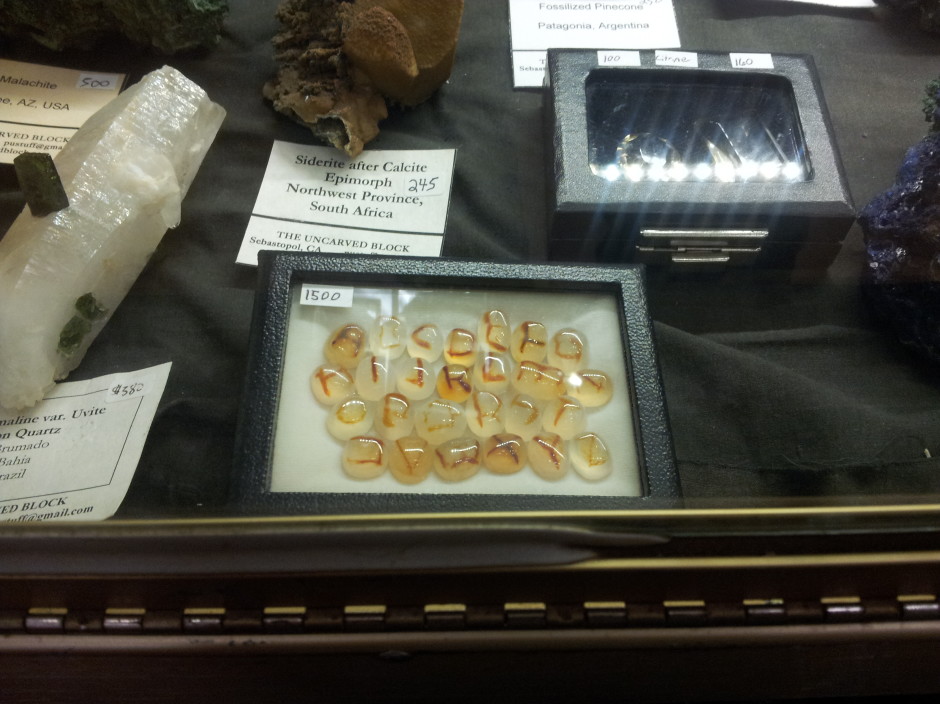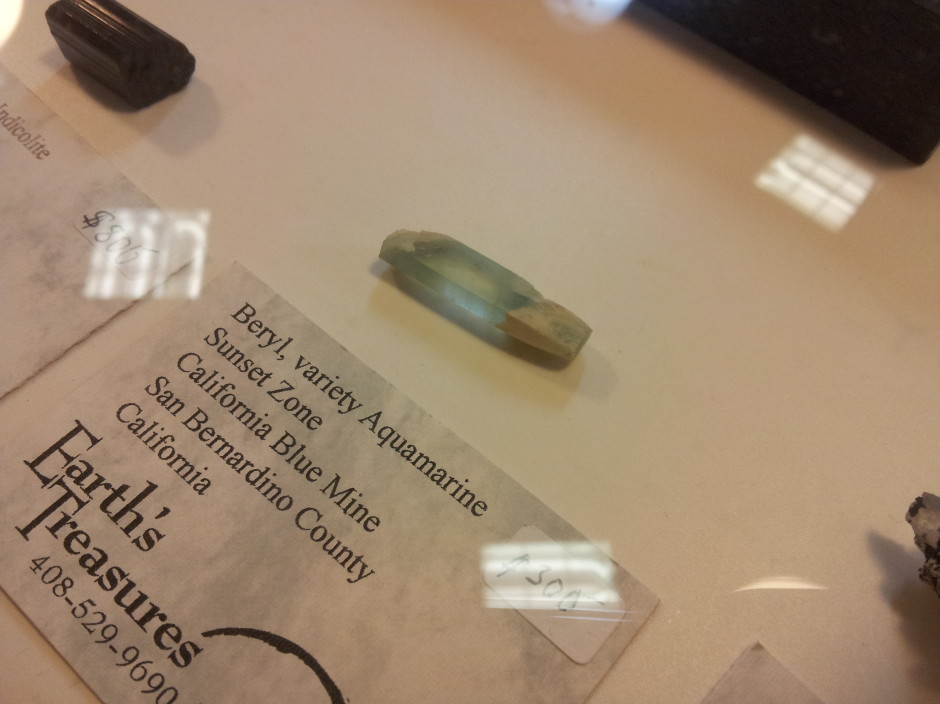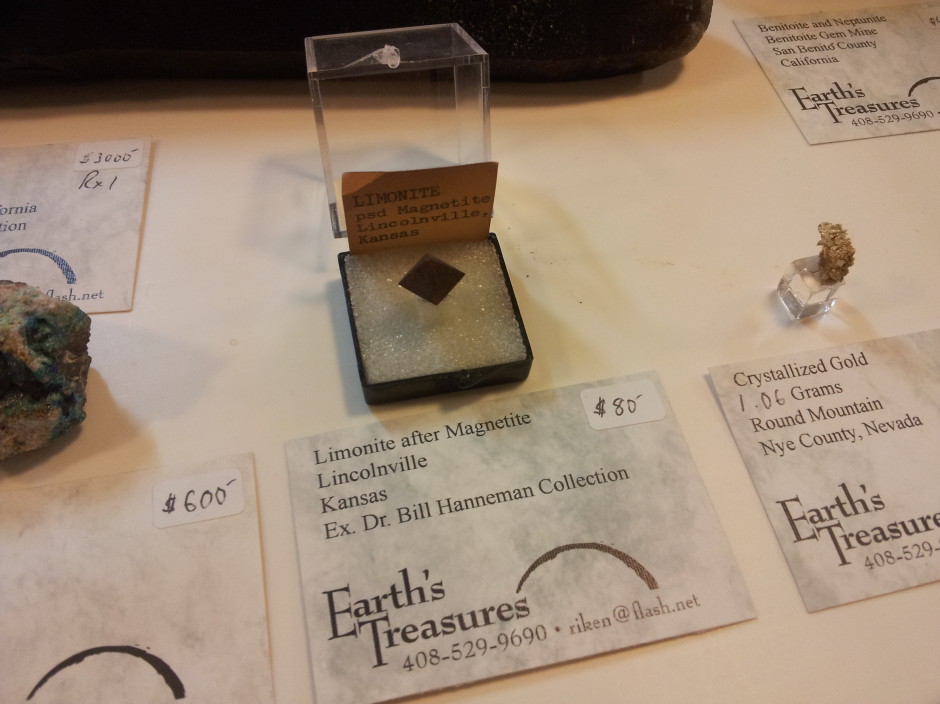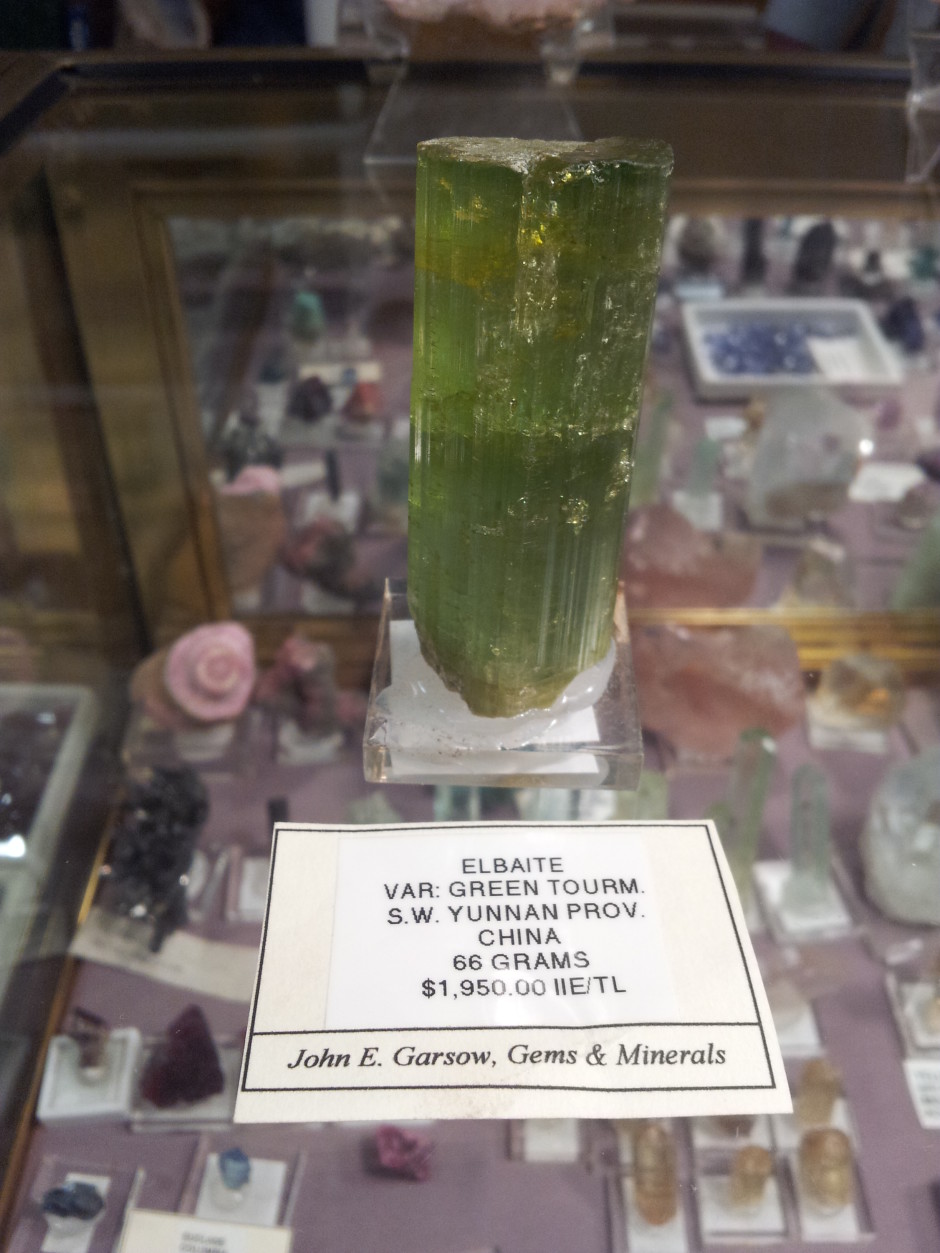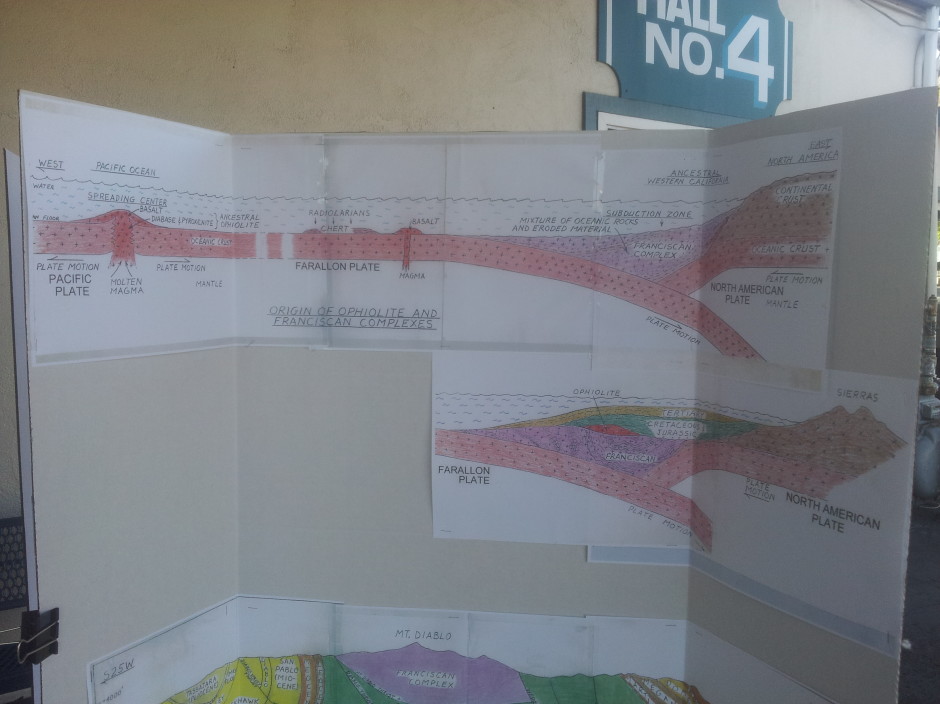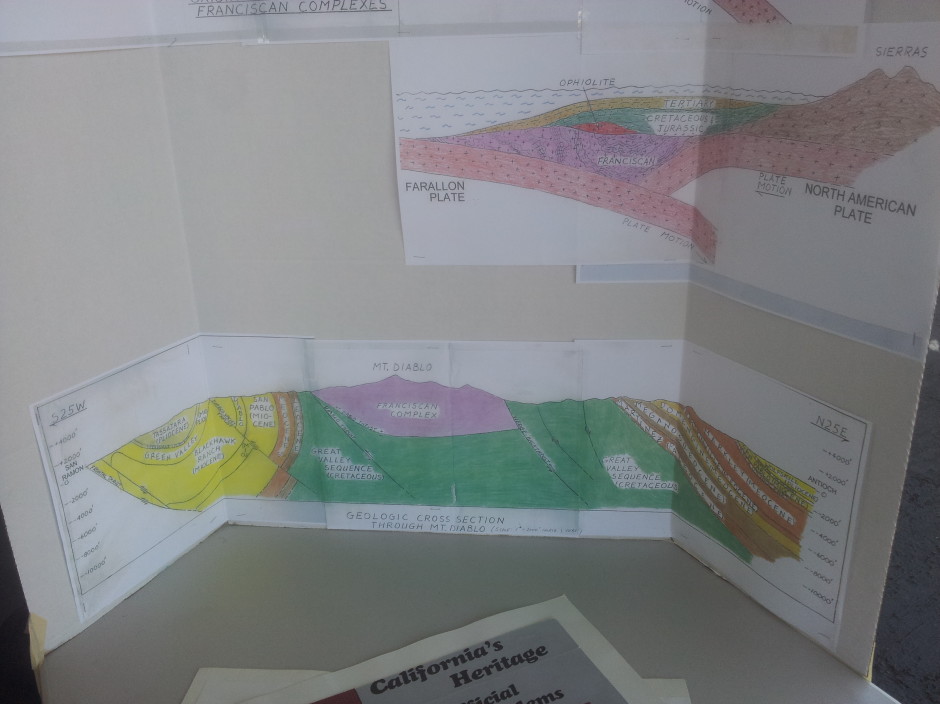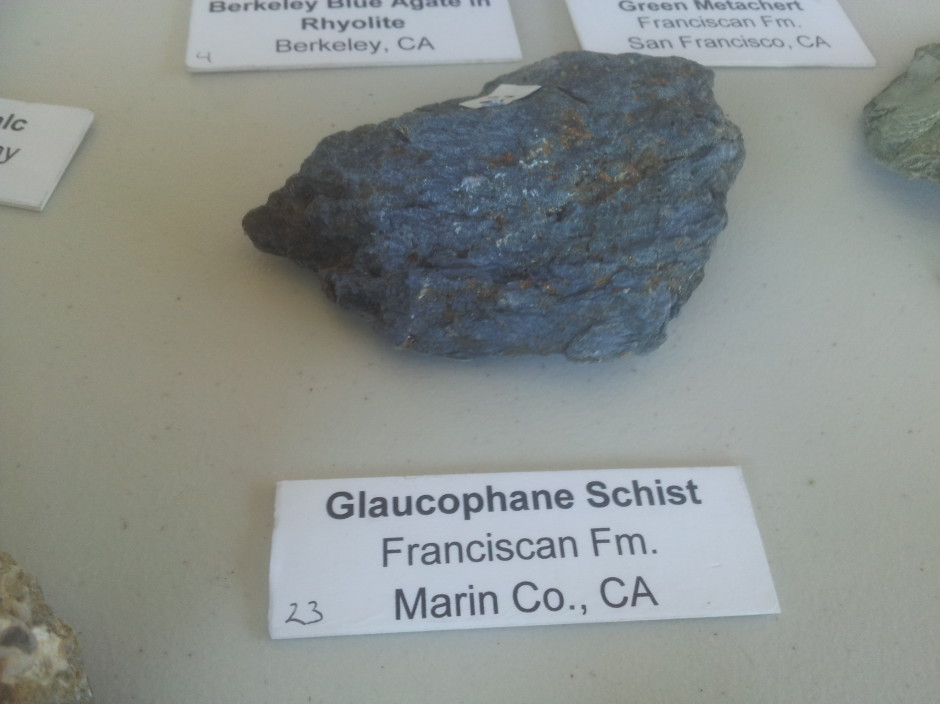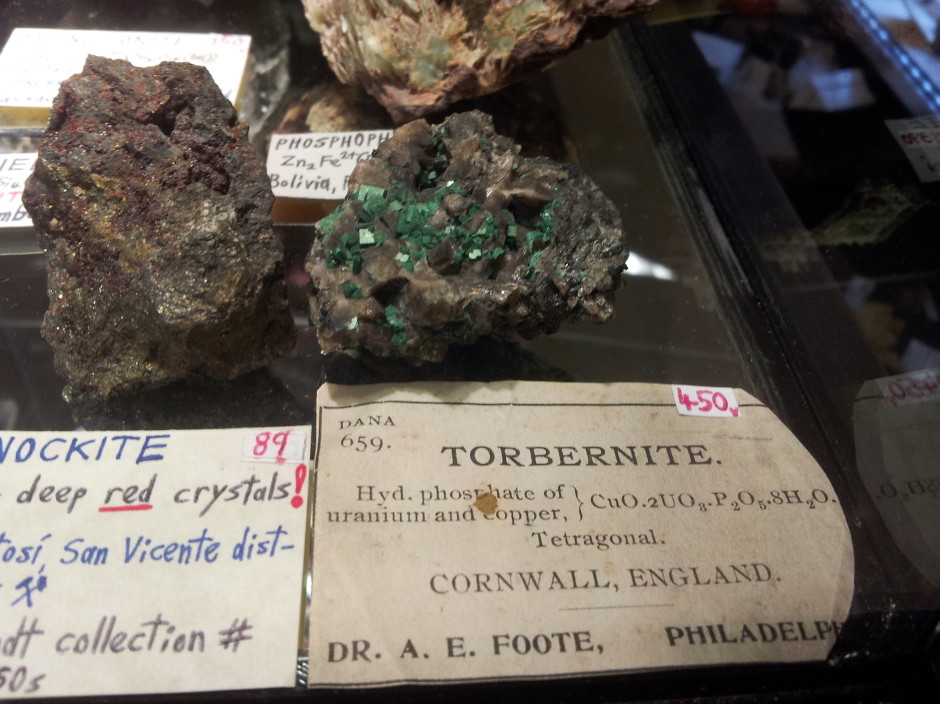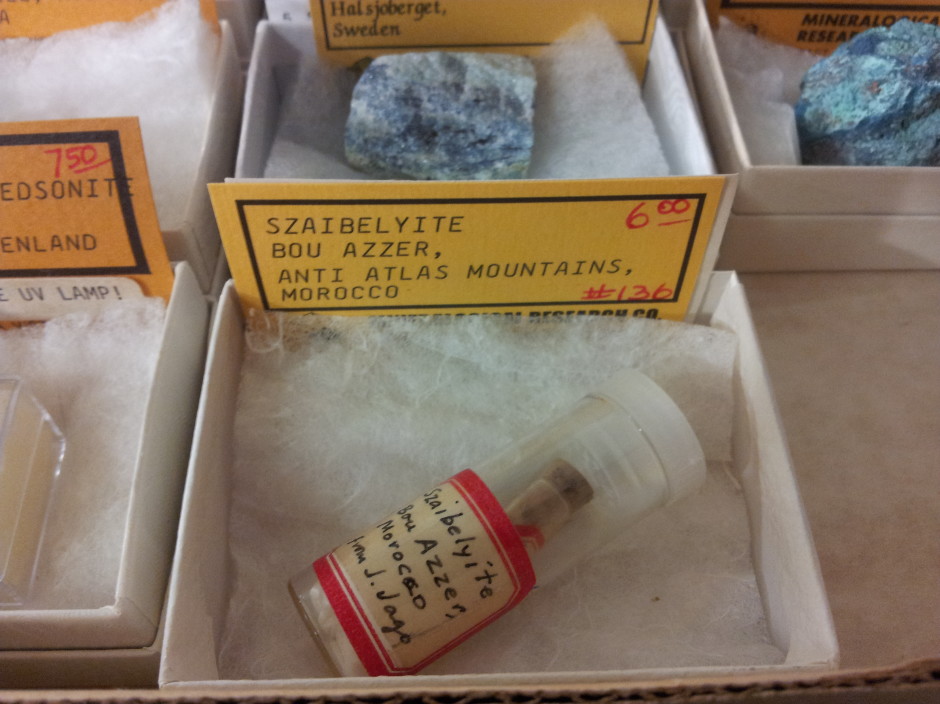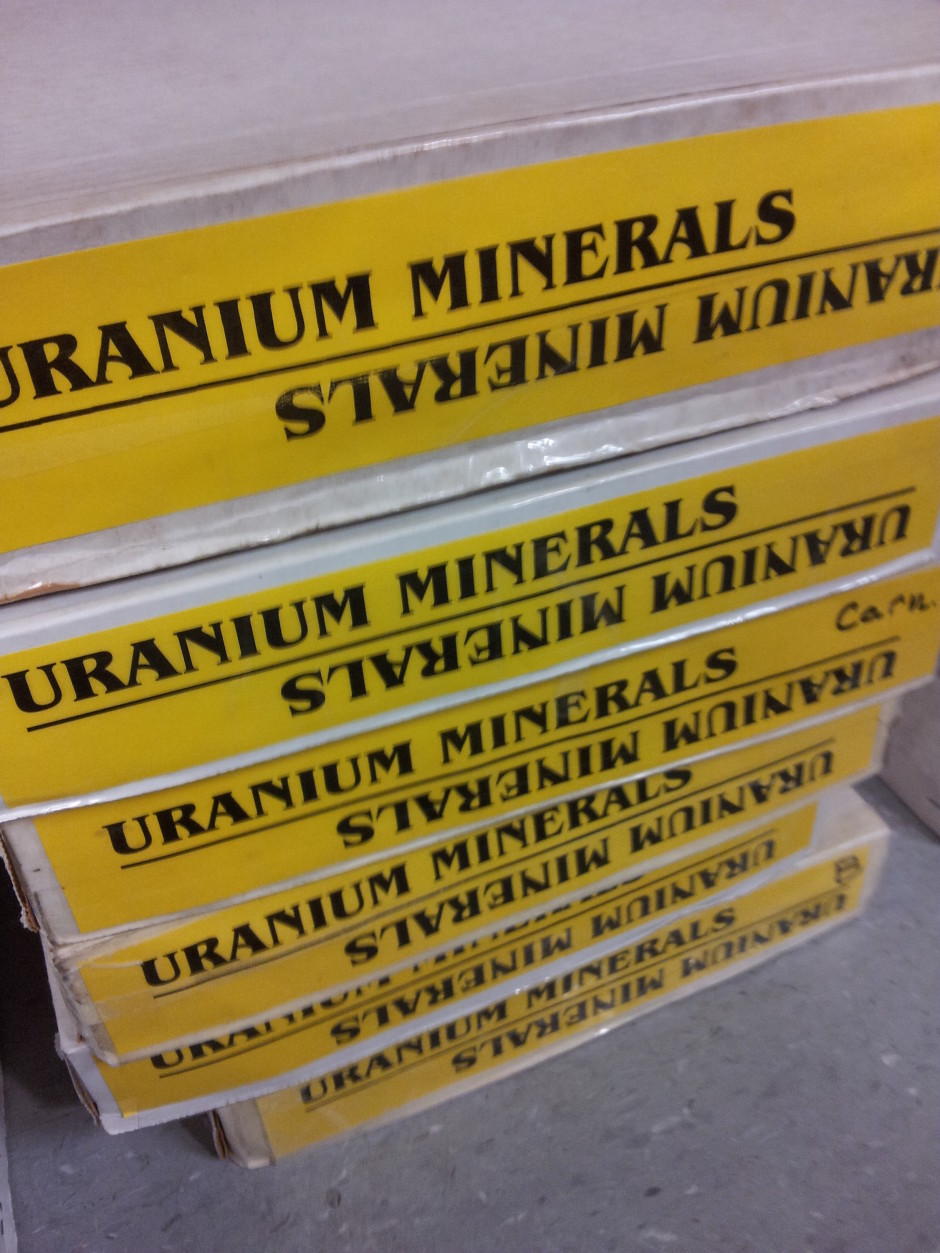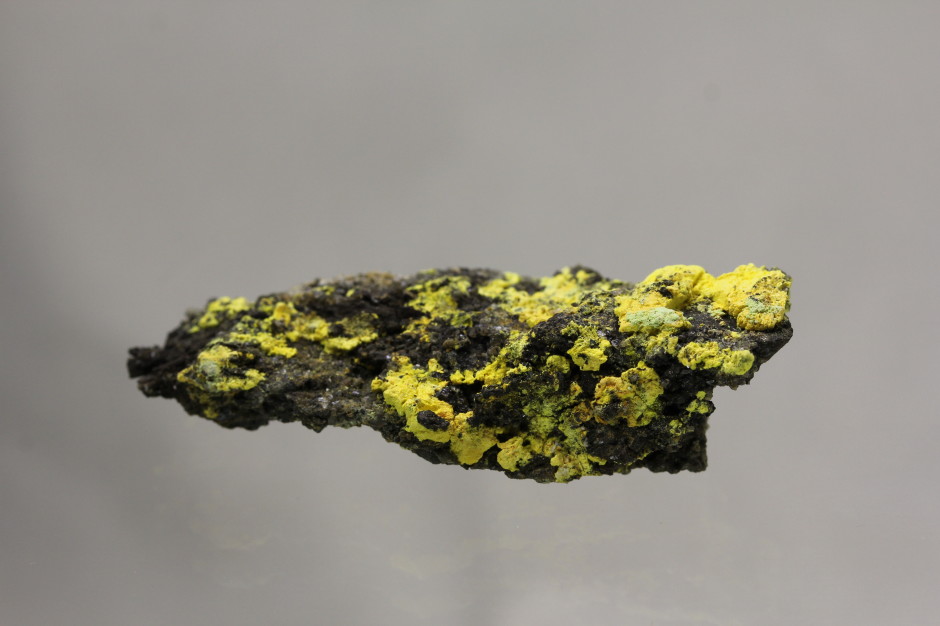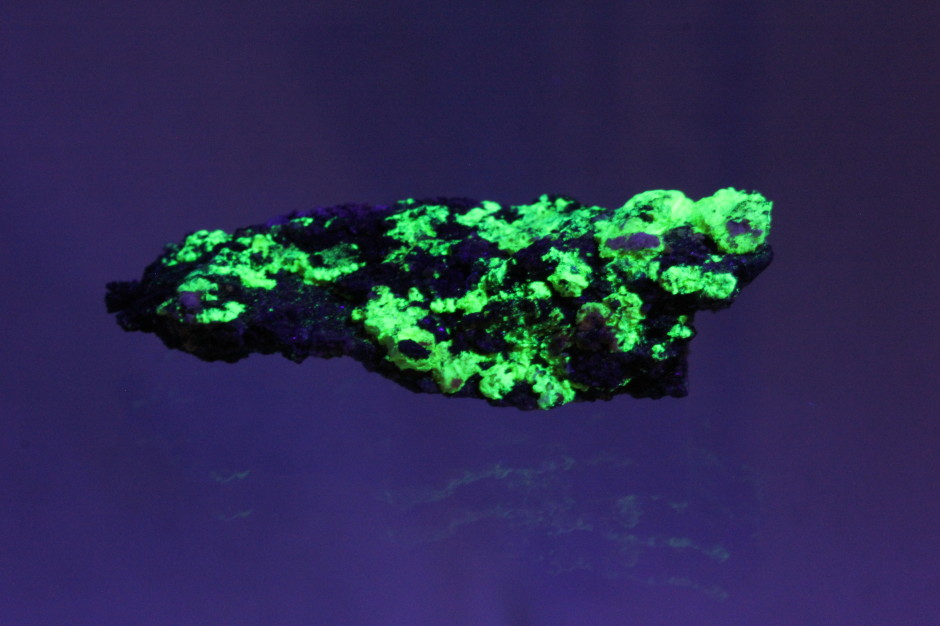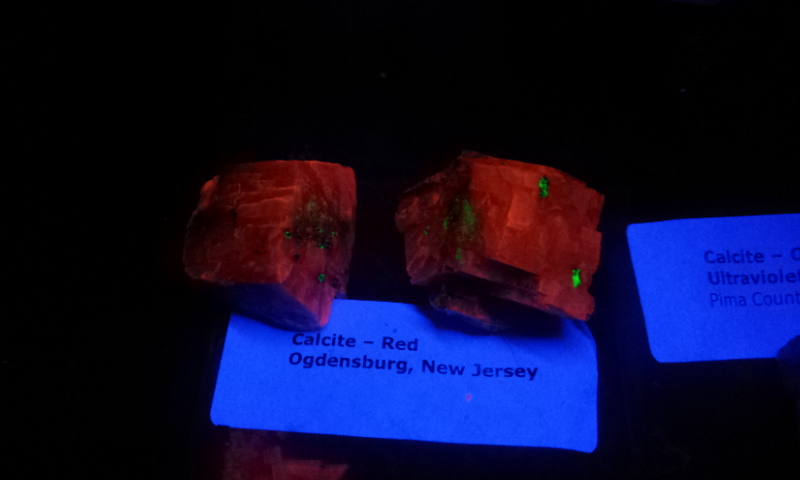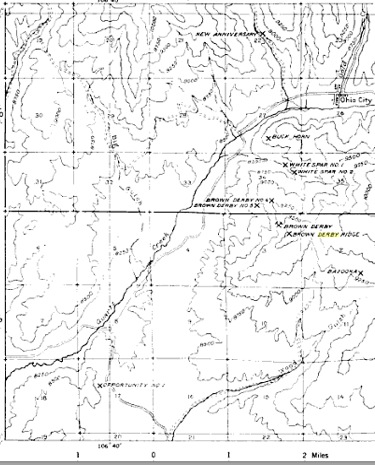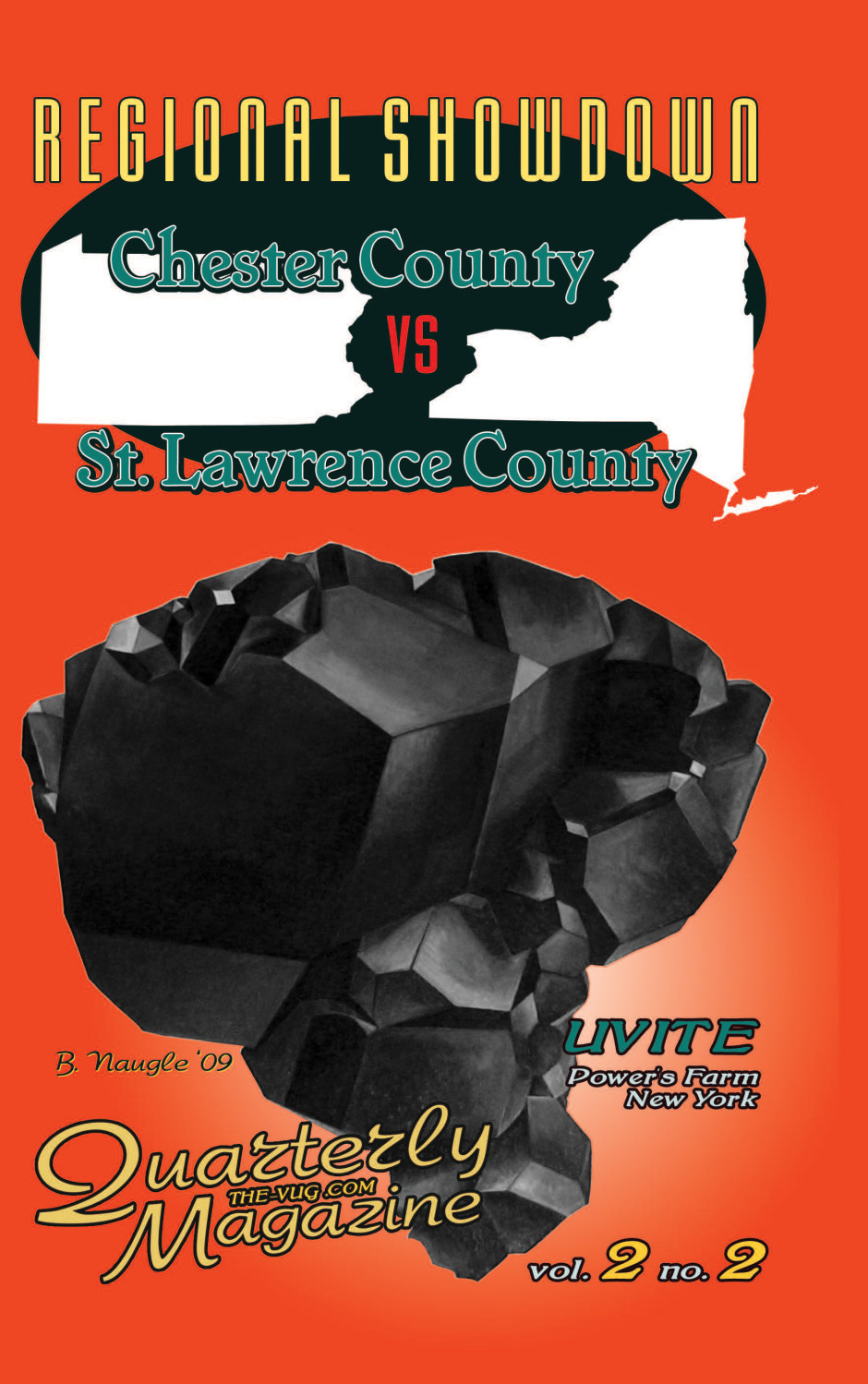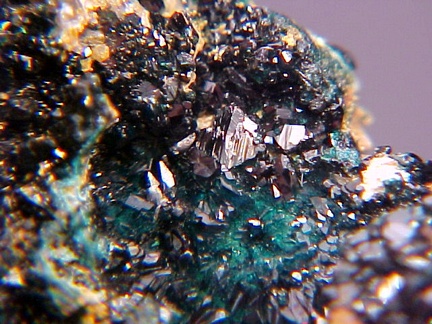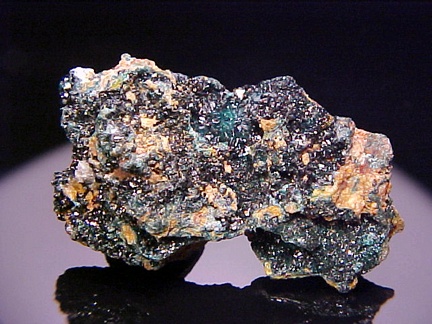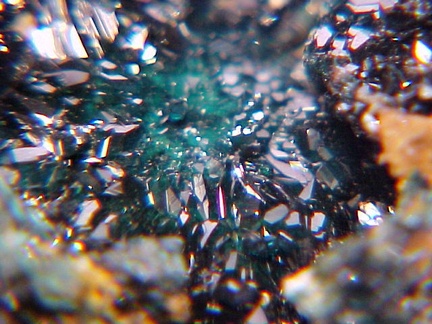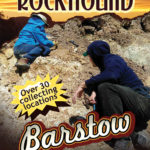
UPDATED 3rd Edition Released August 2020 – Get it now direct on a PayPal link, or check it out on Amazon, eBay and Etsy
The Mojave desert is a mineralogically rich area. One small town of less than 30,000 people serves as a great jumping off point for dozens of fantastic collecting sites. Many of these locations are Southern California classics, found in field guides dating to the early 1940’s and surprisingly, still producing to this day. The Cady Mountains are an endless source of material. You can be sure that enough time spent in the loving folds of the Cady mountains will reveal some mind blowing treasures to the lapidarist.
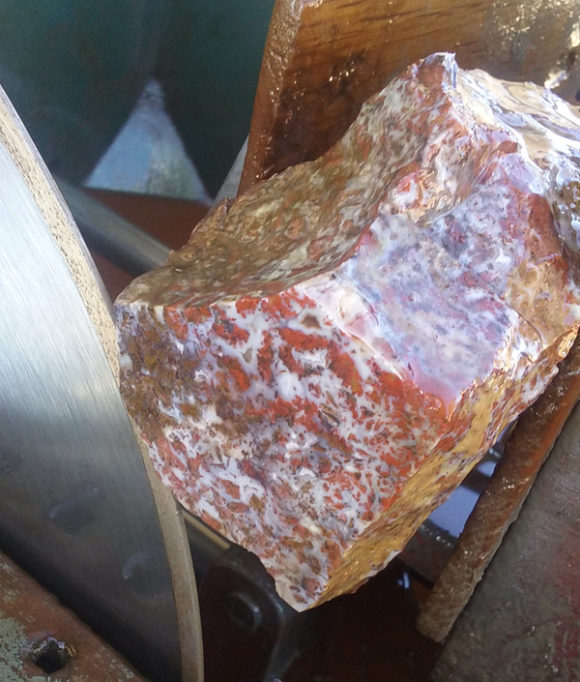
Top Notch Agate being cut into slabs. The Cady Mountains produce beautiful treasures you’ll love working with!
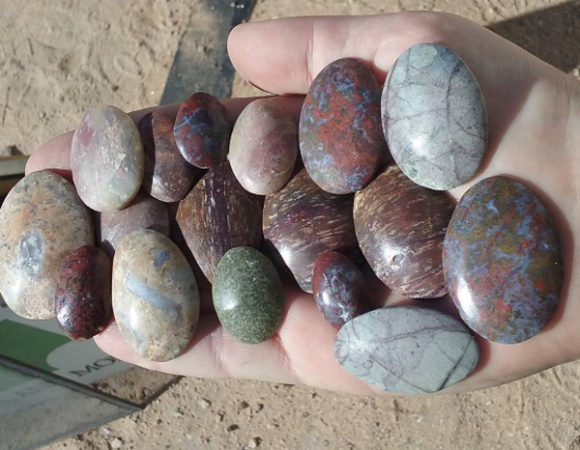
A sampling of cabochons made from material found in the Cady and Alvord Mountains
Just a few miles outside of Barstow you hit the Calico Mountains with a vast silver district, an amazing series of borate deposits, celestite for days, tons and tons of fine selenite and ample supplies of petrified palm root just pouring out of the hills…and silver lace onyx and calcite concretions that can have celestite and quartz replaced spiders and flies inside! That is just the things you can find in a small mountain range just four miles north of highway 15!
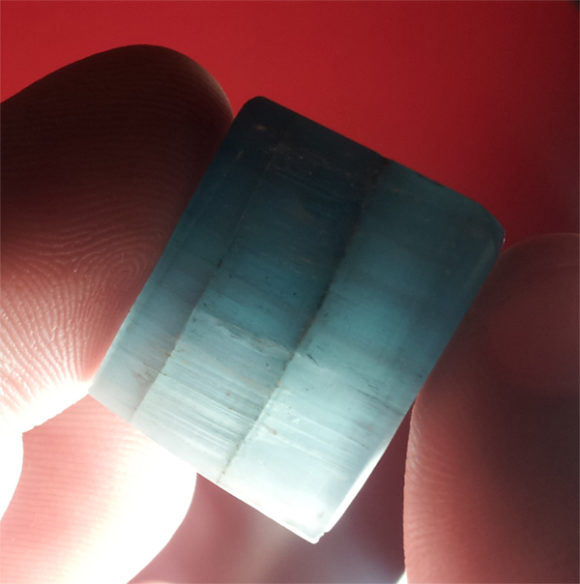
Polished Celestite from one of the many celestite deposits found along with the Borates of the Calico Mountains
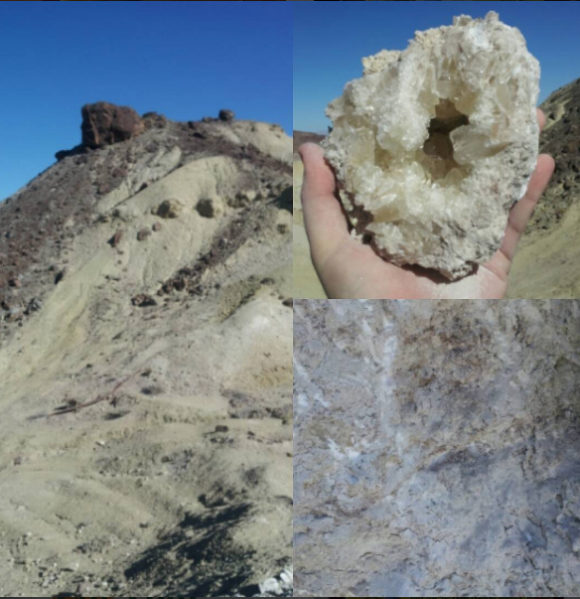
Gem crystal clusters of Colemanite are found in the Calico Mountains, ready to come home with you!
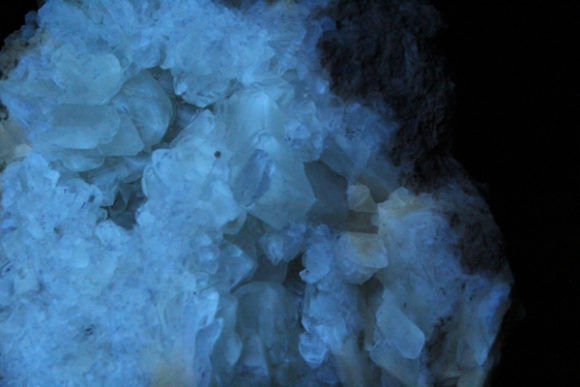
Colemanite glows bright in Short Wave Ultra Violet Light, like MANY of the minerals found in the area.
One of the reasons Barstow is such a great starting point for rockhounding in this area is the prime location. Just 2 hours north-east of Los Angeles and 2 hours south-west of Las Vegas, this town has most everything you need for traveling in this area. Gas, groceries, hotels, restaurants, even the Diamond Pacific Rock Shop, attached to the Diamond Pacific Lapidary Equipment factory. Emergency services, like tire and vehicle repair can be found in Barstow so that even in the worst of conditions, there is somewhere “local” to take care of any problems. Convenience is what Barstow provides and there is no reason why that is not a good thing!
Order it on Amazon, or Buy it for Kindle eBook Readers
Who better to write and produce this Barstow rockhound field guide than the field trip leaders, Justin and Brandy Zzyzx – locals to the area and avid rockhounds, each of the locations in Rockhounding Barstow have been visited by Justin and Brandy. Justin wrote the text and Brandy designed the maps, as you can see in the sample below.
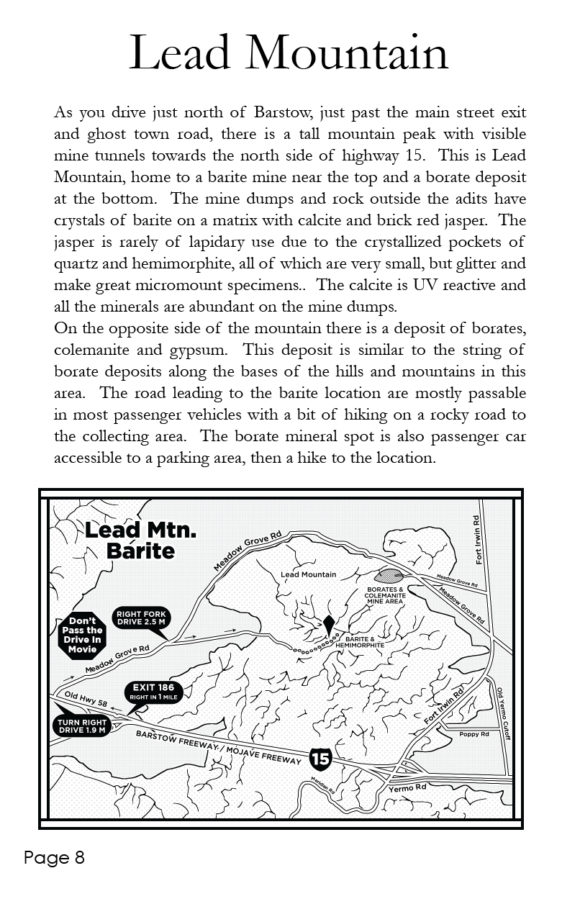
Sample page from the Rockhound Barstow Field Guide – Lead Mountain, just a couple miles from highway 15, a great place to visit and collect colorful crystals!
Many of the locations have been written about before, while some of them are being published in this field guide for the very first time. One of the locations that is very exciting is the North Cady Mountain collecting, including the Top Notch claim, prospected by Bill Depue and John Pickett, of Diamond Pacific. This spot has been producing some really lovely material, bright red, golden siderite, fortification and banding of clear and lavender agate. Oh, a day collecting here just can not be beat! You are going to get directions to this very spot and over 30 more locations, just waiting for you to come visit.
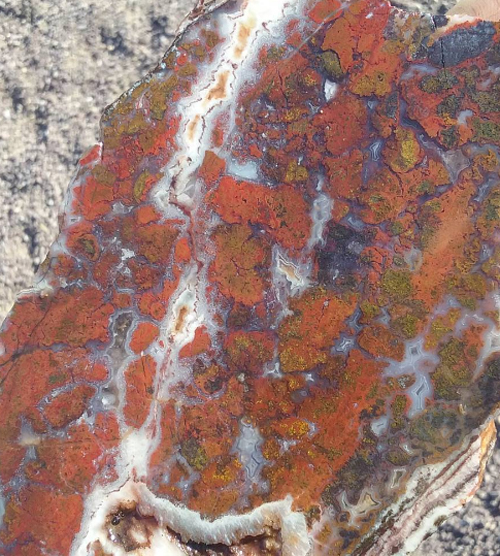
Bright Red and Golden Top Notch Agate from the North Cady Mountains, featured in the Rockhound Barstow Field Guide
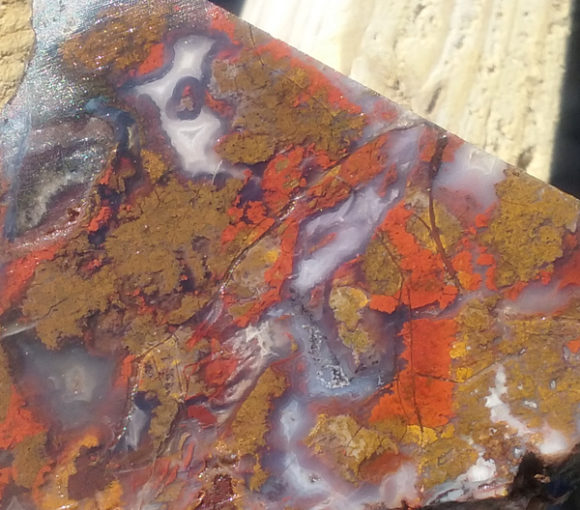
Siderite is not a common inclusion in agates so it is a welcome site to see this material, rich with gold and red along with beautiful gel agate from the North Cady Mountains
Another interesting feature is the interactive rockhound map provided in the guide. Simply type in the website address and on your phone google maps will open up and you’ll be provided with a pinpointed map featuring all the locations in the book PLUS additional locations, each of them showing you EXACTLY where to collect. Most of the locations in the books will have cell phone service, allowing you to use the interactive google map as a guided satellite directly to the collecting location. Truly a first in terms of mineral collecting field guides!
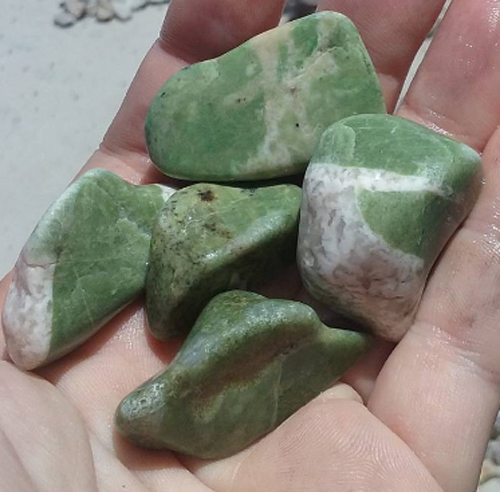
This fun “Nickel Quartz” comes from the North Calico Mountains Nickel Quartz, Wollastonite, Garnet, and so much more await you, with new locations added occasionally.
By now I’m sure you are chomping at the bit to find out how to get your copy of this booklet. This digest sized field guide, with a color cover, color photographs of what you can expect to find, over 20 collecting locations, all this can be yours for $14.99 plus shipping and handling! That’s right, just $14.99 plus shipping gets you a fountain of information, right at your fingertips!
Simply use PayPal to order directly by Credit Card or your PayPal account or purchase a copy from Amazon, Etsy or eBay.
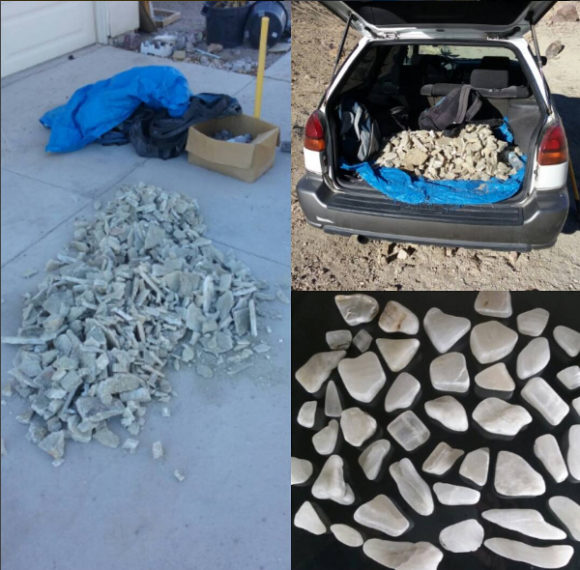
The abundant Gypsum/Selenite in the Calico Mountains is great for tumbling, polishing, carving and collecting. We use it as a water softener.
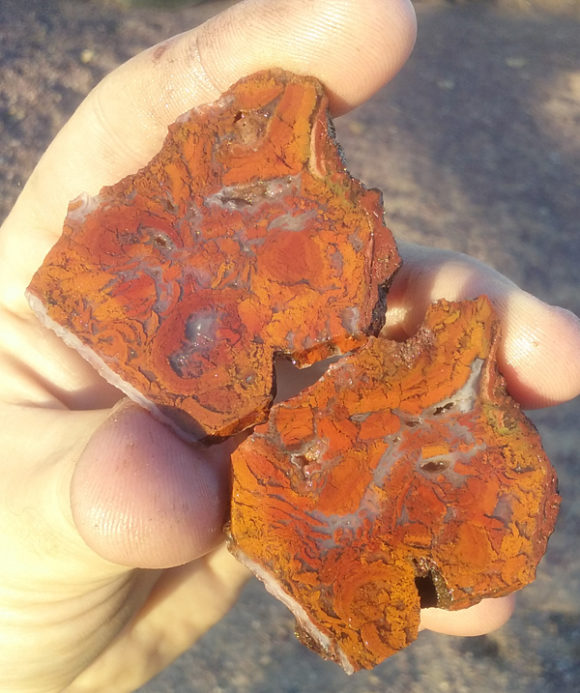
The Lavic Sidling Jasper location is not just limited to the classic areas, but also spilling out to the West and North of Pisgah Crater, as you’ll see in the Rockhounding Barstow Booklet
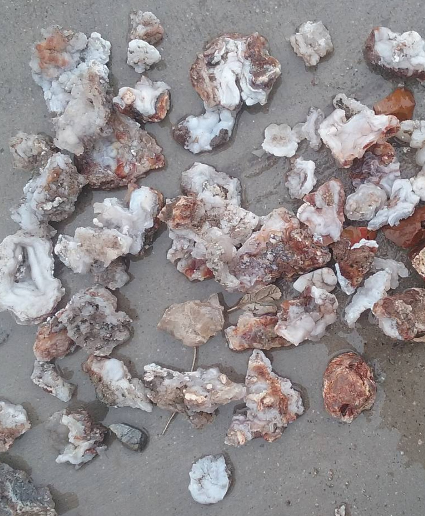
Chalcedony Roses are very abundant out in the Mojave Desert
Related posts:
Collecting by Air – AirMindat takes to the Skies to Collect in Arizona
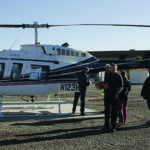
What do you do when you’re in Tucson at the Gem and Mineral Show on the Friday, when the show is full of school children and you really don’t want to have to be there dealing with them all? Simple. You go collecting. But you need to be back at the show by mid-afternoon? No problem. Let’s hire a helicopter!
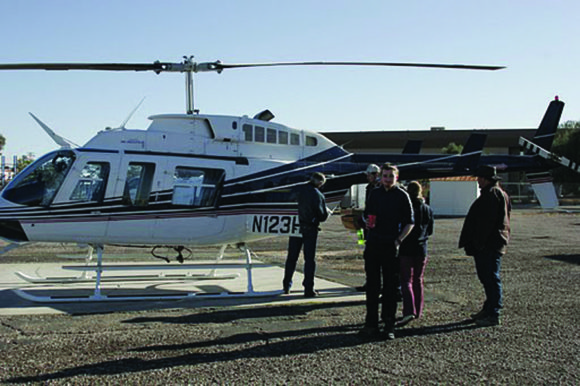
The Crew loading into the helicopter in search of Arizona treasures
At the TGMS show in 2009, several of the regulars from the mindat.org online chat room got together to organize just such a trip. The late Roy Lee was the leader of this trip, which we were hoping to make an annual event. Sadly he died just one year later, so this has remained so far the only mindat.org helicopter collecting trip.
We boarded the helicopter at Tucson Airport, after some concerns that too many of us were carrying extra weight. And I’m not talking about hand tools. But, the helicopter made it into the sky and we started our flight towards the Catalina Mountains – flying directly over the Davis Monthan Air Force Base and the “boneyard” where all the retired US military aircraft are stored. It was quite alarming to be flying over the main runway as a C-130 transport was making it’s final descent, seemingly flying straight at us at one point. Having survived our encounter with the US Air Force, we headed off towards our first destination – the Grand Reef Mine.
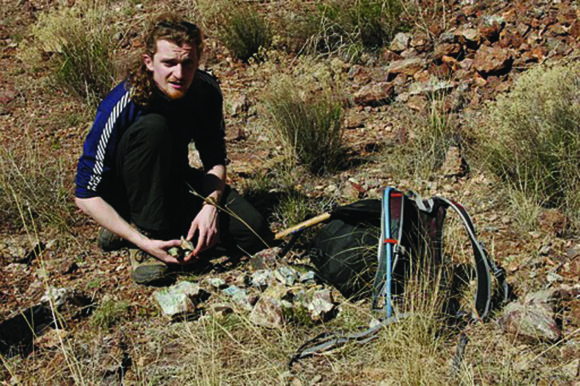
Mike Rumsey collecting specimens without the worry of washed out roads, boulders or rock slides!
This mine is notoriously difficult to access, with no nearby access roads. So the luxury of being able to fly right up to it and practically land on it was the stuff that mineral dreams are made of. The Grand Reef Mine is famous for linarite and other rare lead/copper secondary minerals. We spent about 90 minutes exploring the locality, collecting on the extensive dumps and admiring the scenery. Everyone in the party found decent specimens.
But what’s better than flying by helicopter to a great mineral locality before lunchtime? Flying to a second – so after we’d finished at the Grand Reef mine, we headed off again to the Table Mountain Mine – which is well known for dioptase crystals. The helicopter made an impressive landing on an exposed ledge (which happened to be made out of glassy slag from the smelters), and we again disembarked and wandered up to the tips to collect.
We all found nice dioptase specimens, but Jim Beam found a fabulous little ‘christmas tree’ of dioptase crystals, and between us we found specimens of conichalcite with possible austinite and duftite. Some samples appear to have minerals previously unreported from the locality, and once they are confirmed they will be reported on mindat.org.
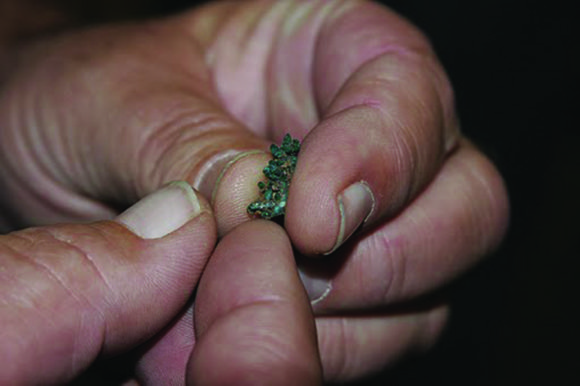
Jim Bean shows off his little christmas tree shaped dioptase cluster collected at the Table Mountain Mine
Finally, we boarded the helicopter for the flight back to Tucson Airport and a short drive back to the Convention center, and we were back in the show almost as the last of the school buses full of kids was departing.
Editor Note – Yes, you can get to these locations, with a helicopter, or a lot of hiking. This article was originally published in The-Vug.com Quarterly Magazine, Vol 4, Number 3. You can get the reprinted book on Amazon, or directly from the publisher on MineralMagazines.com
Related posts:
Pistachios and Minerals – How are they linked?
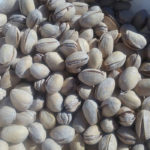
Minerals have long been used in farming. In the past, different abundances of minerals naturally occuring in nature would influence the local crops. Today, many of those conditions can be supplimented with the addition or subtraction of minerals and elements in the soil.
During the author’s years of growing and harvesting pistachios, the link between raw minerals and the final bagged nuts could be visualized.
Pistachio trees are either male or female. You can graft the two together and have one hermaphroditic tree, for the most part, they are separate and do different things.
The female tree has big broad leaves and branches that have lots of curves and style. The male tree has very thin leaves and sharp pointed branches that have sharp, straight, shoots. The female tree is the one that bears nuts, the male tree is responsible for the pollination. They are wind pollinated, so the timing has to be perfect every year during pollination.
The first mineral we mine and use is raw gypsum/selenite. Just a few miles away from our orchard, we have extensive deposits of raw gypsum, which we then water tumble in a giant 50 pound vibrating tumbler. The “waste” water is a large part of what we need for the grove. Fertilizer for the tree including pistachio wood ash, steer manure, a rich compost and tea, plus, crushed gypsum, all watered down with our waste water from the gypsum tumbling.
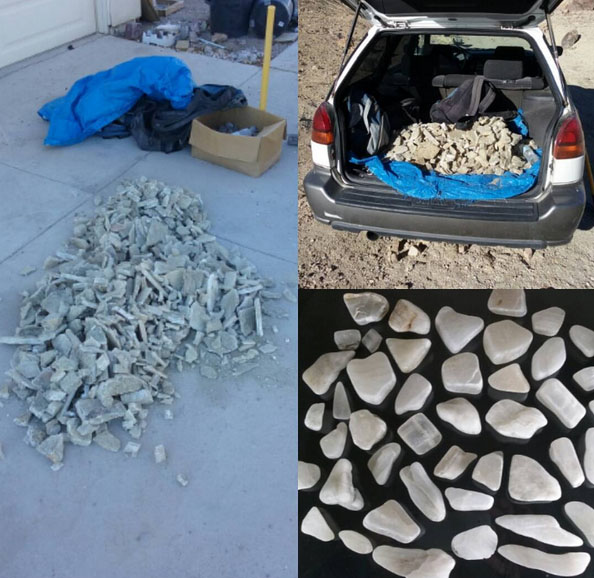
Mining Gypsum to use as a soil irrigation aid
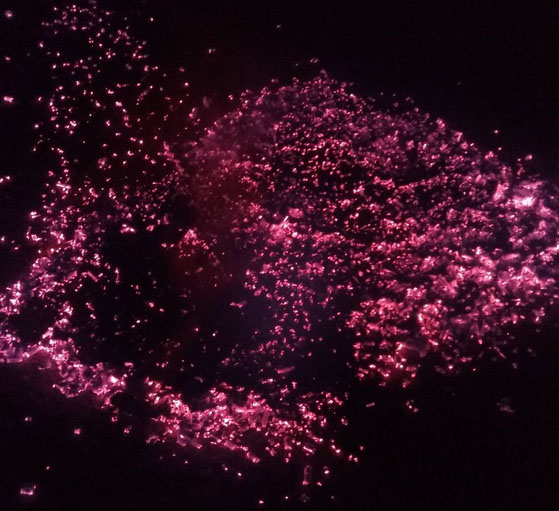
Pistachio wood trimmings are used for roasting and fertilizer, resulting in a beautiful cycle of nature and renewal.
Gypsum has a wonderful effect on soil, creating a path way for water to seep deeper into the ground. This is especially useful for this climate as the soil around the trees needs to soak in the water rapidly to the trees, rather than evaporating away from the top of the soil.
The larger pieces of gypsum were sold as tumbled stones by us at mineral shows.
There are two important times in the pistachios tree’s lives every year. In the beginning of spring, which is around March, the branches start to bud.
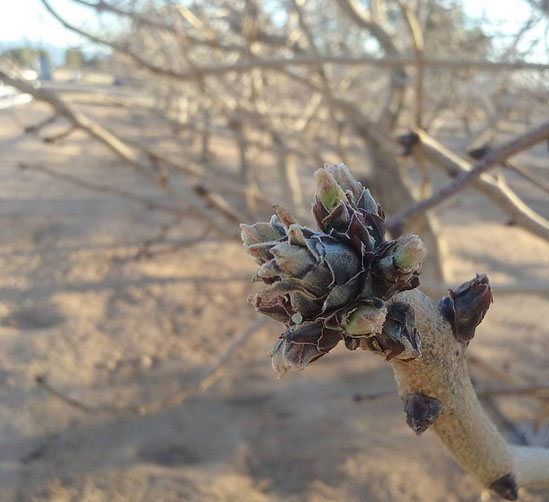
Female Pistachio Tree Starting to Bud
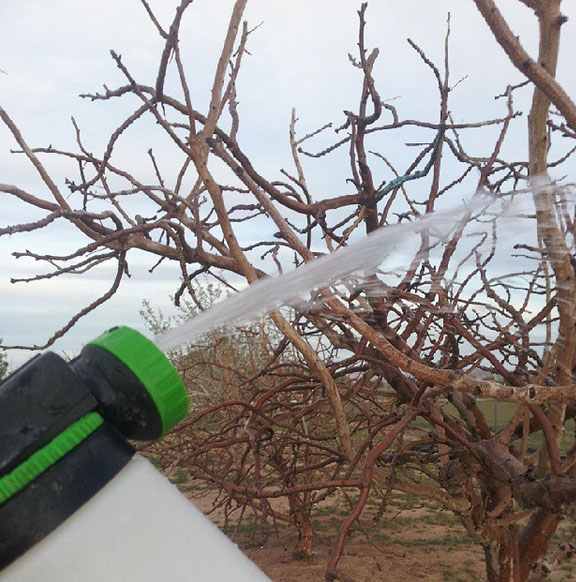
Boron, from crushed Borax crystals, and Zinc, are applied to the buds on the female pistachio tree just as they start to bud.
During this time, pollination is right around the corner, but first, they need a treatment of minerals to help them through the year. A mixture of Borax and Zinc are prepared and sprayed onto the tree’s branches, in order to do two things. The Borax, which we would mine in Searles’ Lake every October, makes the hard shell form thinner, which allows the pistachio seed to break open the shell while on the tree. You want this to happen, as the shell does not open any further after harvest without additional mechanical processing.
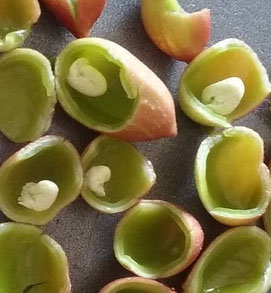
This is a developing pistachio, before it grows the thick brown shell you are familiar with. The Boron helps to keep the nut wall from being too thick, which results in more split nuts during harvest.
The Zinc allows the stems and seeds to hold fast onto the tree, which is very important because the winds in this part of the world can be devastating to an non zinc treated tree, dropping all the blooms and seeds onto the ground, resulting in a loss of pistachios.
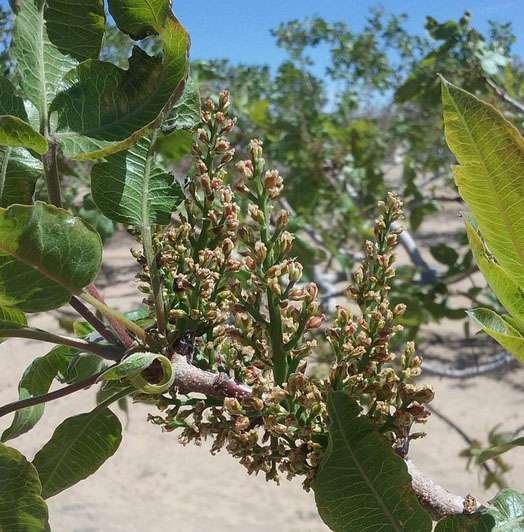
These tiny pollinated buds are now hanging on tight, so they can develop into full fledged pistachio seeds.
At the end of October and beginning of November, the trees are harvested. Most orchards are harvested by a nut collecting tractor, some smaller orchards, like ours, are best harvested by hand. With a dozen people armed with trimming knives and buckets, a couple hundred trees can be done in a few days. We separate the nuts from the stems by rolling them around on a large tarp, where the stems start to float to the top of the pile, then, scoop up the pistachios, put them in an industrial peeler which removes the fleshy coating, then float the nuts in a vat of water. The empty nuts float to the top and the ones with nuts sink to the bottom. They are then air dried and roasted with pistachio wood to fuel our ash needs for the following year.
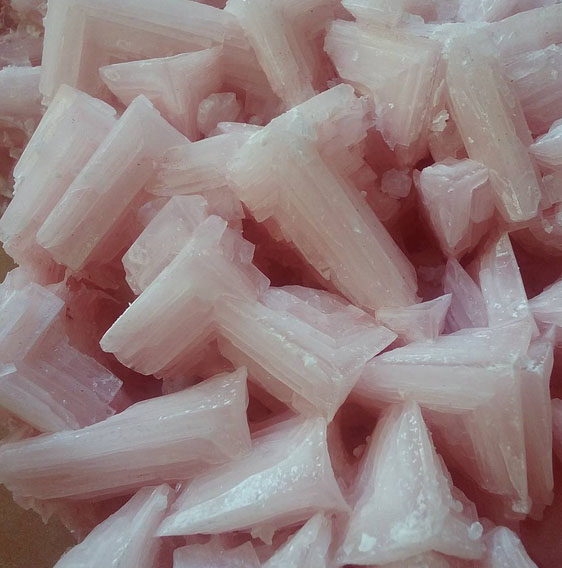
Natural Salt Crystals from Trona California
The end result?
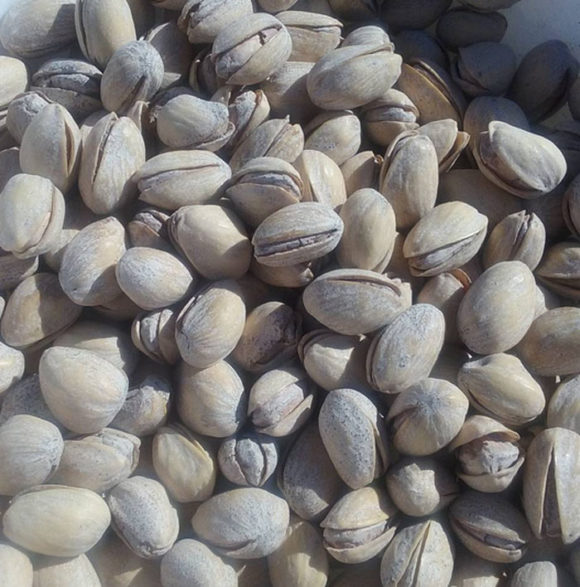
Lightly salted, lightly roasted, pistachio seeds in shell
Now you know what minerals are used in production of the delicious salty snacks you enjoy, hopefully, on the way to a rockhounding adventure!
Related posts:
A Tale of Two Cities – New Mineral Shops in Los Angeles and New York City
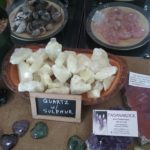
Two new mineral shops have opened up on both sides of the continent, in two of the most heavily occupied cities in America. Rock shops are great places to add new beautiful crystals to your collecting, but also to gain knowledge and information. It is certainly helpful to know what minerals look like when you are gearing up for a rock hunt!
In the Los Angeles area, we have a beautiful boutique of crystals in FasanaRock, located near the corner of Foothill Blvd and Myrtle Ave in the foothill city of Monrovia, just a few miles East of Pasadena. FasanaRock is the result of Christina and John Fasana, producing one of the most beautifully designed boutique rock shop! In FasanaRock you will find amazingly colorful and inexpensive tumbled stones from around the world, beautiful and colorful polished crystals, well selected and diverse crystallized minerals, raw crystals and all sorts of educational and decorative items of the natural sciences.
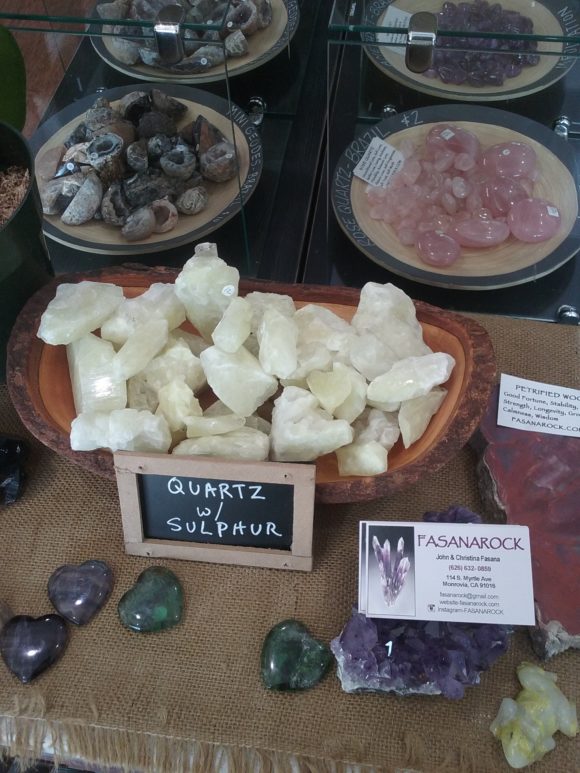
Sulphur Quartz, how Unique! Rub them together and smell ! FasanaRock on 114 South Myrtle Avenue, Monrovia California
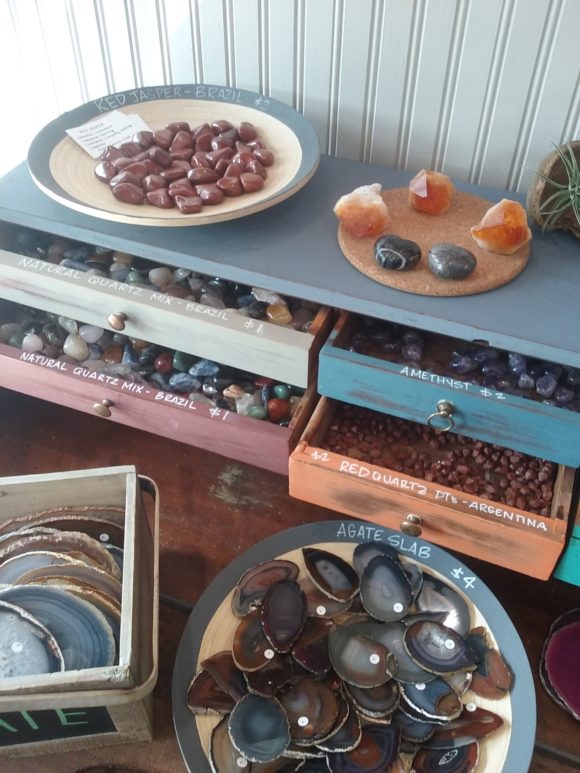
How great is this? Colorful furniture contain drawers full of raw crystal goodies! You can find all sorts of colorful additions to any collecting here!
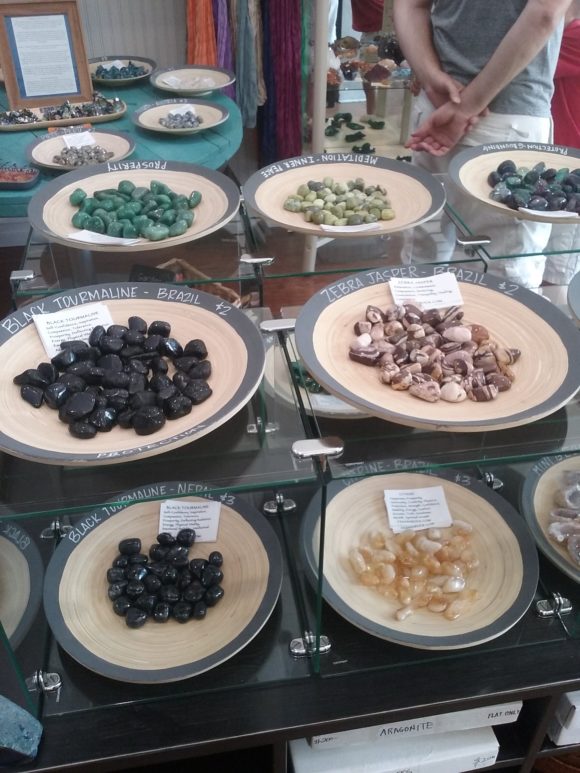
The wooden trays are the perfect way to offer this beautiful selection of tumbled stones!
John Fasana has worked for Rock Currier and Jewel Tunnel Imports for decades, making his knowledge of stones known in the fine selection at the shop.
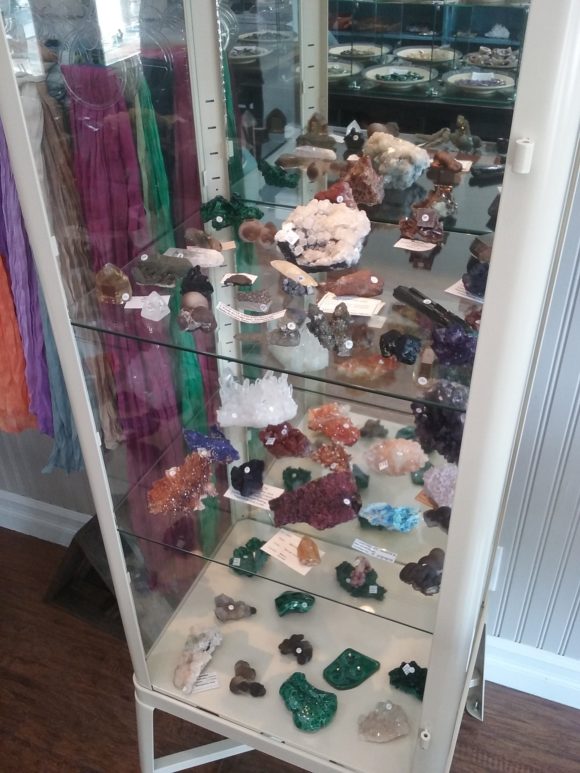
Great selections of mineral specimens at very fair prices!
Christina Fasana has outdone herself with the store decor, incorporating thoughtful and functional design elements into the presentation of the stones. Along with their family, the Fasana’s have put a lot of heart and soul into this new mineral shop and it is well worth your time to visit it if you are in the Los Angeles Area – Check them out online at their website http://fasanarock.com/ and on Facebook and Instagram
FasanaRock carries Gem Hunt, educational gemstone dig kit – a perfect gift item for christmas!
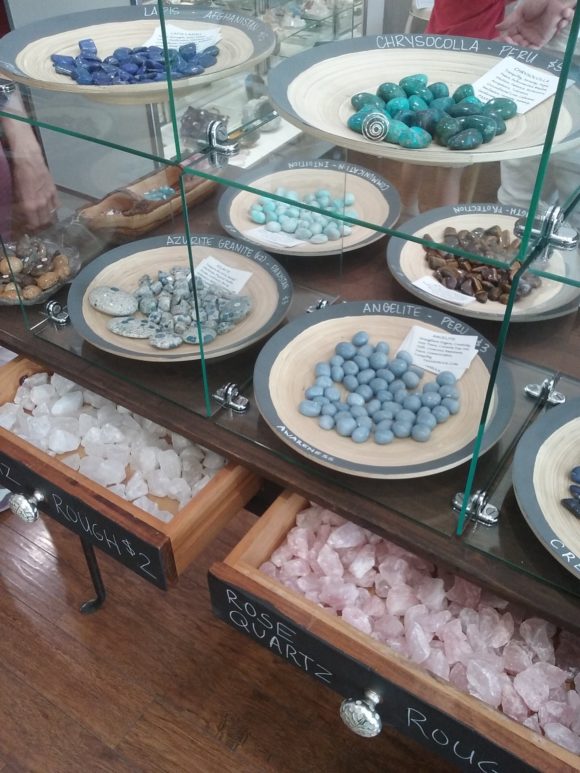
A store that can provide beautiful minerals and stones at very fair prices, centrally located in the foothill community, FasanaRock is well worth a visit!
In New York City, an off-shoot of Astro Gallery of Gems, we have Astro West, a store with all the things you know and love about Astro Gallery, with cases of fine minerals, beautiful fossils, and a diverse section devoted to educational natural science kits and interactive crystal features like “crack your own geode” in a sleek looking geode cracking machine.
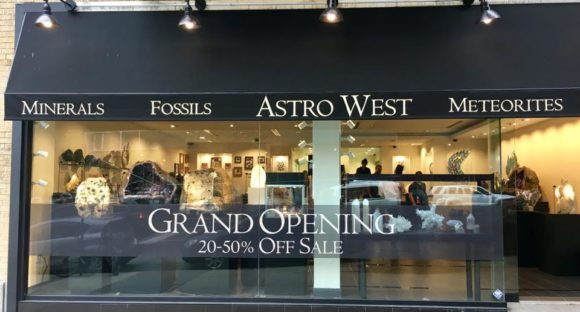
Astro West – A great place to visit in the Upper West Side New York City
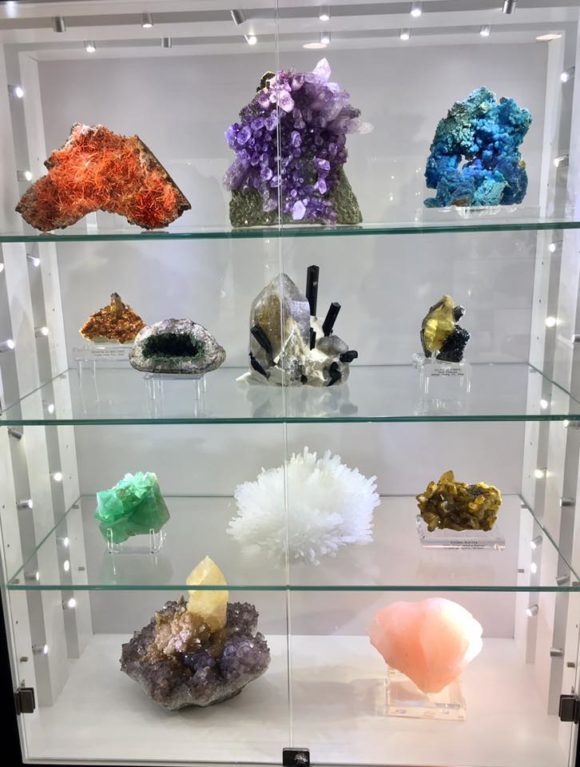
Beautiful Crystals line the cases, ready to be wrapped up and taken home!
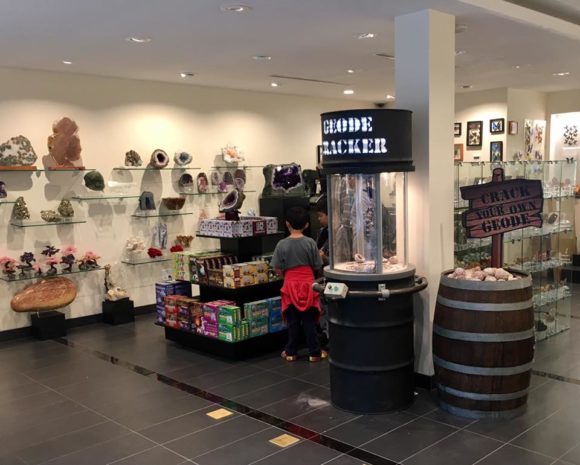
The Geode Cracker is fun for all ages and the educational kits are selected for everyone who loves rocks, fossils and natural science!
You can find Astro West online at AstroWest.com and also, find them on facebook at https://www.facebook.com/Astroweststore
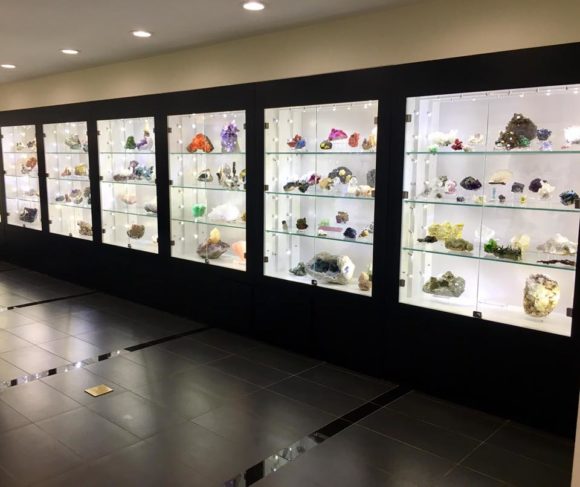
It is easy to see why AstroGallery is known for beautiful crystals, all over New York City, now you have two locations to visit!
Check out the website FindARockShop.com for rock shops in your area and as always, thank you for visiting WhereToFindRocks.com!
Related posts:
Dinosaur Aged Amber from the Sayreville New Jersey Clay Pits
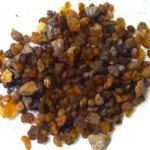
Article and Photos by Paul Cyr- eonphader@hotmail.com
New Jersey is no stranger to geological anomaly. Most American rockhounds are familiar with the fluorescent minerals of Franklin and Sterling Hill, and thousands of people from around the globe have graced their collection cabinets with prehnite and other traprock minerals of the Watchung mountains, giving a classic “old school” scientific feel to that shelf of the display. New Jersey has also produced its fair share of paleontological specimens, including many holotypes and species completely new to science. Some of the most interesting finds include gem grade amber with insect inclusions from the Sayreville and Cliffwood Beach areas.
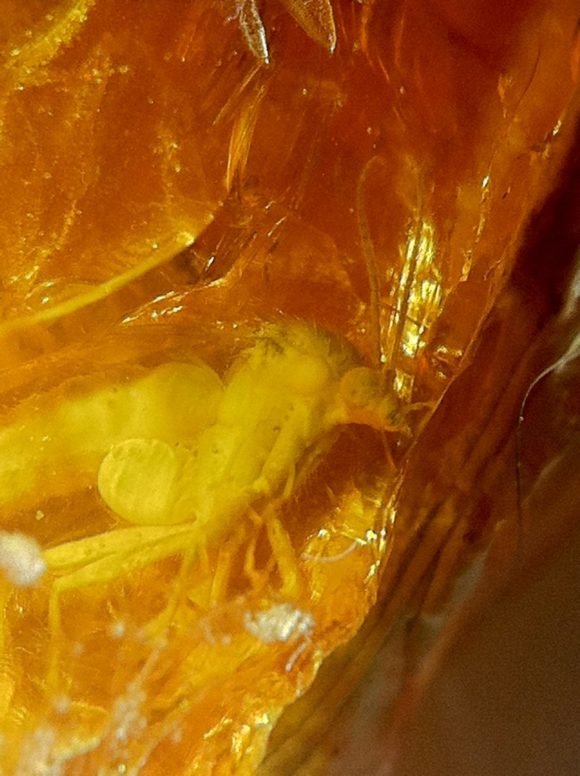
Insect inclusion in a large polished piece of Sayreville amber collected December 3, 1995. FOV 7mm.
The amber occurs within the lignite peat layer above the deep deposits of the South Amboy Fire Clay. The New Jersey amber is the oldest in the Americas with insect inclusions. From this amber, researchers have discovered several new species of ants, including the oldest ones ever documented, giving new branches in the evolutionary line of ants. According to a paper by the American Museum of Natural History researchers, there are a dozen or more amber producing localities in and around Sayreville, but here will will focus on one. In the 1990’s, this locality was monitored by the research department of the AMNH. This study accumulated hundreds of pounds of amber from the Sayreville area, including thousands of specimens with insect inclusions. This was a part of a grand study involving insects included in amber from all over the world. Through this research, many new species of insects were added to taxonomy. Did we mention there is pyrite too?
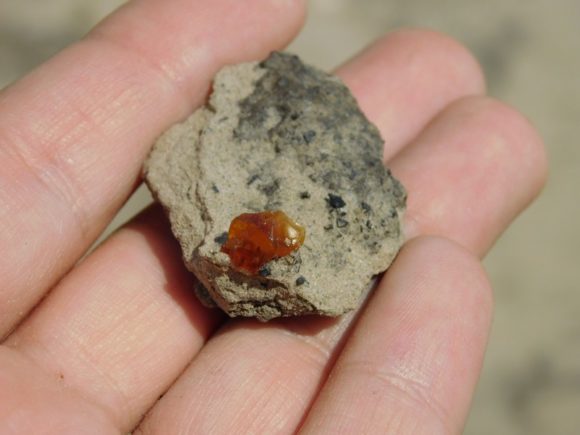
A nice sized piece of gem amber on clay matrix, with lignite. Fresh harvest.
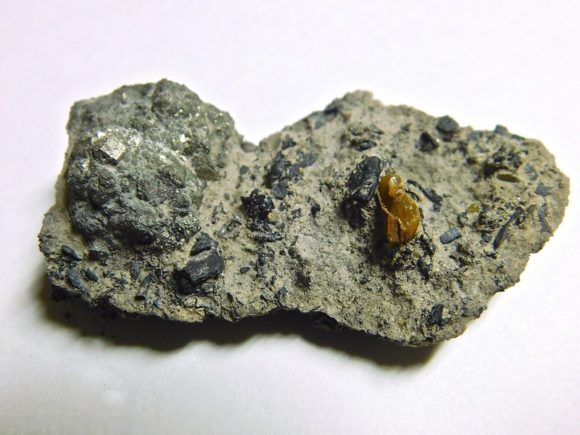
The Good, The Bad and The Ugly: Amber, Pyrite and Lignite in one specimen. With some careful transport tactics, examples like this can be preserved.
You can find the author Paul, along with the website owner, Justin Zzyzx, at the Edison New Jersey Mineral Show – April 7-9th 2017 It is a CAN NOT MISS Event- Click the Banner and sign up for the mailing list for more information!
For tools, it is recommended to bring various shovels, picks, small metal rakes, and other digging and scraping apparatus. The porous, but thick and sandy clay behaves differently depending on how wet it is, so you may want to try a few different tools to figure out what works for you. Bring a small plastic vial or jar to keep your amber isolated and safe.
If you have nothing else, a nearly empty plastic water bottle with a bit of liquid left in it will keep your amber safe, and clean it up a bit too.
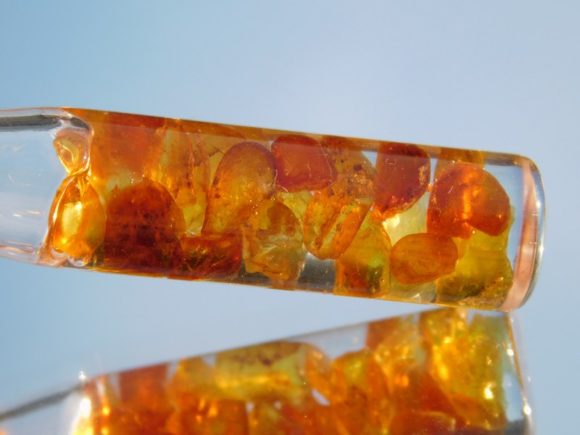
Fully prepared, gem grade amber pendant shows off a warm glow in sunlight.
In my experience, most of the pyrite is found on the surface, and appears to form due to the iron and sulfur nucleating in the center of the puddles in the cracked clay mud. The pyrite is mostly unstable, and will quickly lose its luster and begin to disintegrate if special precautions are not taken. The main key is to keep it completely dry. I have heard that putting it in a cool oven can help remove all moisture. I have used 3-in1 oil to give them a day dip, and take them out to dry. After the pyrite nodule is dry, apply a few layers of spray acrylic. Unfortunately, only a few of my specimens have held up to this point, but they are unique items in our inventory. Some post-pyrite secondaries seem to be found in microcrystals on some of the pyrites as they alter in the weather. Melanterite and jarosite may be present. More research needs to be done on the pyrite alteration at this locality.
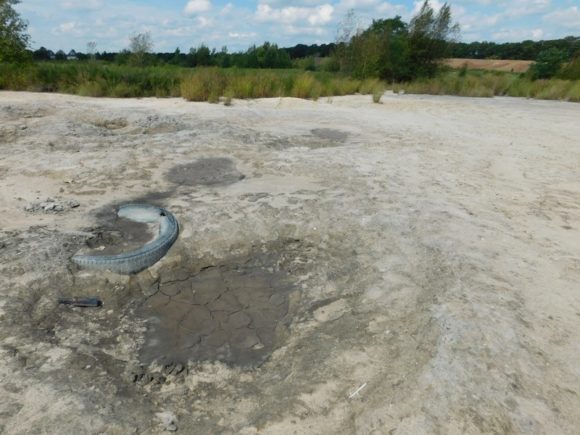
No pyrite in the tire, I checked.
The amber can be founded in small rounded grains along the surface. If you are looking for the large pieces with insect inclusions, you’ll have to dig. The lignite layer is a few feet down (I have heard anywhere from 4 to 9 feet subsurface). Lignite is the precursor to coal, and looks almost exactly like burnt wood. When you get down to this level, you are on the right track. In and around the lignite, you should be able to find evidence of amber soon enough. A nice sized piece with an insect inclusion could be the reward for your hard work.
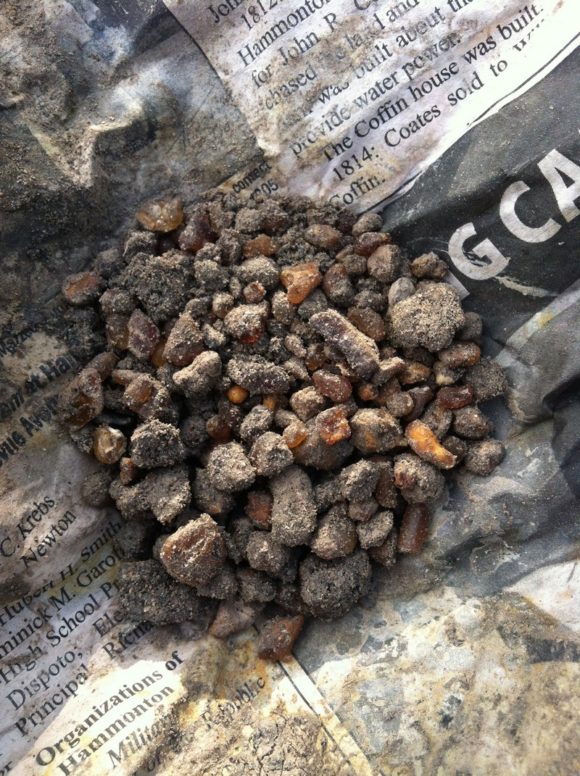
Fresh amber in the field.
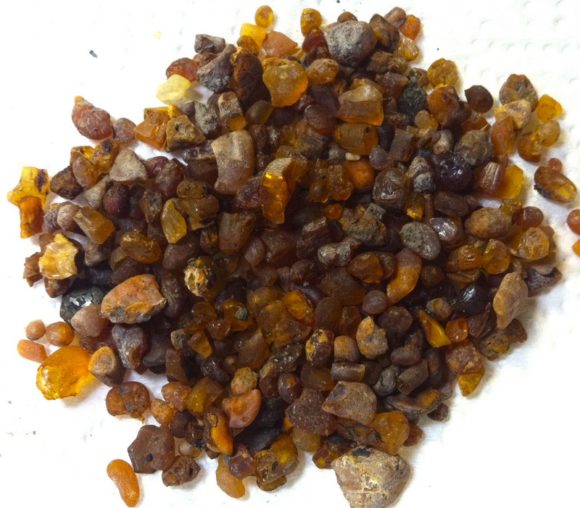
Same pile of amber after first cleaning.
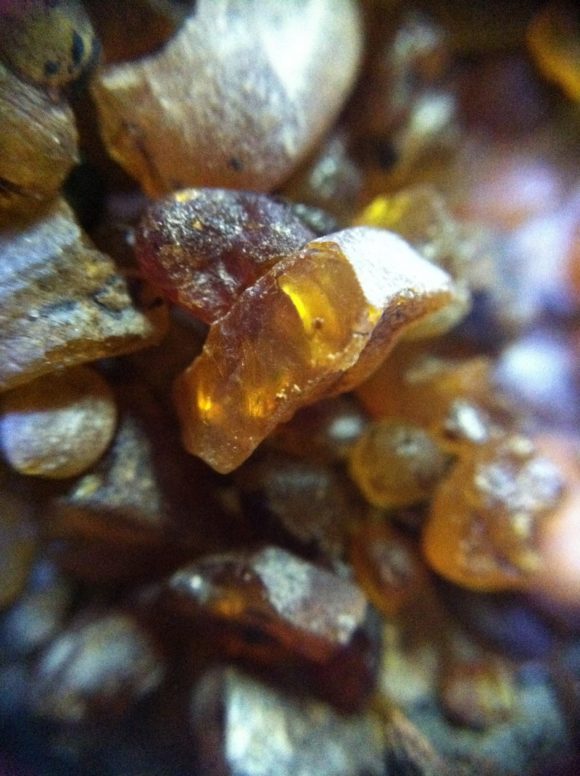
Closeup of the amber.
Plant matter within the amber has been found to be in the juniper family. The lignite peat deposits were probably formed by ancient coastal cedar swamps. The age of this amber has been recorded from 90-92 million years old, in the midst of the Cretaceous Period. Amazing that something so fragile can still exist! This is one of, if not the ONLY locality that produces amber from the same time as the dinosaurs. If Jurassic Park was to happen, we would be thanking New Jersey amber for the DNA. Some of the forms are stalactitic, showing evidence of where it dripped from the tree. It is remarkable to find such objects. Some of the amber is opaque and looks like tan to brown wood opal, with similar luster and conchoidal fracture. The amber ranges from a yellow-hued honey color to a rich cherry red, and can also be brown. It is transparent when wet or polished, making for a beautiful finished product when worked. One gentleman has told me that if you have a big and stable enough piece, it can be polished with a toothbrush and toothpaste- but it takes quite a while. I have a specimen he polished this way in my personal collection. It is almost an inch tall and has a distinct and complete winged insect inclusion. It is one of the treasures of my New Jersey collection.
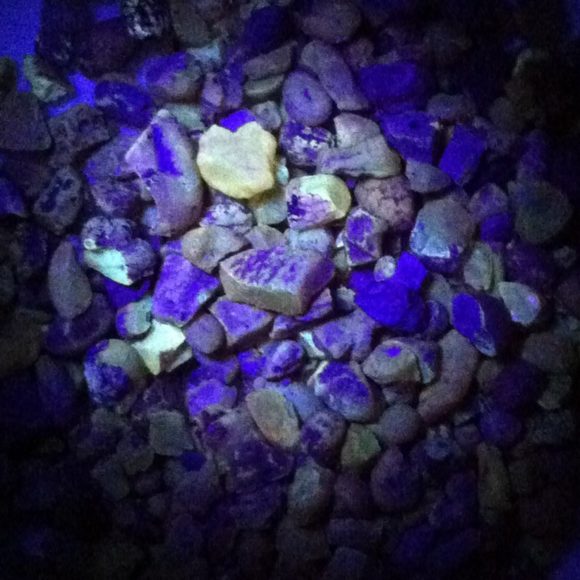
It’s fluorescent. Most of the amber glows brightly in standard longwave UV light.
To get there, plug in Lakeview Drive Sayreville, NJ into your GPS. When you get on this road, you will be in an apartment complex. Keep following to the end of the road, and park in the little cul-de-sac conveniently located at the trail head. The trail may look enticing, but avoid it unless you plan on exploring for possible separate amber pits. On the left side of the path, climb up the hill right next to the parking area and cross the railroad tracks. You’ll come to the other side where there is a trail. Make a left onto the trail, soon the terrain will flatten. Walk a few hundred feet down, and look for a dip in the brush on the right side. It is crude getting in to the pits, and ticks can be plentiful- use caution.
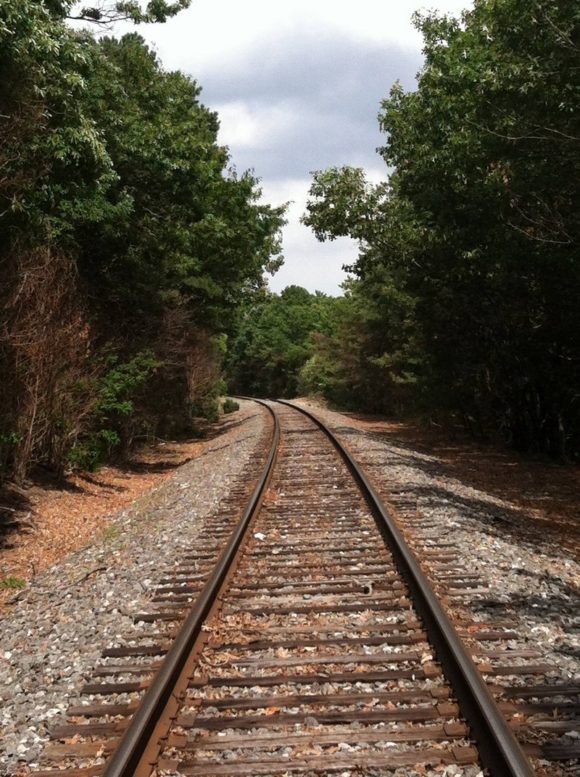
The Railroad to Amber. Cross over here. Beware of trains.
Ramble through the deer trails- a shovel or sifter can act as a shield through the thicket. Out in this stretch of bush you’ll reach the mud pits, dotted with amber and pyrite to the discerning eye. You may want to check a satellite view on Google Earth for a precise look at the field.
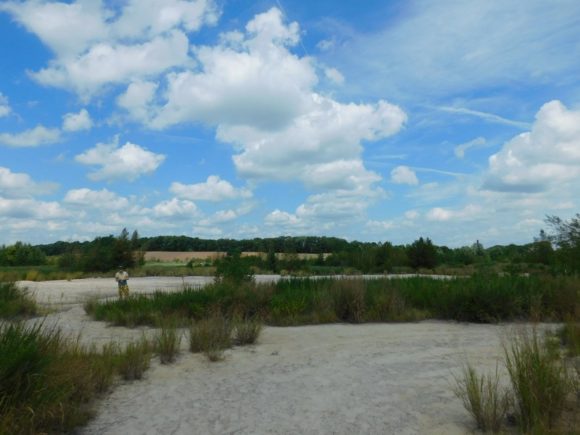
You’ve made it. Welcome to the locality.
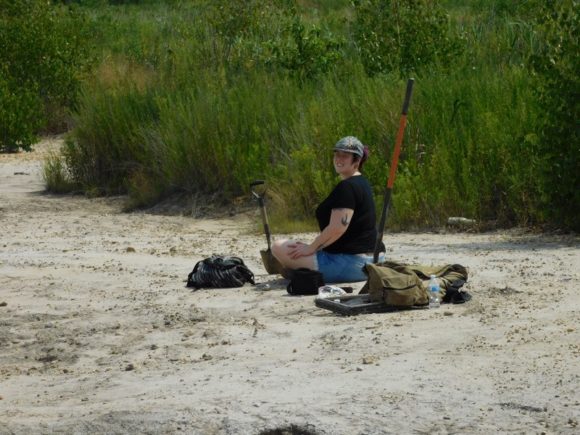
A happy amber collector enjoying the ancient fruits of the labor.
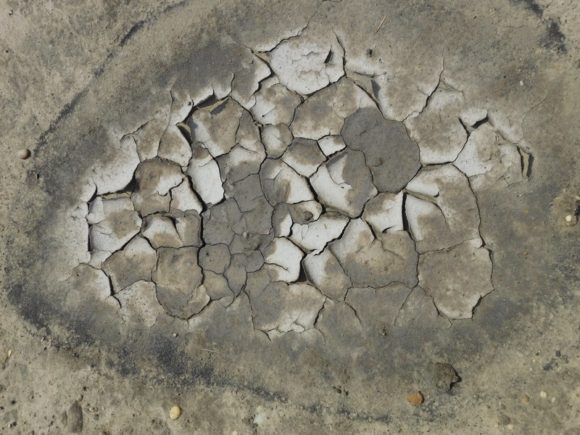
This locality is known for its aesthetic cracked mud.
For lunch, I recommend White Castle in Parlin- new veggie burgers are delish! Good luck, and email me if you find anything substantial! Paul Cyr- eonphader@hotmail.com – you can also find Paul and his minerals for sale on Facebook – at the Deep Seeded Trading Post
This video will give you a visual idea of what to expect at the location
Collect Amber and Pyrite in Sayreville New Jersey created by Justin Zzyzx in 2005, now hosted on Vimeo.
Again, don’t forget to sign up for the mailing list for this great rock and mineral show in Edison New Jersey, one of the biggest shows in the United States!

Related posts:
Franklin New Jersey, a Mineral Wonderland
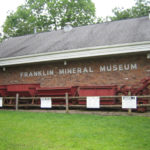
Franklin is a town in Northern New Jersey that has been a fixture in the mineral world for well over a century. Our friend Vandall King has been hard at work for several years on an informative book on the subject.
Instead of us rehashing the subject, we want to showcase the four videos that have been produced to talk about the project and the subject. We are sure you’ll want to pick up the book when it is released – until then, enjoy these videos! If you enjoy them, please leave a comment on the videos and give them a thumbs up.
Franklin Video 1
Franklin Video 2
Franklin Video 3
Franklin Video 4
You will be sure to find out when the book is released as we will be certain to tell you here on WhereToFindRocks.com!
Related posts:
Red Jasper and Celestite Geode Specimens found near Hanksville Utah
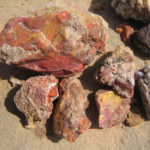
Every year we look forward to visiting one of the most beautiful places in the world, the San Rafael Swell, a series of sandstone, shale and limestone that has been worn down by erosion by water, air and time.
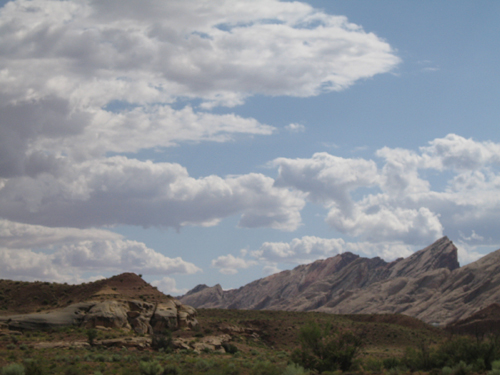
A group of rain clouds hangs in the air above the dramatic rock formations of the San Rafael Swell
One of the best things is that the collecting locations are fairly close to highway 70, a road we travel every year in order to go back and forth from California to Colorado for the annual Denver Mineral Show, which is taking place as I type this.
For rockhounds and lapidary artists, the bountiful red/yellow jasper found in this area is worth stopping for. The jasper nuggets are found with a bubbly rind, colors caused by iron oxides, accepting a fine polish.
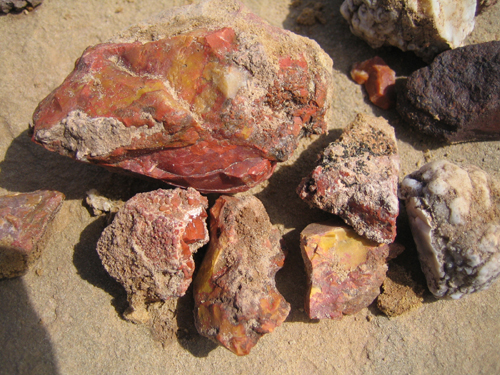
Red and Yellow Jasper with a bubbly rind, found near interstate 70 in central Utah.
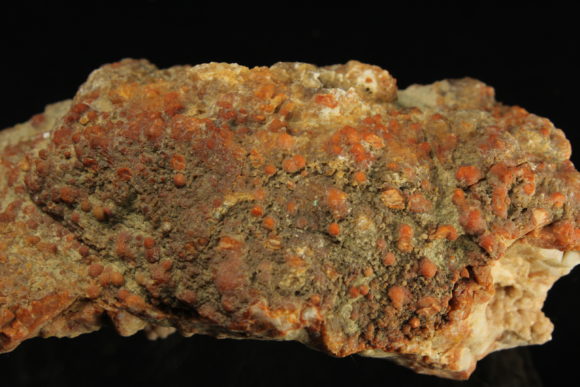
Bubbly Red Jasper Rind on a Crystal Filled Geode
There are several areas to collect jasper, as you can see on this map, the two main areas are directly south of I-70, both accessible with a standard passenger vehicle. The first location is just north of a dirt road you enter heading West, .7 mile from the exit on route 24. The next location is on a dirt road heading east 4.2 miles from I-70, or 3.5 miles from the first dirt road.
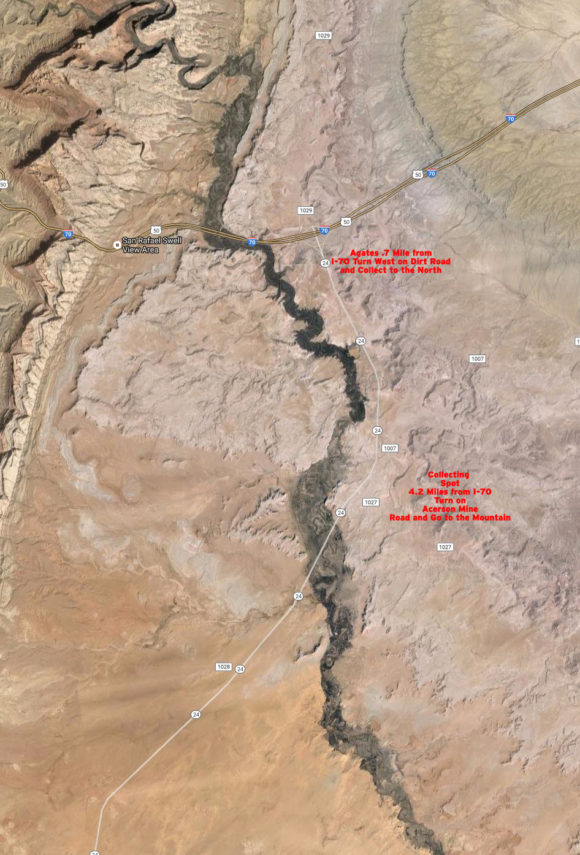
Two Jasper locations off highway 24, just south of interstate 70
The exciting thing to find while out looking for jasper are thin walled geodes with crystals of celestite, calcite and quartz inside. By gently splitting along the cracks in the walls of the geodes, you can find bright blue crystals of celestite, up to 4.5 cm, along with calcite in various forms and colors and druzy quartz, sometimes with an amethystine color.
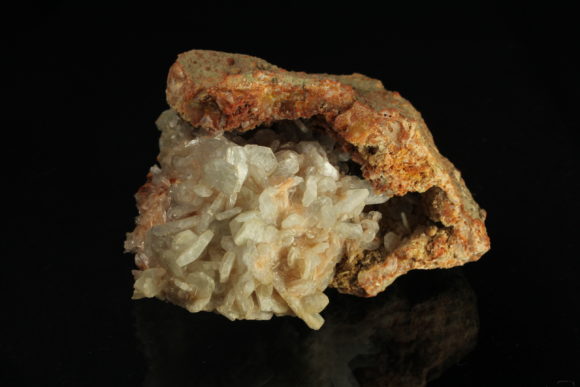
Celestite Crystals inside a geode of Red Jasper
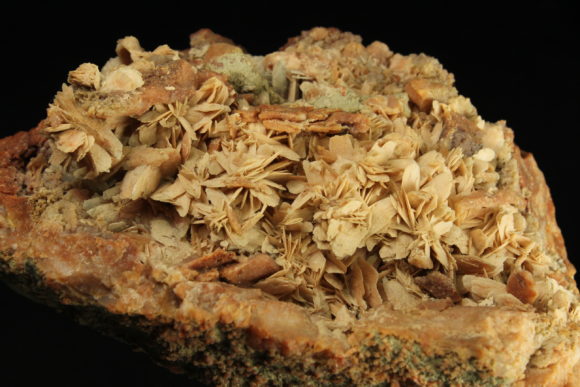
Thin blades of Calcite forming on the inside of a red jasper geode
The geodes are created due to the fact that they were originally filled with anhydrite, which then dissolved, mixed along with the marine sediments, giving the proper environment for celestite to form. The celestite in this area used to be mined commercially back when celestite was in demand. Now, there is very little demand for the raw material, which can be sourced very cheaply from sources around the world. The celesite is now mined for mineral specimens, sporadically.
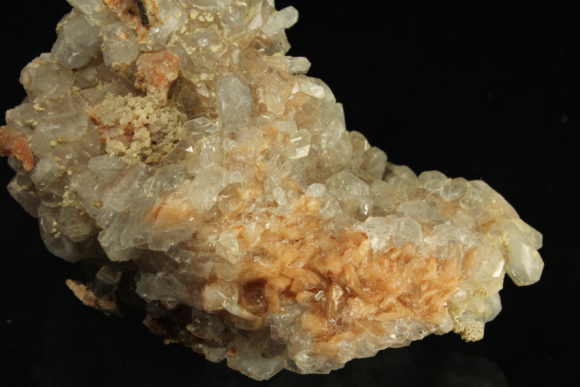
Orange Calcite crystals with Blue Celestite crystals from the Swell
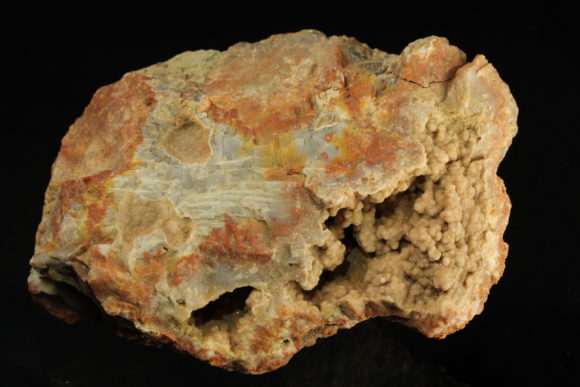
Gray sparkling Quartz in a Jasper Nodule
When looking for these jasper geodes, you can often tell if there are crystals inside by the weight. Be careful not to shake the geodes violently, as loose crystals can smack into the crystals attached on the matrix. You most certainly do not want to smash these geodes open with a hammer, you can typically find a crack or fissure in the wall and pry it open with a screwdriver.
Utah is a beautiful place. This remote, yet, heavily traveled, area of the world, is a perfect reason to stop and stretch your legs! I hope you enjoy a trip to this area at least once in your life!
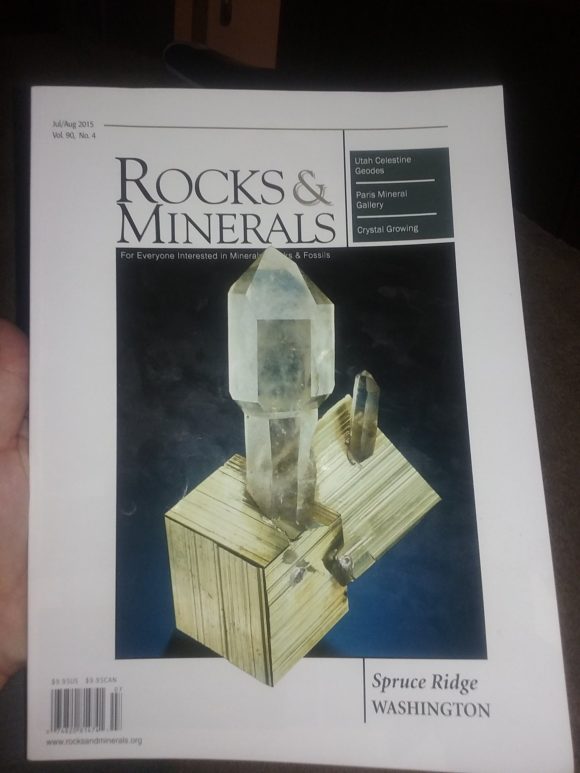
Cover of the Rocks and Minerals issue with a very well written article about the Celestite Geodes of The San Rafael Swell.
We highly suggest this issue of Rocks & Minerals photographed above. Rocks & Minerals is well worth subscribing to, they are one of the best mineral magazines ever printed.
Related posts:
The Springfield Massachusetts Dazzling Mineral Displays!
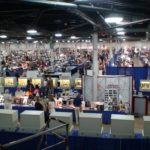
Every year the town of West Springfield plays host to the East Coast Gem and Mineral show by MZ Expos. Each year the show has the finest dealers from all over the united states and the world, bringing to you specimens of colorful minerals, amethysts and fluorites, gold crystals and books and literature about all sorts of mineral topics! Knowledgeable people, free lectures and every year, a featured exhibit with a very special twist.
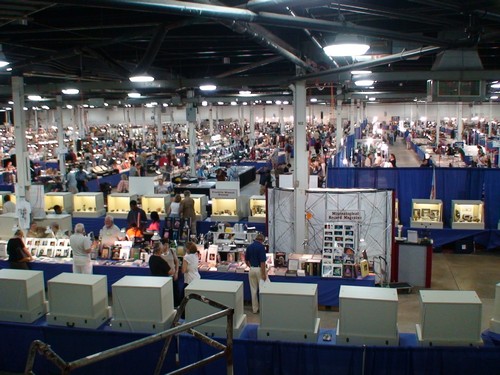
Overhead shot of the 2007 East Coast Mineral Show in West Springfield, Mass
For many years the East Coast show followed the usual club show format, with a variety of collectors and dealers being invited to display each year. Under those conditions, the quality of displays can be unpredictable and sometimes disappointing. The first year with a special theme was 1998, when Illinois minerals were displayed by Roy Smith, Ross Lillie, and Tom Weisner.
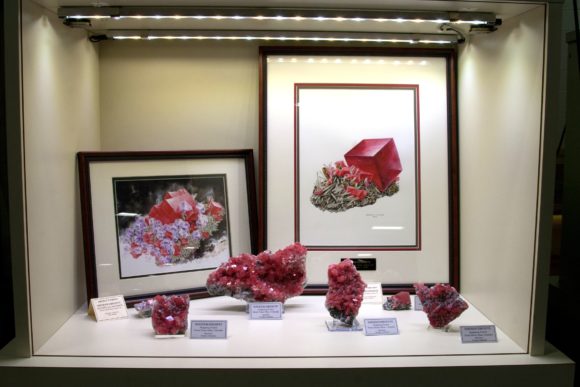
Fredrick Wilda East Coast Mineral Display Case of Rhodochrosite from 2012
The single (or limited) exhibitor theme was viewed as a way to be different from most other shows. It has given visitors a chance to view many private collections that are seldom on display to any extent. Private collectors and museums have enthusiastically participated since the start. The exhibitors seem to enjoy the challenge of displaying, and the chance to share their collections. For the EC staff, it is much easier to coordinate with just one or a few individuals. The “special exhibitor” program has been a win-win situation all around.
MINERAL SHOW EXHIBITORS
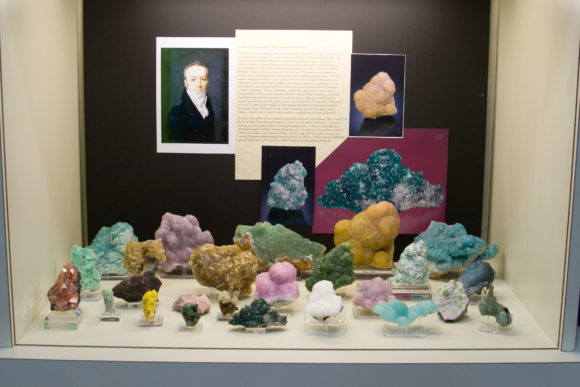
Glossy Smithsonite Specimens from the Gail and Jim Spann Collection, on display in 2009
This year features free public lectures by Bob Jones, Peter Megaw and Kevin Downey on a variety of subjects – Admission is $8, you can save $2.00 with this coupon link. The event is at the Better Living Center and runs August 12, 13 and 14. There are nearly 100 dealers to buy from and the Mexican Mineral Collection on display, by Peter Megaw is an amazing chance to see a private collection that will show you beautiful top quality minerals from all around Mexico. The colors, shapes and forms of these classic minerals will astound you! Find out everything you need to know on the MZ Expos website, MZExpos.com
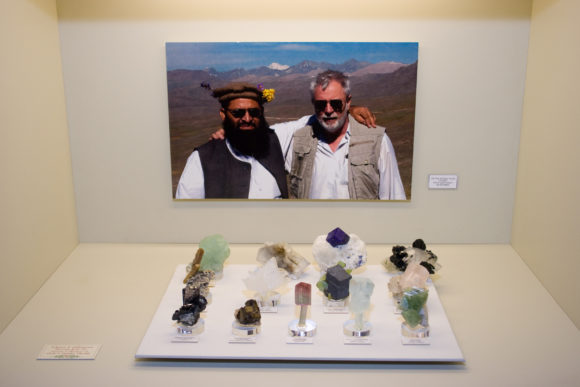
Herb Obodda traveled in the Afghanistan and Pakistan mountains in search for the very finest crystallized minerals found in those rich deposits.
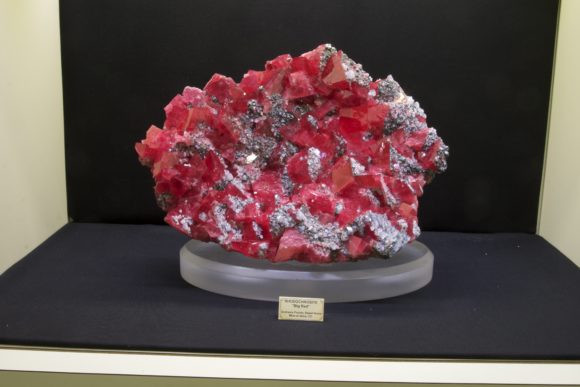
2011 had the Scott Rudolph collection, featuring this AMAZING Rhodochrosite from Colorado
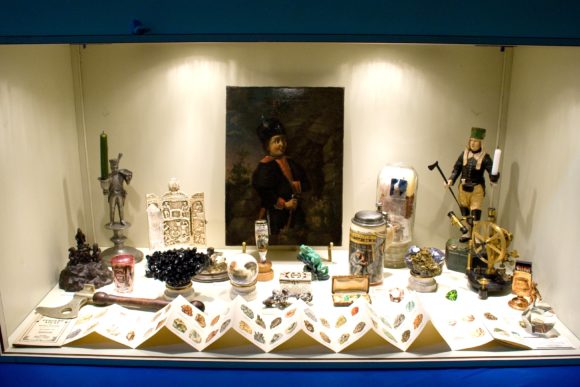
2008 Herb and Monika Obodda Collection
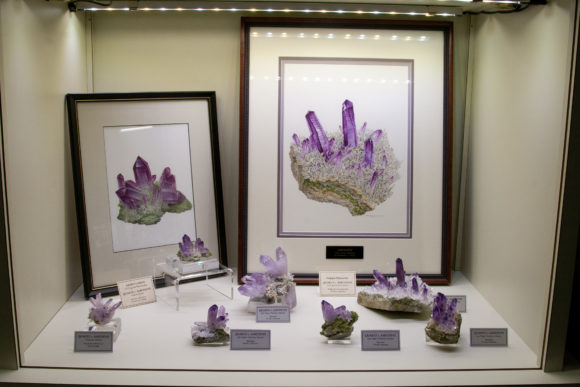
Amethyst Clusters from Mexico from the Artist Frederick Wilda, 2012
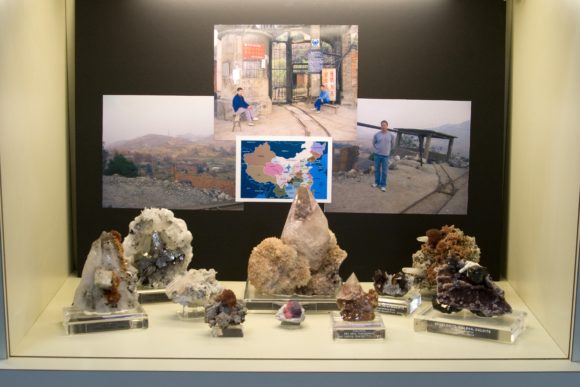
2009 Display Case from the Gail and Jim Spann Collection
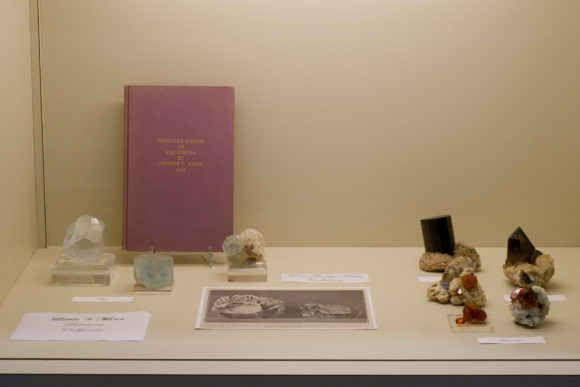
Bill Larson’s collection is rich with history and american classics, like these pegmatite minerals
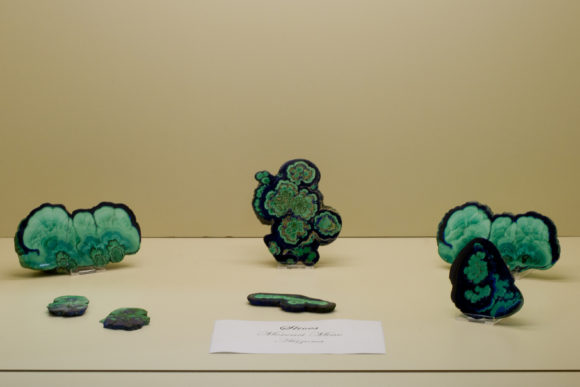
Beautiful Malachite Slices from the American Classics of Bill Larson/Pala display in 2011
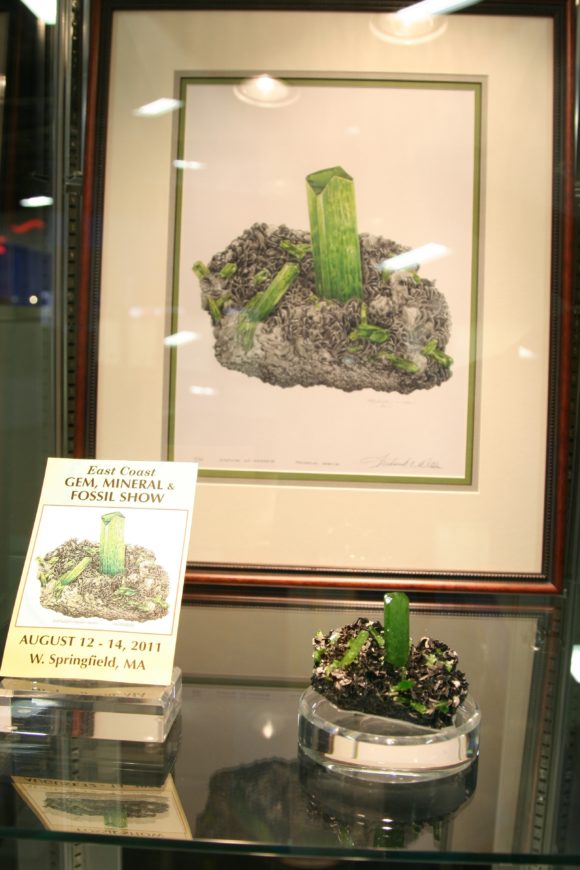
Scott Rudolph’s collection from 2011 featuring this beautiful Diopside on Graphite.
Photos by Cindy Rzonca
Related posts:
Every mineral collector and rockhound should have these books by John Sinkankas
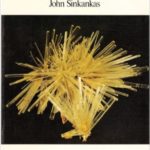
Rockhounding is a great hobby, rewarding and full of adventure. Few people know that to progress in knowledge about this hobby is easy as can be, it just take a little bit of reading and we have the perfect selection of books to talk about today, ones that will give you a full understanding of minerals.
All of these books were written by Captain John Sinkankas, a well noted and respected author who has a way of explaining things that many thousands of people have enjoyed and understood.
The most important thing about this article is the perception of mineral information, versus the reality. Guidebooks like the National Audubon Society Field Guide to North American Rocks or the handy Smithsonian Handbook, well, they just do not do a good enough job, in our opinion. Sure, they are colorful and glossy, most starting collectors will have one or the other at some point in their life. However, if you have more than just a passing curiosity about rocks and minerals, there is a better way.
Mineralogy is the #1 book that we recommend to all mineral enthusiasts. The writer, John Sinkankas, has an easy way of explaining how atoms form crystals, and why the crystals different properties make them look different from each other. It is technical mineralogy explained in a way that most anyone can understand. The book can be treated as a college level book on the subject, yet, can be enjoyed casually with chapters devoted to different topics including over 300 photographs and line drawings, this is the must have book for everyone interested in the subject. You can find this book on Amazon and eBay. It was originally published in the 1960’s, any edition is worth owning. You will find it as a “Used” book, it typically retains value as it is a book that all mineral and rock collectors have loved for decades.
Gem Cutting: A Lapidary’s Manual is John Sinkankas’ perfect tome devoted to all the basics of lapidary. The mystery of most every lapidary art is reveled, along with photographs and drawings to guide you to understanding the complete basics of lapidary arts. In the first chapters you are introduced to sawing, grinding, lapping, sanding, and polishing. Rock drilling is a common question, this book gives you the knowledge on that, plus, all the tumbling, cabbing, faceting, sphere-making, carving and engraving and mosaic and in-lay work information, including tools of the trade, tips on techniques and so much more. When I need to know what polish to use when I’m tumbling stones, I look to this book. This has an amazing wealth of information on this subject. The second edition is the edition we suggest and the big paperback edition is a great addition to any library.
Prospecting for Gemstones and Minerals is a perfect primer to understanding where to find rocks. Deposits are explained, how to find them, what is inside of them, and how you can get crystals out of the ground. This book serves as a primer to all topics on the subject of rockhounding. Over 350 pages of quality information, that, if you were to read, would put you in the ranks of the top collectors.
All three of these books are easy to read and understand, teach you the basics and the nuances of each subject are highlighted and explained. To read and understand these three books is to have a near complete general knowledge on this subject of rock and mineral collecting.
Related posts:
Best Practices Guide to Gem Show Display Case Design
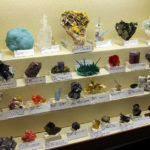
As time goes by and your rock and mineral collection grows, you may start to ask yourself, “What can I do with all these rocks?” Of course you already display them at home and you are constantly showing them to your disinterested friends and family, but have you ever thought about showing your crystals to the public?
Creating a Display for your local rock or gem show is a fun and creative way to share your love of crystals and minerals with others. Most rock clubs love to have their members and other collectors within the community exhibit their gem and mineral collections during their annual rock shows and tail gates.
In my decade plus of working within the rock and gem show world, I have seen, and created a great many rock and mineral display cases… some even winning awards at the Tucson Gem & Mineral Show™. From this experience I present you with Brandy Zzyzx’s Best Practices Guide to Gem Show Display Case Design.
Step 1. Contact Gem Show Display Coordinator for permission to participate
The first step is contact the Display Coordinator for the Gem Show in which you wish to display. For larger mineral and rock Trade shows, this information is often easily found the show’s website, but for smaller, local shows many times this information is not listed on the show’s (or club that is hosting the show’s) website, or they do not even have a website. If there is no Display Coordinator, try to contact the Show Promoter or Show Chair. Or speak to any member of the hosting club that you may know, and they should be able point you in the right direction.
Before being able to exhibit your rocks, you will be asked to fill out 1 or more forms and/or releases. Each club as their own specific rules about cases, liners, and appropriateness for general (non-competitve) displays. More advanced collector’s may wish to compete for display awards that may be given out by the club. These types of displays have additional rules, specifications, and forms. If the club is a member of American Federation Mineral Societies, these competitive display rules and regulations are determined by the federation; making them consistent across all rock and gem shows in the US.
After you have secured a case for the duration of the gem show, and have been given the display case dimensions and the date of the show, it is time to plan exactly what you want to display and how to go about it. Sure you probably already have an idea of what you want to do, but now is the time to finalize those plans.
Step 2. Pick a Theme or Statement of Purpose for your display case
Anyone can throw some rocks in a case, but that doesn’t make it worth looking at. Don’t kid yourself; if you phone it in, everyone who sees it will be able to tell that you didn’t even try. So before you pick out any rocks, ask yourself why you want to put together a display case and your purpose for sharing your collection. The answer to this question will make putting your case together so much easier and aid you in creating a visually appealing display.
What is my purpose for displaying my rocks & minerals?
Answer 1.To showcase my collection of rocks & minerals
What one thinks of as traditional rock and gem show display cases. Usually they are a sampling of collector’s personal rocks and crystals, however they can also be compiled by a group of people or a case presented by museum or school. In some instances the display case may be on a theme, such as minerals all the same size, all specimens from the same locality, or all the same type of mineral. Traditional display cases usually have very little, if any signage except for specimen labels, because the rocks, crystals, or gems are the main focus of the display.
Answer 2.To teach the people about rocks & minerals
Display cases that are educational in nature are usually submitted for display from schools and museums; however it is not uncommon for companies and advanced mineral collectors to also create informative displays for larger, international gem and trade shows. Sometimes the displays are scientific and technical in nature, often times showcasing more specialized or vocational rock and mineral information.
Another popular example is detailed timeline of the operations of particular locations or discovery history of a specific mineral type. These types of displays usually have many signs, graphs, charts, photos, and labels; sometimes even paragraphs of text to read. Illustrating and educating the viewer about the rocks or minerals is the primary focus of the display; specimens are used to convey the information
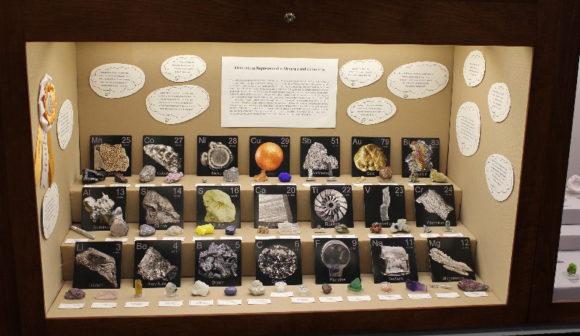
Eye catching display pairs real mineral specimens with printed stand-up pictorial signs representing elements from the periodic table
Answer 3.To share my experiences with rocks & minerals
Display cases that may be related to rocks and minerals, but are actually more about telling a story or relaying a feeling or memory. These types of displays are often very different from the displays around them; they showcase the achievements or thoughts of the humans involved as the main focus.
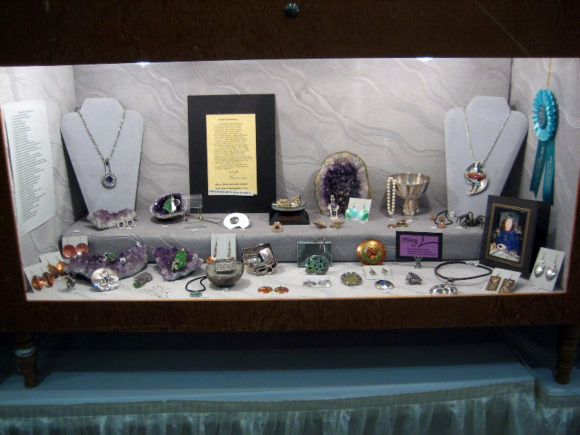
Sharing your hobby or craft in a gem show display case is a great way to get both exposure and feedback on your creations.
The rocks and minerals provide a social construct for the sharing of mutual interests and experiences. Immediately recognizable, most commonly seen examples are displays of someone’s art, craft, or other creative endeavors, and what I call meta-displays. This is a display inside a display.
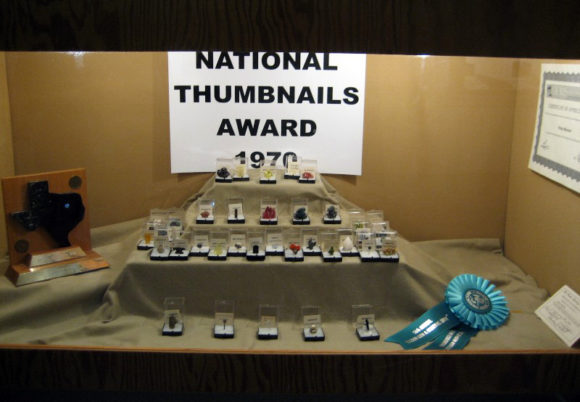
Creating a Meta-Display, or “display within in a display” is a clever way to commemorate a past achievement or memory.
For instance, the specimens and awards from a winning display case 25+ years ago recreated now. Memorial cases of photos and specimens of a departed collector or of a closed location are other ways to immortalize stories and experiences from our community’s collective past. These may be the hardest type of display to execute due to their personal nature. Although sometimes seen as cheesy, these cases are quite important; often times the stories and history of our collective past is otherwise forgotten if not shared.
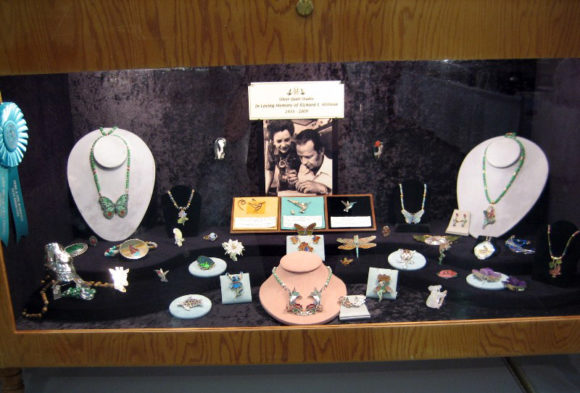
A memorial display is a meaningful way to reintroduce that younger generation of collectors to communities members that have passed away.
A great display may contain elements from multiple categories, but as a personal guide, I like to narrow down my themes. This will not only make it easier for you to decide what specimens to include, but will help the viewer be able to understand and appreciate your case quickly in a noisy/busy gem show environment.
Example: If your case is a display of mixed minerals from your personal collection, maybe choose specimens that are all the same size. Or conversely, if displaying all the same mineral from one location; showcase the different sizes, shapes, and color variations that can be found.
Choosing a theme or purpose for your display case creates a guideline to work within as you gather specimens and other elements. As you assemble your display, choose only items that will help further your purpose and stay within your desired theme.
Step 3. Plan and execute the actual design and presentation of your display case
Use of Size & Balance: A display case is essentially a box that you are filling. The very best, and most visually appealing displays are ones that utilize all 3 dimensions; length, width, and height. In order to take full advantage of the entire volume of a display case; risers, pedestals, and other display accessories are used to not only provide height, but to assist in the viewing of all specimens equally; this is especially necessary if the specimens are small or if there are many of them.
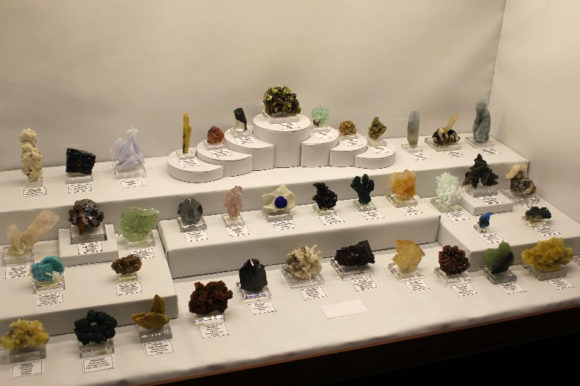
Combinations of risers in various sizes and shapes ensure that all specimens can be viewed equally well.
For mixed size mineral cases, place larger specimens in the back or on the sides of the display and alternate the spacing between rows to ensure optimal viewing of each specimen.
In certain displays signs and photos can be used to add height to an otherwise empty display; either on easels or by attaching them to the back of the case insert.
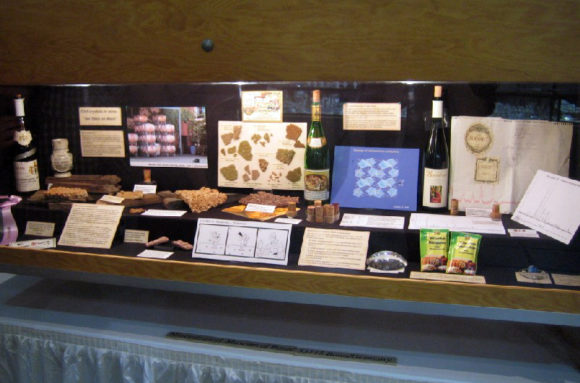
Signage can provide information to the viewer and ad additional height and interest to the overall case design.
Use of Color & Contrast: While many rock shows will provide you with pre-covered fabric liners for the inside of your display case, most people prefer to provide their own. This gives the exhibitor the ability to choose a color that will showcase their rocks or minerals in their very best light. For instance, if you are displaying a case of white or clear specimens you would probably want to choose a dark colored background material, as to provide visual contrast for the viewer. In some cases, you might want to use a monochromatic color scheme, like using a pink background for a case of hot pink rhodochrosite specimens.
When considering color, also remember that risers and stands are made of materials that also have distinct colors. Styrofoam is mostly white, display stands usually are clear or black plastic, and labels and signs are usually predominately white. All these elements will change how your specimens and your overall display is perceived by viewers.
Generally, neutral or natural colors are preferred for backgrounds, stands, and other non-specimen display items. Creative but tasteful use of color can enhance your display in some instances, but remember, “less is more.”
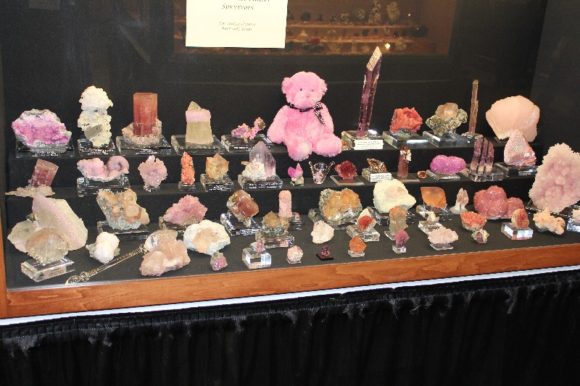
A monochromatic pink color scheme is being used as a means to draw attention to breast cancer awareness. Pairing pink specimens with black risers and clear bases creates a bold contrast that draws the veiwer’s attention.
Use of Tools & Materials: Even though just about anything can be used in the creating of a mineral display case, there are some materials and methods that are tried and true. Back and side case inserts are usually cardboard, foam core, or wood cut to size and covered in fabric that is secured in place by duct or masking tape. The best fabric to use is something not too stretchy or loose knit, and that is forgiving to marks and stains. Cotton, Blends, Suede, Canvas, Muslin, and Flannel are all materials I have seen used successfully. When covering your own case inserts, iron your fabric beforehand to remove creases before securing it to the background board.
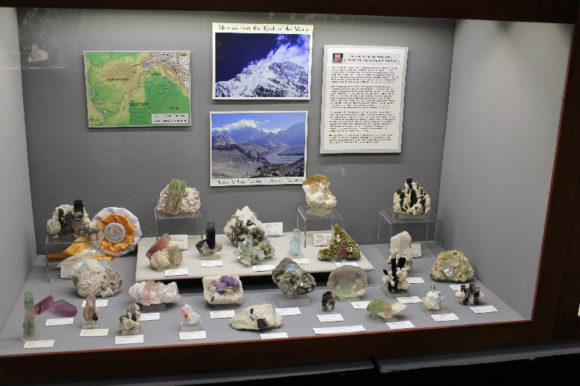 Stands and risers can be purchased pre-fabricated or DIY concepts of your own design. Materials used for risers are wood, plastic, Styrofoam, Foam core, or cardboard. Pre-fabricated risers and pedestals are often clear, white or black, but DIY risers made of foam or wood could be easily painted or covered with fabric to enhance the display or to create a custom effect. Those with special tools, skills, or talents could employ any number plastic, metal, polymer, or 3d printed bases, risers or stands to give their display a unique style or feeling.
Stands and risers can be purchased pre-fabricated or DIY concepts of your own design. Materials used for risers are wood, plastic, Styrofoam, Foam core, or cardboard. Pre-fabricated risers and pedestals are often clear, white or black, but DIY risers made of foam or wood could be easily painted or covered with fabric to enhance the display or to create a custom effect. Those with special tools, skills, or talents could employ any number plastic, metal, polymer, or 3d printed bases, risers or stands to give their display a unique style or feeling.
Small minerals and crystals are mounted on stands. These stands usually are foam or Lucite, with the specimen mounted with mineral tack, white glue, or hot glue. Before displaying, take into consideration what type of lighting will be used in the display case. Many smaller clubs still use hot burning display lights, so a specimen mounted to a stand with mineral tack my fall over under the heat of a display lamp. This is also true for signs and photos attached to backgrounds. For this situation, I would recommend high melting temperature hot glue to mount the specimens and a very sticky tape or possibly tacks for the pictures and signs (depending what the background material is.)
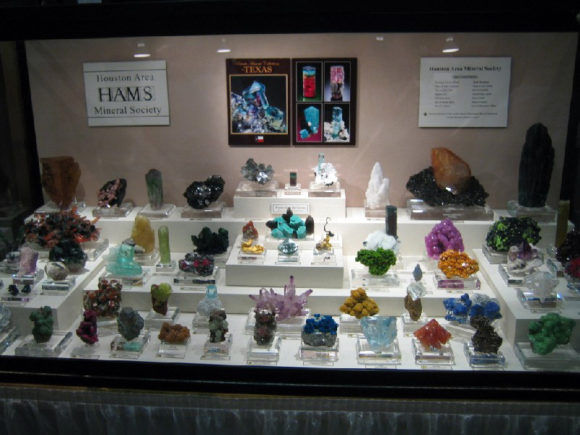
Making sure the viewer can see all specimens equally is especially important when displaying many similar sized specimens within a large display case.
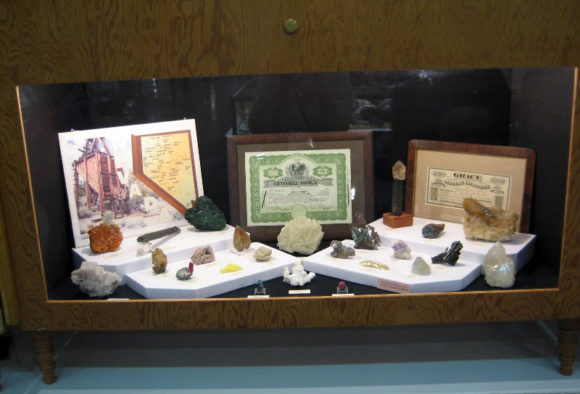
A combination of wide risers and framed documents is used to fill up the entire volume of this display case.
The inclusion of other types of ephemera as an accompaniment to the rocks and minerals is a way to help create interest, add height or to carry a theme. This could be documents, antiques, labels, models, optical equipment, plaques, souvenirs, etc.
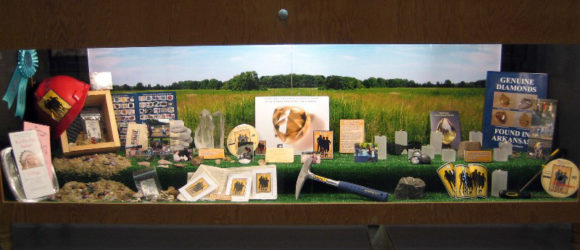
Tasteful and well thought out choice of non-mineral items can be used to reinforce your display theme or idea.
Step 4. Make sure your rocks and minerals are display ready
Orientation, Cleaning, Mounting, and Labeling a mineral or rock effectively can be confusing for many novice exhibitors. The correct way can be largely subjective and often times shape or size can create challenges for even a seasoned collector.
Orientation – Always display full, terminated crystals facing the viewer. Broken crystals should face toward the back or bottom when all possible. If you are unsure what your crystal should look like, look up photos.
Cleaning – Clean any dust or dirt from your minerals and rocks prior to displaying them. Depending on the nature of the dirt/mineral cleaning could be a spray of compressed air, a soft paint brush, soap, and water, or scrub with a toothbrush.
Mounting – Mount small specimens on stands or bases securely using an appropriate adhesive. Test under shaking and heat to ensure effectiveness of the mount.
Labeling – Look up the localities of all minerals online (I recommend Mindat.org) or in reference books to ensure that you have the correct information and spelling. Use a clean, simple, font that is easy to read, and consistent throughout your display. Cut your labels out carefully and neatly with either a paper trimmer or scissors. If colored paper or text is used, make sure that the information is easy to read, that the contrast isn’t too drastic, and that it doesn’t detract from the overall display.
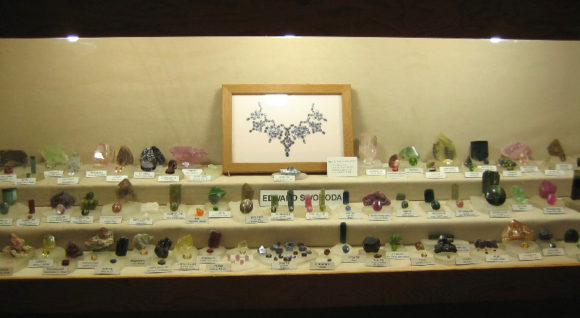
Display of cut and rough stones requires precise placement of the cut gemstones in relation to their corresponding natural crystal counterparts.
Step 5. Practice, Prepare, Pack, Present
Pay attention to the details, this is what will make or break the successful execution of your display.
- Double check the spelling and grammar on all labels and signs.
- Make sure dirt, dust, stains, or hair is removed from all fabric.
- Check all mountings for stability and adhesion.
- Do a practice set-up of your display case and see if all your minerals are clearly visible.
- Once you have decided on a final layout, take a photo of your practice display to use as a reference for real display day.
- Pack everything up backward as to how you will unpack it; pack items in the back row first, ending with the first row last.
Pack your minerals securely for transportation to the show location. Place backing boards, fabric covered inserts, risers, and other items inside bags or boxes to protect them from damage or dirt during transport. Transport signs and labels in a folder or envelope to prevent wrinkling, creasing, or other damage.
Usually display cases are set up the day before a gem show opens. You will be given instructions as to the date, time, and procedure beforehand; save these on your phone or print them out and bring them with you. Be prompt, wear your name tag if asked, follow any parking instructions, and try to finish setting up your display case in a timely fashion.
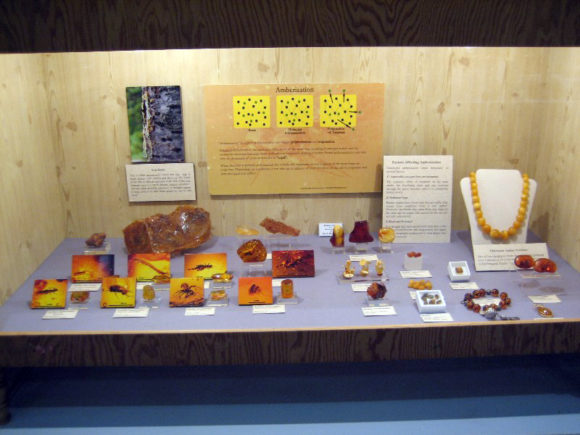
This exhibitor decided to forgo a back insert altogether and attach the signage directly to the wood of the case. Sometimes you are forced to make onsite alterations to your idea, so bring your supplies.
Bring all tools and accessories you may need to set up your display case; you cannot be sure what will be available to you. Here is an example list of items to bring along on set-up day.
- Hot glue and glue gun
- Mineral tack
- Scissors
- Hobby knife
- Masking Tape
- Duct Tape
- Iron
- Lint roller
- Thumbtacks
- Glass Cleaner
- Paper Towels
- Ruler
- Spare Stands and bases
- Tweezers or forceps
- Extension Cord
Most importantly, have fun and create a display that makes you happy. By deciding to participate in the sharing of your rocks and minerals with other members of the rockhound community, you are helping to keep our rock and gem shows interesting and diverse. All the pointers and examples in this guide are presented to help you through the process of creating your own, unique display cases with less trial and error. For more information on display cases, visit your local gem, mineral, rock or lapidary club.
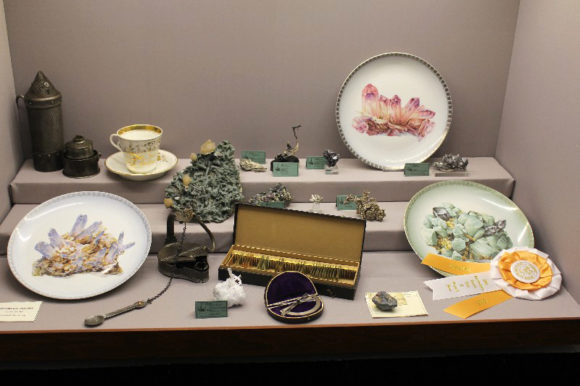
Minerals and collector’s items featuring and related to minerals can be displayed together to create visual interest.
Related posts:
Petrified Wood Near Colorado Springs – Pairing Old Information with New technology!
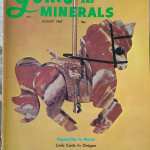
Rockhounding is a hobby that anyone can pick up, with very little in the way of costs besides time and transportation. Colorado is a wonderland of mountains, forests and rocks. Petrified wood is always fun to find and in many places around Colorado, abundant. Let’s show you a fun way to research locations from old data sources.
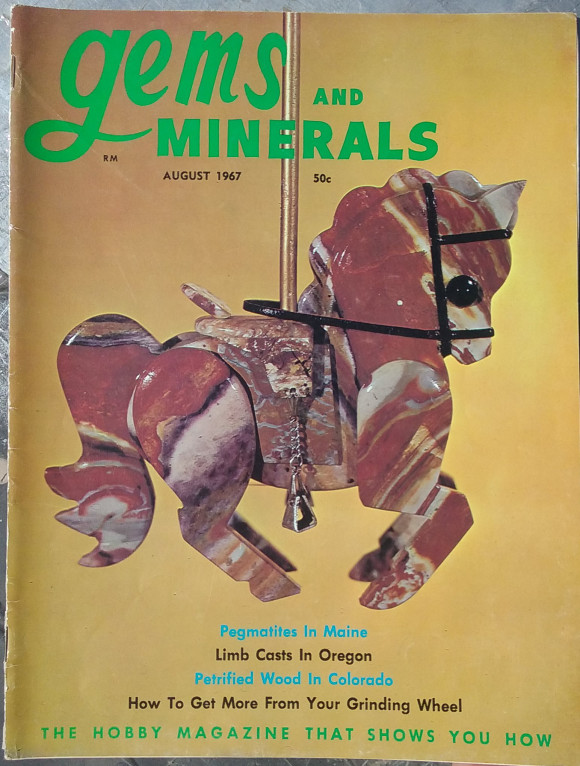
Available on eBay, Amazon, and at mineral shows across the nation, old magazines are full of rockhounding information!
By old data sources, we mean, old magazines, books and pamphlets about collecting minerals. Rockhounding was very popular in the 1950’s, 60’s and 70’s, which lead to the production of all sorts of printed material for rockhounds and lapidary enthusiasts. Today, even if rockhounding was nearly as popular as before, the internet is the land of independent media, yet, the information from those sources is so niche, it takes people specialized in transferring that information over to bring it to light, instead of waiting around for others to research and publish, you can take charge and research many things from your computer, using information from sources like this one, The August 1967 edition of “Gems and Minerals”.
The article, entitled “Petrified Wood in Eastern Colorado” by Eugene M. Beason, describes a large wash where petrified wood is plentiful. Due to the nature of these alluvial rock deposits, every year new material is churned up by erosion by wind and rain, so if there was ample material in 1967, there would be ample material in 2016. Property ownership is always evolving and changing and must be verified by any possible explorer.
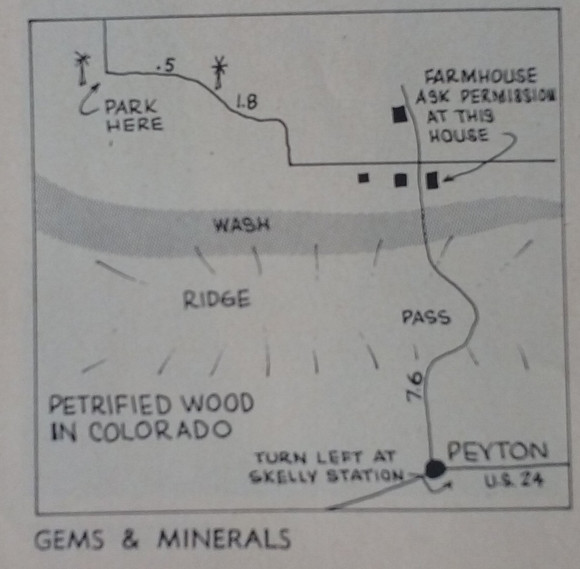
Original Map to the Petrified Wood Collecting area in the 1967 Gems and Minerals article.
Many things have changed since this article was printed, nearly 50 years later. Instead of the turn being the “Skelly Station”, we can see the map is pointing to “Peyton Highway”, which runs north to go over a mountain pass and turns hard left (west) on “County Road 74/82”, which parallels the wash that is talked about in the article. I do not think there is any need to stop at the farmhouse listed in the article to ask for permission, as the ranch land gave way many years ago to the need for housing, as the populations in nearby Denver and Colorado Springs swelled, so did the growth out into the nearby countryside. 50 years ago there were just cows and a couple windmills, now there are hundreds of houses dotting the landscape. The issue is that the property in Colorado has two things going against it – Waterways can be included in property lines and property does not have to be POSTED to give first refusal to entry, as in most states in America.
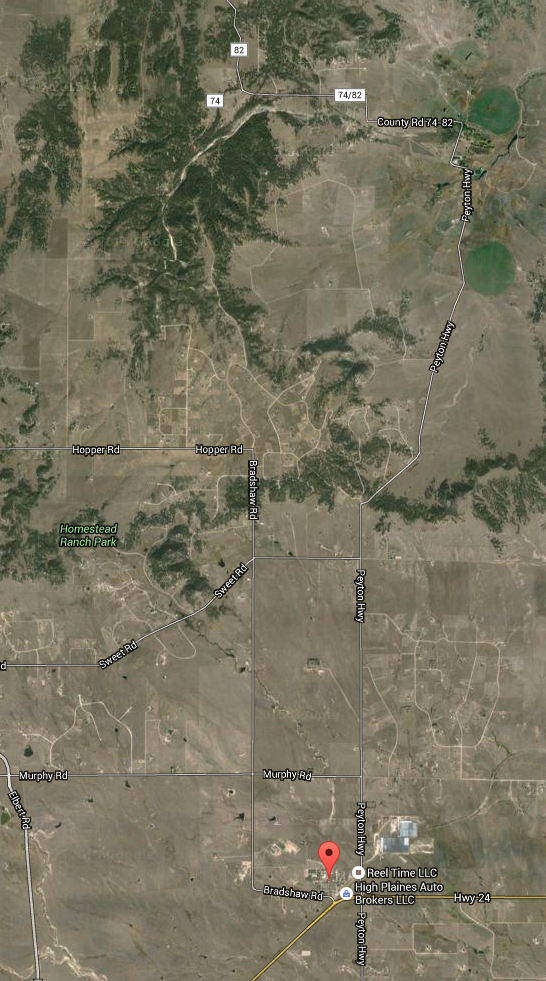
This map shows the area as shown in the illustrated map above.
As we searched google for information on this location, the terms “Peyton Petrified Wood” were coming up nearly blank. We did find an entry for it on Mindat.org, but it did not show anything directly from this location. Additionally, PeaktoPeak, a well known website for Colorado collecting, has a bit about petrified wood from that general area. Digging through field guides to Colorado, we could not find this location listed, could it have been one of the locations that simply slipped through an information hole, getting a two page article and then just…relegated to maybe popping up in a mention in a local club newsletter. It IS possible to contact the property owner, Tim Richardson, at timothy.k.richardson@gmail.com for guided tours of the petrified wood deposits.
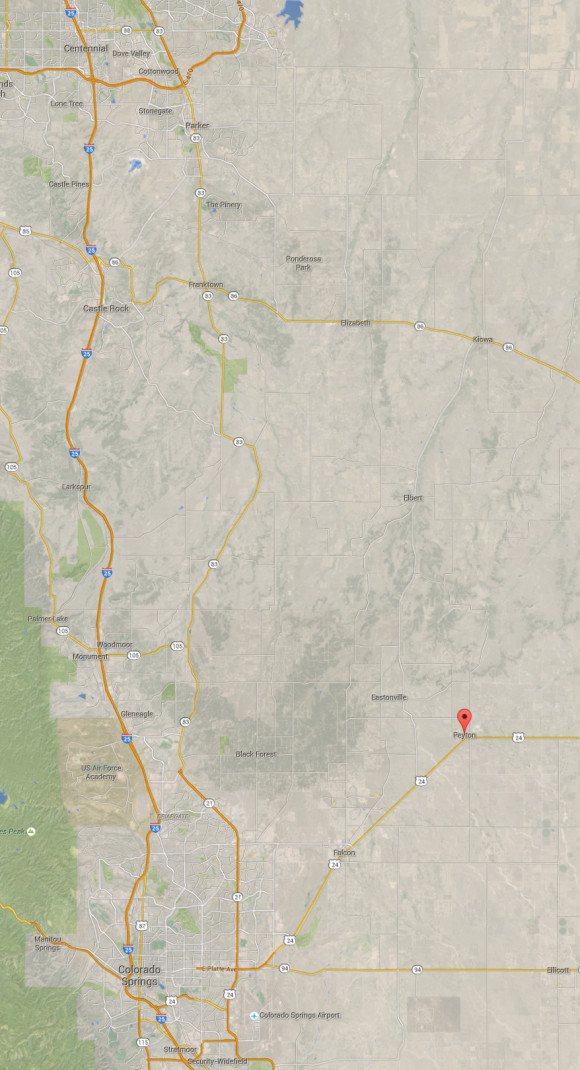
as you can see, Peyton is not a far drive from Denver or Colorado Springs
Researching where rocks are found is necessary and interesting – don’t neglect to inspect old magazines and field guides from 40, 50, 60 years ago. You never know when a good location has simply fallen through the cracks and is waiting for you to find it and come explore! You’ll find that property ownership has changed over the years, however, don’t neglect to contact current property owners about that old information – many people are excited to find colorful rocks and minerals and are surprised they are underfoot.
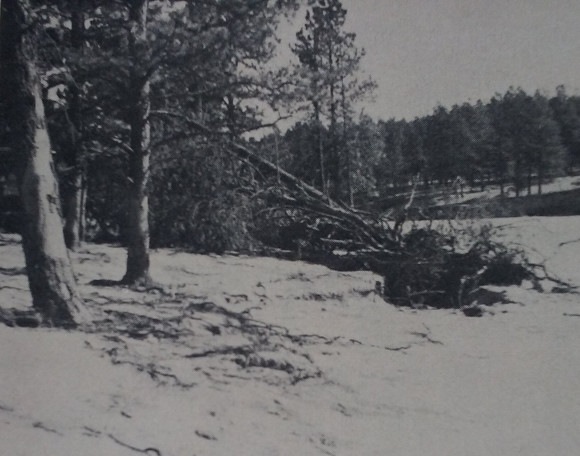
“Looking down the wash where the good petrified wood is found. Floowaters that uprooted the tree in the foreground also uncovered new gem material.” – Photo by Eugene M. Beason.
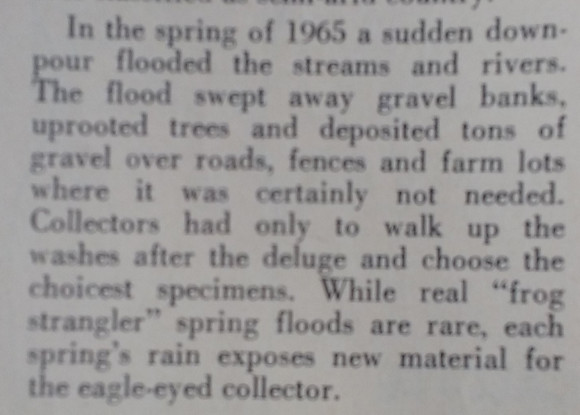
So, when ever the rain is hard in colorado, new material is unearthed!
Related posts:
The Top Ten Mineral Localities on Earth (or, so we feel)
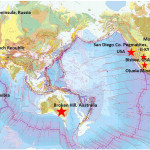
Philip M. Persson
3139 Larimer St., Denver, CO, 80205
perssonrareminerals.com
Graduate Student, Dept. of Geology & Geological Engineering
Colorado School of Mines
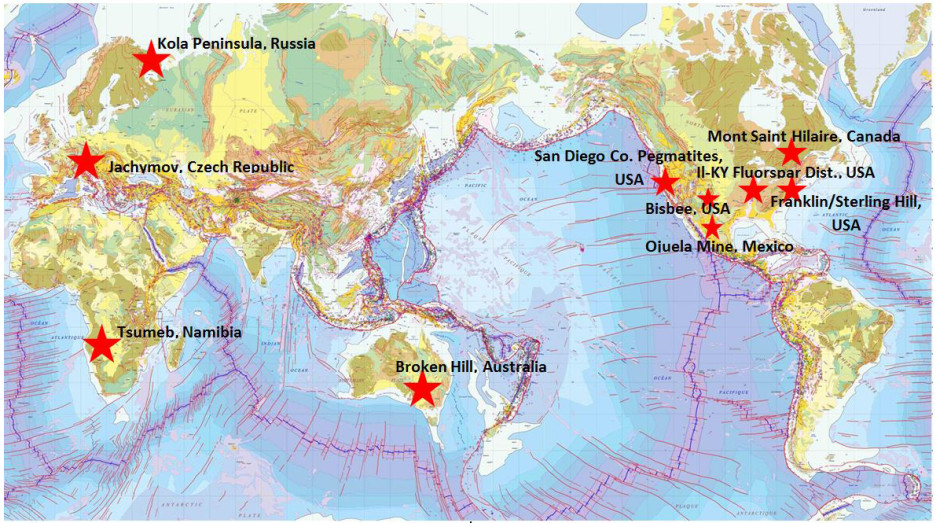
I have often had collectors ask me what localities I consider to be ‘important’ or ‘world-class’ as far as diversity, quality and quantity of minerals, and I’ve also spent much time pondering this question myself. In the end, the answer is highly subjective, depending on the person’s interests and experience in mineralogy and what drives them as collectors. There are ‘mineralogical rainforests’ such as Mont Saint Hilaire, Canada or Russia’s Kola Peninsula which, while not well-known for large aesthetic crystallized specimens, host an incredible diversity of mineral species- a seemingly infinite combination of a finite set of elements which attests to the unique geologic conditions under which they form. Then there are locales that have produced iconic and beautiful examples of one or perhaps a few minerals, but are otherwise fairly ‘simple.’ Colorado’s Sweet Home Mine or the Elmwood Mine in Tennessee likely fall into this category. In my opinion, the best localities are those that successfully bridge the gap between these extremes; those that have produced beautiful, highly collectible crystals but also have a deep appeal to the academic mineralogist or serious systematic collector. The following is a brief, somewhat arbitrary list of what I consider to be 10 of the top such locales, and I hope you enjoy my musings on each mineralogical treasure chest. –Phil Persson, Denver, Colorado December 2015
1.) Franklin & Sterling Hill, Sussex County, New Jersey, USA
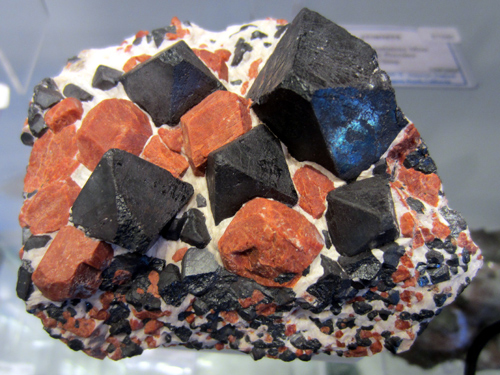
Willemite & Franklinite crystals, Franklin Mine, 15 cm across (photo © kristalle.com, Tucson Show 2008)
Franklin. The name instantly kindles an affectionate smile or nod from seasoned rare species or fluorescent mineral collectors, and perhaps a begrudging acknowledgment from collectors of aesthetic minerals like gem crystals. No matter your interests, however, the unique appeal of Franklin (and it’s slightly smaller sister deposit, Sterling Hill) cannot be denied. These two mines, both now closed, are situated in the rather bucolic Northwest corner of the much-maligned state of New Jersey, approximately 45 airline miles from New York City. The unique and varied mineralogy of Franklin & Sterling Hill (over 350 mineral species now known, a number exceeded only by Mont Saint Hilaire and a German mine whose mineral endowment can be equally attributed to the forces of nature and the persistence of German micromounters) can be attributed to the unusual forces that led to their creation.
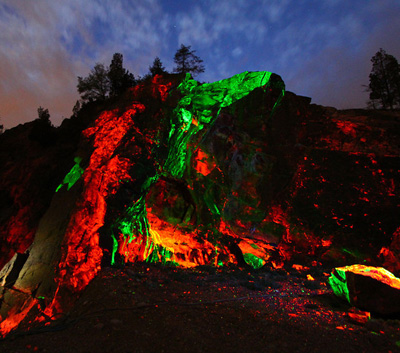
Passaic Open Pit with Sterling Hill Orebody under shortwave UV light at night (photo © Sterling Hill Mining Museum)
Originally thought to be seafloor volcanogenic massive sulfide deposits (previously termed ‘exhalites’), which formed near ‘black smoker’ type hydrothermal vents in a rifting environment in the late Proterozoic period, the Franklin & Sterling Hill orebodies were later subjected to fairly high-grade regional metamorphism (upper amphibolite facies) which turned the surrounding carbonate rocks into crystalline marbles, and transformed the fairly benign sulfide mineralogy of the proto-deposits into the exotic mixture it is today; defined principally by the Zn-Fe-Mn oxide Franklinite, the Zn-silicate Willemite, and the Zn-oxide Zincite. None of these minerals can be considered ‘common’ on a global scale, and two are essentially unknown outside the district. Metamorphism also introduced a suite of igneous intrusives of varying composition, from basaltic ‘camptonite’ dikes to felsic pegmatites with their own metasomatic reactions and accompanying fluids, which altered and further complicated the already diverse mineral assemblages present.
I will not delve too deeply into the history of the Franklin-Sterling Hill District, which could (and does) occupy an extensive treatise unto itself- suffice it to say that the orebodies, which originally outcropped in a fairly spectacular fashion, have been known since at least the late 17th century and probably earlier, but metallurgical issues arising from the complexity of the ores as well as disorganization of various mining entities prevented large-scale mining until the later part of the 19th century. From ~1880 to WWII was the ‘heyday’ of Franklin & Sterling Hill, with extensive scientific investigation of both deposits by many of the leading mineralogists of the day, such as Charles Palache & Clifford Frondel. Numerous new minerals to science were described, and the genesis of the deposits was fiercely debated. The combined output of the two mines, in total some ~40,000,000 tons of ore averaging >20% Zn (grades generally unheard of today) and substantial Fe & Mn propelled the owner, the New Jersey Zinc Company, into the upper leagues of the mining industry and allowed them to expand all over the U.S and the world (Dunn 1995). When the Sterling Mine finally brought its last ore bucket to the surface in early 1986, the district had a several hundred year history of mineral collecting and mineralogical science, as well as a robust ‘local scene’ with fierce competition for choice specimens and a club which fostered the community through mineral shows and other events.
It would take another monograph (this exists as well, authored by former-Smithsonian mineral guru Dr. Pete Dunn, and is a must-have for the serious Franklinophile) to describe the minerals of Franklin & Sterling Hill in detail, so I will just say a few words about some of the more notable species. At the top of the list of course are the ore minerals: franklinite, willemite, and zincite. With the exception of willemite (and this is debated amongst some), Franklin & Sterling Hill have produced by far the world’s premier crystallized examples of these species; in atypically-attractive euhedral crystals, up to 20 cm. on edge for Franklinite, and similarly large (or larger) for willemite. Willemite is a ‘chameleon’ at Franklin-Sterling Hill and occurs in nearly all imaginable colors and textures. Early 20th-century New Jersey Zinc Company chemist Lawson Bauer had a box of over 50 specimens (now in Harvard University’s collection) he would often have visitors try and identify. The trick is they were all willemite! Willemite even occurs rarely as flawless, gemmy prisms in attractive shades of green and yellow to blue to 4 or 5 cm. in size, which any real Franklin collector would murder their grandmother for. Zincite also occurs as sharp blood-red pyramids up to 5 cm, though 99% of it is massive.
Next in importance and distribution in collections are probably the Mn-bearing and so-called ‘skarn minerals’, Rhodonite being the most important. Broken Hill, Australia or Brazil have perhaps produced gemmier and more lustrous Rhodonites, but as far as sheer abundance, diversity and mineral associations, nowhere can beat Franklin. Attractive pink to red rectangular prisms to 20+ cm. embedded in white calcite matrix associated with willemite and franklinite crystals comprise the Franklin ‘uber-classic.’ The best ones have been painstakingly excavated from their enclosing calcite using small dental picks and hammers. Bustamite also occurs in excellent crystallized examples, as well as a host of much rarer Mn-bearing species such as Johannsenite, Hodgkinsonite, and Leucophoenicite (all having their type-locale at the Franklin mine). Species such as these illustrate that truly ‘world class’ localities exhibit the geochemical attribute of having a mineral representing essentially every thermodynamically-stable combination of a ‘signature’ set of elements. In the case of Franklin & Sterling Hill, these elements include Zn, Mn, Fe, Si, As, O, Ca, B, Pb, Ba, and a handful of others. None of these is particularly rare in the earth’s crust, but when combined in enough ways, new minerals to science which are globally-scarce are bound to result.
No discussion of Franklin would be complete without mentioning the fluorescent minerals. Mineral fluorescence, a spectacular property some minerals exhibit when certain outer shell (or ‘valence’) electrons are energized and emit vibrantly-colored visible light colors when excited by ultraviolet light sources, perhaps reaches its global zenith at Franklin. Over 80 minerals found at Franklin & Sterling Hill fluoresce under UV light, and many in bright and attractive combinations of color known the mineral world over. The cause for such a diversity of fluorescent minerals has been much debated, but probably involves the metamorphic and geochemically-complex nature of the deposits, as well as the abundance of certain elements such as Mn & Pb thought to act especially well as ‘activators’, or elements receptive to U.V light-induced excitation of key electrons. One of the major ore minerals at Franklin & Sterling Hill, willemite, fluoresces bright green under shortwave U.V light, and the major gangue mineral for both deposits, calcite, fluoresces bright red due to trace manganese, and together these minerals form a vivid fluorescent combination known locally as ‘red and green.’ This material has made its way into mineral collections around the globe, as have examples of minerals like hardystonite, esperite, margarosanite, clinohedrite, hydrozincite, sphalerite, roeblingite, and more. Some of these minerals, like roeblingite, margarosanite, and manganaxinite, are rare and restricted in their occurrence even at Franklin, and are highly-coveted by collectors even in modest examples. Others such as willemite, calcite and hydrozincite can still be easily collected today and are sure to delight any first-time visitor to the area.
Finally, the huge diversity of ‘rare’ species must be acknowledged. I put rare in quotation marks because it is a relative term at these enigmatic deposits, but some minerals are ‘truly rare’ and are unknown outside Franklin/Sterling Hill, or have global amounts totally a few grams of micro-crystals. It would be futile to describe these in detail here, but suffice it to say that they have names like Gerstmannite, Walkilldellite, Hauckite, Ogdensburgite, Kraisslite, Cahnite, Charlesite, and Samfowlerite which pay homage to their shared type locality and the scientists and collectors whose passion for the district led to their discovery. While the mines of Sterling Hill & Franklin have been closed since 1986 and 1954 respectively, their legacy is proudly carried on by two superb museums and a small army of local collectors and aficionados who almost without thinking refer to all rocks not from the area as ‘foreign.’
2.) Mont Saint Hilaire, Quebec, Canada
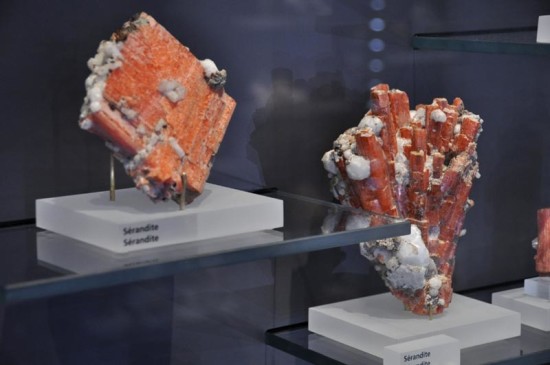
Serandites to 15 cm in the Royal Ontario Museum (photo © Dave K. Joyce)
First Franklin, now Mont Saint Hilaire!? Surely, the collectors of aesthetic and dare I say, “normal” minerals are now really rolling their eyes and assuming I must have some hidden ugly mineral agenda. But wait! Have you not seen the lustrous, bright orange 20 cm. Serandite crystals studded with lustrous white analcime golf balls? Or the lemon-yellow tablets of bright Catapleiite with swords of lustrous red maganeptunite shooting out of them? Or the brilliant-blue cubes of carletonite? Or perhaps the gemmy red crystals of Rhodochrosite on a bed of shiny natrolite prisms? Not everything at the ‘super classic’ pair of quarries nestled in an enigmatic hillside in the Quebec countryside requires a microscope to see. But, for those with an eye for the rare and unusual, Mont Saint Hilaire truly opens up another universe, with 400+ known mineral species and more awaiting proper documentation.
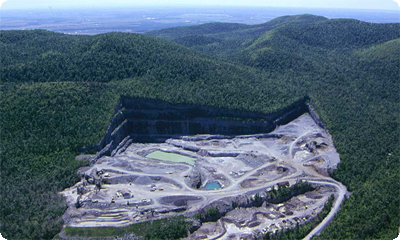
aerial photo of Poudrette Quarry ( photo © McGill University)
Mont Saint Hilaire (MSH) is a globally-significant example of a multi-phase alkalic intrusion, an unusual type of igneous rock typically associated with either extensional tectonism (rifting) or hot spot activity, both of which have the capability to bring deep-seated, ‘primitive’ mantle magmas enriched in rare elements to the surface. In the case of Mont Saint Hilaire, the unusual alkali intrusive complex formed approximately 120 years ago when the New England hot spot, a relatively fixed, long lived mantle-plume like conduit for deep magmas ascending to the surface, erupted a series of intrusive and extrusive igneous rocks as the North American plate slid westward over it (Currie et al. 1986). In the vicinity of Mont Saint Hilaire, these complexes are known as the Monteregian Hills, and include other famous mineral localities such as the Francon Quarry on Montreal Island and the Oka Carbonatite complex just to the north. At Mont Saint Hilaire, the igneous intrusion consisted of a highly diverse suite of rocks ranging from gabbro at the mafic end to nepheline syenite at the felsic, critically silica-undersaturated end. The surrounding ‘country rocks’, mainly Paleozoic carbonate rocks, were also thermally ‘cooked’ by the intruding magma, and produced a contact-metamorphic rock type known as hornfels (Currie et al. 1986). The most interesting rock type produced during this intrusion are the pegmatites, which are often highly alkaline (e.g; enriched in elements such as Na & K) and contain a huge diversity of minerals (one pegmatite contained over 100 minerals!) due to the ability of such late-stage melts and associated hydrothermal fluids to transport large amounts of typically incompatible elements, such as Ti, Zr, Nb, & REE.
The history of Mont Saint Hilaire as a mineral locality is relatively recent and started in earnest after WWII. The mountain, which is quite prominent and sticks up ~400 meters above the surrounding flat, agricultural countryside, was long before noted for its unusual igneous rocks, but generally poor exposure precluded any notice of its unusual mineralogy. Industrial-scale quarrying for road metal for the nearby city of Montreal changed this situation dramatically, when a large body of layered and zoned nepheline syenite and associated agpaitic rocks loaded with rare minerals were exposed in the 1950’s and 60’s. Quarrying, as well as scientific study of the mineralogy and geology of the mountain intensified in the 1970’s, and probably reached its zenith in the early 1980’s, at least as far as recovery of fine specimens went. Blasting and rock moving happened at large scales on a daily basis, and the owners of the main quarry, the Poudrette family, was accommodating to collectors as well as scientists. Stories of ‘walk in’ (or crawl-in) pockets abounded, and one pocket filled with amazing crystals of serandite, luecophanite, neptunite, analcime and more was said to be almost 10 meters deep and 2 meters wide, easily swallowing several collectors at a time! Collecting during these times was easy and fantastic; all one needed to do was scoop crystals into a waiting flat or bucket out of recently blasted pockets or pegmatites, and sort through it later for rare (and sometimes new!) species. One friend of mine recounted a story once of how after collecting a huge pocket filled with world-class Serandite crystals in the 1980’s, the Royal Canadian Mounted Police later paid him a home visit at his residence south of the border to inform him that his find constituted national Canadian heritage and was to be returned at least in part to Canada!
Sadly, all good things must come to an end, and in the case of Mont Saint Hilaire it had less to do with geology and mineralogy and more with the whims of quarry management and demand for aggregate rock. The quarry slowly moved away from the more productive, pegmatite-rich zones of the intrusive complex and into the hornfels, and finally into the ‘barren’ Paleozoic sedimentary rocks of the St. Lawrence lowlands. This move, coupled with restrictions on collector access leading to long periods of essentially no access to newly-quarried exposures, meant that many wrote off MSH as being a ‘dead’ locality. The mountain is far from exhausted however as far as its mineralogical treasures are concerned, and perhaps a new, more scientifically-receptive ownership or a change in demand for road material will awaken a new era for this truly world-class mineral locality.
Mineralogically it is impossible, as with Franklin, to briefly summarize the abundance and diversity of minerals. Suffice it to say that as with other ‘hyper-alkaline’ igneous complexes like the Lovozero Massif in Russia and Dara-I-Pioz in Tajikistan, the ‘characteristic’ elements associated with the intrusions, such as Na, Zr, Ti, Fe, F, REE, Nb, & Y occur in seemingly endless combination, leading to a huge number of different elements essentially assembled from a restricted set of elements under restricted by sufficiently diverse geologic conditions. Many of these occur of course as micro-crystals whose best euhedral development does not exceed a few millimeters, and often much less. But, equally impressive are number of minerals which occur as colorful, euhedral crystals AND are extremely rare or sometimes even unknown outside MSH.
The ‘poster child’ (and indeed, it has been on many posters) is Serandite, the Mn-rich cousin of pectolite, which was first discovered on the isle of Rouma in Equatorial Guinea, itself an alkalic intrusion, but reaches its peak at MSH, where it forms lustrous, sometimes even gemmy salmon-pink to vibrant orange crystals to 20+ cm. Often associated with these are crystals of analcime, itself not a rare mineral but especially well-crystallized at MSH, where lustrous, sharp baseball-sized crystals are not unusual. Catapleiite, another unusual mineral (and part of the well-represented zirconosilicate family of minerals from MSH), forms superb, sometimes gemmy crystals to 10 cm, sometimes associated with other rare species. Carletonite, first discovered at MSH, occurs as beautiful, sky-blue crystals to several cm., often in attractive groups. Aegirine, Natrolite, Manganeptunite, Leucophane, Siderite, Rhodochrosite, Genthelvite, Donnayite-(Y), and Eudialyte are all notable species for the locality, some reaching their best here. While access at the moment is restricted to Mont Saint Hilaire, the large pegmatite-rich zone of the intrusion is far from exhausted, and new quarrying to supply the growing city of Montreal will surely expose new world-class minerals.
3.) Broken Hill, New South Wales, Australia
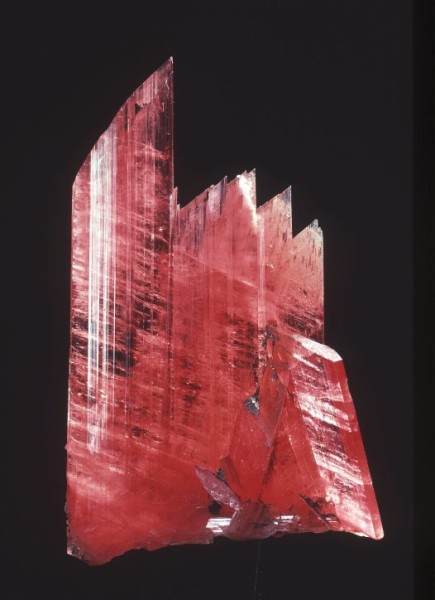
Rhodonite: 17 Level, Zinc Corporation Mine, Broken Hill- 4.7 cm. high, (photo by Carl Bento, © Australian National Museum)
Broken Hill is a world-class deposit in every sense of the word. Economically, it is one of the largest single mineral deposits on earth and helped start a company that it now Australia’s largest (BHP Resources). Scientifically, it is a global enigma which has puzzled economic geologists and mineralogists for generations. Culturally, it paved the way for the success of ‘frontier mining towns’ of the Australian interior which became essential to creating what is now a nation with one of the highest standards of living in the world. While not nearly operating at its former pace, the district is still the site of active mining for lead, zinc, copper, silver and gold under mid-sized mining company Perilya Resources, and exploration for new major deposits in the area is still actively underway.
Geologically, Broken Hill is classed as a metamorphosed volcanogenic massive sulfide (VMS) type deposit. It began as a large, essentially flat-lying body of Zn, Pb, Cu, & Ag sulfides with other metal enrichment on the seafloor at the site of extensive and long-lived hydrothermal venting during rifting on the ocean floor in the Paleoproterzoic period, almost 2 billion years ago. Like much of Australian, the larger geologic history of the region dates far back into Archean time 2+ billion years ago, and is one reason the continent is so incredibly mineral-endowed. After ‘primary’ sulfides were deposited as a combination of ‘exhalite’ seafloor venting and settling of metalliforous hydrothermal fluids and sub-seafloor replacement of receptive host rocks, an additional thick sequence of interbedded volcanic, clastic, and sedimentary rocks were deposited, which eventually became known as the Willyama Supergroup, and important formation in the western part of New South Wales and northern Victoria (Marjoribanks et al. 1980). Around 1.6 billion years ago, the entire rock package was subjected to regional high-grade metamorphism at up to granulite facies, at 750-800 degrees C and 5-6 kilobars pressure Victoria (Marjoribanks et al. 1980). The relatively simple sulfide orebodies as well as their host rock were ‘cooked’ and recrystallized into the diverse mineralogy seen today, and perhaps more importantly, as the metamorphic process waxed and waned and new hydrothermal and magmatic fluids were introduced, the whole system was able to ‘stew in its own juices’ (to quote Brian England) and develop an even more unusual geochemistry. The resulting deposit, once a flat-lying layer on the seafloor, was then folded and refolded into the complex geometry seen today, with the result being a series of stretched, steeply-dipping ‘lenses’ which culminated in a large surface outcrop of leached and altered ore, the original ‘Broken Hill.’
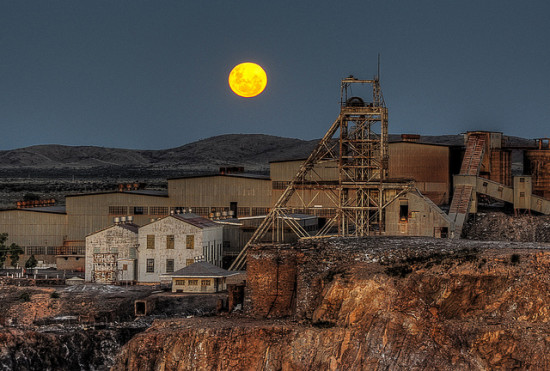
#2 Shaft, North Mine, Broken Hill (photo © Rod Wilkinson/flickr.com)
The human history of Broken Hill is likewise fascinating. While sporadically settled and travelled through by aboriginal peoples for thousands of years, Anglo settlers first visited the area in the 1840-50’s, though the outcrops of leached ore hinting at the bonanza hidden below did little to inspire early pioneers and prospectors. Finally, in 1883, itinerant prospector Charles Rasp staked several claims on the outcrops known as the ‘Broken Hill’ and later with his ‘syndicate of seven’ other prospectors, founded the Broken Hill Proprietary Company, or BHP (Worner 1982). By 1885, mining along the ‘line of lode’, or the main structural trend connecting mineralized lenses was well underway, and Rasp and his partners had realized a many, many fold profit on their investment (Worner 1982). Soon, Broken Hill grew to a respectable city of over 25,000, with all the accouterments associated with more genteel cities of the coast like Melbourne and Sidney. Mining probably peaked around WWII and has been in slow decline since as the main orebodies, mined in places to almost 3500 meters depth, are slowly exhausted. New exploration, however, could be promising since structural complexities and post-ore faulting mean that a large portion of the original sulfide seafloor VMS deposit could have been later isolated from the main ‘line of load’ and lie undetected at depth. Deposits such as Broken Hill often display fabulous ore grades, with 30+ % combined Pb and Zn not unusual, and significant Cu, Ag, and Au adding value as well. So, while Broken Hill has evolved into a quasi-tourist destination and a modern small outback city, it may once again boom day and night with the turning of sheave wheels and lifting of ore buckets to the surface.
Mineralogically, there are over 300 minerals known from Broken Hill, with over 20 of these having first been described there. To collectors, perhaps the best-known are the ruby-red Rhodonite and Spessartine garnet crystals, often embedded in massive galena, which were found at one time in great abundance from the North and South underground mines and other operations. In addition to being beautiful and aesthetic, they speak of the unusual genesis of Broken Hill, in which the original fine-grained banded Pb, Zn, & Mn sulfides were recrystallized under high-grade metamorphic conditions into coarse-grained Mn-silicates and blocky galena. Classic Broken Hill minerals like bannisterite, johansennite, and bustamite formed in a similar manner, reflecting the manganese-rich nature of the original seafloor sediments. Cerussite is another Broken Hill specialty, occurring in superb, large twinned ‘snowflake’ group of reticulated crystals perhaps only exceeded in quality by those from Tsumeb, Namibia. The Sidney museum has numerous cerussite groups to 40+ cm on display, which look almost like miniature cities or MC Escher abstractions, with hundreds of beautiful interconnected crystals at set angles. Anglesite, another secondary lead mineral, also occurs as excellent crystals to over 10 cm, sometimes replacing cerussite.
Excellent examples of malachite and azurite, amongst Australia’s finest, reflect the copper-rich nature of some of the Broken Hill ores, and were found in quantity in the early days when the supergene-enriched near surface ores were mined. Likewise, pyromorphite also forms in the supergene or oxide ores, and occurs as beautiful, sometimes large groups of intergrown prismatic crystals to several cm. in shades of green and brown. Chlorargyrite, an important secondary silver mineral found in the supergene zones, is enriched in the element bromine at Broken Hill, leading to the term ’embolite’ for this chemically-unusual secondary silver mineral. Smithsonite, the zinc carbonate mineral, occurs in a plethora of colors and varieties, as does calcite, which is often colored pink by manganese. On the rarer end of the spectrum, Raspite, Marshite and Miersite were all first discovered at Broken Hill, and all tell of the unusual conditions of secondary ore enrichment at the deposit, containing elements such as iodine, chlorine and tungsten which are somewhat unusual in ore minerals. Hedenburgite, the usually-ugly rock-forming mineral, occurs in wonderful green, lustrous crystals, as does gahnite, the unusual Zn-rich spinel. Orthoclase, colored blue by traces of lead (‘amazonite’) is another speciality, and apophyllite & inesite sometimes occur in beautiful combinations as well. Stolzite, related closely to Raspite, is another classic, occurring as attractive wulfenite-like crystals on black psilomane matrix.
Many more species occur as micro-crystals, and new minerals to the deposit (and science) continue to be discovered to this day. The Kintore open cut, a relatively small open pit operation on one of the few remaining blocks of oxide ore in the 1970’s & 80’s, was the source of many rare species, thanks to systematic efforts of both collectors and company geologists (Worner 1982). Nowadays, good Broken Hill mineral specimens are hard to acquire, both in Australian and abroad. While many if not most miners collected ‘rocks’, many have long-since sold or given away their minerals, and while mining continues, the supply of good minerals appears to be sporadic. With some luck and persistence, good examples of the ‘classic’ minerals like rhodonite and spessartine are still available, but truly top-notch examples will drain your bank account, and examples such as the nearly 6 cm. group of gemmy parallel-growth rhodonites in the Albert Chapman collection, which most collectors would murder their grandmother for, will probably never be found again. But, the sun has not set on Broken Hill yet, and this classic and unique locality may have a new lease on life in the coming years.
4.) Tsumeb Mine, Otjikoto Region, Namibia
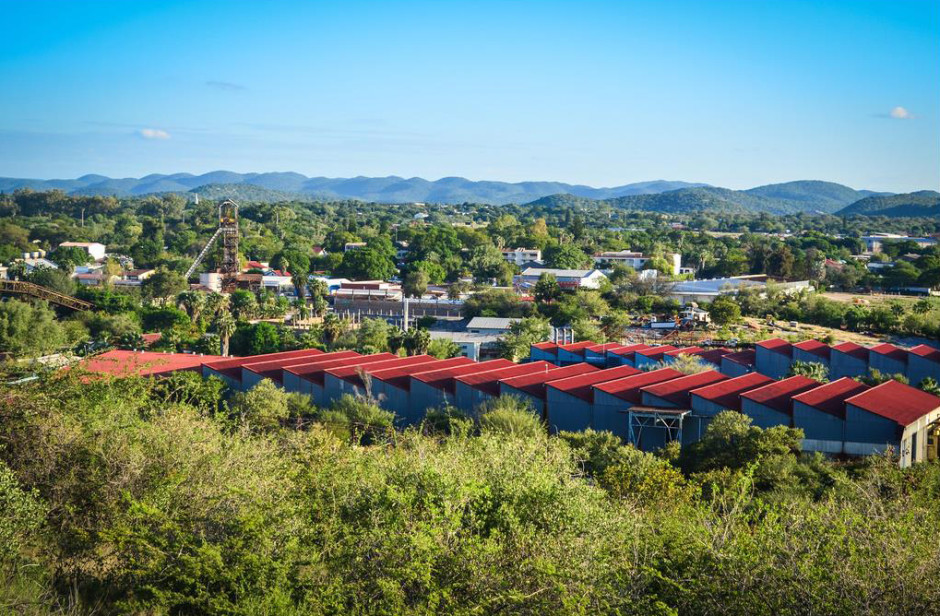
Overview of Tsumeb area with famous De Wet Shaft in middle left, May 2014 (Photo © Jean Baptiste, freewheely.com)
The Tsumeb Mine is one of, if not the world’s premier mineral locality. Though its 285+ mineral species already put it in the same league as Mont Saint Hilaire or Franklin in terms of mineralogical diversity, Tsumeb’s true accomplishment is that is has produced thousands of aesthetic, well-crystallized mineral specimens, including arguably the world’s best examples of many perennial collector favorites such as azurite, dioptase, mimetite, cerussite, and smithsonite. This unique juxtaposition of rare species known nowhere else in the world (Tsumeb is the type locality for 71 species) and large, euhedral, colorful crystals is not a coincidence- it is due to an unusual combination of complex geochemistry and development of a massive oxidation zone where supergene enrichment created a paradise for collectors and mineralogists.
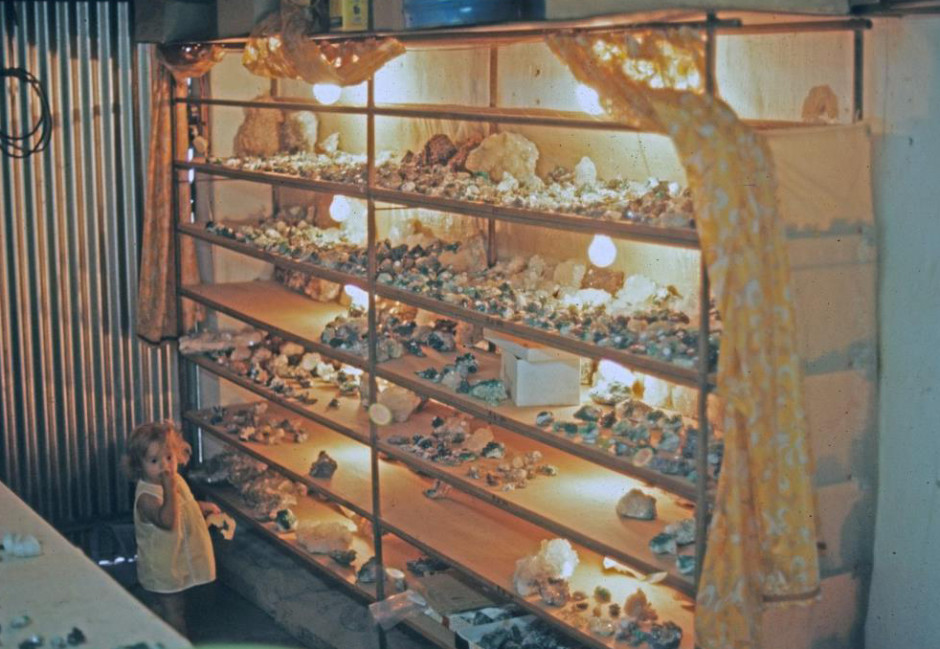
Display of minerals (including many fine dioptase specimens) for sale in Tsumeb miner’s Robbie Groebler’s home in 1974, most of which could be had for under $10 (photo © Rock Currier/Mindat.org)
The history of the Tsumeb Mine and surrounding area could be the subject of a full-length treatise on its own, so just a brief contextual sketch will be provided here. Tsumeb is located in the Otjikoto region of northern Namibia, a semi-arid, hilly to mountainous region which is fairly sparsely populated, but rich in mineral deposits and mining districts. The orebody at Tsumeb outcropped spectacularly (the so-called ‘green hill’) above the largely flat, scrubby semi-desert landscape around it, and was known amongst the local Herero tribes for thousands of years. Small quantities of secondary copper ore, chiefly malachite, were removed by the native tribes and traded to other parts of Namibia, where they were smelted by simple means into metallic copper. The first recorded mention of the deposit by Europeans was in 1857 when missionaries traveling into ‘bushman territory’ of what was then South-West Africa (SWA) from South Africa wrote back to Johannesburg to report the ‘most incredible exposure of colored copper ores (sic) they had ever seen.’
Small-scale mining continued until 1900, when larger industrial development of the deposit began thanks to a new railroad connecting then quite remote Tsumeb to the coast from which ore could be transported to distant refineries. Initial production had to be hauled over 500 km. to Swakopmund, making it economically unfavorable. After SWA became a German colony, a corporation called the Otavi Minen-Und-Eisenbahngesellschaft, or OMEG was formed, which quickly removed the remains of the famous ‘green hill’, expanded it into a modest open-pit mine, and soon went underground, chasing higher and higher grades as the pipe-like orebody continued vertically down. After Namibian independence from Germany, OMEG merged into the Tsumeb Corporation, controlled at various times by Newmont Mining and other large global mining consortiums. The deposit, while not especially large on a global scale, had a unique set of mining challenges including its steeply-dipping pipe-like form and the constant danger of flooding, due to extensive paleo-karst systems housing a large aquifer. High grades (averaging 10% Pb, 4.3% Cu, 3.5% Zn, 100 ppm Ag, 50 ppm Ge), made the tremendous expenditure associated with both dewatering the mine and treating the metallurgically-complex ores profitable (Lombaard et al, 1986). When the great Tsumeb mine closed in 1996 and was allowed to flood, over $5 billion in copper, lead, zinc, silver, germanium, and gold had been produced. An effort by a consortium of mineral collectors and dealers led by Ian Bruce was made in the late 1990’s to re-open part of the Tsumeb mine for mineral specimen mining, but unfortunately this was found to be uneconomic.
Geologically, Tsumeb is part of a small group of high-grade polymetallic, carbonate-hosted ‘ore pipe’ deposits. Mineralization is confined to dolomitic carbonate rocks of the upper Otavi formation, which is part of large supracrustal sequence overlying Precambrian gneiss and granite in northern Namibia (Guilbert & Park 2007). Mineralization occurs in a pipe-like, steeply dipping cylindrical body bounded by ‘psuedoaplite’ dikes, which are probably clastic dikes related to complex salt tectonics and salt diapirism which has been observed elsewhere in this sequence in Namibia and neighboring countries. Karst-dissolution, breccias, collapse structures, and faulting are common, indicating mineralizing fluids were probably fairly robust over an extended period. Ore grades are highly variable, but along intersections between favorable lithology and structure, massive sulfide lenses containing up to 60%(!) combined Cu, Pb, Zn, Ag & Ge were commonly found (Guilbert & Park 2007). The great wealth of collectible minerals at Tsumeb is mainly due to the great depths of oxidation and supergene enrichment of primary sulfide ores, with supergene mineralization predominating above 400 meters depth, and considerable secondary mineralization persisting to depths of 800 meters! This great oxidation depth is probably related to the permeability of the dolomitic carbonate rocks, as well as the unique influence of salt tectonics on mineralization. The unusually chemically-diverse hydrothermal fluids associated with mineralization also introduced many unusual metals such as Ge, Ga, Sb, & As, contributing to the huge list of mineral species found at Tsumeb.
Ask any mineral collector which species he or she first thinks of when the word ‘Tsumeb’ in mentioned, and the answer will invariably be ‘azurite.’ Not only did Tsumeb produce azurite crystals of outstanding color and luster, the size was world-class as well, with specimens such as the ‘Newmont Azurite’ which features crystals to over 20 cm(!). Azurite occurs in a variety of forms, from blocky to tabular to elongate prismatic crystals. Malachite psuedomorphs after azurite are a specialty, with faithfully-preserved sharp green crystals to 10+ cm. being fairly common and occurring in spectacular large groups. Associated minerals include smithsonite, calcite, duftite, olivenite, mottramite, and more, leading to combinations with outstanding colors and aesthetics. Dioptase is probably a close second in terms of beauty and fame from Tsumeb, with the most famous and sought-after specimens consisting of rich ‘carpets’ of brilliant blue-green crystals to 2+ cm. on a matrix of snow-white dolomite or calcite. Thousands of such specimens were found in the 1960-70’s, but are now quite scarce (or expensive) on the collector market.
Cerussite is another mineral which reaches its worldwide zenith at Tsumeb, occurring in a variety of forms and colors, from complexly-crystallized, reticulated ‘snowflake’ crystal groups (sometimes to 30+ cm!) to heart-shaped twins in beautiful limpid shades of yellow to clear. Individual crystals have been reported up to 60 cm(!), surely a record for the species. Inclusions can cause cerussite crystals from Tsumeb to appear green, blue or red, and the luster is typically high. Mimetite, one of the most common secondary minerals in both major oxidation zones at Tsumeb, also reaches a zenith here, with the most famous crystals being from the 1971 ‘gem pocket’ which produced gem-clear yellow crystals to 6 cm., with only a few dozen good specimens being found. A good mimetite from this pocket would today easily set you back several tens of thousands of dollars.
No article on Tsumeb would be complete without mentioning smithsonite, which also probably sets a global standard at Tsumeb. Perhaps most remarkable about Tsumeb smithsonite is the variation in color, spanning colorless to yellow to pink to green to deep-blue, and seemingly every shade between. Tsumeb is also one of the few localities in which smithsonite forms well-developed crystals, often to several cm. each and with outstanding luster. As far as rarer species, it is futile to try and cover the breadth and uniqueness of rare minerals from Tsumeb. Species such as cuproadamite, alamosite, arsentsumebite, bayldonite, leadhillite, ludlockite, and olivenite demonstrate that rare does not always mean ugly. While Tsumeb as a mine is probably closed forever, the good news for collectors is that the veritable flood of specimens during the 20th century means that the average collector should be able to obtain good Tsumeb specimens for many years to come.
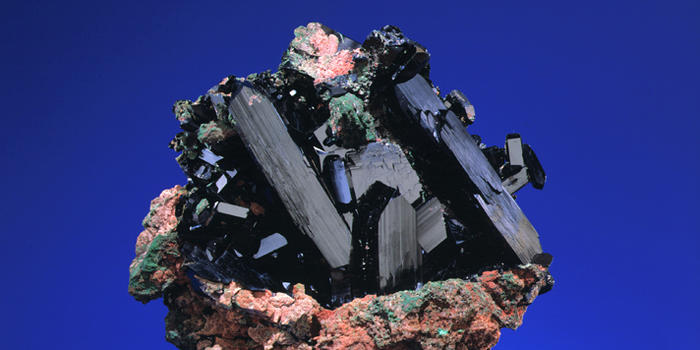
Famous ‘Newmont’ Azurite; Tsumeb Mine- approximately 30 cm. across with crystals to 15 cm. (photo © American Museum of Natural History)
5.) Kola Peninsula, Russia
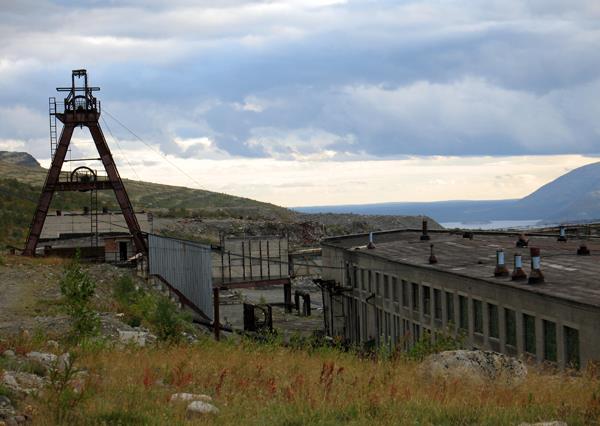
Workings of the Umbozero Mine, Khibiny Massif: K. Dembicz photo/© Spirifer Minerals 2009
Locality number 5 risks taking us back into the realm of ‘ugly and rare’ after letting our imaginations roam the colorful crystalline landscape of Tsumeb. But wait! Have you seen the starburst-like sprays of golden astrophyllite crystals in a snow-white matrix? The gemmy, sword-like natrolite crystals to 30 cm? The delicate pink tugtupite, hackmanite, and ussingite whose neon expanses hide dozens of minerals known nowhere else in the world? The Kola Peninsula, extending into the Arctic region of northwestern Russia to the east of the Scandinavian Peninsula, is truly a world-class mineral locality and geological treasure house. While I am deviating somewhat from the ‘single locality model’ in including the Kola Peninsula (an almost 100,000 square kilometer area), I think this inclusion is justified in that the main mineralized areas, the Khibiny and Lovovero Massifs, are in fairly close proximity to each other, and show strong geological, temporal, and mineralogical similarities.
The Kola Peninsula (taken here to include to massifs of Khibiny & Lovozero) were long shrouded in mystery to western collectors and mineralogists, and for many still conjure images of distant snow-covered slopes and small ‘rocks’ with arrows on them. Part of this mystery is political, as the region is in a remote part of what was up until 1994 the Soviet Union, and the strategic nature of the mineral deposits at Kola as well as Cold War tensions limited communication with outsiders about the treasures of the region. Inside Russia (and the USSR), however, is a rich history of geologic exploration at Kola. While native peoples of the Inuit culture made Kola home for thousands of years and surely took note of the unusual appearance of many of the rocks there, ‘modern’ exploration began in earnest in the 1920’s with the discovery of massive deposits of magmatic apatite at Lovozero (Pekov 2000). Since the USSR had limited ability to import outside resources and did not have large known ‘conventional’ phosphate ores, the rather unusual initiative was taken to begin mining these apatite ores for their phosphorous content, a critical ingredient in the ‘state farm collective’ program of industrial agriculture.
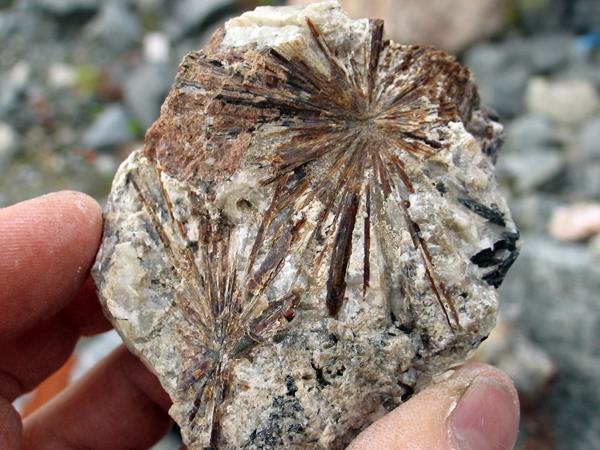
‘Stars’ of Lamprophyllite in Nepheline, Umbozero Mine: K. Dembicz photo/© Spirifer Minerals 2009
In the 1930’s, as the apatite mines were developed, leading Soviet mineralogist and geochemist Alexander Fersman visited the area and took note of the mineral eudialyte, a complex silicate enriched in Zr and REE’s. Loparite, another complex REE species, was discovered in 1934, and soon an outpost of the USSR Academy of sciences was established at Khibiny (Pekov 2000). Loparite generated much interest both to scientists and the government, as it was a potentially-economic ore of the strategic metal niobium, as well as other rare metals. In fact, much of the development of the rare metal industry in the USSR was shrouded in secrecy, even to those involved in it. Exploration and mining in Kola ceased temporarily during WWII, when many of the mills and mining operations were converted in munitions plants and military equipment factories. Mining and exploration resumed after 1945, but this period leading up to Stalin’s death was somewhat of a dark period for Kola, as most labor at the mines was in the form of ‘gulag’ prisoners, many there for political reasons. Nonetheless, scientific inquiry into the unique geology of the region continued, with the publication of ‘Petrology of the Lovozero Massif’ in 1972 by Bussen & Sahkarov marking a research milestone (Pekov 2000).
Exploitation of both apatite and rare metal ores continued at a fairly steady pace through the early 1990’s, when democratization of the country and the fall of the USSR brought a slowdown in heavy industry, which has continued until today is some areas. Research on the peninsula, however, continued to be strong, with many papers and significant discoveries by scientists such as A.P. Khomyakov, I. Pevok, P. Kartashov, and others. Apatite mining at the Kirovskii mine on the Khibiny Massif and several locations on Lovozero continues today, but unfortunately many rare metal operations such as the famed loparite deposit at Umbozero have fallen in disrepair. Hopefully, with economic strengthening of Russia and renewed global interest in rare metals, particularly the largely-untapped eudialyte ores, mining will return full-force to the region, and with it new mineralogical treasures to be found.
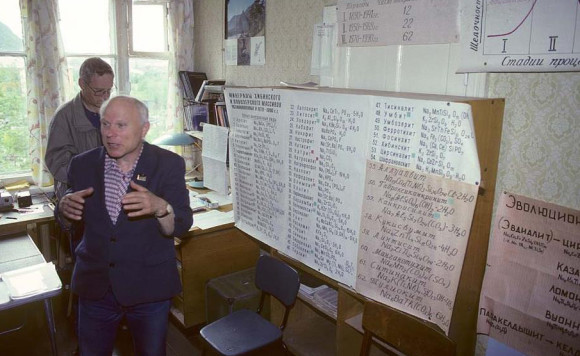
The great Russian mineralogist A.P. Khomyakov in his laboratory in Khibiny in 1992, with list of possible new minerals behind him (photo © O.T. Ljostad/mindat.org)
Geologically, Khibiny and Lovozero are quite complex, but can be explain most simply as a pair of complex multiphase alkalic igneous intrusions of Devonian age, each with a surface expression of ~600 km2, which have intruded the Archean crystalline rocks of the Baltic Shield (Pekov 2000). The intrusions are in deep graben-like structures, likely related to syn-intrusive rifting, and are partly filled with middle Paleozoic age volcanic and volcanoclastic rocks. The main rock types in the massifs are nepheline syenites and related silica-undersatured, nepheline and sodalite-normative alkaline igneous rocks, but there is also a complex suite of mafic rocks ranging from trachyte to phonolite to gabbro, an important piece of evidence in the interpretation that alkalic intrusions often have genetic links to primitive mantle-derived mafic magmas in intraplate settings (Pekov 2000). Enrichment in phosphorous of one of these magmatic pulses led to the development of an immiscible, possibly late-stage melt from which large quantities of primary magmatic apatite were about to crystallize (Pekov 2000). The diversity and rarity of the rock types encountered at Lovozero and Khibiny indeed led to a whole new nomenclature for such rocks- urtites, lujavrites, foyaite, riscchorites and malignites are all important and rare alkalic rocks at Kola. The multiphase and chemically-variable nature of the intrusions created spectacular layering and zonation, both vertically and in cross-section, of different rock types. Both intrusions included eruptive phases and concordantly shallow intrusive units showing spectacular poikilitic (sieve-like mineral intergrowth) textures and evidence of subsolidus crystallization (Pekov 2000). With subsolidus (below the normal melting curve of that mineral assemblage) crystallization came widespread metasomatic alteration, in which one element is removed and replaced by a different element, typically by hydrothermal fluids. Metasomatism and related pegmatite formation are undoubtedly the main factors in establishing the incredible mineralogical diversity of Khibiny & Kola. Pegmatites are abundant in numerous rock types of both massifs, and while often small (a large pegmatite might be ~20 x 1.5 m), they can contain an amazing abundance of minerals: one pegmatite encountered underground in the Umbozero loparite mine contained over 80 minerals! Finally, the sub-Arctic setting of the massifs and lack of appreciable vegetation combined with extensive glacier scouring and erosion means that exposure is generally excellent, and many new pegmatites and mineral localities are discovered each field season.
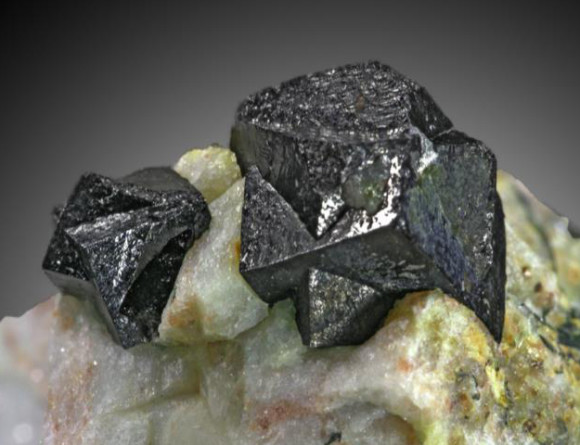
Loparite-(Ce) twins of matrix to 1 cm: Khibiny. (photo © B. Kantor/mindat.org)
Mineralogically, 507(!) different mineral species have been reported from Khibiny, and 376 from Lovozero. Truthfully, both massifs include dozens of individual localities, but they generally share such strong genetic and chemical characteristics that for the sake of discussion they will be referred to as a single locality here. Starting on the aesthetic end of the mineral spectrum, many collectors will be surprised to learn that both Khibiny and Lovozero have produced spectacular, beautiful crystallized specimens of numerous minerals. Perhaps best-known is astrophyllite, a complex Na-Ti silicate which occurs as golden sprays of radiating crystals to 10+ cm in snow-white matrix. Eudialyte, a rare species which is sometimes a rock forming mineral(!) at both massifs, rarely occurs as sharp, bright pink to red crystals to 5+ cm. Natrolite, a common mineral both in the more evolved rock units and the pegmatite’s of Kola, occurs as sprays of gemmy, sharp clear crystals up to an impressive 30 cm. Loparite, the important ore of Nb & REE’s, occurs as sharp black cubic crystals to several cm, sometimes in attractive interpenetration twins. Neptunite and Lorenzenite, two chemically-different but somewhat similar looking minerals, occur in attractive dark red to black crystals up to the size of a finger. Elpidite, the rare Be silicate, occurs as large hand-sized sprays of radiating white crystals. Kovdorskite, a rare Mg phosphate from the Kovdor apatite mine, occurs as beautiful clear crystals to several cm. The rare fluoride Villiaumite (NaF) rarely occurs as euhedral crystals, but forms attractive ‘nests’ of bright red cubic cleavages to 20+ cm in some pegmatites.
In terms of ‘rare’ species (rare being a relative term at Kola), there are hundreds of minerals, and a monograph could (and has) been written on them. Suffice it to say that most occur as attractive crystals <1 cm., while others are only massive, but many, massive or otherwise, have beautiful color and texture, which renders them desirable collection specimens nonetheless. Pegmatite such as the Shkatulka pegmatite in the Umbozero Mine and the pegmatites of Kukisvumchorr Mountain at Khibiny are world-renowned for their complexity. Many are beautiful even to the lay-person, presenting coarse-grained intergrowths of red eudialyte, green amazonite, giant microcline and nepheline crystals, chlakovite, ussingite, and tuptupite and delicates shades of crimson and pink, and smaller ‘nests’ of vibrantly colored REE and rare metal-bearing minerals. Given that most of these pegmatite’s were discovered as surface outcrops and have never been mined, the treasures of Khibiny & Lovozero should be accessible for generations of mineralogists to come.
6.) Illinois-Kentucky Fluorspar District, USA
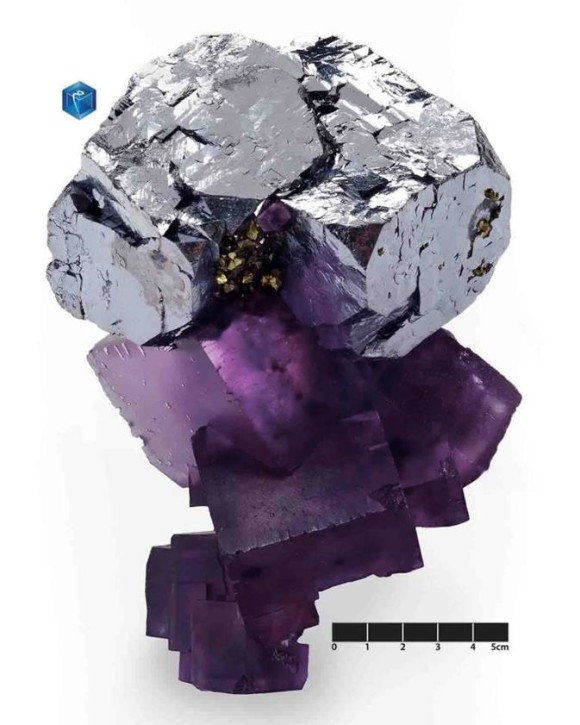
Galena on Fluorite: Denton Mine, Harris Creek Sub-District, Hardin Co. Illinois (photo © MIM Museum, Beirut)
In light of many of the preceding localities such Mont Saint Hilaire and Tsumeb whose world-class status is indisputable, I was a little hesitant to include the Illinois-Kentucky Fluorspar District in the Midwestern USA to the ‘top ten’ list, but as much as I tried to ignore it, it kept coming back into my mind. While certainly not as diverse as Mont Saint Hilaire or unique as Tsumeb, the fluorite mines of Southern Illinois and northern Kentucky constitute one of the earth’s premier endowments in beautiful, crystallized mineral specimens. During their operation from the early 19th century up until 1996, literally tens of thousands of fine specimens of fluorite, calcite, sphalerite, galena, witherite, and more were saved, and there is scarcely a serious mineral collector in the world who does not own a specimen from the district. Combine this abundance of specimens with a seemingly endless variety in color and form in this (albeit limited) species list and you have the makings of a world-class locality.
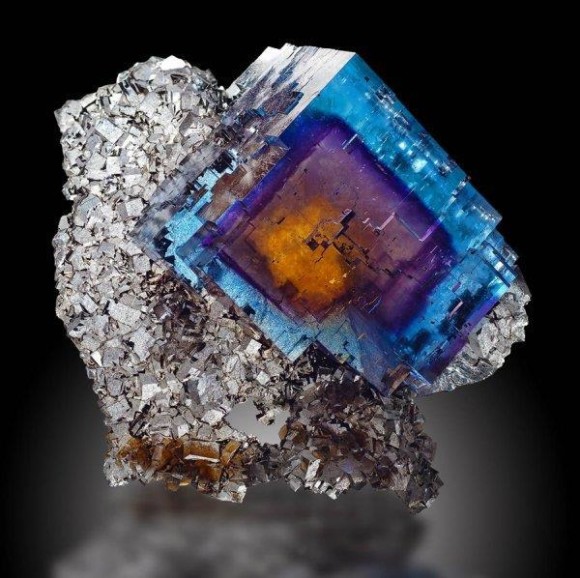
Fluorite: Minerva #1 Mine, Cave-in-Rock, Illinois- 7 cm. across (photo © James Elliot/FMI: now in the MIM Museum, Beirut)
The history of mining and minerals from the Illinois-Kentucky fluorspar district is closely linked to the history of the Midwestern US and the westward migration of pioneers and prospectors in the 18th and 19th centuries. In the early 19th century, Southern Illinois was still a fairly wild and undeveloped region, with local Indian tribes outnumbering white settlers. This changed as word of rich outcropping of galena ore (associated with then less-valuable fluorite) were found along the banks of the Ohio river near what is now Cave-in-Rock, and prospectors as well as farmers began settling the area. Mining in the 19th century focused mainly on galena/sphalerite Pb-Zn ores, and it was not until a steelmaking process in the 1880’s required fluorite for flux that mining in the district shifted to the massive fluorite (or ‘fluorspar’) deposits (Goldstein 1997). Before WWII, most mining was focused on the Rosiclare area, but this moved to Cave-in-Rock in later years, with large underground mines such as the Minerva #1, Denton, and Annabel-Lee accounting for most of the fluorite production in the later 20th century. Goldstein (1997) noted over 95 individual mines in the Illinois side of the district, and over 130 on the Kentucky side, though to be certain many of these are small prospects, and a handful of large mines on the Illinois side accounted for 75% of modern production. The district supplied over 90% of the US fluorite production, and large amounts of lead, zinc and barium were also recovered (Goldstein 1997). Unfortunately while the huge fluorite reserves in the district are probably far from depleted, rising production costs and cheap imported Chinese fluorite made mining economically unfeasible in the late 1990’s, and the last mine, the Annabel Lee, closed in 1996, marking the end of over 200 years of fairly continuous mining in the Illinois-Kentucky Fluorspar District.
Geologically, the Illinois-Kentucky fluorspar district seems deceptively simple, but in reality is part of a complex and still-poorly understood region which has been affected by processes ranging from faulting to sedimentation to unusual igneous intrusions. The surface and near-surface (upper few kilometer) geology is dominated by sedimentary rocks ranging from middle Devonian to early Pennsylvanian in age (Goldstein 1997). The fluorite-barite-galena-sphalerite orebodies occur as two generalized types, bedding-replacement deposits which are mainly horizontal and controlled by stratigraphy, and steeply-dipping veins which follow structures and can extend to great depths. Really, these two ore deposit styles are probably related, as the ‘bedding replacement’ deposits require a structural conduit for mineralizing fluids to reach a favorable limestone bed where replacement can occur. Both orebody types occur in a large anticlinal structure known as Hick’s Dome, whose uplift is probably related to regional compression as well as emplacement of a potential (never interested by drilling) deep alkalic intrusion, which may have been the source for fluorine for the deposits. The Illinois-Kentucky fluorspar district sits in the most heavily faulted area of the Midwestern USA, and these faults provided the ‘structural plumbing’ necessary for creation of the numerous ore deposits. The ‘smoking gun’ showing genetic connection between alkalic intrusive rocks and the fluorite deposits would probably involve isotope and trace element geochemical work, testable by modern methods, but little serious research on the fluorite deposits has occurred since mining ceased in 1996. Current literature suggests that locally-derived brines (salty fluids) from probably evaporitic beds within the limestone package mixed with magmatically-derived fluids, which may have triggered mineralization and precipitation of fluorite (Grogan & Bradbury 1967). Whatever the case, the combination of large, extensively-mineralized areas and a propensity for brecciation and attendant open pocket formation in the district proved to be a bonanza for mineral collectors.
Without a doubt, the premier mineral from the Illinois-Kentucky fluorspar district is, as the name suggests, fluorite. Fluorite from the district probably shows more variation in color than at any other locality, ranging from purple to blue to yellow to gray to pinkish and every shade in-between. The only ‘dominant color’ missing is the rich greens of the North Pennines Ore Field fluorites from the UK, though green crystals were found rarely in several of the older Illinois mines. Perhaps most famous and coveted are the large, gemmy groups of cubic crystals showing crisp color zonation, typically yellow with violet edges or vice-versa, from mines such as the Annabel-Lee, Minerva #1, and Denton. Most of these came out from ~1980-1995, and pockets were often so abundant during this period that high-quality fluorite sold either by the pound or by ‘the table’ at shows or at a miner’s residence. Competition for top specimens was fierce, however, and prominent dealers in the region such as Ross Lillie, Dan Weinrich and Mark & Joe Kielbaso have many stories about racing down to Cave-in-Rock or Rosiclare to see ‘the next big find’ moments ahead of their competition (Goldstein 1997).
The early years (~1900-1950) of fluorite production included important specimen-producers such as the W.L. Davis-Deardorff mine, which produced delicate violet fluorite crystals on a distinctive drusy quartz matrix, and the Hill-Ledford, which produced some of the largest single fluorite crystals in the district, up to 45 cm across! Sadly, as they had little value at the time due to their perceived commonness, many were either damaged upon removal, or broken down into ‘spar octahedrons’ which are produced by exploiting fluorite’s two perfect cleavage directions with a small hammer. During this period, many fine examples of galena and sphalerite were also found, with galena crystals from the Hill-Ledford mine sometimes reaching 15 cm on edge. The Minerva #1 mine, discovered somewhat accidentally when a night-shift driller salted their drill hole cuttings to hide their nighttime work absences, became the premier locality for the rare barium minerals witherite and benstonite from the late 1940’s up to the 1980’s (Goldstein 1997). Witherite occurs there as sharp white to yellow barrel-shaped crystals up to 15 cm, sometimes aesthetically isolated on fluorite or barite matrix.
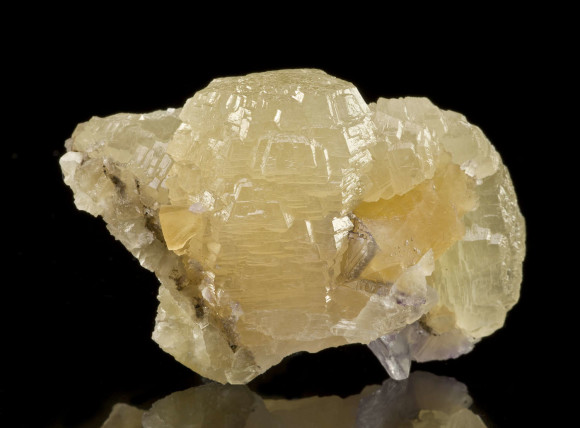
Witherite: Minerva #1 Mine, Cave-in-Rock, Hardin County, Illinois, 7.5 cm (photo © Joe Budd/irocks.com)
Barite is another fairly ubiquitous species from the Illinois-Kentucky fluorspar district, with the best crystals coming from the Minerva #1 and Denton mines, often associated with colorful fluorite and calcite. In the 80’s and early 90’s, the Denton and Annabel-Lee mines amazed the world with their brilliantly lustrous, golden-yellow calcite crystals, often as large twins on matrix. Celestine, a somewhat rare mineral for the district, was found as excellent blue-gray crystals to 5 cm on fluorite from the Annabel-Lee mine (Goldstein 1997). Galena, having previously consisted of sharp but somewhat dull crystals from the W.L. Davis-Deardorff and Hill-Ledford mines, was found as brilliant cubo-octahedrons on purple fluorite at the Denton mine. Many fluorite crystals show fascinating dissolution textures, where later fluids have corroded them into bizarre shapes and sometimes deposited new minerals, such as paralstonite and smithsonite. Strontianite in attractive yellow to white sprays was sometimes associated with these altered fluorite crystals as well, and occasionally, perfectly circular ‘holes’ would be seen in otherwise unaltered fluorite crystals where inclusions of spherical barite had dissolved, sometimes called ‘drillholes’ by the miners. While current economic conditions are not bright for the return of fluorite mining to the Illinois-Kentucky fluorspar district, the good news is that the sheer number of specimens produced means that every collector can own a piece of this world-class mineral locality for many years to come.
7.) Bisbee, Cochise County, Arizona USA
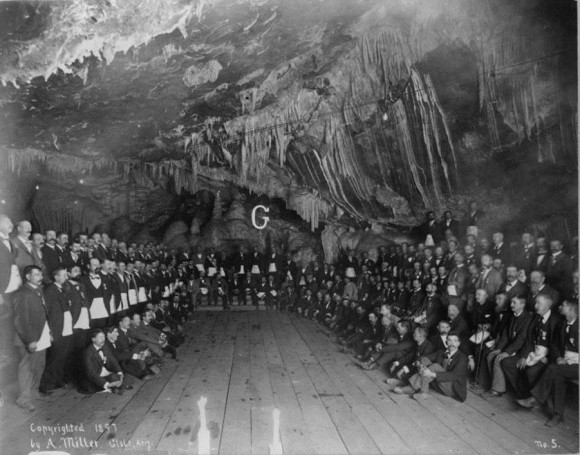
Bisbee Masonic Lodge holding a 1887 meeting in a huge ‘cave’ in the Copper Queen Mine, Bisbee, Arizona (photo © Library of Congress)
Bisbee, situated in the rolling scrub oak hills of far southern Arizona just north of the Mexican border, is a world-class mineral locality in every sense of the word. From the late 1870’s up until 1975, Bisbee produced 3.6 million tons of copper, 161,000 tons of zinc, 147,000 tons of lead, 100 million ounces of silver, and 2.7 million ounces of gold, making it one of the richest mining districts in the world for its size (Graeme 1981). Bisbee’s lasting legacy, however, will probably have more to do with the thousands of fine and colorful mineral specimens it produced than metal statistics. Collections all over the world include crystals of azurite, malachite, native copper, calcite, and more from Bisbee mines. Additionally, while mining for copper at other metals no longer takes place at Bisbee and the community has embraced a more artistic side and tourism, research on the ore deposits is ongoing and many new species, both to the district and to science have been discovered since mining stopped.
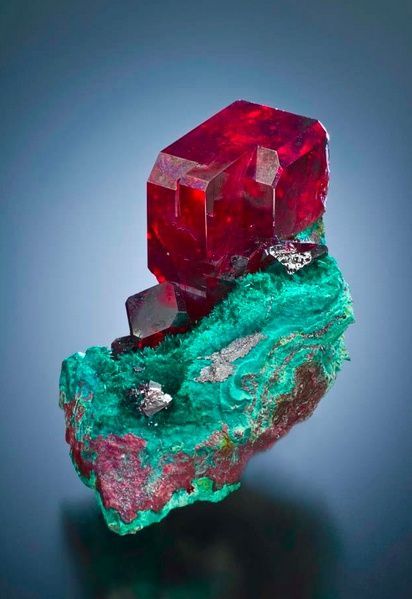
Cuprite (2.5 cm. crystal) on malachite from the Southwest Mine (specimen and photo © Richard Graham)
The mining history of Bisbee is fairly recent, beginning in the late 1870’s when prospectors Jack Dunn and George Warren visited the area from nearby Tombstone, a recently-established silver camp, and noted abundant outcrops of colorful gossan, a good indicator of mineralization at depth (Graeme 2008). They worked the near-surface ores over the next several years, ad eventually the Copper Queen mine was developed in the early 1880’s. The Copper Queen, a series of high-grade supergene orebodies in Naco limestone, featured not only high copper grades but spectacular ‘caves’ lined with stalactites of azurite, malachite, and other secondary copper minerals. Thanks to the foresight of these early miners, many of these specimens were preserved in prominent East Coast museum collections, but many more were destroyed and melted down for their copper content during mining. Mining accelerated in the 1880’s and 90’s as additional high-grade, near-surface copper orebodies were discovered, and Bisbee quickly grew into a typical frontier ‘boom town’, with businesses crowded into the narrow Brewery Gulch downtown.
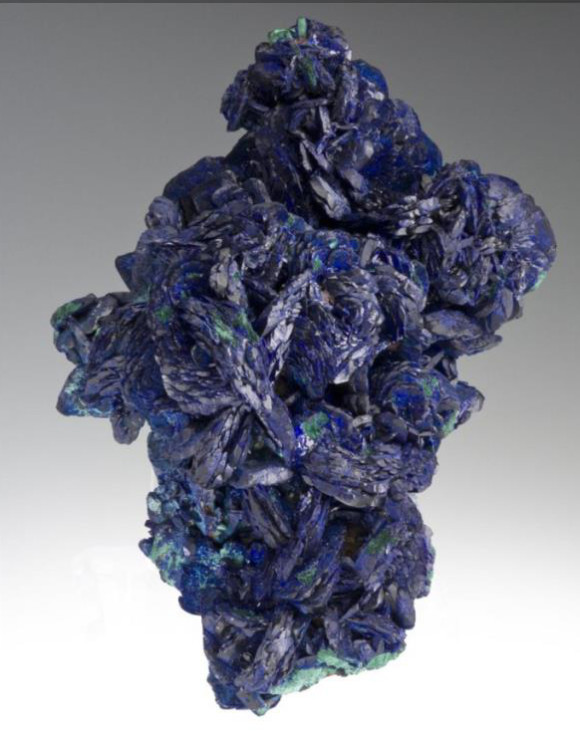
Azurite with Malachite: Czar Mine (14.5 cm across; specimen and photo © Joe Budd & irocks.com)
James Douglas started the Phelps & Dodge Mercantile company, which acquired claims adjacent to the Copper Queen which ended up propelling the company into one of the world’s largest copper producers of the 20th century, the famous Phelps Dodge Corporation. The Copper Queen mine operated independently by the Copper Queen Mining Company, but after ~1920, pressures to consolidate meant that the mines were acquired by Phelps Dodge, which ruled mining in Bisbee for the next 50+ years (Graeme 2007). Mines such as the Czar, Holbrook, Copper Queen, Southwest, and Junction mined fabulously rich and extensive copper ores, with significant recovery of Au, Ag, Pb, & Zn as well. Miners were long aware of the value and beauty of good mineral specimens- many anecdotes exist about miners trading fine minerals for haircuts, drinks, and often cash from visiting mineral dealers and museum curators (Graeme 2008). The final chapter of mining at Bisbee involved the type of large tonnage, low-grade open pit mining now favored in Arizona, focused on the porphyry from which most of the high-grade veins and carbonate-replacement deposits originated. This mine, the Lavender Pit, is still quite visible today, dominating the south end of Bisbee. Relatively small-scale mining of some remaining high grade portions of orebodies in the Junction and Holbrook mines continued into the early 1970’s as well, but these closed eventually due to rising costs and lower yield (Graeme 2008).
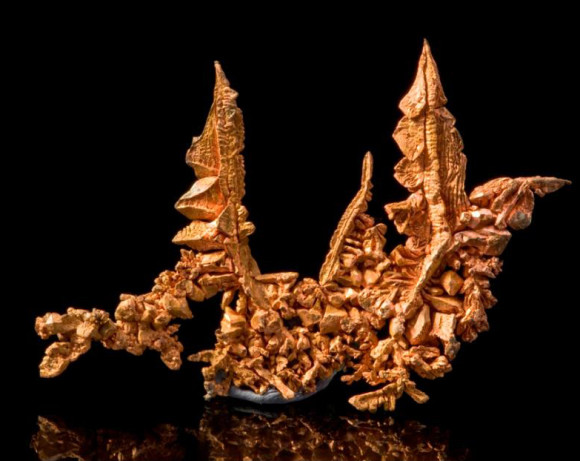
Spinel-twinned group of Native Copper Crystals: Bisbee, Arizona (5.3 cm, specimen and photo © Joe Budd & irocks.com)
The geology of Bisbee has been studied in detail since Frederick Ransome of the U.S. Geological Survey published his landmark monograph in 1904. Bisbee, like much of southern Arizona, in underlain by Precambrian schist and quartzite of the Pinal group, which in turn is overlain but 1600-2000 meters of mostly Paleozoic sedimentary rocks, dominantly limestone (Graeme 2008). Beginning in the Jurassic period ~180 million years ago, igneous activity and associated faulting introduced massive amounts of pyrite to the Bisbee area, which replaced selective limestone beds and also was associated with minor copper, silver and gold (Anthony et al. 1995). Later, during regional extension associated with basin-and-range tectonics across southern Arizona in the Cretaceous to Eocene periods, many large copper-bearing porphyry intrusions were emplaced, including Ray, Morenci and Bagdad. At Bisbee, however, a similar copper porphyry, the Sacramento stock was emplaced much earlier, around 104 million years ago, and high-grade vein deposits were probably concurrent with this intrusion (Bain 1952, Anthony et al. 1995). Lead-zinc deposits of the carbonate-replacement type were formed during this event, and finally, somewhat later, a third major pulse of mineralization overprinted some earlier Cu-Pb-Zn deposits, enriching them in unusual metals such as tin, bismuth, tungsten, tellurium, and antimony (Graeme 2008). Uplift and erosion during the more recent Eocene period led to the devlopment of extensive supergene enrichment zones in many deposits, in which most of the colorful and well-crystallized minerals reside. It is this complex and multi-stage geologic history that gave Bisbee its unique mineralogy.
The mineralogy of Bisbee is rich and varied, with over 322 mineral species reported (Graeme 2008). The ores are often highly complex, with assemblages of rare tin, tungsten, and tellurium minerals that are just beginning to be understood. Of course, the stars of Bisbee are azurite and malachite, both occurring in quantities large enough to be considered major ores in the early years. Crystals of azurite from Bisbee occur in a variety of forms, from classic ‘rosettes’ of flattened blocky crystals, to elegant prismatic blades to 10+ cm on matrix. Tsumeb and the new Milpillas mine not far from Bisbee may be close competitors for the title of ‘world’s best azurite’, but Bisbee can hold its own, specimen-for-specimen, with most anything from these locales. Malachite often replaces azurite at Bisbee, and sharp psuedomorphs in clusters to 20+ cm are a specialty. Cuprite is another species for which Bisbee is world-renowned, with the best specimen consisting of 2.5 cm, lustrous, gem-red crystals on malachite; truly a spectacular piece. ‘Chalcotrichite’, or fibrous nests of cuprite needles, is common, often associated with native copper. Native copper was locally abundant at numerous levels in the major mines, and fine crystals, often showing spinel-law twinning, occur in hand to basketball-sized groups, giving the Michigan Copper Country a ‘run for its money.’ Calcite is a particularly varied and beautiful Bisbee mineral, often colored by inclusions of various copper minerals, resulting in bright red or green to blue groups. The ‘caves’ of the early supergene enrichment zones contained huge quantities of ‘floss ferri’ aragonite and delicate groups of calcite crystals showing stalactitic growth features.
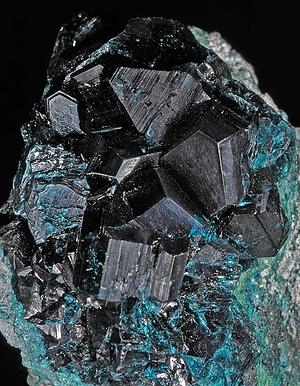
Spangolite with cuprite: Czar Mine, Bisbee, Arizona: crystals to 1.7 cm (photo & specimen © Harvard University)
Bisbee is the type locality for 7 species, including the rare and beautiful copper minerals Spangolite and Paramelaconite, both highly prized today. Shattuckite, another rare copper mineral, was also discovered at Bisbee. Turquoise, while not associated with historic mining at Bisbee, was found in considerable quantity and quality in more recent years adjacent to the Lavender open pit. Paratacamite, Covellite, Conichalcite, Claringbullite, Conellite, Chalcoalumite (TL), and brochantite are colorful and reasonably abundant at Bisbee, despite being globally rare copper minerals. Recent research on Bisbee has added numerous new species to the list, and the previously ignored ‘massive sulfide ores’ of deep mines like the Campbell and Holbrook are now recognized as having very unusual geochemical signatures, with strong enrichment in indium, gallium, tungsten, tin, and tellurium, suggesting the genesis of the deposits likely involved multiple geochemically unusual hydrothermal fluids. Phelps Dodge successor Freeport-McMoran has been considering re-opening and expansion of the Lavender pit in Bisbee in recent years, so when copper prices improve, we may once again see mining return to the great town of Bisbee (Jaworski pers. comm. 2014).
8.) The Ojuela Mine, Mapimi, Durango Mexico
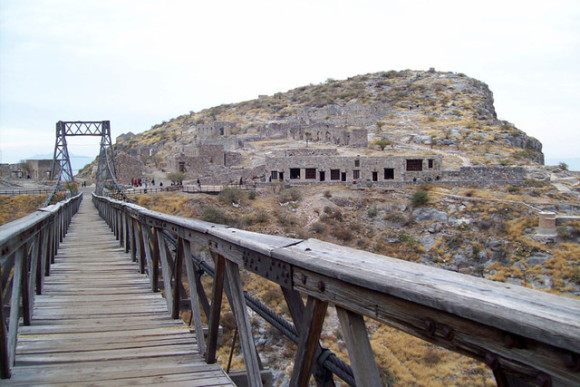
Famous Roebling Suspension Bridge at Ojuela (photo © mexconnect.com)
Mention the Ojuela (pronounced O-whale-ah) mine to collectors and visions of vibrant green Adamite pinwheels, neon yellow Legrandite sprays, and rich orange Wulfenite groups are sure to be conjured, or perhaps the 310 meter length of the famous Roebling suspension bridge, the longest in Latin America, contrasting with rugged desert landscapes. The Ojuela mine, located in the state of Chihuahua close to its border with Durango in north-central Mexico, is home to over 137 mineral species, with 7 of them having their type locality there. Over 6 million kilograms of silver and 49,000 kilograms of gold were produced from Ojuela, in addition to substantial lead and zinc, totally in value to over 2 billion dollars in nearly 400 years of production (Panczner 1987). Its history is rich as well, from the discovery of the deposits by Spanish Jesuit priests in 1598 up until today, where mining, mainly for mineral specimens, is ongoing (Haghenbeck & Haghenbeck 2011).
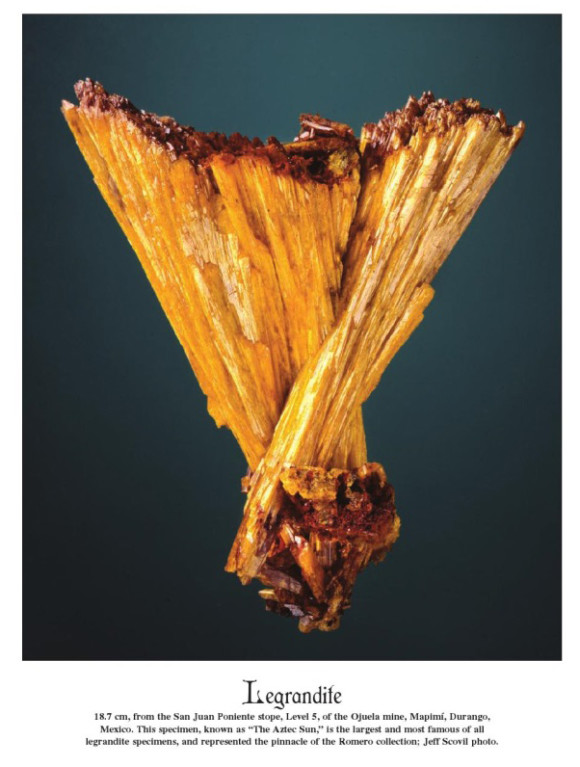
Famous ‘Aztec Sun’ Legrandite; ~20 cm, Ojuela Mine (photo © Jeff Scovil & the Mineralogical Record)
Mining for silver began in the early 17th century and continued at a small scale before accelerated in the mid-19th century with the importation of modern mechanized mining methods from Europe and the USA. To solve the conundrum of connecting mining operations with the town located across a deep, rocky gorge, a huge pedestrian suspension bridge measuring 310 meters across was constructed in 1898 by John Roebling & Sons (Haghenbeck & Haghenbeck 2011). John Roebling’s son, Washington Roebling, was a leading mineral collector of his era, so the improvement of Ojuela, already then known for fine minerals, must have been of particular satisfaction to him. Mining at Ojuela continued to grow up until the Mexican revolution in 1910, when the country was swept into chaos and Penoles, the large mining conglomerate in charge of operations, was nationalized (Haghenbeck & Haghenbeck 2011). After the revolution, mining continued, eventually creating over 450 kilometers (!) of underground workings. Large-scale mining ceased in 1945, but since that time, small groups of miners organized under collectives or cooperatives have produced a mix of silver-polymetallic ore and mineral specimens. Mineralogists of the early 20th century such as W.F. Foshag and Dan Mayers helped popularize the unusual and colorful minerals of Ojuela, and miners found that they could make better wages collecting crystallized minerals than mining ore, a tradition that has continued up until today.
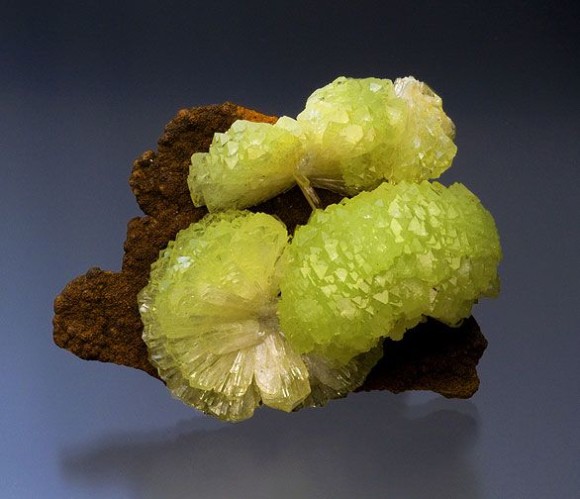
Adamite ‘pinwheels’ on matrix to 4 cm from the Ojuela Mine (photo © Jeff Scovil)
The geology of the Ojuela Mine and the Mapimi region is dominated today by typical basin-and-range topography and structure, with similar mountain ranges, valleys and landscapes to Southern Arizona or New Mexico. Precambrian age granite and schist is overlain by a thick sedimentary sequence, dominated at Ojuela by Cretaceous limestones and dolomites (Panczner 1987). The Ojuela mine exploits not one but seven different pipe-like orebodies, called ‘chimneys’, and associated ‘mantos’, or carbonate-replacement orebodies controlled mainly by stratigraphy. These chimneys and manto deposits extend to depths of over 900 meters, with oxidation occurring at depths of up to 500 meters (Panczner 1987). Similar to Tsumeb, this great depth of oxidation and supergene enrichment couples with ‘receptive’ carbonate host rocks are largely responsible for Ojuela’s great mineralogical diversity. 4 main mineralization styles occur at Ojuela: copper-enriched ‘contact’ ores, lead-zinc ores, silver-lead ores, and the ‘barren’ carbonate zone (Panczner 1987). Each of these zones contains different minerals assemblages.
Mineralogically, the Ojuela mine is perhaps most famous for its arsenate (arsenic-containing) secondary minerals, such as adamite, legrandite, and kottigite. Adamite, perhaps the most famous mineral from Ojuela, occurs as spectacular ‘pinwheels’ on vibrant green crystals to several cm each, as well as sharp individual crystals, typically on an aesthetically-contrasting gossan matrix. Cuprian adamite is relatively abundant at Ojuela and has a distinct blue-green shade different than copper-free adamite. The most desirable, however, is the manganoan adamite, colored purple and occurring as vivid bundles of crystals to 5+ cm on matrix. These purple adamites caused quite a stir in the mineral world when a major pocket was discovered in 1981, and Texas oil man Perkins Sams spent many thousands of dollars of several top examples now in the Houston Museum of Nature & Science. While adamite is still being found at Ojuela, most modern production consists of small crystals in vugs in matrix, and it appears the often very large (and very inexpensive by modern standards), plates of pinwheels or bladed aggregates of crystals are a thing of the past.
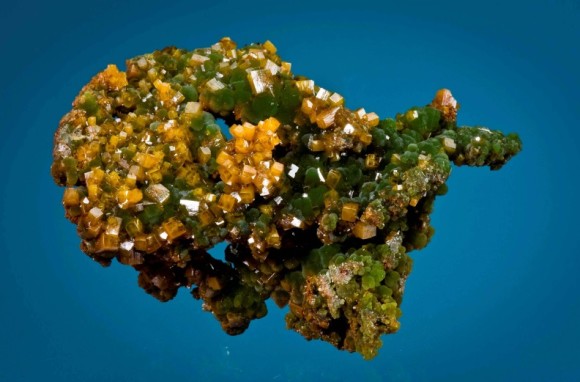
Wulfenite on Mimetite: Ojuela Mine (7 cm, specimen and photo © Joe Budd & irocks.com)
A close second to adamite from Ojuela is legrandite, another rare zinc arsenate species which reaches its zenith at Ojuela. Probably the most famous specimen, consisting of an aesthetic ‘V’ pair of sharp yellow crystals to 20 cm(!) is known as the ‘Aztec sun’ and for many years was the centerpiece of the Dr. Miguel Romero collection (it is now in the MIM museum in Beirut). Its sale and the extraordinary price (rumored to be around $2 million USD) associated with it also became a talking point in the mineral community, and in a curious case of ‘trickle down economics’, all other legrandites, even thumbnails, seemed to see a concordant increase in their price tags. Nonetheless, enough legrandite was produced that the average collector can still acquire a modest example of this beautiful and classic species from the Ojuela Mine.
Other rare and beautiful arsenate species from Ojuela include brilliant green Austinite crystals, blue Kottigite sprays, and blue-gray Symplesite blades. Equally famous (and much more abundant today) are specimens of green, botryoidal mimetite hosting lustrous orange wulfenite crystals, up to several cm in size. Wulfenite from Ojuela is somewhat unusual in its variety of crystal forms: almost equant, pseudo-cubic crystals are not uncommon, as are elongated, dipyramidal crystals. In recent years, many excellent, very aesthetic examples of this combination have been found. Hemimorphite is another attractive zinc mineral which is abundant at Ojuela- groups of parallel white prisms forming an almost botryoidal ‘carpet’ on gossan matrix have been found up to 40+ cm. Several minerals also noted from Tsumeb occur as attractive examples from Ojuela, such as bayldonite, tsumcorite, and duftite. Additionally, Ojuela is the type locale for a number of species, including the rare arsenates lotharmeyerite, mapimite, ojuelite, and miguelromeroite. Continued mining by cooperatives and independent specimen diggers mean that good minerals and perhaps new species will be found at Ojuela for many years to come.
9.) San Diego County, California Gem Pegmatites
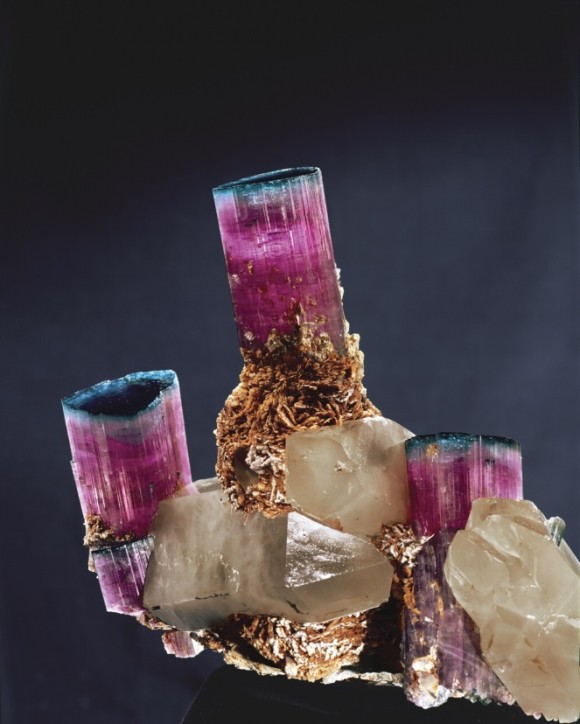
Famous 25 cm-wide ‘cadelabra’ blue-capped Elbaite Tourmaline from the 1972 Tourmaline Queen Mine find (photo © Harold & Erika Van Pelt)
Gem pegmatite districts, typically of the Lithium-Tantalum-Cesium (LCT) pegmatite family, are not especially rare on earth, with good examples occurring on most continents, including the mountains of Pakistan/Afghanistan, Minas Gerais State in Brazil, and Oxford County Maine, USA. What makes the pegmatites of Southern California special however, is their concentration, both of individual pegmatites and of collectible (and often beautiful) mineral species. While gemmy, polychromatic crystals of tourmaline, spodumene or beryl first come to mind when San Diego County in invoked, the district is also an important source of fine crystallized examples of rarer species such as stibiotantalite, rynersonite, hydroxlherderite, and hambergite. Mining for gemstones and mineral specimens has enjoyed an almost 125 year history, continuing today, and interest and appreciation for the minerals of the region, particularly tourmaline, are probably at an all-time high today.
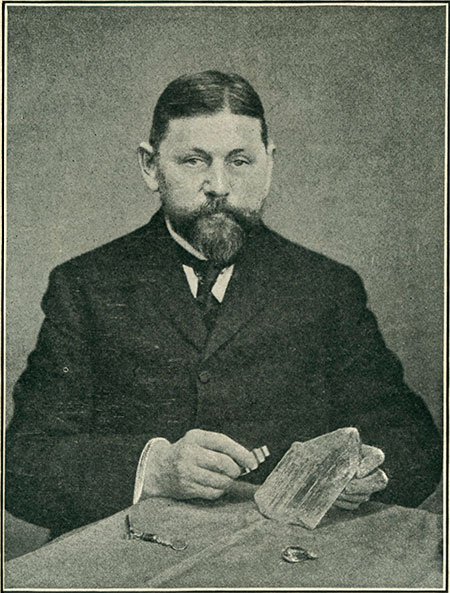
George Kunz examining crystals of spodumene var. Kunzite around 1905.
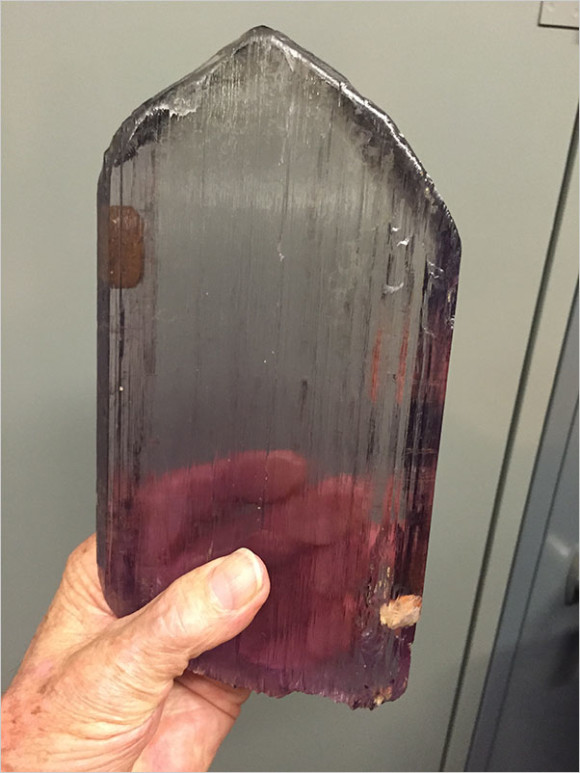
A large kunzite crystal in the Harvard collection from the same find (both photos © Bill Larson/palaminerals.com)
The rolling, Mediterranean-like hills around Mesa Grande and Pala were quite pastoral in the late 19th century, with farming and ranching occurring around scattered small villages. In 1898, Mesa Grande local Gail Lewis discovered small crystals of bicolor tourmaline loose on the surface of what would become known as the Himalaya pegmatite, and filed a claim on it. Given the strong market for US gemstones at the time, the chief promoter of this market, George Kunz of the Tiffany company of New York, soon got word of the new California tourmaline discovery, and sent secret company agents to investigate the potential for a new gem district (Fischer 2008). Kunz’s men soon began mining tourmaline and other pegmatite minerals at the Himalaya and nearby pegmatites on their own, with most good colored tourmaline going to China for carving into ornamental snuff bottles and other items which were then very much in demand there (Fischer 2008). In 1902, the pegmatites around Pala were discovered, and soon after, a number of crystals of bright pink spodumene were found, to be named ‘kunzite’ in honor of George Kunz. After the Chinese revolution in 1912, demand for carving-grade tourmaline plummeted, as did gem demand in general in the US around the world war periods (Fischer 2008). It was not until the 1950’s, as mineral collecting became increasingly popular in the US along with demand for colored gems that pegmatite mining resumed in San Diego and Riverside counties. Several spectacular discoveries in the 1970’s and 80’s, most notably the 72 find of huge blue-capped pink tourmaline crystals at the Tourmaline Queen Mine. Mines such as the Stewart, Tourmaline King & Queen, Himalaya, and Little Three enjoyed fairly frequent pocket discoveries throughout the middle 20th century, and some are still operating today, though generally on a ‘hobbyist’ or ‘weekender’ level by collectors with other primary forms of employment. Indeed, the challenges of pegmatite mining are perhaps best exemplified by the months leading up to the great 1972 ‘blue cap pocket’ at the Tourmaline Queen Mine, in which miner John McLean and others tunneled over 6 meters through hard, unmineralized, barren pegmatite only to change course slightly into a world-class crystal pocket (Larson 2008). Still though, the search for gems has inspired many a miner and collector, and this search continues today at mines such as the Oceanside and Cryo-Genie.
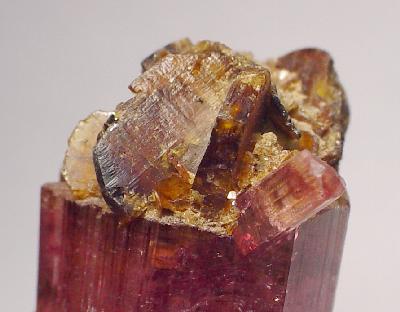
Stibiotantalite crystals on Rubellite Tourmaline (2.6 cm across), Himalaya Mine (specimen and photo © irocks.com)
Geologically, the gem pegmatites of San Diego County share many similarities with other great gem pegmatite provinces of the world. They are of the lithium-tantalum-cesium (LCT) geochemical family, which are highly evolved pegmatites characterized by stong enrichment in large ion lithophile (LILE) elements such as lithium, cesium, rubidium. They also contain significant boron, fluorine and beryllium, important elements for the formation of tourmaline, topaz, and beryl. Additionally, many pegmatites can be subdivided into rare element (containing minerals such as stibiotantalite and samarskite-(Y)), and phosphate (containing large ‘nodules’ of various phosphate minerals) affinities. In San Diego County, these pegmatites have intruded Cretaceous-age granite plutons of the Peninsular range batholith (Fischer 2008). Pegmatites have been dated at ages of ~93-98 million years, while the main host granite is ~101 million years old (Fischer 2008). This age relationship is typical for highly evolved gem pocket-bearing LCT pegmatites, which form as residual granite melt becomes increasingly enriched in incompatible elements, water, and other volatiles and eventually intrude surrounding, already cooled rock to form much coarser-grained, chemically-complex dikes. Many of the gem-producing pegmatite’s of San Diego County extend along their strike for 100’s of meters, but are only 1-2 meters thick, with spectacular mineral zonation. Unidirectional solidification textures (formed as undercooled magma crystallizes against cold wallrocks) show large euhedral crystals which point inward perpendicularly from pegmatite walls, and at their terminations, a core zone enriched in massive lepidolite, tourmaline and other rarer species may sometimes open up into the much-coveted miarolitic gem crystal pocket. While many pegmatites are strongly deformed by subsequent uplift and faulting, the arid climate combined with fairly near-surface (<5 km) emplacement of the pegmatites means that exposure is excellent, and almost all pegmatites known today were discovered from surface outcrops.
Mineralogically, the San Diego County pegmatite district is fairly diverse, with over 120 minerals known from the pegmatites. The most famous mineral from San Diego County is probably tourmaline, or more specifically the lithium-bearing tourmaline species elbaite. Elbaite occurs in virtually all shades, from hot pink to deep blue to emerald green to nearly jet-black. Probably the most famous tourmaline crystals known today (we will avoid thinking about the many thousands of fine crystals which were destroyed by carving demand by the Chinese in the late 19th and early 20th centuries) are the large (up to ‘beer can’ size!) blue-capped rubellite crystals found in 1971 & 1972 at the Tourmaline Queen Mine. The nearby Tourmaline King pegmatite also produced outstanding, sometimes very large ‘watermelon’ and green-capped pink crystals during this era, sometimes in clusters up to 30 cm. The famous 28 cm-high ‘steamboat’ specimen on display at the Smithsonian is one such example. The Stewart mine produced thousands of elongated rubellite crystals with distinctive ‘hot pink’ color, and similar crystals were found at the Pala Chief mine (Fischer 2008). In the 1980’s and 90’s, many fine elbaite crystals showing horizontal color bands of blue, green and pink were found at the Himalaya mine. Recently, large sprays of similarly color-zoned crystals with curious ‘tapered’ habit have been found at the Cryo-Genie mine. Fine tourmaline continues to be found today in San Diego County.
Next in fame to tourmaline is probably the beautiful pink variety of spodumene, kunzite, first discovered in the Pala Chief mine and nearby Katerina and Vanderberg pegmatites in the early 20th century. Kunzite occurs as flattened tabular, gem-clear pink crystals up to 28 x 15 cm! Indeed, the largest known Southern California kunzite was actually just discovered in 2010 at the Oceanview pegmatite. Beryl also occurs in numerous varieties from heliodor (yellow-green) to goshenite (clear), but probably the most famous crystals are the sharp, gemmy flattened hexagonal pink morganite crystals from pegmatites such as the White Queen, Oceanside and Elizabeth R. Attractive clear to light blue beryl crystals also occur at pegmatite’s including the Beebe Hole and Pack Rat (Fischer 2002). Topaz is somewhat less common in San Diego County, but does occasionally form excellent, gemmy light blue to clear crystals to 10 cm, most notably at the Little Three mine, which has also produced striking combinations of gemmy spessartine garnet with schorl tourmaline on albite (Fischer 2002).
[caption id="attachment_835" align="aligncenter" width="498"]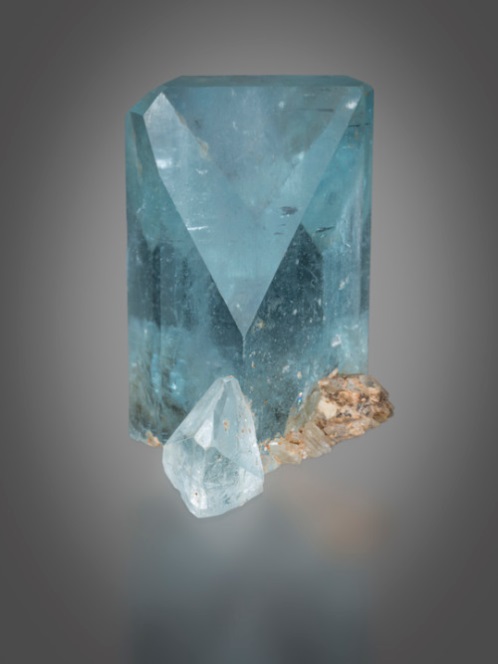 Blue Topaz: Little Three Pegmatite (photo © Robert Weldon/GIA)[/caption]
Blue Topaz: Little Three Pegmatite (photo © Robert Weldon/GIA)[/caption]
Notable rarer species from San Diego County pegmatites include dark red, lustrous crystals of Stibiotantalite with rynersonite (type locality), both rare tantalum oxides. Fine yellow to brown crystals of danburite, a boron species which is occasionally found in evolved LCT pegmatites, were sometimes found at several pegmatites. Hambergite, a rare boron beryllium siicate, is found in good crystals at several pegmatites as well, only recently eclipsed by spectacular discoveries in Madagascar and Pakistan. While not quite as aesthetic, the rare species boromuscovite was first discovered at the Little Three mine, where it is reasonably abundant. Nice pink to clear crystals of fluorapatite were often associated with quartz, though the most desirable apatites are attached to vibrantly-colored tourmaline crystals, making handsome specimens. Numerous rare phosphate minerals, such as jahnsite and hureaulite also are found in a number of San Diego County pegmatites. Continued mining in San Diego County means that fine mineral specimens will likely be available for many years to come.
10.) Jachymov District, Bohemia, Czech Republic
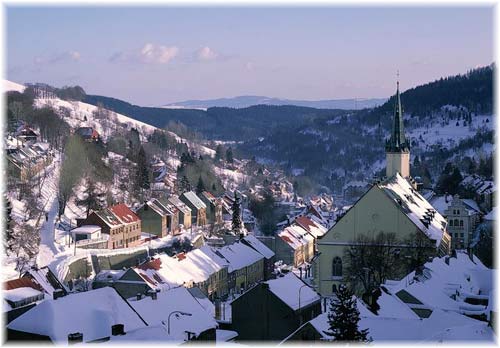
Jachymov Village in winter (photo © prague-guide.co.uk)
This last, but certainly not least locality was a difficult choice for many reasons, the obvious being that there are dozens of other localities around the world that could be considered ‘top ten’, and I’m many a reader is groaning at this very moment about my failure to include their favorite locality. Another is that there are numerous other ‘world-class’ districts in Europe which are geologically quite similar to Jachymov, such as Freiberg, Germany and Kongsberg, Norway. Nonetheless, I think Jachymov is a worthy addition to the somewhat arbitrary ‘top ten’ list for several reasons. While often forgotten by modern collectors due to scarcity of good specimens on the market and the fact that most mining occurred so long ago, Jachymov is in fact a mineralogical powerhouse, with 429 minerals reported from the district, and 46(!) of these being type localities. Many of these type locality species are not obscure, ugly rarities but in fact globally-important minerals, including uraninite, bornite, and yes, fluorite! This begins to hint at the historical importance of the district in establishing the science of descriptive mineralogy, and the centuries-long mining history there. Additionally, Jachymov is probably the world most important example of the economically-important ‘5 element vein’ type of ore deposit, which will be discussed more in detail later.
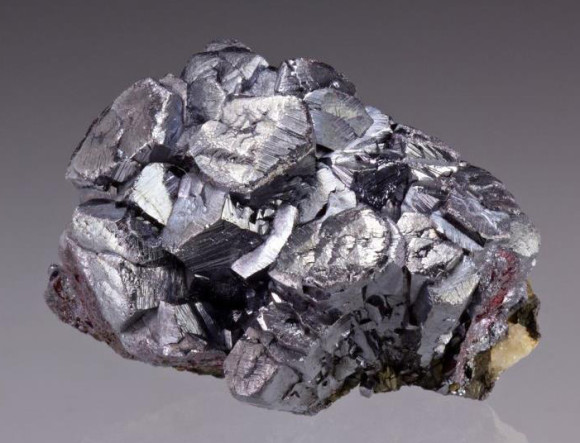
Proustite crystal group from Jachymov (4.5 cm across; photo & specimen © Weinrich Minerals)
The Jachymov District (also known as the Joachimsthal District) is situated in the Erzgebirge (literally ‘ore mountains’ in German) mountains, a range of mainly low (<2000 m), rolling, heavily forested mountains near the German border with the northwestern Czech Republic. The history of the district stretches back to the beginning of the 16th century, when the Kingdom of Bohemia ruled the region (Majer & Podlesi 1994). In 1516, rich silver veins were discovered in outcrop at Jachymov, and such a mining rush was created that production at the already well-established mines in nearby Saxony was significantly depressed, and banks and well-to-do merchants all over central Europe scrambled to invest in mining there (Majer & Podlesi 1994). By 1520, over 4000 miners and their families inhabited the ‘free mining town’ of Jachymov, and this rose to over 13,000 by 1525 (Majer & Podlesi 1994). The main purpose of mining at Jachymov in this era was production of silver to provide currency for the Kingdom of Bohemia, and it did so quite well, with over 2.2 million coins already produced by 1528, from 25 open pit and underground mines (Majer & Podlesi 1994). Indeed, even modern currency owes a nod to Jachymov, as the coins minted there were originally called ‘Joachimsthalers’, or ‘thalers’, which was corrupted over time to the word ‘dollars’ (Tyler 1930). Unfortunately, the rich, near-surface silver ores were fairly exhausted by 1550, and Jachymov lay somewhat dormant for a period, though some mining for silver continued, as well as for elements such as nickel and cobalt (then used as a pigment in paints). However, a new boom would come much later, thanks to the presence of a mysterious dense, black colloform mineral the miners called ‘pech blende’ or ‘black ore’, which would turn out to be uraninite (pitchblende). Scientists as early as the great 16th century metallurgist and early mineralogist (though a physician by training) Georgius Agricola noted the ‘bad health effects of inhalation of pech blende dust’, though he had no idea this was caused by exposure to radiation.
[caption id="attachment_838" align="aligncenter" width="580"]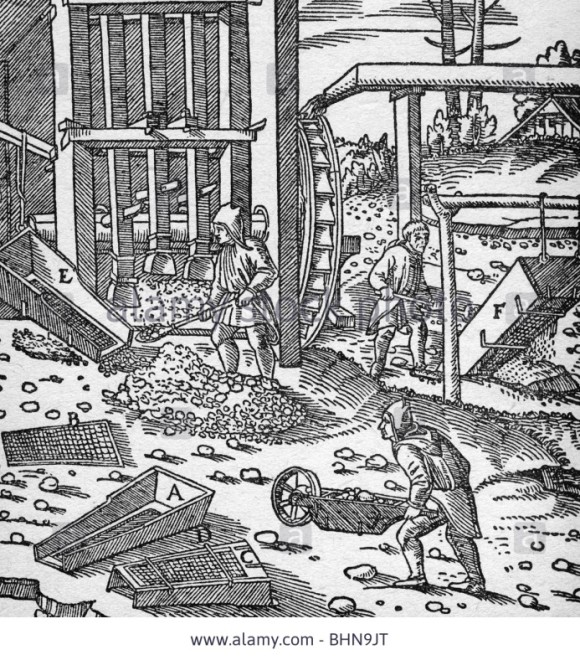 Illustration from Georgius Agricola’s seminal 1556 book ‘De Re Metallica’ illustrating mining at Jachymov (photo © fotosearch.com)[/caption]
Illustration from Georgius Agricola’s seminal 1556 book ‘De Re Metallica’ illustrating mining at Jachymov (photo © fotosearch.com)[/caption]
Fast-forward 300 years to the mid-19th century, when it was found that uranium salts, when added to ceramics, could produce beautiful shades of neon green, yellow and red, and the ceramic industry of Bohemia for many years featured brightly-colored enamelware made with such additives (Frame 2015). Later, when Marie Curie isolated the element radium, the rich uranium ores of Jachymov became a main source for this miraculous new element, whose curative powers (when applied to chemotherapy) were recognized early, but whose negative powers (to create the very cancer and other ill health effects it sought to cure) were regrettably not understood until much later. During Victorian times, people all over Europe rejoiced in the supposed curative powers of radium, and items such as radium toothpaste, mouthwash, and ‘5 cent x-rays’ were touted for their health effects (Frame 2015). In 1912, the ‘Marie Curie-Sklodowska Radium Palace’ opened in Jachymov, where visitors could bathe in geothermal springs, which supposedly contained radium, and indulge in various radium health treatments. Unfortunately by the time Marie Curie herself realized the deadly reality of radium, she was already in the advanced stages of terminal thyroid cancer, but her scientific discoveries would and had already changed the world, and would pave the way for the next era of mining at Jachymov. After WWII, when Bohemia and Jachymov descended behind the ‘iron curtain’ of the Soviet Union, Jachymov became a strategic asset, and the larger East German region was the number one supplier of uranium for both energy and nuclear arms to the USSR (Frame 2015). From 1948 to 1962, thousands of laborers, many of them political and other prisoners, labored in the Jachymov mines to extract uranium ore. All of this was highly clandestine, of course, and much is still unknown about Jachymov during this period. By the fall of the iron curtain and the breakup of the Soviet Union in the early 1990’s, mining was mostly gone at Jachymov. Today, the town is somewhat is disrepair, having never economically recovered from the cessation of mining and state planning of every detail of life there during Soviet times, but a modest tourist industry caters to those interested in the fascinating history of the area, as well as several nearby health spa resorts.
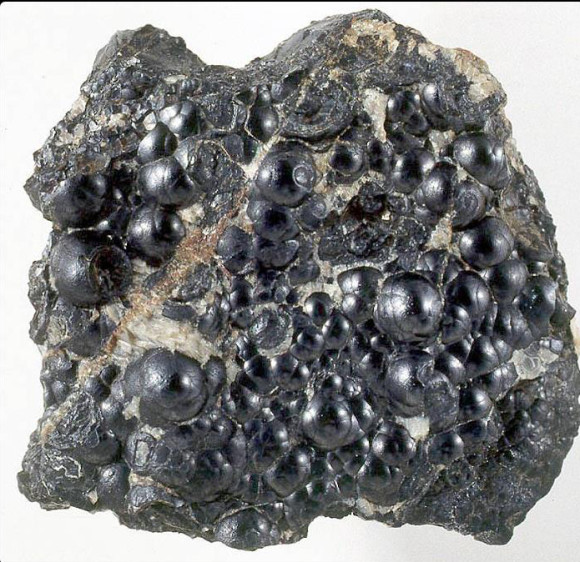
‘Pitchblende’ Uraninite, 6 cm across, from Jachymov (photo © Jeff Weissman/mindat.org)
Geologically, Jachymov is part of the great Erzgebirge Mountains metallogenic province, which includes the famous Freiberg district ~100 km away. The main host rocks to the over 200 veins occurring at Jachymov are differentiated granite plutons which have intruded Precambrian metamorphic rocks uplifted during the Hercynian orogeny, mainly schists and amphibolites (Ondrus et al. 2003). The veins are hydrothermal in nature and exploit older faults along which basalt or porphyry dikes related to the granite emplacement occur. The exact timing of mineralization and its relationship to the dikes is not understood, but pitchblende mineralization, associated with carbonates, is thought to be early (close to intrusion of the Hercynian granites around ~300 Ma), and emplacement of silver, cobalt, bismuth and arsenic sulfide ores occurred later, associated with tertiary volcanism (Ondrus et al. 2003). In many cases, earlier, fairly chemically-simple uranium ore veins were overprinted by chemically-complex ores of the ‘5 element’ affinity, containing Ag, As, Bi, Ni, & Co. It is this long-lived and complex mineralizing systems, exploiting the same structural conduits over time, which is probably responsible for the great mineralogical diversity at Jachymov, as we have seen at other world-class localities.
Mineralogically, Jachymov is best known for 3 groups of minerals: silver-containing species, arsenic-containing species, and uranium minerals. While much native silver was mined in the early days, little of it has survived until today, and none of the spectacular wires found at nearby Freiberg were found at Jachymov. However, fine crystals of blood-red proustite to 4 cm, lustrous black acanthite crystals on calcite to several cm, and other secondary silver minerals more than make up for this. Also famous from Jachymov are often large colloform specimens of lustrous black pitchblende uraninite, sometimes in great sizes. While these do not make good specimens to store in your home for obvious reasons, the upside is that the breakdown of primary uraninite at Jachymov resulted in over 80(!) secondary uranium minerals, including colorful examples of zippeite (TL), Metauranopilite (TL), Psuedojohannite (TL), its namesake jachymovite (TL) and more. Additionally, in the ‘5 element veins’, good examples of the classic Ni, Co and Ag arsenides occur, including nickeline, annabergite, rammelsbergite, skutterudite, and safflorite. Finally, a diverse list of secondary arsenates also occur, many forming colorful microcrystals and some in larger crystallized examples. While mining at Jachymov is probably finished, the rich history and mineralogical heritage, from inspiring Agricola’s ‘Der Metallica’ in the 16th century to new mineral discoveries today, will ensure Jachymov is not forgotten.
This article was brought to you by Phillip Persson of PerssonMinerals.com

Related posts:
2015 Christmas Gift Ideas for the Rockhounds in your life!
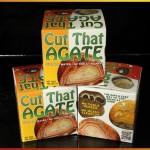
Another Thanksgiving has come and gone and Christmas is fast approaching, time to find that perfect gift for your rock loving friends and family.
Without further adou, these items have caught our eye over the past few months and would make great gift ideas for the people on your list –
#10 – UV Blacklight – Tried and True, We have seen these UV lights popping up at mineral shows and field collecting trips as a great inexpensive way to test UV reaction on specimens you find (for sale or on the ground!) – Do note, this is for a LW light, different than a SW light, most minerals react in one or the other, and sometimes both. LW is still, just as important and inexpensive SW lights are much less compact and much more expensive. This seller on eBay has sold HUNDREDS of these lights with nary a negative feedback to be seen. We can highly recommend one of these lights to all rockhounds, everywhere – a perfect stocking stuffer!
#9 – Gem Hunt – Digging in the sand is fun – different than those plaster based kits, this pseduo-rockhound kit just needs water to unlock the hardened sand block, featuring 12 gem pieces, including blue zircon, garnets, amethyst, herkimer diamond and much more. Perfect gift for all ages over 5 – small parts and possible sharp crystals. Note– The owners of this site also own CutThatAgate – Which is why we can assure you, Everybody LOVES GemHunt! This product was previewed and demonstrated at the Denver Colosseum show in 2015 to rave reviews. Now, featuring a super informative 16 page full color booklet that explains the basics of gemstones and gives in-depth information about the stones included in the kit. $34.99 + $8.00 shipping from CutThatAgate.com
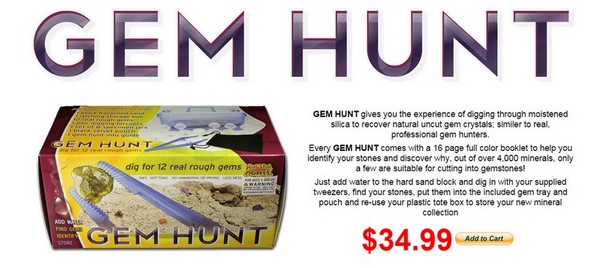
#8 – Lapis Rough – Most Watched Item on eBay Minerals We have purchased rocks for presents before, sometimes a hit, sometimes a miss – however, think about this – This Lapis lot is one of the MOST WATCHED MINERAL auctions on eBay! A half pound of bright blue Lapis is sure to make anyone happy – from the beautiful color, to the history, there is so much to love about Lapis.
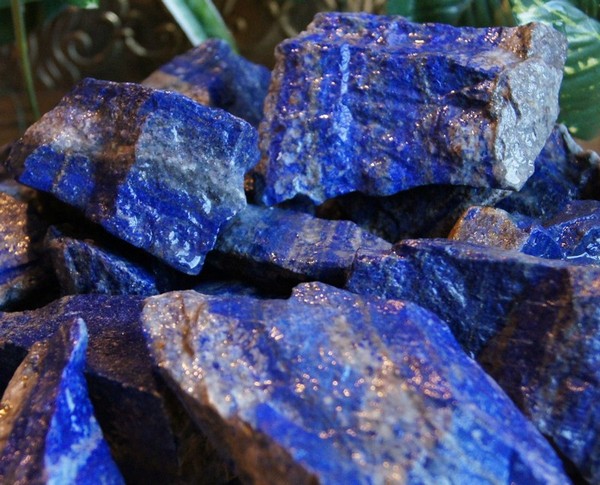
#7 – The perfect Rock Hammer – 22 Ounce Estwing Rockhammer Rock Hammers! They get lost, they get borrowed, they rarely ware out. In fact, some rock hammers are prized possessions, bestowed upon with luck, passed on like a religious relic. Nobody has enough of these. “Oh, ANOTHER rock hammer”, is not something that comes out of a rockhound’s mouth. For the novice, we have had people bring claw hammers to field trips, those people were not lucky enough to have a person like you in their life – Give love, Give a Rock hammer. This 22 Ounce Estwing is EXACTLY what they want!
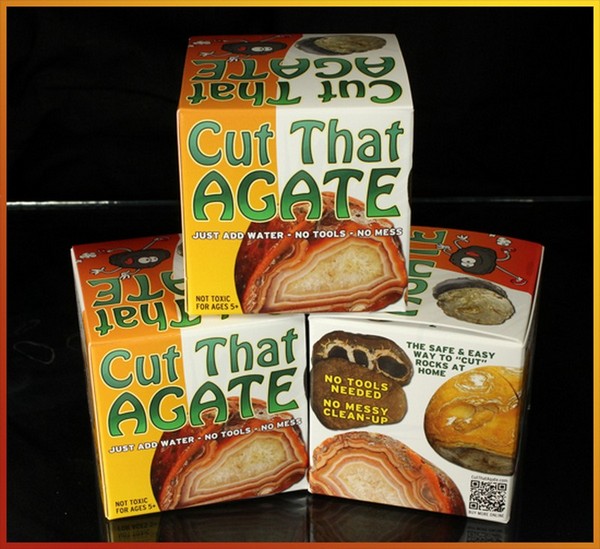
#6 – Cut That Agate – Don’t smash that geode! Then again, those raw geodes are inexpenvise and smashing things does give you a cathartic experience, but, it rarely gives you a nice split geode. We introduced Cut That Agate for this very reason – Choose between five different types of stones – Quartz Geodes, Orange and Blue Agates, Ammonite and Calcite Septarian Nodules, all split in half, polished on both sides and put back together with a strong glue that dissolves quickly in water. You can not pull these apart, but after a couple hours soaking in water, these rocks will split into two perfect specimens, ready to be displayed for years. Cut That Agate is a super gift item, a premium version of these break your own geode sets, great for ALL ages, no tools required, just add water to the jar included. 12 page booklet featuring information about each type of stone available, how agates form and more! Buy one of these for $24.99 at CutThatAgate.com – Buy all 5 versions and get them for a discounted price!
#5 – Name a Mineral or Locality Page in Honor of someone – Mindat.org – Every single person who likes rocks has visited this website. Mindat.org is a treasure trove of information, a message board with tons of people to talk to, articles galore, tons of content that people enjoy everyday. Mindat.org offers a fun option to use as a gift, sponsor a mineral page! That’s right, you can sponsor a page in someone’s name, or your own, so pick a mineral, like Glauberite! – I think Sulphohalite is still available! Pick a mineral page not sponsored and connect with Mindat! It makes a great gift!
#4 – Blue Cap Productions Mineral Shows/Events/Subjects DVDs – Blue Cap Productions makes amazing DVD’s of Mineral Shows and Mineral Topics and now YOU can get 50% off these videos until December 15th on BlueCapProductions.com with coupon code ” GOBBLE15″. These videos capture the experience of minerals in HD super quality – interviews with dealers, collectors, miners, movers and shakers, you just can not go wrong with these videos – Buy one for you or a friend today!
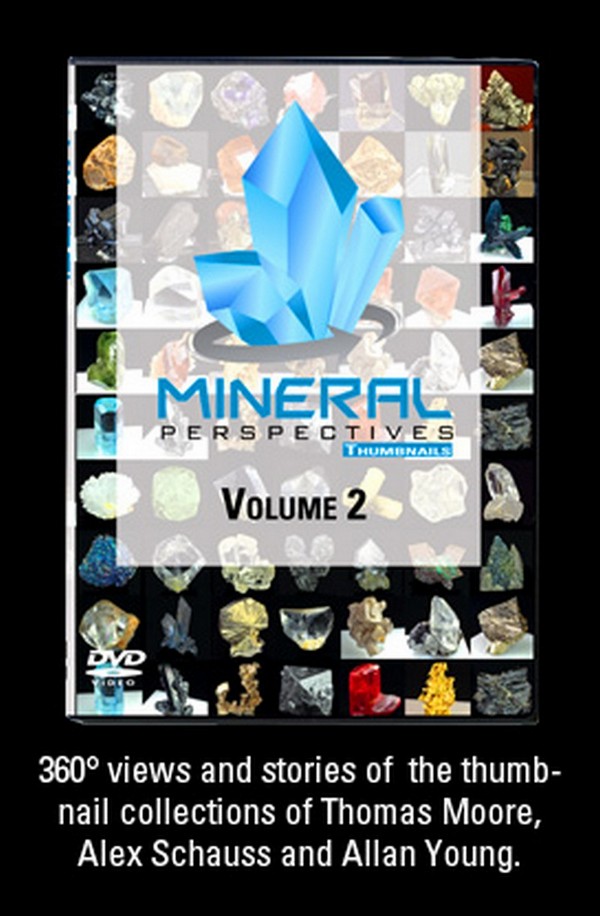
#3 – Saruca® Gem & Mineral Concentrator After using one of these fine pans, oh mama, you are never going to want for another pan! We have found this flat bottomed pan to be our favorite method of alluvial gem hunting. From specks of gold to gem material, the flat bottom of the Saruca pan is going to help while panning like nothing else. You get much better control of the material as opposed to the classic stepped pans.
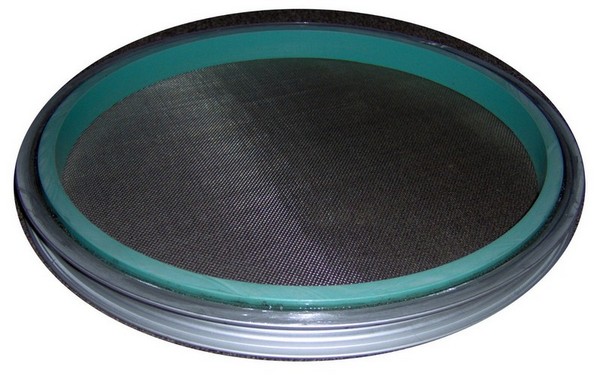
#2 – Tumbler – We have talked to at least four parents this year who asked about Rock Tumblers for their kids. Rock tumbling is a blast! We are constantly spinning out barrels, 30 pounds at a time – and for the beginner we have a few selections.
#1 – We just love this all in one set from Amazon
#2 – Check out RockTumbler.com for articles and suggestions, kits and tumblers. They really know what is best for you.
#3 – Harbor Freight sells a double barrel unit that, when on sale, is well worth the price. However, this unit does not come with grits, you NEED to buy the warranty because odds are, you will end up replacing something in two years, plus, you will want to upgrade the rubber belts they supply with the unit. Even though it comes with five replacements ones, a unit that is acting up can go through five belts in five weeks. Put a nicer belt on and you’ll rarely think of replacements, maybe every year or two of continuous use.
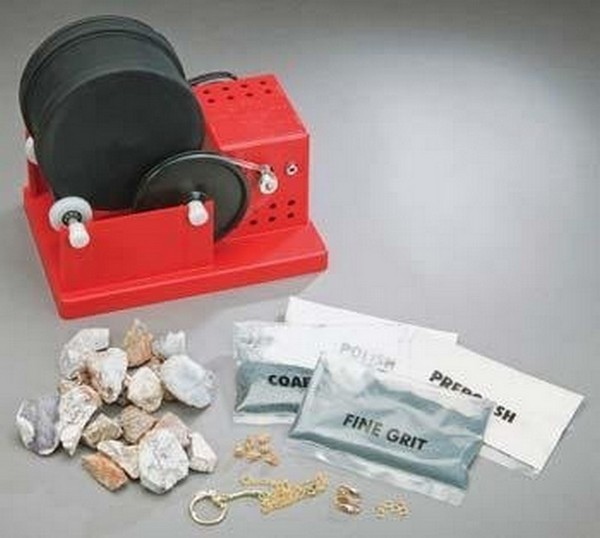
#1 – Mineralogy By John Sinkankas This book was last published in 1993 yet no text has come close in terms of ease to understand and explanation of basic concepts of Mineralogy. If one were to read this cover to cover, you would know more about Mineralogy than some advanced mineral collectors. This text is designed for all levels of knowledge, We would think most 6th graders could wrap their heads around much of this book – Get a used copy on Amazon for a friend and be someone’s hero – If someone has a basic interest in rocks, they are going to love this book. No color photos, but no stodgy, poorly written text. This is just a solid book.
So, if it is still 2015 by the time you read this, or 2016, 2017, my golly, 2018, we bet these products will serve as great gift ideas for years to come!
Related posts:
Collecting Peridot in New Mexico – Olivine Bombs at Kilbourne Hole – Find Green Rocks in a Volcano!
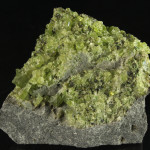
One of the more common questions that is asked about where to find specific minerals is…”Where can I find Peridot”
With the distinctive green color and hardness that lends itself to faceting, along with being a popular gemstone from antiquity, the gem variety of the common mineral Olivine is often a subject of rockhounds.
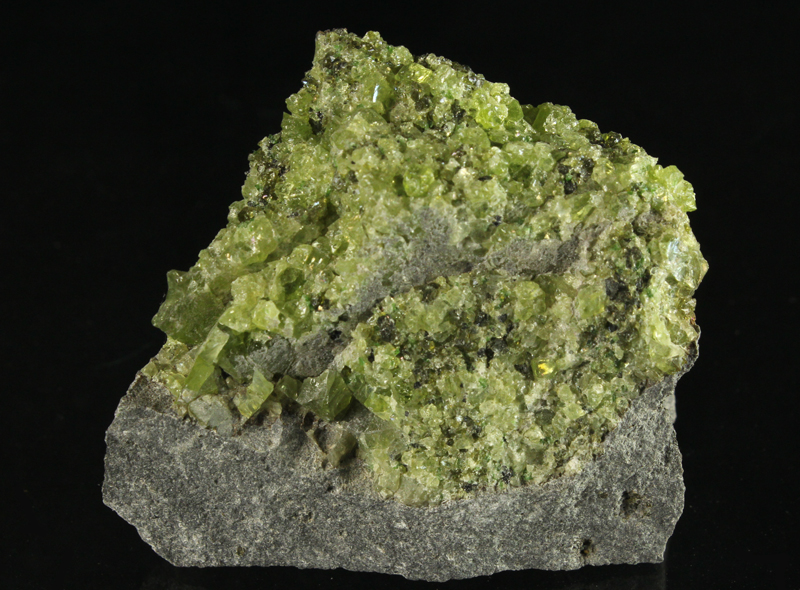
Peridot Grains in a Volcanic Bomb of basalt – Notice the larger grains on the left side of the photo. These grain are almost large enough to produce a cut stone.
Large, beautifully formed crystals of gem peridot were mined on an island in the Red Sea, off the coast of Egypt. These peridot crystals were a staple of the green gems associated with Egyptian royalty. Today, fine crystals of peridot are mined out of Pakistan, but is more to peridot than crystals, there is gem rough! One out of this world example is peridot being found inside meteorites that have landed on earth. These meteorites, when sliced, show the gem quality inside, metallic webs wrapping a dark olive color, which can be cut into gemstones. The other type of peridot to be found is gem rough that forms alongside volcanic eruptions, forming “peridot bombs” or Xenoliths. A xenolith is a fragment of rock that gets caught up in a flow, in this case, chunks of peridot were caught up in the lava erupting from the ground, creating these chunks of black basalt in which lumps of cracked, fragmented peridot can be found. Not every lava flow has peridot, but when they do, they become noted to rockhounds all over the world.
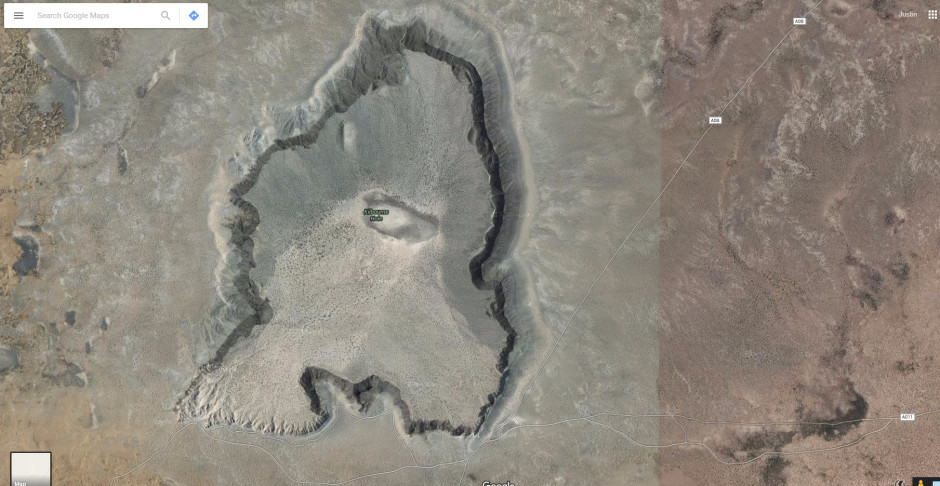
Kilbourne Hole Satellite Overview Map from Google Maps – Peridot is found all around, best places are to the North East.
One of these lava flows containing peridot, that is open to collecting, is the Kilbourne Hole, located a few dozen miles outside of El Paso Texas, in New Mexico. Just think of that, readers in El Paso, Las Cruces, Western Texas, rejoice, a site for you! For the rest of us, a long drive! Kilbourne Hole is a place where one can explore and discover gem peridot – a trip for those with a AWD or 4×4 vehicle, as this is a sandy area with poor dirt roads. The lava flows that created this area were low erupting, not like what you have in mind in terms of a tall cinder cone, but rather a very wide crater, windswept and buried under millions of tons of sand. To collect here, you can either walk around the areas where chunks of dark black basalt are laying, chipping at them to see if they have peridot inside, or work into the walls of the flow, where you can see the layer with the basalt. It doesn’t always jump out at you!
When you are looking for gem peridot, it is all about size and color. You want clean green and a size large enough to cut away at in order to make a gemstone.
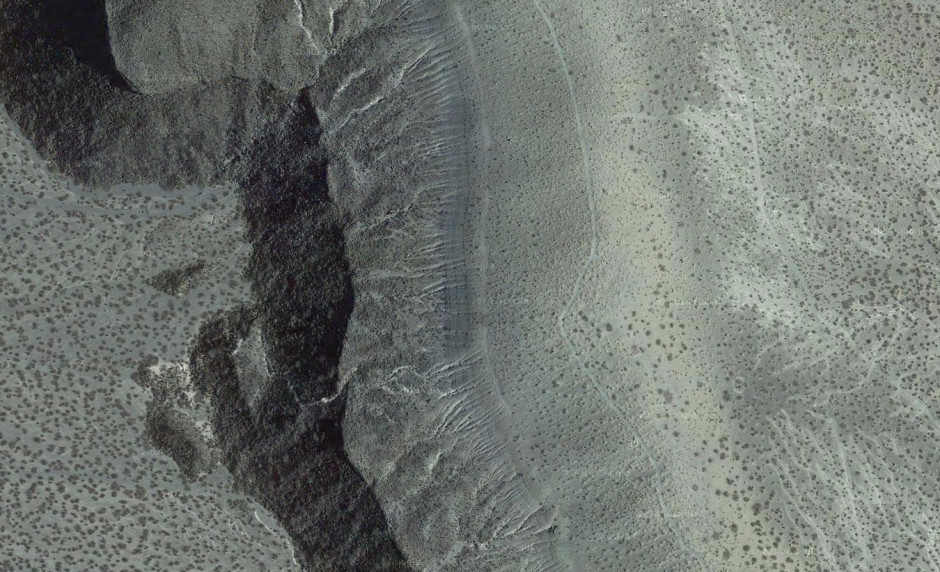
Close Up of Kilbourne Hole Rim Peridot Location East Side – Notice the two thin dirt roads going around the perimeter of the Lava Crater.
Now, if Kilbourne Hole is too far for you to go – Check out our fun Gem Hunt – Gem Rough Mining Kit!
We have 12 gem rough, including Peridot, found in every kit, which featured a brick of hard sand, just add water to the box and then search with the included tweezers through the thick sand for your gems, sort them into the included gem cups and identify them and learn about gemstone mining and identify what you found in our 16 page full color Gems 101 Booklet – Perfect for ages 5 and up, Is it good for a science minded 7 year old? Yes! It is for EVERYONE who wants to play around and find real gemstone crystals. You always get a Herkimer Diamond, a Blue Zircon, Green Peridot and much more – Buy one through this page and get a FREE Peridot Xenolith, just like the ones on this page – Until December 15th –
For $34.99 plus $8.99 shipping to USA – You get one of these high quality Gem Hunt kits, a perfect gift idea for almost all ages – Plus a Peridot “Bomb” approx 2 inches in size! Order one now, supplies are limited! Use the button below to order via PayPal or email FortySevenPress@gmail.com – re: GemHunt Peridot Order
Related posts:
Michigan’s State Stone – Fossil Coral called Petoskey Stones and YOU can find one!
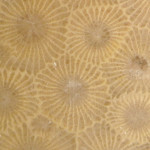
Take the Petoskey Stone. Don’t worry, hundreds of thousands of these stones have been picked up from the beaches, fields, quarries and roadsides near Michigan’s Traverse Bay. Local tourism welcomes you to take a few home with you fromTraverse City and upwards through the towns of Ames, Elk Rapids, Torch Lake, and up to Charlevoix, where many suggest visiting the beaches in order to find these stone fossils. These stone replaced corals are abundant and often take a fine polish, used for tumbling, cabbing and slabbing. The floral patterns and semi-hard, easy to polish, calcite replacement make this a stone that was sure to bring rock collectors of all walks of life to this area of the world.
This vast area of Michigan was once covered by an ocean full of corals, the Hexagonaria percarinata, among others, which at some point in time were covered up with rock, turning into vast limestone deposits with countless bits of these dead corals well preserved, from millions of years ago. Bring the glaciers into the picture and suddenly the stone corpses of these corals are spread out all over the state, wherever the glacier dragged chunks of this limestone about. People have experienced finding these Petoskey stones all over the state, however, the most popular locations for collecting are on the shores of Lake Michigan, as the frost and rain pushes and pulls the sands and gravels, revealing more each year.
This rock collecting area is all about exploring. You can find hot spots where the specimens seem to crop up everywhere, you can walk for a half mile and not see a one. Anywhere there is gravel, that is a great place to hunt. There is a world of information about these stones, so many websites, books, articles, parks, dedicated to these funky fossils. This year it was all about the 90ish pound boulder specimen pulled out of Lake Michigan. I personally saw the photo pop up on instagram, then get taken down. The state has a limit of 25 pounds collected at a time! There is a photo of President Obama with one of these stones on his desk. It is the state stone of Michigan and certainly a draw for tourism. So, I highly suggest grabbing a copy of this book, The Complete Guide to Petoskey Stones
Check out the following links below for more information on Petoskey stones and click here or on the banner below to check out Petoskey Stones available for sale on eBay.
The Petoskey Chamber of Commerce has a great website detailing information about Petoskey Stones and where they can be found and purchased, locally, in Michigan!
You can check out our friends at RockTumbler.com for information on tumbling, polishing and grinding your specimen of Petoskey Stone. That site has great information.
Here is an article about Obama’s very own pet Petoskey Stone
Here is an article about the Petoskey Stone that cause the big news in 2015.
The best thing about hunting Petoskey Stones is the beauty that is Upper Michigan. The beach views of Lake Michigan are said to be breathtaking, the landscape is full of greenery and wild flowers in the spring.
Related posts:
Montana “Diamonds” Quartz Crystals for Rockhounds!
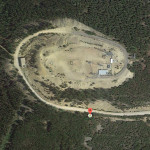
Dead center in the great wide state of Montana, a deposit of quartz crystals can be found. Typically double terminated, squat crystals with very short c-axis, these come in clear, milky and smoky and available for people of all ages to find!
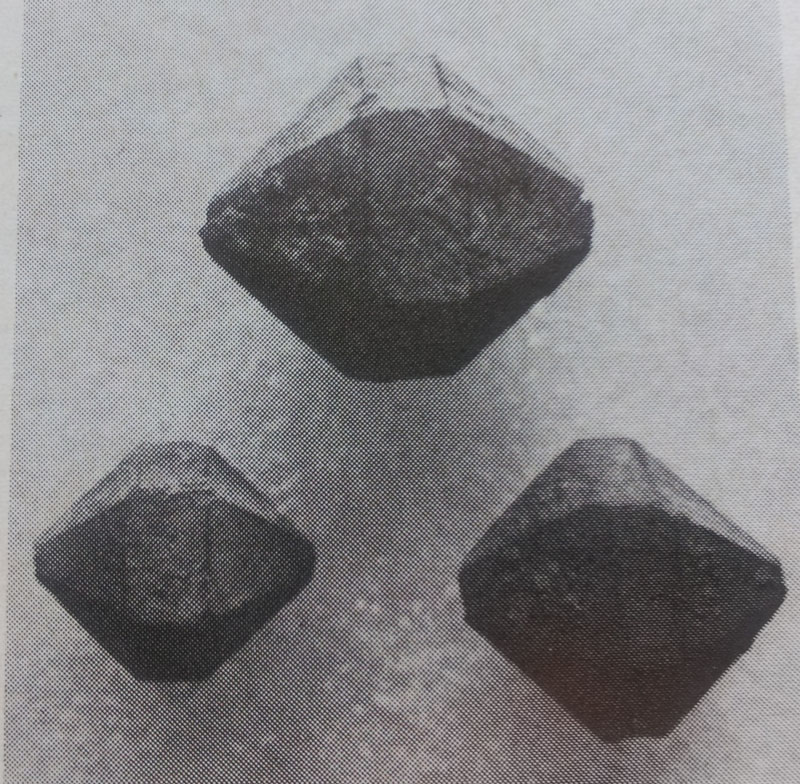
This photo was used in the October 1971 issue of Gems and Minerals Magazine. This shows how they can be confused with actual diamonds, with their form.
There are dozens of locations around the world where quartz “diamonds” are produced. You see, people want diamonds. Marketing has told us how desirable they are, how they signify love. Just wait until the November through March, non-stop jewelry store commercials pushing whatever diamond scheme they have this year on everyone. In 2014 it was those terrible “chocolate diamonds” which are one step above industrial grade. The truth is, there are way more diamonds in the world than there will ever be a need for, so it is an artificial market kept afloat by you and me. With that in mind, a random that has very little knowledge about minerals can pick up a double terminated, squat quartz crystal and think “DIAMOND!”. This gives the name to so many deposits. Cape May New Jersey Diamonds, Herkimer New York Diamonds, Montana Diamonds, Pecos New Mexico Diamonds, Pakistan Diamonds, Tibetan Diamonds…all…quartz. Well, everyone loves quartz crystals, so hey, even if someone was disappointed that they didn’t find diamonds, us rockhounds are happy with what they found!
Montana Diamonds are found about 20 miles from the town of Lewistown Montana, nearly smack dab in the middle of Montana. On the top of Judith Peak, an open area for collecting with hand tools, an abandoned radar installation is located. All of the road construction and removal of trees and overburden for the buildings has uncovered ample ground for searching and rockhounding. At an elevation of 6,386 feet above sea level, an igneous deposit of rhyolite has been pushed up to the surface. The rhyolite cools at different rates, the slowly cooling rock giving more time for the quartz crystals to grow larger. This deposit hit the right notes, leaving a layer of rhyolite that contains these well formed crystals.
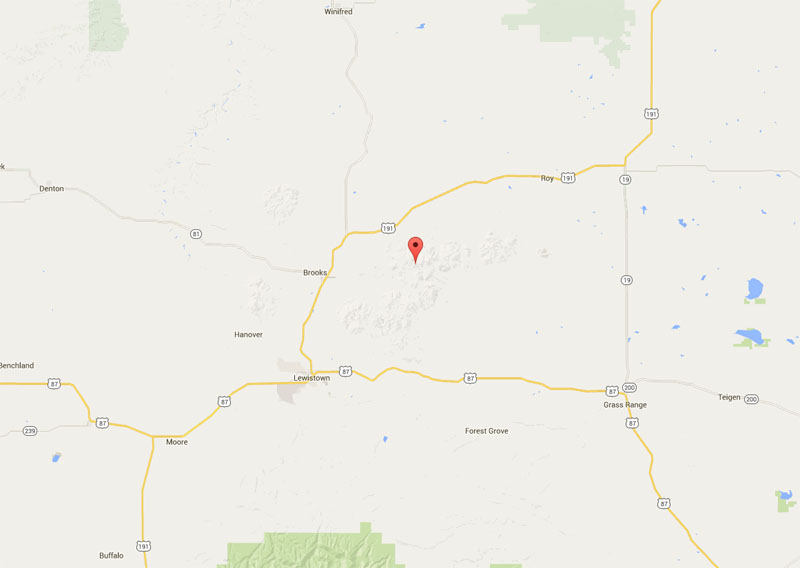
The Judith Mountains are located in Central Montana. Judith Peak is about 20 miles outside of Lewistown.
In the USGS publication Geology and Mineral Resources of the Judith Mountains of Montana By Walter Harvey Weed, Louis Valentine Pirsson it is written about this area in 1898! (This book can be downloaded as a PDF by clicking this link)
Judith Peak itself is composed of quartz-bearing porphyry…The small, angular light colored flakes compose the crest and slopes. Pine trees grow thickly upon it, and in places they have been burned and the porphyry has been reddened or blackened by the fire.
On the north side of the slopes fall away into several steeply descending, half-funnel gulches. The angles of slope of the broken porphyry is extremely steep, and the gulches have almost the aspect of amphitheaters. Farther down the blocks of the broken porphyry naturally becomes larger.
Almost at the summit of Judith Peak, a few hundred yards north-west, the porphyry appears crushed and filled with narrow quartz seams, which are stated to carry low values in gold. Southward from here, although the porphyry is greatly rotted and broken down, it can be seen that there is a gradual increase in the number and size of the quartz phenocrysts until,…these quartzes assume a large size, the phenocrysts being often an inch or more long. The quartz crystals weather out as pebbles, and very perfect specimens may be obtained

In this photo from the 1971 October issue of Gems and Minerals, you can see a collector searching for quartz crystals in the rhyolite.
Well over 100 years of collecting quartz from this location and yet…there is still more to be found! So, if you find yourself in Montana, right about dead center, you’ll be close to some fantastic quartz collecting!
Related posts:
Collecting Rare Earth Element containing Minerals near Mountain Pass, between Las Vegas and Los Angeles
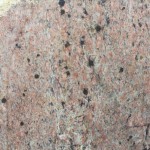
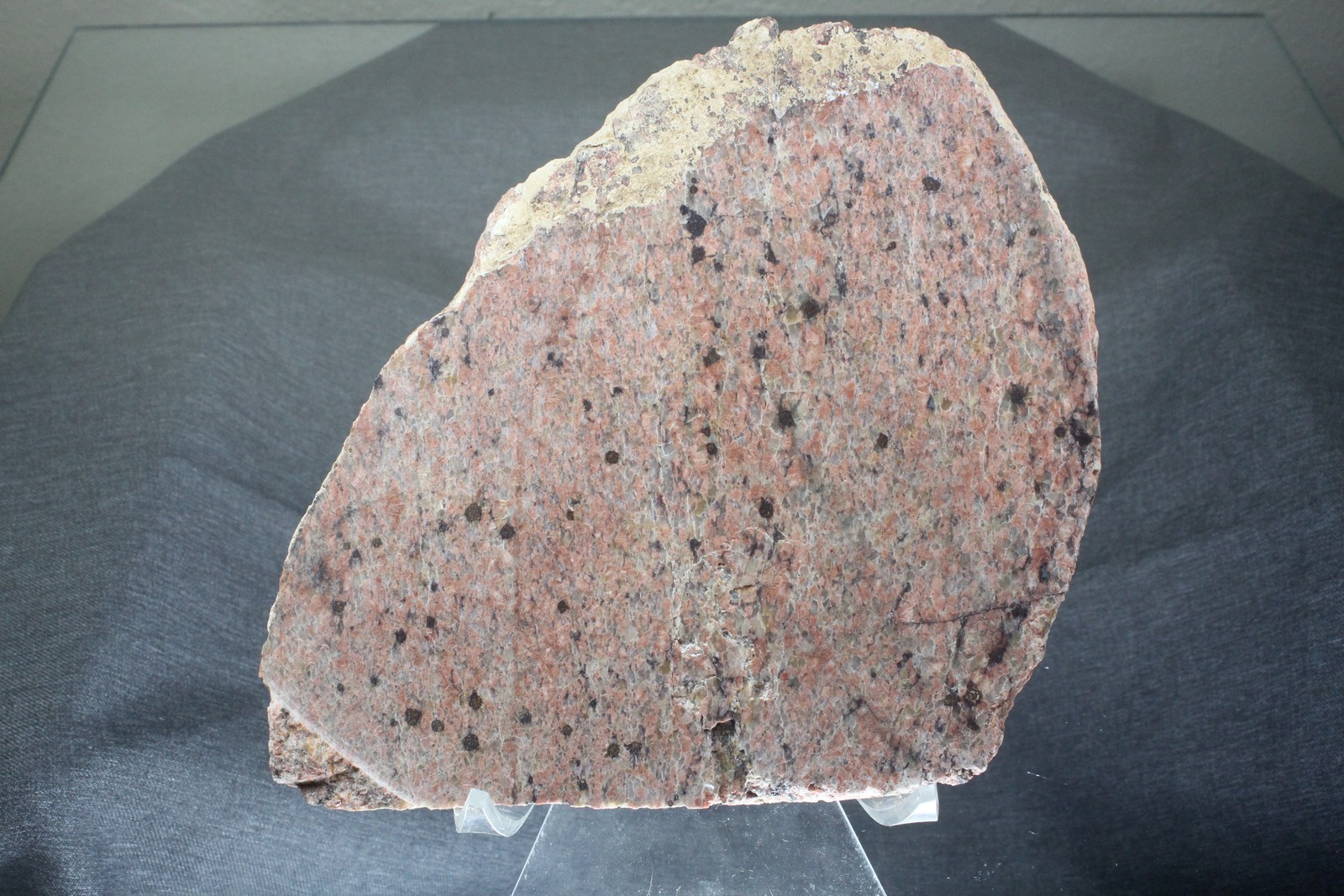
Mountain Pass is a famous mineral deposit that is found between Baker California and Las Vegas, immediately off the sides of highway 15, making access to the huge deposits of rare earth elements absurdly easy.
However, easy as the deposits are to get to, please don’t think of giant sparkling crystals…or even dull, earthy, single crystals. The diverse mixture of minerals found in the Mountain Pass district occur as frozen crystals in a barite-carbonate deposit. That means, these are just…rocks. Or, rather, solid chunks of minerals, requiring some lapidary work to enjoy the wonderful mineralogy found in this interesting deposit.
The history of the Mountain Pass district is quite interesting, from the original prospecting for silver, gold and sulphides, to the uranium boom in the 1950’s, when it was discovered that much of the belt of rolling hills north and south of the Sulphide Queen mine, which is right on the side of what is now highway 15, contained large amounts of radioactive rocks. While there was no uranium, the rocks are rich in heavy elements of cesium, lanthium, europium and neodymium. Mineralogically, we find a host rock of barium, dolomite and calcite that can have various mixtures of mica, apatite, bastensite, zircon and more. Take a peak at these microscopic drawings of thin slices of rock from Mountain Pass, as found in the USGS report HERE http://pubs.usgs.gov/pp/0261/report.pdf
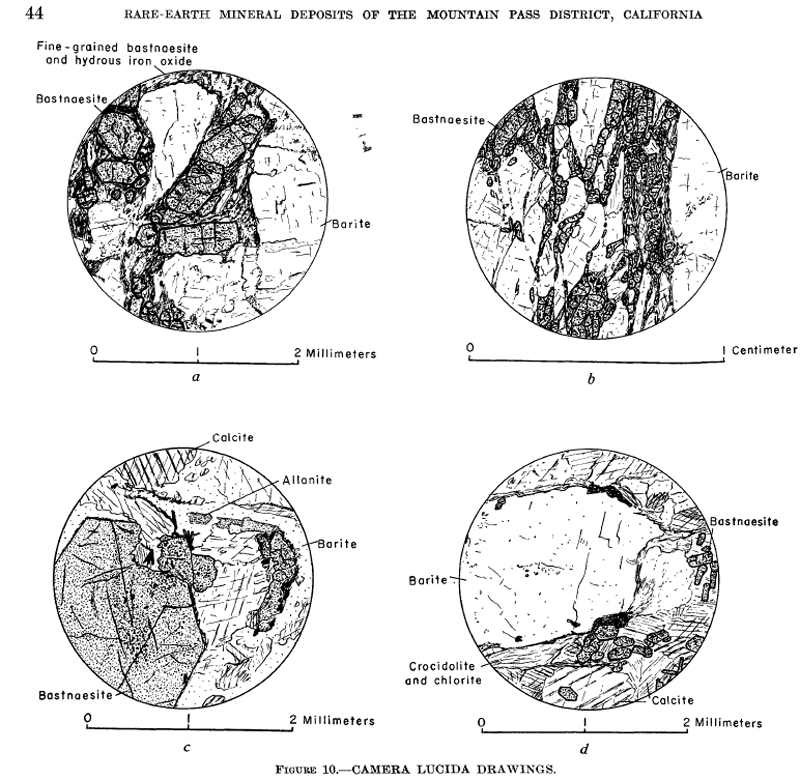
If you want to read more about the deposit, we suggest these links for more information as to the current production of ore at the only operating REE mine in the USA.
https://en.wikipedia.org/wiki/Mountain_Pass_rare_earth_mine
https://www.hcn.org/issues/47.11/why-rare-earth-mining-in-the-west-is-a-bust
http://www.cbsnews.com/news/rare-earth-elements-not-so-rare-after-all/
This is not TellMeAboutMineralDepositHistory.com, this is WhereToFindRocks.com! So, let me tell you how to add a specimen or two of this interesting mineral deposit to your collection!
We can start with MRDS, one of our favorite websites and a prospecting field collector’s best friend. This site lists a vast majority of all claims made for mineral deposits and lays them out in a way that makes prospecting readily accessible to everyone.
We start out by getting close to the area we want to review, in this case, the Mountain Pass district.
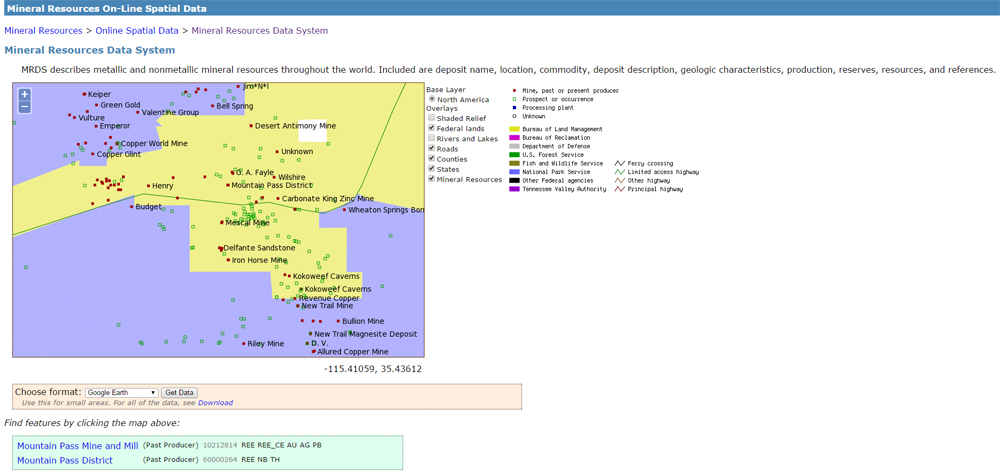
Once we have this area outlined, we can request the data, using the button below the map. Personally, I enjoy using it with Google Earth and I will show you how that is done.
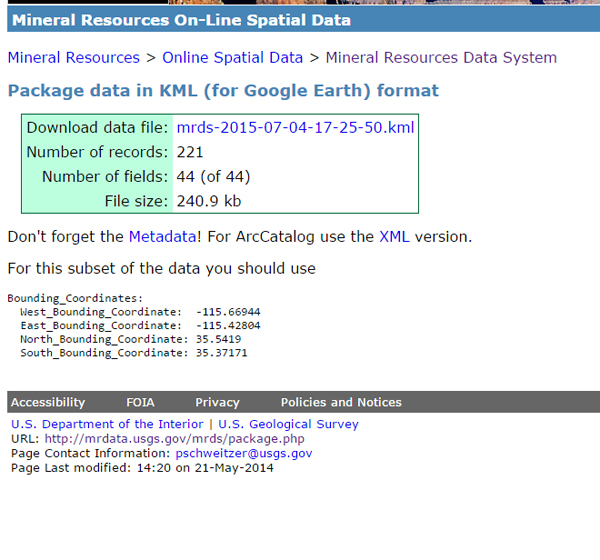
By selecting the google earth data output, we are given a page that shows a downloadable link to the data. Clicking the blue link and saving that file will give you a .kml file. If you have Google Earth installed, you simply need to double click this file and google earth will open up, showcasing the X’s and crossed hammers of mine sites as shown on the MRDS map.
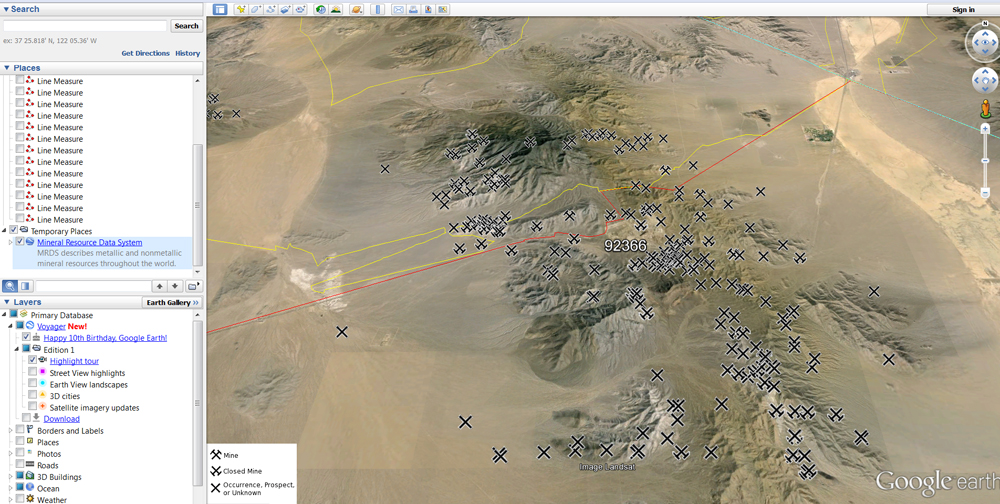
From here we can move into the map and start looking at the landscape surrounding the deposit. We can see the Mountain Pass Molybdocorp mining area to the north of highway 15, in addition to that, there are an abundance of X’s South of highway 15.
Clicking on the X’s we can see the prospects, both inactive and active, for REE-Barium, scattered all over the hillside. You can clearly see the outline of the deposit from the borders of the prospects and note that many of these prospects are on the brown/tan outcrops along the mountainside. One simply needs to exit on Baily road and turn South. Several outcrops are readily available immediately off the road with minimal hiking.
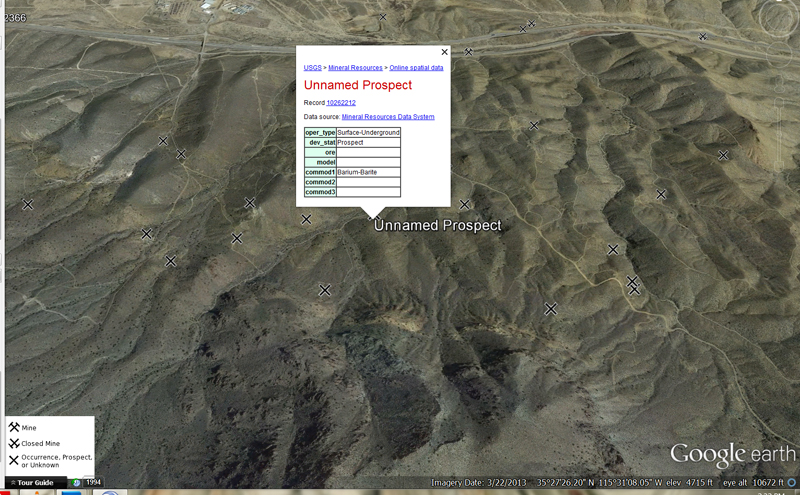
There are so many deposits along these well graded dirt roads, one could investigate them all day…or, simply stop here and stretch your legs on a trip from Los Angeles to Las Vegas and pick up a piece of this interesting material.
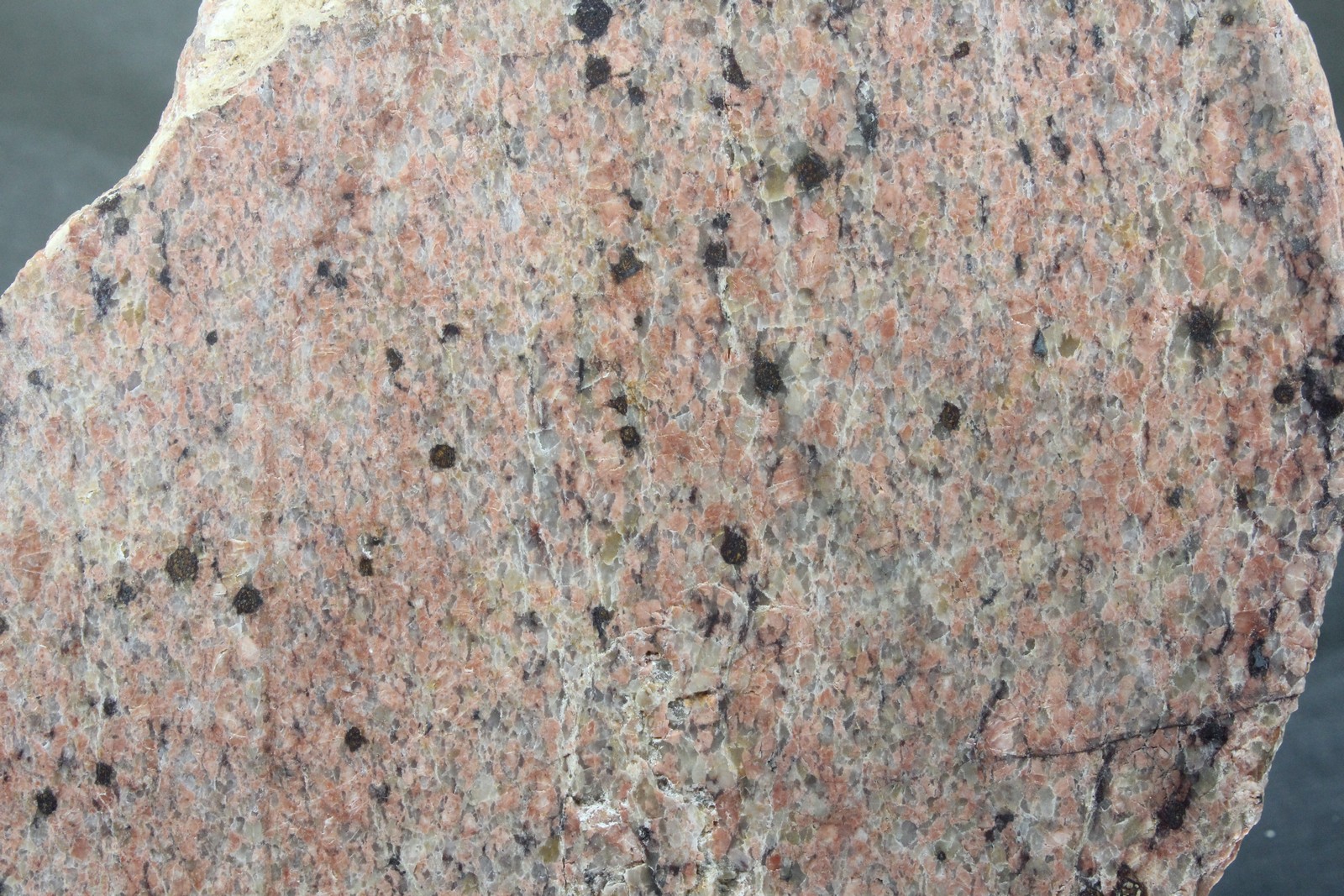
Close up view of a slabbed specimen of carbonate-barite REE mineralization from the Mountain Pass District.
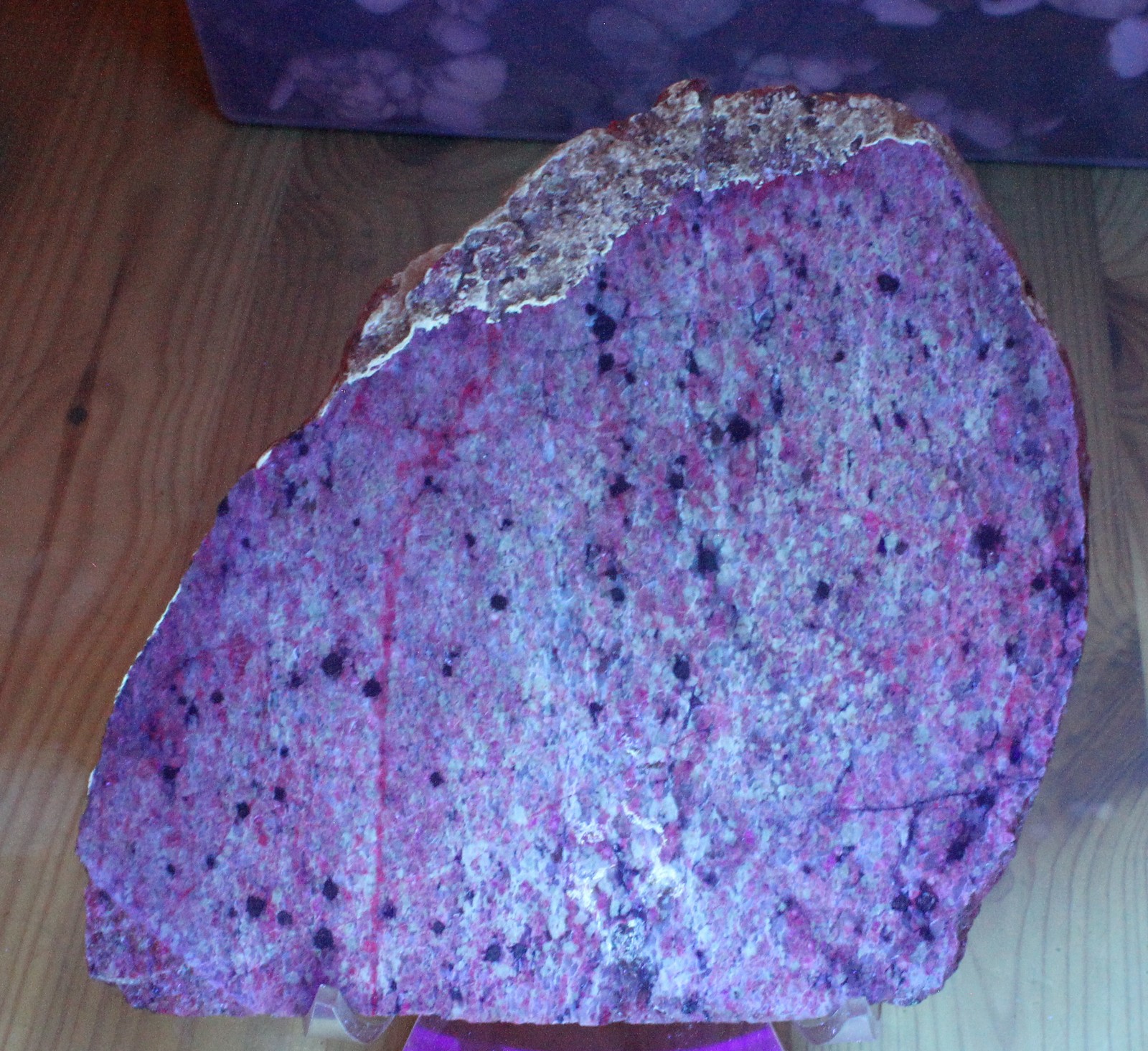
This photo was taken with a 18 watt Short-Wave UV light, showcasing the carbonate content reaction.
Related posts:
Some kids grow up to become mineral dealers, some grow up to become geologists – Two views
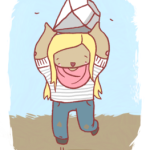
Two articles online brought an interesting slice of life to kids with rocks and minerals in their pockets and in their minds. Lots of children become interested in rocks and minerals, like any other popular natural science, kids all over have the thoughts of becoming a geologist. Fewer kids have the thoughts of becoming professional dealers of minerals, rocks and fossils. These two articles give a look into two different types of kids, one who became a very successful mineral dealer and another who became a professional geologist.
Rosie Cima did a wonderful write up about mineral dealer Robert Lavinsky, or, Dr. Lavinsky, as we find out in the article found on the Priceonomics website, The Very Model of a Modern Mineral Dealer. In this article we get a picture of Robert Lavinsky, owner of The Arkenstone, from boyhood facination with rocks and minerals, into college, selling minerals became a main focus of his life, trumping his doctorate degree in Molecular Genetics.
This is the type of kid who is mixed with a passion for sales and an equal passion for collecting. Like this bit from the article shows
At some point during the interview, when asked why the market has grown as rapidly as it has, he attributes a lot of it to people realizing that they could own minerals in the first place. Because who wouldn’t want to?
“I can have these amazing, beautiful objects that are tens of millions of years old in my house!” he shouts. He certainly does.
On the other hand, we have children who don’t have the same drive for sales. With those kids with rocks in their pockets we have this great guest blog on the AGU blogosphere, this writer, Evelyn Mervine, on her Georneys site, had her mother submit a guest article on what it was like to grow up nurturing a future geologist.
Barbara Mervine has a great viewpoint on raising a young geologist, as you can see in this quote.
Geologists are often born, not made. Shortly after birth, the parents of a born geologist notice something different about their child. Some parents try to interest their young child in other subjects, such as birds or stamp collecting. However, it is best to just give up and accept that your child is different.
Barbara has several words of wisdom, what to expect when raising a future geologist, like this one…
The parent of the geologist dreads the day that the child becomes a teenager and begins learning to drive. That is because now the child’s habit of looking for rocks while in the car becomes looking for rocks while driving a car. Rock cuts on highways are a danger that all parents of geologists should be aware of. For example, Evelyn was once traveling with a group of geologists from MIT when they stopped the van along the side of a major highway. All the geologists piled out to go look at a rock cut. The police man who gave them tickets for illegal stopping on a highway was not impressed with their excuse that millions of years of history was revealed right there before his eyes. He pointed out that hundreds of cars were right there going by at high speeds. Obviously, the police man did not have a brother or sister who was a born geologist.
Both articles are well worth checking out
Rosie Cima’s Priceonomics article The Very Model of a Modern Mineral Dealer —> http://priceonomics.com/the-very-model-of-a-modern-mineral-dealer
Barbara Mervine’s Guest Post on Georneys Blog for AGU The Care and Feeding of a Geologist —> http://blogs.agu.org/georneys/2011/10/12/the-care-and-feeding-of-a-geologist-a-guest-post-by-barbara-mervine/
Related posts:
Collecting Zeolites around Marysvale, Utah
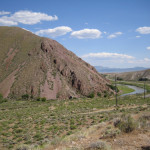
The noon sun hung in the sky with a dull yet irritating heat. It was early Spring, and I was traveling to a place nobody had any reason to be, an empty valley in Central Utah. I grabbed the canteen swaying from my hip, took a hearty swig, and wiped the small beads of sweat slowly forming on my brow. The dry earth crunched with each trod of my heel, one after another like a rhythmic drum, each thud forming a slow monotonous beat.
I took in my surroundings. At surface level there was not much to see, canyon walls and plateaus, little wildlife, and less trees. What little vegetation was found here often amounted to sagebrush. It peppered the dirt in various shades of chartreuse, flowing lightly with the siblant hissing of the wind. I was two miles south of Marysvale, Utah, a small town with less than five hundred residents. On this particular expedition, I was alone.
The area I was headed to was the now abandoned Elbow Ranch. On my shoulders slung a backpack stuffed lightly with supplies: a fold up shovel, a pair of gloves, a chisel, a spray bottle of water, a rag, the morning newspaper, a loupe, and a geologists hammer. I also made sure to leave some empty space for any of the various specimens I hoped to collect.
I’d spent the earlier half of the day in the Durkee Creek area. Durkee Creek was much easier to reach than the hike to Dry Canyon had to offer. Most Rockhounds with already impressive collections probably wouldn’t have bothered spending the time there. The red-brown earth of Durkee Creek offered an abundance of zeolite, but they were often small specimens that didn’t equivocate to the effort involved.
It wasn’t until one o’clock that I found an area that had seemingly been untouched. I unfolded the shovel, wedged it between the cracked earth, and began digging. With each downward stroke I hope for the sound of metal scraping rock. It was four feet down where I found it: mordenite, an orangeish pink rock like rusted iron. With my chisel and rock hammer I chipped at the rock, a tedious process requiring delicate precision. When I’ve made enough of the outline I wedge the pick in and remove the specimen like a loose brick.
A quick spray from the bottle and a wipe of the rag gave the rock a quick polish. The mordenite was about half a centimeter thick, forming a crust for the interior of crystalized white quartz. I held it over head where the light could reach, twisting it in hand, watching it blink and shimmer in the afternoon sun. I recall thinking a familiar thought, an image of this same area long ago. A memory strung together from vague recollections of scientific studies and my own personal imagination. It was a hostile world, fiery and volcanic, but one small pocket of that world had been preserved. A fracture of time lying dormat, imprisoned and pressurized for thousands of years, found by me after a series of seemingly coincidental happenstances.
I tore a page from the classified section of the day’s paper and wrapped the mordenite with care, then I climbed my way out of the hole. The sun stood due west, glaring. My wrist watch read 4:00 pm. In Marysvale Utah many of the residents are returning from work, preparing for dinner and the days end. I grab the canteen, and wipe my brow. Then I gather my gear and continue on. I’ve yet to try my luck at the Blackbird Mine.
by Various Authors
The Must Have, if nothing else than to have an IDEA about the collecting spots in your state, the gem trails books are a wealth of information at a low price. The perfect beginner guides that are refrenced by serious field collectors! Click on the book covers to view them on Amazon, or search the eBay link below.
Related posts:
How to prepare your 4×4 for rock collecting – Rockhounding Preparedness Series
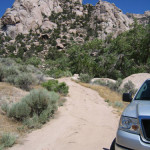
How to prepare your 4×4 for rock collecting.
Rock collecting may be a popular, family oriented activity, but how often do you think of the safety of your family first when you go off the beaten track to hunt for that one, perfect example of a billion-year-old rock? How often have you heard of people being stranded without food and water for days, just because the driver did not check his vehicle before leaving home? Don’t let this happen to you and yours! Simply follow the few easy-to-follow tips listed here to reduce the possibility of vehicle breakdowns when you could be hundreds of miles away from the nearest repair shop.
Check radiator hoses.
This might appear to be self evident, but according to the AAA, engine overheating is the leading cause of vehicle breakdowns in America. Radiator hoses must be firm to the touch, and free of oil, and even oil residue. Oil degrades the rubber of radiator hoses, which makes it imperative that oil contaminated hoses be replaced before your next trip.
Check all V-, and other drive belts.
You may think your belts are OK, but the most damage occurs when the pieces of a broken drive belt work themselves in under the other drive belts. This can cause all your belts to jump their pulleys, and because of their high rotational speed, the flying pieces can destroy the radiator, the battery, the radiator fan, and critically important wiring. When in doubt, don’t procrastinate, replace all the belts, and observe the proper tensions on all.
Check the charge rate.
The proper rate of charge on 12 V vehicles is 14.2 – 14.6 Volt. Anything above or below this value is indicative of a faulty alternator, or maybe worse, damage to wiring in places where you cannot repair it in the wilderness, so fix it now, while you can.
Check battery condition.
Don’t just look at the outside, and maybe clean off acid accumulations. A battery needs to be able to deliver specific currents at certain times, such as during starting. Have an authorized battery dealer perform a draw test, to determine the ability of the battery to deliver sufficient starting current. Also, compare the specific gravity of the electrolyte in each cell against the specs for your battery. Differences of one or two percent are normal, but differences or deviations that approach 5% are not, and you should replace the battery.
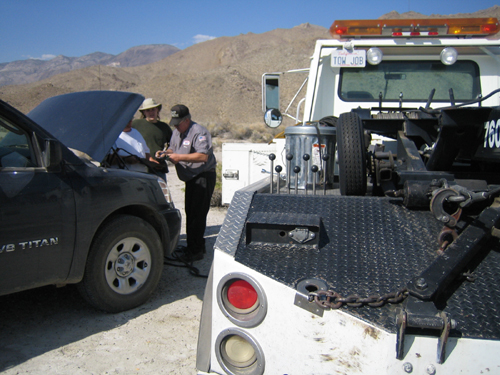
You don’t even want to THINK about how much it costs to get a jump start in the desert, 80 miles from nowhere.
Check the suspension.
Check the suspension and steering systems for excessive free play between related components such as ball joints, tie rod ends, steering dampers, draglinks and control arms. You may think that since the tie rod ends have been a little loose for the last two years, they are OK because they have not pulled from their sockets yet, but off-road driving places extreme loads on a vehicle, and the last thing you want to happen is to lose your steering while going down a steep, rocky hillside. Think of your family, and replace all worn components before you leave home.
Check the brake system.
Check the entire system for signs of leaks, and do NOT forget to check the slave cylinders inside the brake drums. These cylinders can lose up to 60% of their effectiveness before they even start to show signs of leaking, which means you could be driving around with less than 50% of your braking capacity. Moreover, if you had been topping the brake fluid reservoir regularly, but cannot see a leak, remove the master cylinder from the brake booster to check if the brake fluid is not leaking into the booster. If this is the case, replace the entire master cylinder because you can never be sure the rubber seal kits available today will not fail you when you need them most; such as when you are going down a steep, very narrow mountain pass, with a 1000-foot drop off, and no safety barrier.
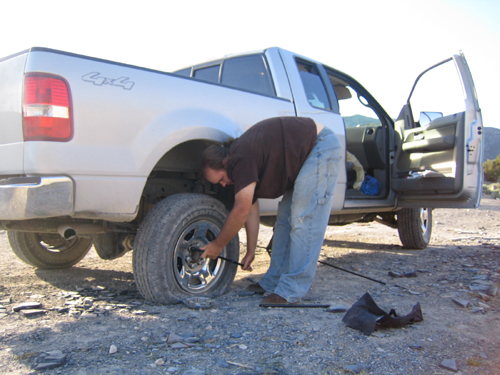
Better safe than sorry.
Performing basic vehicle maintenance procedures before heading into the wilderness is not a hassle: it is a vital precaution against being marooned hundreds of miles from the nearest repair facilities. It is also great way to prevent potentially fatal accidents caused by parts that failed because they should have been replaced months ago, but was not. Think of the safety of your family, if not your own, get your vehicle into great shape, and enjoy the rock hunting, which is what you go into the wilderness for, right? Only make sure that by taking care of your vehicle, you can safely make it out again!
Related posts:
Writing an Article – Sharing a Location – For WhereToFindRocks.com
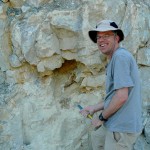
WhereToFindRocks.com was made to share public collecting locations, taking away the mystery of rockhounding and inviting more participants to our hobby. Several individuals have produced articles for WhereToFindRocks.com and we always welcome more submissions! We can never have too many!
Just in case you think this is merely an altruistic cry for submissions, let me inform you, submitting an article to WhereToFindRocks.com can be very beneficial!
If you submit an article, you are allowed to have a linked banner at the top and bottom of your article. If you have a rockshop/show/club to promote, you can work that into your article. For example, a great regional show trip often includes a rockhounding trip. Promote your show or local rock shop with a field trip article. Write an article to promote your local rock club and a field trip you have gone on with the club.
We only ask that you follow our main rule…
Any location published on WhereToFindRocks.com must be available to the public via open access given by the owner or government or a pay to visit location. While access to locations changes all the time, we strive to showcase locations that are open to the general public.
We ask that you submit articles between 500 and 2000 words long. You need to include a few photos of the area, material that comes out of the area and pinpoint the location on a map. We ask for at least 6 photos. You may also include a banner, no larger than 600 pixels wide, which can link to your website.
Here are some examples
Pocket photos help to set the mood – any sort of photos with the digging are super

Photos of people at the location, always timeless!
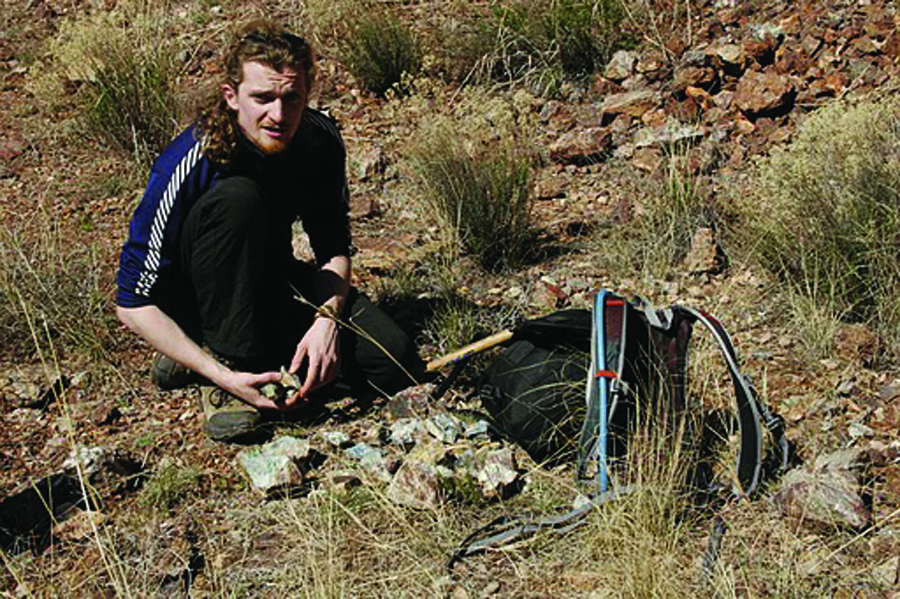
Photos of people collecting, or rockhounding
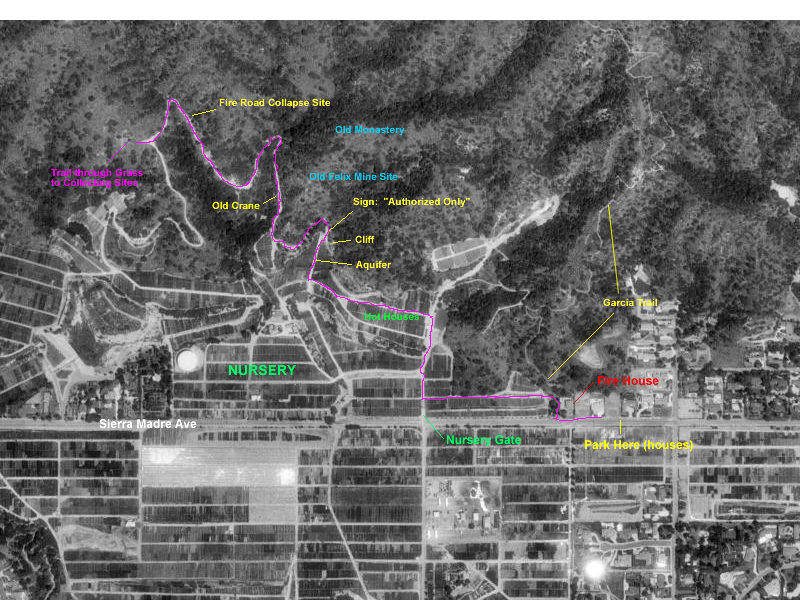
We like to create interactive google maps, if you give us whatever map you have, we can make a google map out of it.
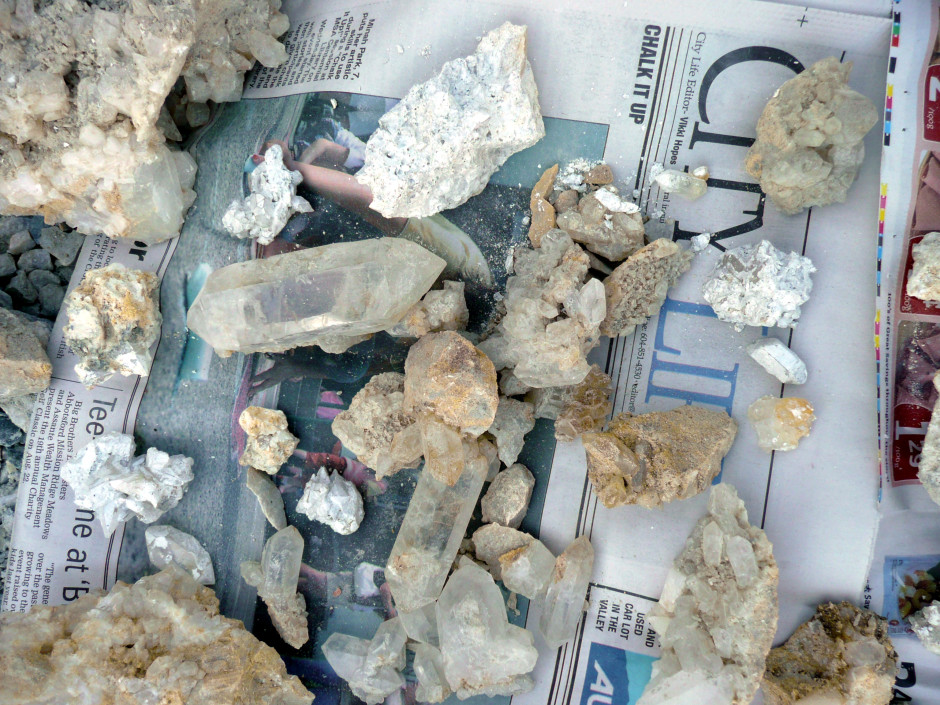
And show us what you could expect to find on a day collecting, if you work hard!
E-mail us directly at
FortySevenPress@gmail.com
to submit your rockhounding article for
WhereToFindRocks.com
Top 10 International Mineral and Gem Crystal Shows

Top 10 International Mineral Shows
By Jeremy Zolan
The newest finds and choicest mineral specimens are always the hottest items at the world’s biggest mineral shows. The most popular mineral shows are those that allow both businesses and the public the best and most exclusive specimens at the most competitive prices. Displays and activities also make shows notable. Many museums take the privilege to display extraordinary specimens rarely seen by others aside from the curators if they fit with the theme of the show, which many but not all shows have. Here is a selection of ten shows that currently attract the most notable attention, of course, as with all things in this world, in a few years, some of these shows might have ceased to be and new events will rise up.
#1 Tucson Mineral and Gem Shows- Tucson, Arizona, USA
One of the largest shows in the world, The Tucson Mineral and Gem Shows are held for about a month, starting in late January and running until mid-February. The environment is exciting and busy, perhaps overwhelming for some. At the main show at the end of the events, Vendors are typically larger, more established dealers selling mostly mineral specimens, but a few sell fossils or lapidary material as well. The displays at the show are very well known for highlighting extremely fine specimens with exciting themes. 2014’s main show theme was Diamonds and Gold. One of the greatest mineral show displays in history was featured at the 2008 Tucson Mineral and Gem show- the American Mineral Treasures exhibit. This show united many of the US’ finest native specimens in the same display cases.
Here is an ad for ONE of the shows, the Tucson Gem and Rock Crystal Show!
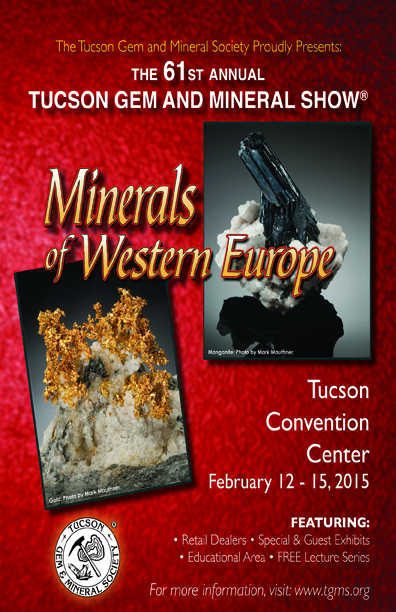
#2 Denver Gem and Mineral Show- Denver, Colorado, USA
The majority of the largest and most popular mineral shows in the US are held in the Southwest. The Denver Gem and Mineral Show certainly fits that category. This show is very similar to the TGMS show and is also themed. The 2014 show’s theme was be agate. It generally attracts a very similar crowd of dealers as well. The displays are especially famous- many of the world’s famous mineral museums and greatest private collectors put in mouth watering specimens.
The-Vug tours the Denver Mineral Show

Official site: http://www.denvermineralshow.com/
#3 Sainte-Marie-aux-Mines show, France
Outdoor mineral shows are always a great time, especially if they are held in an ancient mining town like the Sainte-Marie-aux-Mines Show! The gorgeous scenery and rich history of the French countryside setting make this perhaps the world’s most scenic major mineral show. It is one of the premier mineral events in Europe as well and has thousands of visitors. Last year was the 50th anniversary of the show. Check out this show from Thursday through the last weekend in June if you’d like to attend a superb European event!

Official site: http://www.sainte-marie-mineral.com/an_index.php
#4 Munich Mineraltage – Munich, Germany
This show takes place right around Halloween, late October, first days of November, typically. The show is located in three huge halls, which are formerly airplane hangers! The whole Trade Fair Center is the old Munich airport, converted into a giant convention center. The show has over 1,000 dealers from all over the world, separated into areas for mineral dealers, lapidary, fossils, crystal healing, and all sorts of other fun niches. Each year the show has a theme and the exhibits are never short of amazing. The show is run by the Keilmann family and you can see them breezing by on their scooters from hall to hall, ensuring that the show runs like clockwork.

Official site: https://munichshow.com/en/
#5 Tokyo International Mineral Fair- Tokyo, Japan
First held in 1988, the Tokyo International Mineral Fair is the largest and oldest mineral show in Asia. This show is focused on compact and high end booths geared towards a retail rather than wholesale audience. Rare and systematic mineral dealers are fairly numerous at the show due to the higher than average national interest in systematic mineral collecting. This is a good show to go to for those who are looking for unusual or specialized material. Japan also has many mineral localities that have produced wonderful specimens that are rarely if ever seen in the west. This is a great event to look at or purchase unique local Japanese material. The next show is being held on December 6th through 9th in 2014.
![]()
Official Website: http://www.tokyomineralshow.com/english/
#6 Rockhound Gemboree- Bancroft, Ontario, Canada
Every summer during the first weekend in August, Canada’s largest show is held in the nation’s heartland of mineral collecting. Bancroft is widely referred to as “Canada’s Mineral Capital” for having an abundance of abandoned mines and other mineral collecting localities open to the general public. This mineral show usually has an excellent selection of local material and esoteric specimens. It often attracts smaller dealers as well as major Canadian dealers. Swapping specimens is also encouraged at this show. Visitors looking for a fun outing in nature should consider mineral collecting in the region. Ask local museums or dealers what their recommendations are based on your experience. Many different kinds of minerals can be found like apatite, sodalite, rose quartz, and fluorescents.

Official site: http://rockhoundgemboree.ca/
#7 Quartzsite Gem and Mineral Shows- Quartzsite, Arizona, USA
This event has been an agate licker’s paradise for nearly 50 years. This unique series of mineral shows is held outside and dealers often sell specimens out of their RVs. Quartzsite offers a total of nine show locations with events being held from mid January to late February. These events are great for bartering or swapping of all kinds so bring plenty of trading material if you plan on going! While you are in Arizona for this event, you also may want to check out the many world famous mineral and gem shows in Tucson which happen at the same time.

Website: http://xpopress.com/QZ-show-schedule.html
#8 NY/NJ Mineral Fossil, Gem, and Jewelry Show- Edison, New Jersey, USA
The NY/NJ is the newest out of all the shows in this list but is a true up-and-comer. It is held yearly in Edison, NJ during mid-April and over 300 dealers attend making it the largest current mineral show held in the NYC metro area. There is something for everyone at this show and dealers selling material ranging from very inexpensive to the finest quality are present. Many dealers also have a small selection of locally dugs specimens too. Though the focus is mostly on minerals and fossils, jewelry and lapidary materials are sold in abundance too. The displays at this new show have big hits. They have featured wonderful classic East Coast specimens that have both been dug recently or are of historic importance.
Official Website: http://www.ny-nj-gemshow.com/
#9 Houston Fine Mineral Show- Houston, Texas, USA
The Houston Fine Mineral Show is one of the few major mineral shows that is free to the public to attend. Texas is home to many of the US’ finest recently assembled collections and their collectors, which means the displays at this event are typically some of the best that can be imagined. Dealers at this show typically specialize in fine minerals, meaning their specimens are of very high quality but are often quite expensive. Many of the world’s most advanced collectors visit this show and it serves as an important place for them to meet as well as purchase specimens.

Official Website: http://www.westwardminerals.com/finemineralshow/pages/houston.html
#10 Changsha Mineral and Gem Show – Changsha, Hunan Province, China
China has been cranking out plenty of new specimens over the past two decades so it should not be surprising that mineral collecting is getting extremely popular in this country. This is a new phenomenon; mineral specimen collecting culture is fairly new to China in comparison to other nations. Hunan province, where Changsha is located is home to many mineral specimen producing mines that are currently being worked. This mineral show is very large and growing quickly. It attracts international dealers and may soon become the largest mineral show in Asia. The 2014 show is being held May 15th through 20th.

Official site: http://www.changsha-show.com/html/en_index/
Related posts:
Jewelry Making – Tips and Techniques covered in two new books
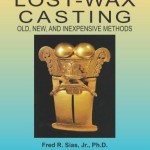
Over the past two months, I have given several lectures on both coasts of the United States, and during that time, had a chance to investigate two books by the authors.
Brad Smith, one of my early mentors in the Culver City Gem and Mineral Club, published a book called “Bench Tips for Jewelry Making”. One of the things about Brad is for a time he could not make it to many of the meetings as he was busy teaching jewelry making at LAUSD in Santa Monica. I did not know what to expect out of this book, so it was surprising to find out that it is, basically, my favorite kind of book for technical information. Full of short tips covering a wide variety of jewelry making, so much I was inquisitive about, so much that is not just for jewelry makers! Using Alum to remove a broken drill bit might be helpful to jewelry makers, but putting that idea in my head about removing broken bits of metal from non-metallic items, using Alum, was something I did not take home from science class 20 years ago. I’m going to keep it next to my copy of Gem and Mineral Data Book by John Sinkankas, both books, full of great tips!
While serving as the guest speaker for the Eastern Federation of Mineralogical Societies twice yearly Wild Acres Retreat I had the opportunity to visit with the classes and instructors. During this beautiful mountain retreat, classes in different lapidary and metal working are offered. I took a class on Geology, while others learned soapstone carving, wire wrapping, gem faceting and my roommate was very excited to take a class on Lost Wax Casting. He planned on making a setting for a beautiful gem yellow idaho opal. When I went to check on him, four days later, he confessed, this was not something you could just JUMP into and showed off his much simpler designs, sans opal. That class visit was fun, the instructor, Fred R. Sias Jr. took the time to run me through all the basic steps of casting in a couple minutes. Looking at the projects the class was working on, I can see this is not something you can do repeatedly, well, without some practice and experience. Fred has a book, which I can highly recommend, that speaks about the methods of wax casting, providing an amazing overview for someone who has never been introduced to this ancient art. For those who are already wax casting this might not provide a lot of new content, Ashanti casting might be something you have not been taught, and Fred Sias does a great job of illustrating this primitive technique.
Related posts:
Field Trip: Midwestern Geode Localities
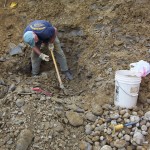
By: Jeremy Zolan
Difficulty Level: Easy to Medium
Supplies Needed:
Safety Goggles
Water
Insect Repellant
Shovel
Crack Hammer and Chisel
Paper for Wrapping Specimens
Bucket
Prybar (Optional)
Pick Axe (Optional)
Wheeler-Rex 590 Soil Pipe Cutter (Optional)
Description:
View a map of the locations of these geodes by visiting MinDat.org’s copy of this map
Click Here to Load Map
Geodes in the Warsaw formation of Iowa, Missouri, and Illinois. Each ‘x’ is a geode location. Originally from Arthur E. Smith (1997): Geodes from the Warsaw Formation of Missouri, Iowa, and Illinois, Rocks & Minerals, 72:6, 420-423. Updated and colorized by William W. Besse.
Many sites in the tri-state area of southeast Iowa, northeast Missouri and western Illinois produce geodes of world class quality. In fact, nowhere else in the world is richer in geodes than this strange area of the Midwest, where the Mississippian geode bearing Warsaw limestone formation is exposed near the surface. The geodes can reach 20cm across or larger and are mostly lined with quartz crystals though a variety of minerals like calcite, dolomite, sphalerite, and even millerite have been found in geodes. Geodes can be found wherever the Warsaw formation can be found outcropping. They can also be dug from riverbanks. Many fee dig sites for geodes are found in the areas of Iowa, Missouri, and Illinois rich in geodes.
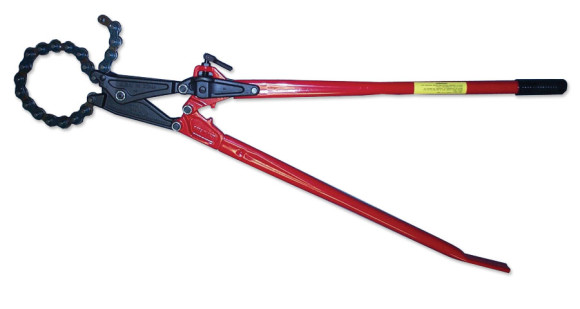
A pipe cutter, specifically the model above (Wheeler-Rex 590 Soil Pipe Cutter) is great for opening geodes. Simply score the geode around the perimeter lightly with a hammer and chisel, clamp the cutter around the perimeter of the geode, and then carefully apply pressure until the geode splits. It is most desirable to split geodes into two equal sized hemispheres.
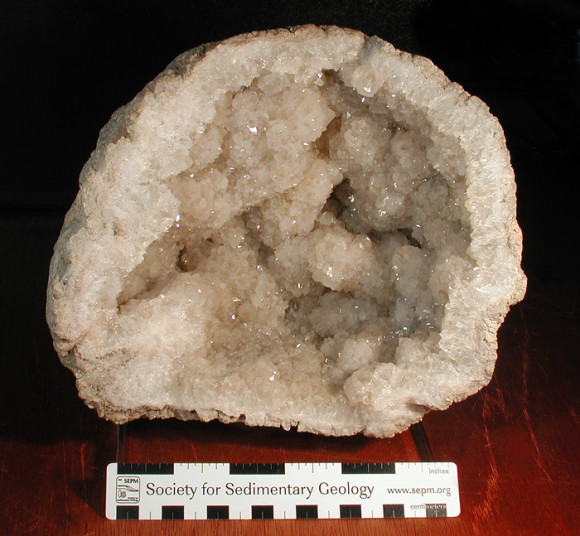
Large quartz geode from Keokuk area- 20 cm diameter. Collected by David Wixom. K. Nash specimen and photo.
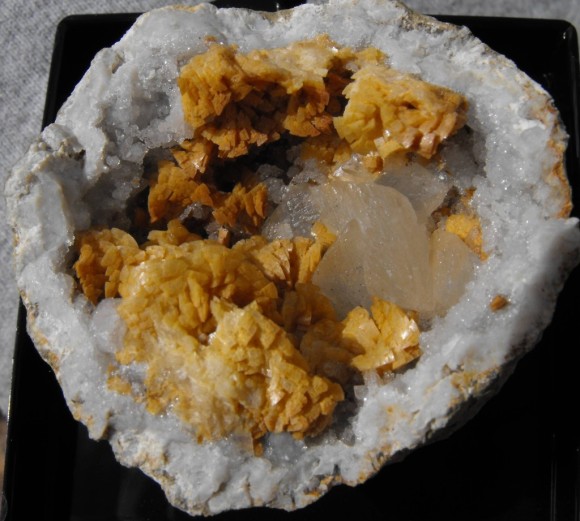
Typical geode and associated minerals (calcite and dolomite) from Keokuk, Iowa area. 4cm x 4cm. Rolf Lutcke specimen and photo. Ex. Paul Griswold
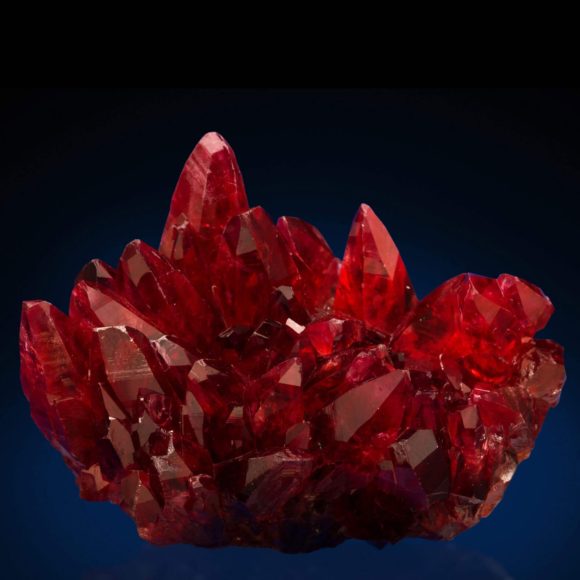
Geodes sometimes have carbonate minerals inside, like Calcite. But, wouldn’t it be cooler if they had crazy red Rhodochrosite crystals like this. Click here to see more amazing photos of crystals
Localities:
Sheffler Rock Shop and Geode Mine:
RR1 Box 171
Alexandria, MO 63430
At junction of Highway 61 and 27, 6mi S of Alexandria
Tim Sheffler
(660) 754 – 1134
tsheffler@mchsi.com
$25 per day for 50 lbs of material. 75 cents for each additional pound
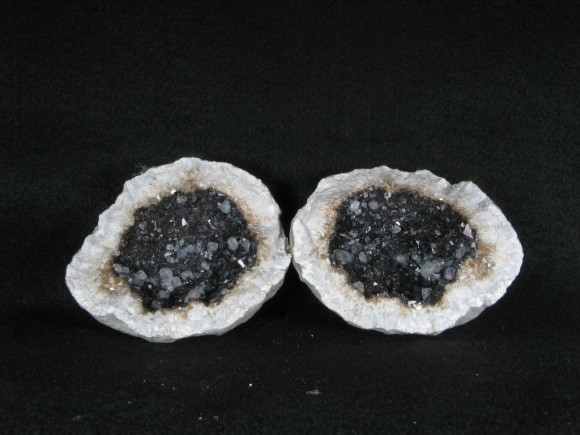
Calcite and quartz geode from the Sheffler Geode Mine. A good specimen for the locality. 10 cm wide. Roger Sedgwick specimen and photo. Collected by owner.
Geodes are very abundant at this locality, hence the high limit for material. They are typically filled with quartz crystals but some other interesting mineralization can be observed. Dolomite, calcite, and pyrite are common accessories. It is best to use a prybar to free the geodes from the limestone matrix and open them at home or wherever they can be carefully cleaned, opened, and sorted.
Des Moines River, Iowa and Missouri
Geodes can be found abundantly in the outcrops on the shores of the Des Moines river. Bring a shovel to loosen geodes from the muddy banks and wash them in the river so the surface features can be seen. Some rocks at these riverbank localities may be deceiving and look like geodes but are just cobbles that have been well-rounded by erosion. These geodes can be filled with a wide variety of minerals and be of extremely varying but most will only contain quartz and typically at most one other species such as calcite or dolomite.
Jacobs’ Geode Shop and Mine:
823 East County Rd 1220
Hamilton, IL 62341
(217) 847-3509
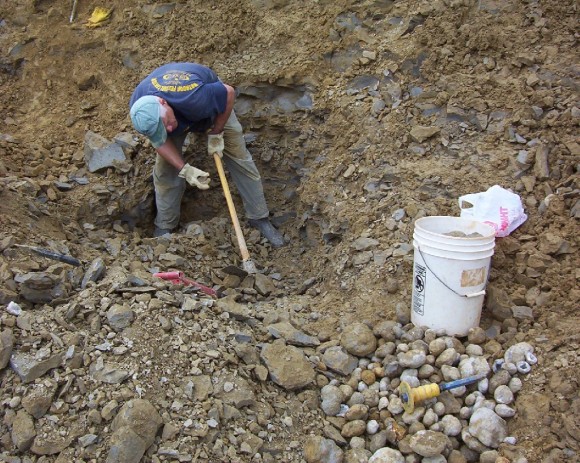
Caption: Collector with large pile of geodes in Jacobs’ Geode Mine workings. E. Harrington photo.
Call before visiting. It is best to dig while the owners are around so they can show you the best technique to use at this site. It’s a good idea to call in advance to make sure they will be at the mine. The all day fee is reported to be $20. Apparently the owners only allow visitors to crack certain geodes on site so most of the prep work should be done at home. Reported to produce very nice material
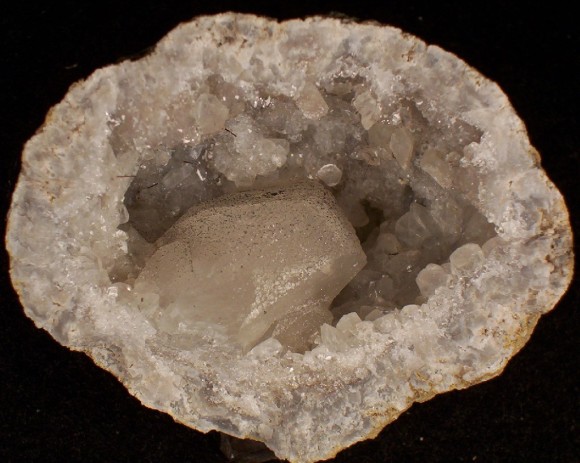
7cm geode with 3.5cm calcite crystal. E. Harrington specimen and photo.
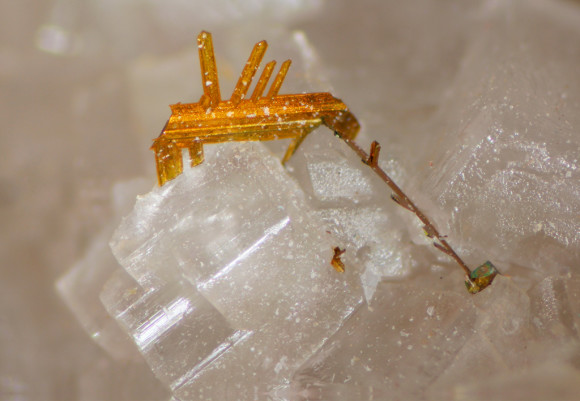
Marcasite crystal in geode. FOV 4.5mm. Collected and photographed by David Hanson.
Dennis Stevenson Geodes:
625 S. 18th St., Hamilton, Illinois
Call ahead to plan a trip: 309-337-3089 or 217-847-2952
$20 for one bucket, $15 for each additional one.
Mostly quartz based geodes, but some have nice calcite crystals as well. A staple Midwestern geode locality.
Find out what minerals Iowa is and has produced, check out what is new on eBay

Related posts:
Collecting Copper in Michigan’s Copper Country
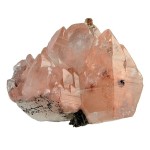
Field Trip: Copper Country Collecting in Michigan’s Keweenaw Peninsula
By Jeremy Zolan
Difficulty Level: Easy to Moderate
Supplies Needed:
Safety Goggles
Water
Sunscreen
Insect Repellant
Crack Hammer
Chisel
Shovel
Wrapping Paper for Specimens
Bucket
Sledgehammer (optional)
Prybar (optional)
Metal Detector (optional)
Description:
The Keweenaw Peninsula of Michigan has been nationally famous for over 100 years for its history of highly productive copper mining. The local basalt is criss-crossed with many thick veins of native copper that made up the main ore of many of the mines. Solid natural masses of copper weighing hundreds of pounds were found with relative frequency at the mines. Though these pieces certainly were the most valuable ore, the best specimens from the area are clusters of well formed copper crystals. Other metallic minerals can be found with the native copper such as silver, domeykite, mohawkite, and chalcocite. Many other interesting minerals like datolite, analcime, prehnite, agate, and thomsonite are also abundant in the Keweenaw Peninsula. While all the mines of the region are closed to copper production, many are maintained as museums and fee dig sites. There are also many abandoned mines in the area that can provide good digging in the dumps but be sure to acquire permission from landowners before visiting any location on private land.
Localities:
Central Mine:
US 41
Central, MI 49950
Map:
The large tailings piles of the Central Mine are visible from US 41 in Central, Michigan. Many collectors have had good luck recently working this location. Occasionally, contractors remove large quantities of tailings for construction purposes and this exposes fresh material. In addition to the standard copper specimens, copper included calcite and prehnite can be found here. Silver has also been found with copper here but it is rare. A metal detector is very helpful for sorting trough dump piles like those found at the Central Mine.
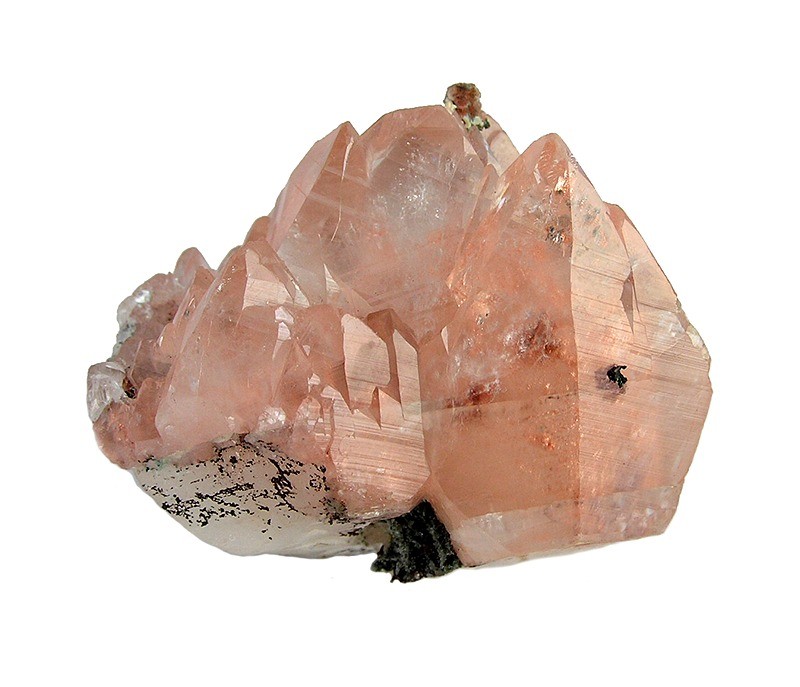
Caption: Calcite with copper inclusions. Central Mine, Central, MI 4.9 cm x 4.6 cm x 4 cm Ex. Rukin Jelks Rob Lavinsky Photo
Caption: Unusually large copper crystal. Central Mine, Central, MI. George Vaux collection at Bryn Mawr College. Scale bar is 1” long with rule at 1cm. Rock Currier Photo.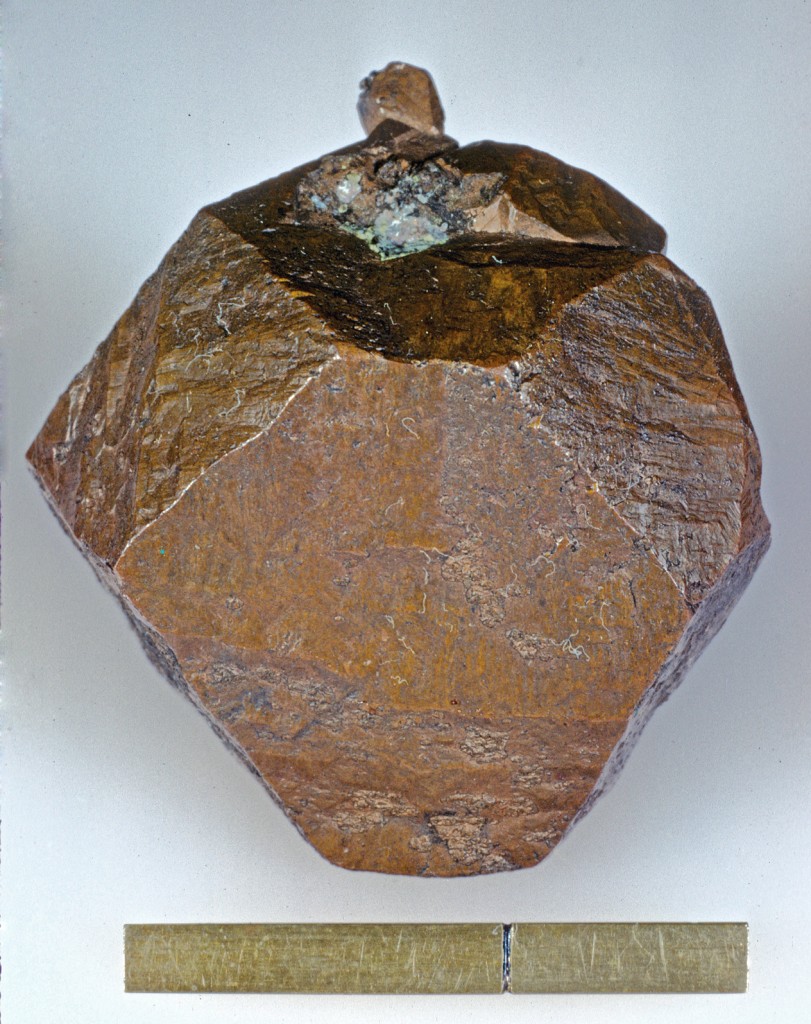
Caledonia Mine:
Website: http://www.caledoniamine.com/
906-370-1131
202 Ontonagon St,
Ontonagon
Michigan 49953
The Caledonia Mine is a fee dig site that requires an advance reservation. When digging at this site, collectors are given a large pile of stockpiled copper ore and tools to go through it. Weekly collecting events on Thursdays and Saturdays are also held from the first Thursday in June to the last Saturday in August on the ore pile. Advance reservations are needed for these too. The workings of the Caledonia Mine are impressively preserved and tours are offered too. The mine tours aren’t necessarily just geared for casual guests. Many kinds of tours are offered, some with a very in depth historical or scientific focus. It is best to check the museum calendar to see if any events are happening during the time of your visit.
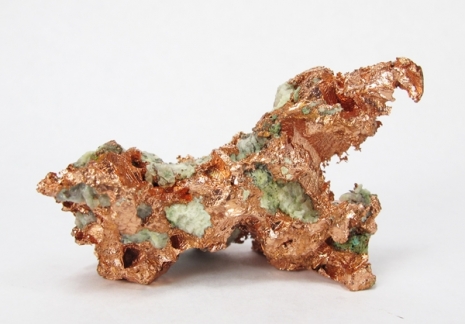
Caption: Representative specimen of native copper from the Caledonia Mine’s recent workings. 5.6cm wide. Rob Lavinsky Photo
A.E. Seaman Mineral Museum
Website: http://www.museum.mtu.edu/
Michigan Technological University
1404 E. Sharon Avenue
Houghton, Michigan 49931-1295
E-mail: tjb@mtu.edu
Telephone: (906) 487-2572
Michigan Tech’s A.E. Seaman Mineral museum is among the finest mineralogical museums in the world. Its laboratories are also critical in performing much of the cutting edge mineral research currently being performed. During the period of most intense copper mining in Michigan, many specimens of local minerals were donated to the museum. Their collection of Michigan minerals is the finest in the world and there is a strong local emphasis on their displays.
Check out our custom search and view all the minerals from Michigan for sale on eBay. Not only will you see lots of neat stuff for sale, you’ll also get an idea of what localities are producing in the region.

Field Trip: Fluorite and Secondary Lead-Zinc Minerals from Marion, Kentucky
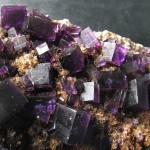
Field Trip: Fluorite and Secondary Lead-Zinc Minerals from Marion, Kentucky
Site Description:
The Illinois-Kentucky Fluorspar district is world famous for the enormous quantity of huge, gorgeously crystalline purple and yellow fluorite that originated from the now defunct mines near Cave-In-Rock Illinois. Just take a look at the amazing samples on eBay to get an idea of the current prices and selections. Many collectors do not know that despite the closure of the by far most significant fluorite localities in the region, there are still places in the area to find gorgeous fluorite. While many of these localities are abandoned mines that require deep underground exploration to retrieve specimens, the mines in Marion, Kentucky have specimen rich dumps that are easily worked by hand from the surface. While aesthetic material is plentiful, many of the workings are quite muddy and messy to dig in. It is important to keep in mind that while many gorgeous specimens can be had with minimal digging, specimens of similar quality to those seen in the nearby Ben E. Clement Museum, which features local minerals, are hard to find.
Perhaps the best central location to access all the mines in the region from is the Ben E. Clement mineral museum (http://www.clementmineralmuseum.org/). In the museum, they have many of the finest American fluorite specimens on display. Many are from the collection of the museum’s namesake- a giant in the local fluorite mining industry. It is amazing to see the near infinite color variation that fluorite possesses, especially the great diversity within the region. The museum has scheduled digs for fluorite and other kinds of minerals beginning late April through October. In addition to daytime digs, night digs for fluorescent specimens are held too. The museum can also arrange custom digs. Regardless, pre-registration is required.
Difficulty Level: Moderate
Supplies Needed:
Safety Goggles
Water
Sunscreen
Insect Repellant
Hand Lens
Crack Hammer
Chisel
Shovel
Wrapping Paper for Specimens
Bucket
Sledgehammer (optional)
UV Light (optional)
The Ben E. Clement Mineral Museum
205 N Walker St., Marion, KY 42064
(270)965-4263
Mineralogy:
The following is a list and brief description of common minerals found at the Marion area mines.
Calcite: A common gangue mineral. Rarely forms crystals good enough to keep. Often fluoresces red.
Cerussite: Very nice cerussite crystals come from the Marion mines and they are often overlooked. Forms colorless to smoky gray highly lustrous crystals associated with galena and hemimorphite. They either occur singly or are twinned and reach about 1cm in size. Crystals have diverse habits.
Image: http://www.mindat.org/photo-207070.html Caption: Cerussite- Hickory Cane Mine, Marion, KY 17x13mm Steve Bonney Specimen and Photo
Fluorite: The most sought after mineral at the Marion mines. Found in sharp purple cubic crystals with a maximum diameter of about 3cm. Very easy to identify- the only purple colored mineral at any of the local mines. Found as micro to large cabinet sized specimens. The Marion area is world famous for fluorite.
Image: http://www.mindat.org/photo-76574.html Caption: Fluorite- Eureka Mine, Marion, KY Crystals to 7.5mm Peter Cristofono Specimen and Photo
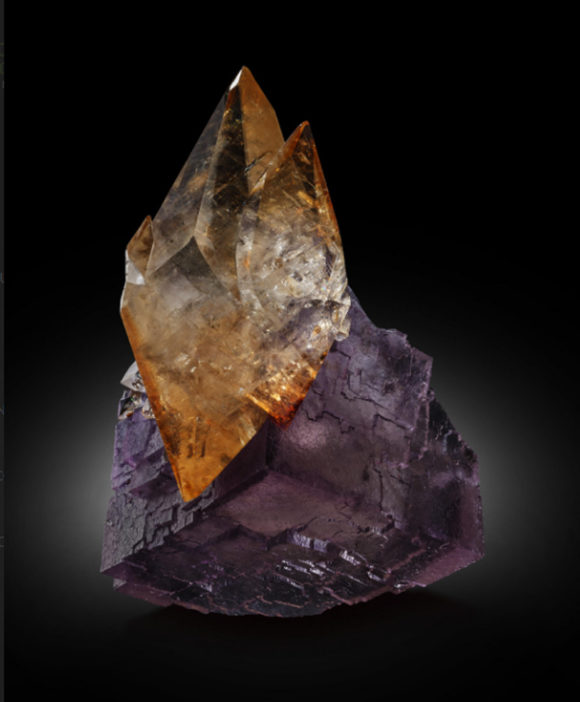
Calcite and Fluorite specimens like this were mined right here in America by miners who wanted to save these beautiful crystals from the rock crusher. Just a few miles away, in Illinois, in the Cave in Rocks District – click here to see more amazing minerals
Galena: Small cubes of galena to around 1.5cm can be found. Often they are weathered.
Image: http://www.mindat.org/photo-226066.html Caption: Columbia Mine, Marion KY 6x7cm Steve Bonney specimen and photo.
Greenockite: Rare naturally occurring cadmium sulfide that occurs as ochre colored powder with sulfide minerals, especially weathered sphalerite. Sometimes colors smithsonite yellow.
Hemimorphite: Hemimorphite forms druses of colorless to yellowish crystals in vugs and on weathering zinc minerals. Can cover areas to several cm with glittering crystals. Common, but often overlooked.
Image: http://www.mindat.org/photo-172178.html Caption: Hickory Cane Mine, Marion, KY 1.7cm FOV Steve Bonney specimen and photo.
Hydrozincite: Powdery white secondary zinc mineral. Fluoresces blue under SW UV light.
Quartz: Typically occurs as small drusy or isolated crystals to 4mm. Some are smoky.
Smithsonite: Ususally forms thick, liberal coatings of colorless to tannish botryoidal material. Some specimens are crystalline and some are yellow colored due to the presence of greenockite inclusions. Cabinet specimens are known.
Photo: http://www.mindat.org/photo-305765.html Caption: Marion, KY 7.5 x 6.5 x 5.8cm Rob Lavinsky photo
Sphalerite: Small aesthetic crystals of sphalerite to about 3mm are abundant. They are typically very lustrous and orange-brown in color.
By Jeremy Zolan
Related posts:
Event Report- 2014 Castro Valley Club-Newark Pavillion Show, Newark, CA (Feb 21-23)

A Visit to the Castro Valley Mineral Club Show, 2014
By Jeremy Zolan – Earth Surgery
The Mineral and Gem Society of Castro Valley puts on an excellent small mineral show each year at the Newark Pavillion in Newark, CA. This small locally focused show great for all audiences and ages, and makes for a wonderful weekend outing especially with family and friends! This show attracts dealers who offer an extremely wide array of material ranging from gem and lapidary rough to rare minerals. There are also many displays and booths offering activities, information, and many other things in addition to those who strictly sell specimens. During my visit, everyone at this show was extremely kind and made me feel welcome to the California collecting scene which I am extremely new to. For new residents of California looking to make connections, this is a great springboard into the scene.
I have recently been staying in the the Barstow area of Southern California so getting to this show was quite a drive. It did allow me a first glimpse at the landscape of many interesting places I have never visited before and was very scenic. Here we have a picture of high desert scrub in Boron, CA with the titanic US Borax Mine lurking barely visibly in the distance. Many of the hills in the photo are partially made from giant tailings piles. This mine is not only famous for its incredible size and high production but for its mineralogy which is highly distinctive. In addition to producing many thousands of fine colemanite specimens, it also is well known for splendid examples of many rare borates such as inyoite, kurnakovite, probertite, and kernite.
The first thing I did when I arrived at the show was check out the display cases, which there were many of for a small local event. In my home New England region, events of similar size only rarely have as many displays so I was pretty surprised. The cases were filled by a local crowd including both collectors and museums but definitely far more of the former rather than the latter. Lapidary, mineralogy, paleontology, and anthropological themes were all present in the displays however there was a significant bias towards the lapidary side of things with comparatively very few mineral display cases. This was somewhat reflected in the abundance of lapidary dealers at the show though there were also many great mineral and fossil dealers as well.
Next off, I decided to parouse the dealer booths and was pleased with the great variety in not only species and localities but prices I saw. There were many great specimens to be had for under fifty dollars including many lots of old material at multiple dealers that appeared to have not been repriced in decades. There was truly something for everyone at this event.
The first dealer I visited was The Uncarved Block which always has a good assortment of material though tends to mostly focus on classic, well known species that display best in the thumbnail to cabinet range. Many specimens stuck out to me but those pictured below were my favorite, most of which are things that rarely turn up on the West Coast.
First off we have two teal kyanite crystals in a biotite schist matrix from the Harts Range in the Northern Territory, Australia. The color indicates that the specimen may more precisely be from Huckitta Well or nearby. The crystals were aesthetically skewered through the matrix and had a very pleasing deep aqua blue color. The longest was exposed to about 6cm of its total length. The Harts Range is one of only a very small assortment of localities in Australia that produce gem pegmatite minerals such as beryl and garnets.
Next, I spotted this specimen of beryl from Slocum’s Quarry in East Hampton, Connecticut. This very uncommon, very old, and now very closed locality is well known for its yellow beryl var. heliodor crystals which were opaque to extremely gemmy and sometimes formed in pockets. The pocket crystals were often etched in a manner similar to the Ukranian crystals from Volodarsk-Volinskiithough their color saturation ranges to an extremely deep and gorgeous pumpkin orange color. Slocum’s Quarry also exhibits an impressive suite of rare Be, Nb/Ta, and REE minerals. Ernie Schlicter collected the below piece which has bigger crystals than most by far even though they are of a very light color for Slocum’s.
Romanian amethyst from Porkura, Huneodoara Co. is something I am always looking out for and in my opinion, are some of the world’s great amethysts with their extremely deep color saturation and unusual crystal shapes. They strongly resemble newer specimens from Guerrero, Mexico but being the snob that I am, I think the Romanian specimens always have better color. I really loved this piece which has the perfect balance of purple cityscape-like crystals and contrasting matrix. Truly a fine amethyst.
Finally, I spotted this set of alphabet agate from Indonesia. The letters are formed by natural tubular inclusions of iron oxides and clays in the agate. These sets always amaze me. Imagine how many thousands of pieces must be sorted through to get a full alphabet! Truly a daunting task, it has been said to take years to find a full set by inspecting rough. Some letters such as R and Q with unusual shapes are apparently rarer than others.
It was then over to Earth’s Treasures, run by avid field collector Rick Kennedy. Rick has been working the California Blue Mine in San Bernardino County for aquamarine, topaz, quartzes, wodginite, and other associated species. This locality is outside of what is traditionally regarded as the Southern California Pegmatite district so I had to know more considering it could change our perception of pegmatite mineralogy in California. It appears that this pegmatite is of intermediate elemental distribution (LCT/YNF) though it is likely very lithium poor unlike some geochemically similar envirtonments though the micas would need to be analyzed to truly validate that statement. Greisenization took place in the top of the peg and created a lot of topaz and fluorite mineralization while deeper in were the nice gemmy aquas. Some of the crystals show interesting tapering that reminds me of specimens from Brazil and Argentina. Below is my favorite crystal from the locality he had for sale at his booth.
Rick had lots of other great material too; a lot of exotics especially. This limonite after magnetite pseudo is very peculiar especially. Considering Kansas is mostly sedimentary, one would not expect to see magnetite originating from there. Many of these magnetites were collected around 100 years ago.
John Garsow had a lot of great material too with a focus on gem minerals, rough, and materials. John is also an avid field collector who has made some really nice finds in Southern California. He had this Chinese tourmaline that immediately caught my attention. If there is one group of minerals that China lacks it is pegmatite minerals. There are only two very poorly explored main areas for specimen producing gem lithium pegmatites in China; near Kashi, Xinjiang Uygur Province or the Gaoligongshan ranges in Yunnan Province. Both are located in notoriously remote and culturally distinct regions in western China. This piece, measuring in at around 8cm tall is from the latter which is known for mostly producing only tiny crystals to 2 or 3cm. Chinese specimens show frequent mislabeling so it is possible this is from another entirely different area since it does not resemble the majority of specimens I’ve seen from either Xinjiang or Yunnan Provinces. I thought it was a really fascinating piece for that reason.
Taking a break from strictly minerals, I decided to check out the Northern California Geological Society’s booth to ask some questions about local geology since I am by no means well versed in the geology of California which is extremely different from those good old passive margins on the East Coast that I’ve explored and collected in so much. Mostly, I was curious about the formation, petrology, and mineralogy of blueschists and eclogites; rare, extremely high grade metamorphic rocks I was rewarded with kindness and a very thorough explanation. NCGS offers many excellent field trip publications exploring many themes in the northern California area. They also have an excellent scholarship program for B.S through Ph.D.-level students in California and the adjacent states.
Alfredo Petrov has long been one of my favorite mineral dealers for the scientific focus of his merchandise. In addition to specimens of many truly weird minerals, he often has specimens of odd reagents or elements. He had several vials and containers of selenium, calcium, lithium, and samarium. I encourage the sale of element samples at mineral shows. Element collecting was quite popular a few years back but seems to have tapered slightly at least in the US. As for minerals, hw of course had a lot of oddball specimens..in fact too much to mention. Some of my favorites were his tiny sapphires panned from Japanese alluvial gravels, analcime and natrolite with celadonite from East Greenland- far away from the famous mineral producing regions on the frigid island. I thought one of the nicer high end pieces he had was this English torbernite. It is priced very competitively considering the quality of the specimen, high pedigree A.E. Foote label, and overall rarity of the material.
I have been a customer of Mineralogical Research Corporation (Minresco) in the past so it was great visiting their booth and looking through some of their flats in person. They had lots of fine quality, well known material from worldwide locations displayed in the front of the booth and rarer specimens behind. As for the material out front, I thought their specimens of the new azurite find from Lavrion, Greece were some of the better I have seen. I did however spend most of my time looking at the rare material in the back flats which was perhaps the most varied material in the entire show. I will refrain from mentioning my favorites because there were just simply too many. I did think this vial of szabelyite from Bou Azzer Morocco was pretty cool considering it was probably collected and studied far before the mine produced the specimens it is currently famous for. It may likely be one of the earliest collected mineral specimens from Morocco in circulation. That may not be saying much though considering that the vast majority of Moroccan pieces are no more than 20 years old. I still thought it was very interesting to see.
The 2014 Castro Valley Show was great fun and it was definitely geared to a wider audience than I feel most smaller local mineral shows tend to target. Not only was there great diversity of material available, but amazing deals to be had. Not only is this a great show for everyone interested in minerals as a hobby, but would be rewarding for dealers looking to obtain inexpensive, high quality material for their inventory. As far as improvements, my only big criticisms were that I wish the displays had better labeling and there was more emphasis on local field collecting in them. I cannot say the show had any other drawbacks for me considering its nature and size. I thought it was awesome!!! This is a great event that I hope continues to be held for many years in the future!
Below is a specimen purchased at the Show which is available from Earth Surgery – Contact at JZolanSci@gmail.com to inquire.
Uranopilite- $100
(UO2)6(SO4)O2(OH)6·14H2O
Happy Jack Mine, White Canyon Dist., San Juan Co., UT
Ex. Dr. Eugene B. Gross
6.7 x 2.4cm 21.81g
email JZolanSci@gmail.com to order
The rare uranium secondary uranopilite is rarely available in specimens as rich as this one where it is present as bright highlighter-yellow powdery masses in a dark sedimentary matrix. The uranopilite masses may be poorly defined crystals. Typical of most uranyl minerals, the specimen is vividly fluorescent in all UV wavelengths and slightly radioactive. The identity of this specimen is highly credible- this specimen resided in the personal collection of Dr. Eugene B. Gross; a geochemist who prospected the uranium deposits of Utah for the Atomic Energy Commission.
Uranopilite has a very odd structure in that it is a polymer composed of metal oxo-clusters linked by sulfate “couplings.” This phenomenon of uranyl-clustering is observed in a select few uranyl species and have some structural characteristics of formal polyoxometallates, which of only one occurs in nature. If you wish to inform yourself more on the cluster chemistry of they uranyl cation, especially in minerals, I recommend this paper: http://minmag.geoscienceworld.org/content/75/1/1/F3.expansion.html
To search for minerals for sale that were mined in California, check out this search for minerals of California on eBay

Related posts:
UV Light usage in mineral collecting – A Review of a dual band light under $100!
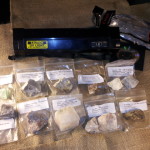
I finally got tired of not having a UV light to use in the field. Years ago I had a nice unit with dual LW/SW and a 12v cigar lighter plug, which worked with lots of portable battery packs and in my car for those nighttime visits to classic UV locations. Sadly, this light was lost and replacing it would be a few hundred dollars.
But, you never know how much you miss something like a good UV light until it is gone. There are just so many things a UV light helps with when checking out minerals. From the visual identification to seeing if a purchased specimen is glued, a good UV light pays for itself, quickly.
I was excited to read about the improvements to UVTools.com handheld Lamp, an all in one unit with a long wave bulb and a strong short wave bulb powered by 6 watts, a decent output, for just under $100. The kit comes with the light, which requires 3D batteries, a sample of minerals to test the light with shortwave and longwave reactive specimens. Safety goggles and a cd rom with study guides and informative literature complete the package, all in all, it gives a great start to any beginner, while the advanced collector will appreciate the power this highly portable hand held unit produces. I found the LW light to be very bright and it made some of the fluorites in my collection to glow bright white/blue. The shortwave light gives a bright reaction, but typically from a distance of no more than 6 inches from the lamp. It will not light up a hillside, or even a whole flat of minerals, but it is perfect for “one on one” specimen viewing.
Below: Photos of the kit, the minerals that came with it and some UV reaction from those specimens.
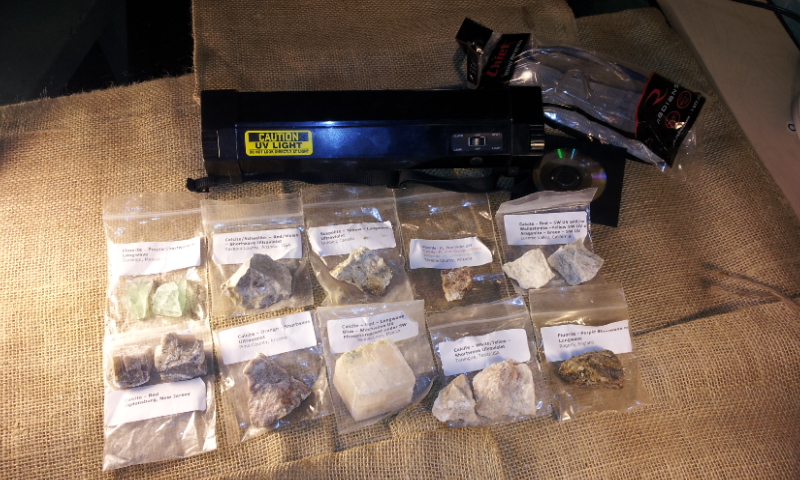
UV Kit, includes the lamp, 10 mineral specimens, safety glasses and a cd full of information. Available from http://UVTools.com
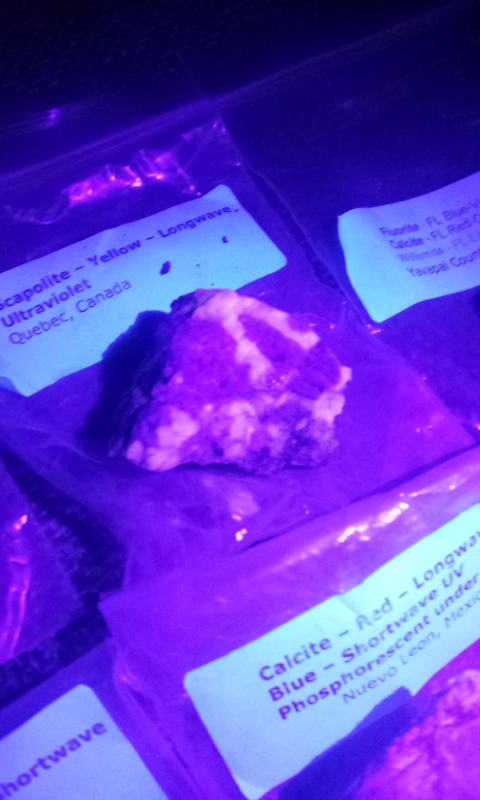
Longwave Light Sample (photo taken with Galaxy S2 Phone)
You can purchase this UV Lamp from the manufacture, directly at http://www.ultraviolet-tools.com for $99.99.
There were two interesting things I learned by using this UV light. This agate deposit near my house became that much more interesting when I found out that every single piece of agate glows bright green under shortwave light. That means there is a lot of uranium in the area, which is giving the agate that color. Then, a hill over from that agate deposit, at another agate deposit, the brown crust on some of the agates was determined to be an uncommon variety of feldspar, after it was found that these crystals, in micron size, were glowing bright pink, typical of the species. You might wonder, so what, crusts of brown on agate? Well, the sweet thing is that these agates would now glow three different colors, green, pink and orange, sometimes yellow, as well. Three color rocks are what it is all about, so being able to notice the brown crusty bits on some of the agates helps identify them for further UV evaluation! It should be no surprise, those glowing agates include the local petrified palm root and what I like to call “Manix Lakebed Agate” which is a slurry of reeds, roots, rods and roughage from the lake that got silicated into a variety of translucent gel agate in shades of clear to black with red inclusions to a thick jasper-like layered wad of organics in stripes of black, red, cream and white. All of these organic masses were ripe with uranium! Several uranium deposits dot the mountains to the south, UV light is a great indicator of “hot rocks”!
At WhereToFindRocks.com we give this product our recommendation for best starter kit for novices and backup/handheld for advanced collectors.
Just under $100.00 from a manufacturer who stands behind their product. http://UVTools.com
Related posts:
Big Diamonds to be Found at the Crater of Diamonds State Park

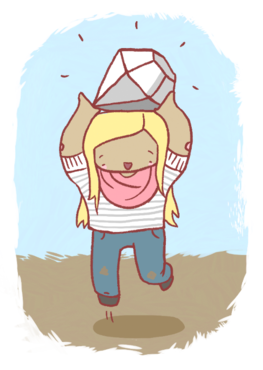
It has been a productive year at the Crater of Diamonds State Park. To date, October 26th, 2013, nearly 400 diamonds have been found over the span of the year, with some rather large ones, several over 2 carats. For instance, Oklahoma teen Tana Clymer found a beautifully formed 3.85-carat canary diamond on October 19th, very similar to the fine diamond that was found by the late Marvin Culver, also of Oklahoma, in 2006. That diamond, the 4.21 carat “Okie Dokie Diamond” has been featured in several books, magazines and has been on display to the public a few times. Another large diamond, a 5.16 carat diamond was found by 12-year-old Michael Dettlaff of North Carolina in August. A 2 carat brown stone was found in June and all of these stones have one thing in common…
Many of these large diamonds are often found on the surface of the digging area.
One of the things many people are shocked to see upon arriving at the park is the actual mine area. It looks like a freshly plowed dirt field, waiting to be seeded and farmed. This area is poked and prodded, pitted and flipped, in search of the small gems distributed in the dirt.
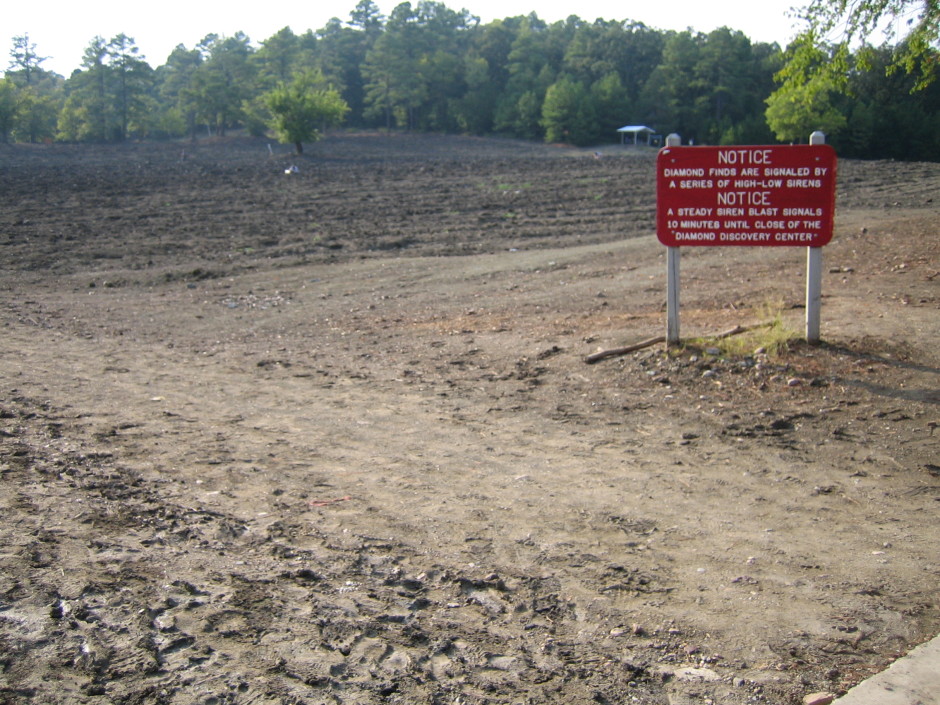
Finding the park is very easy, once you are in the general area of Murfreesboro, Arkansas you will see signs pointing to the famous state park. You pay a nominal fee per person and go out into the field to search. You can dig, collect dirt and screen it, looking through the mud for a glassy pebble.
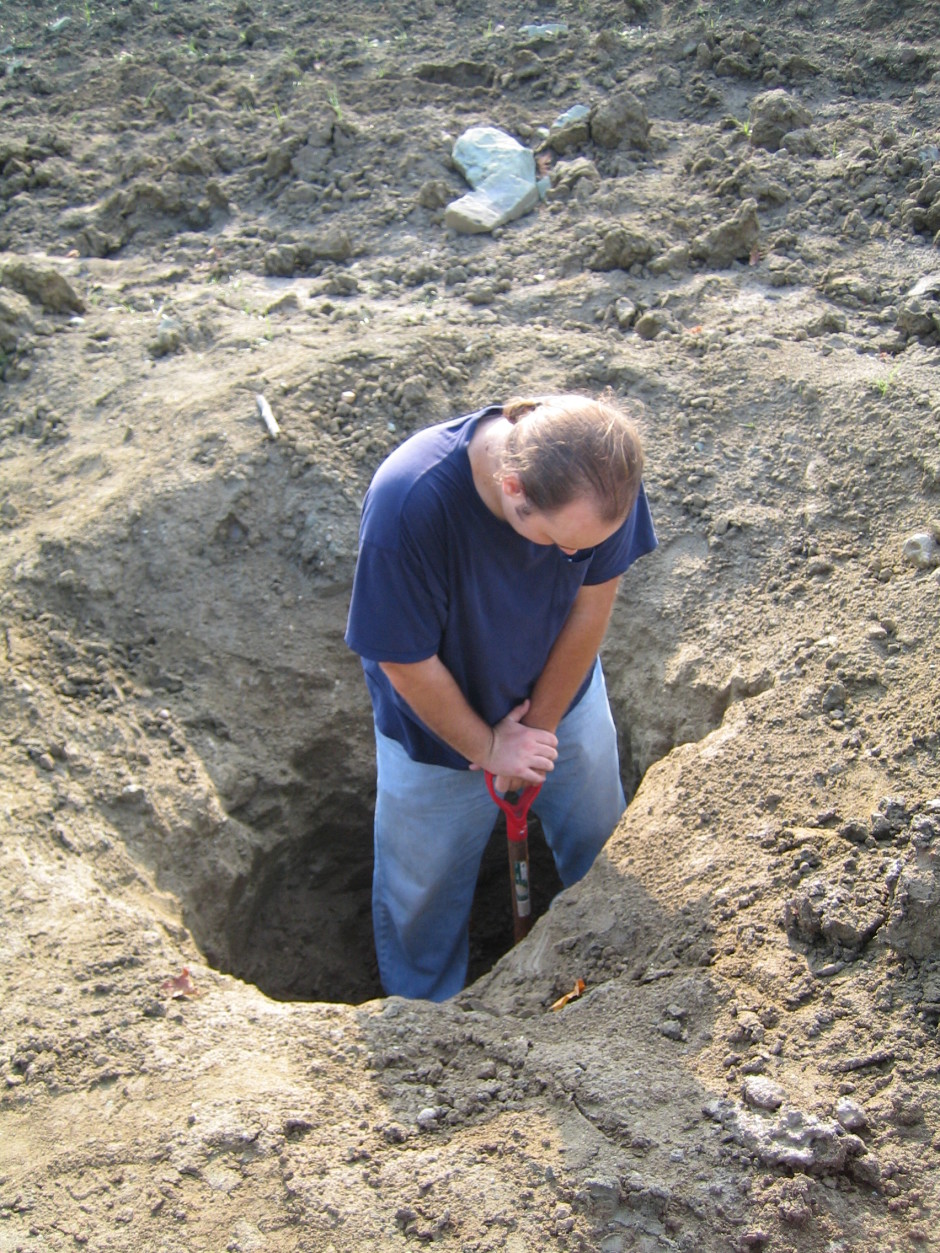
Or, you can do what many of the people who find the large diamonds do, simply walk around the dirt field, looking for crystals that have risen to the surface.
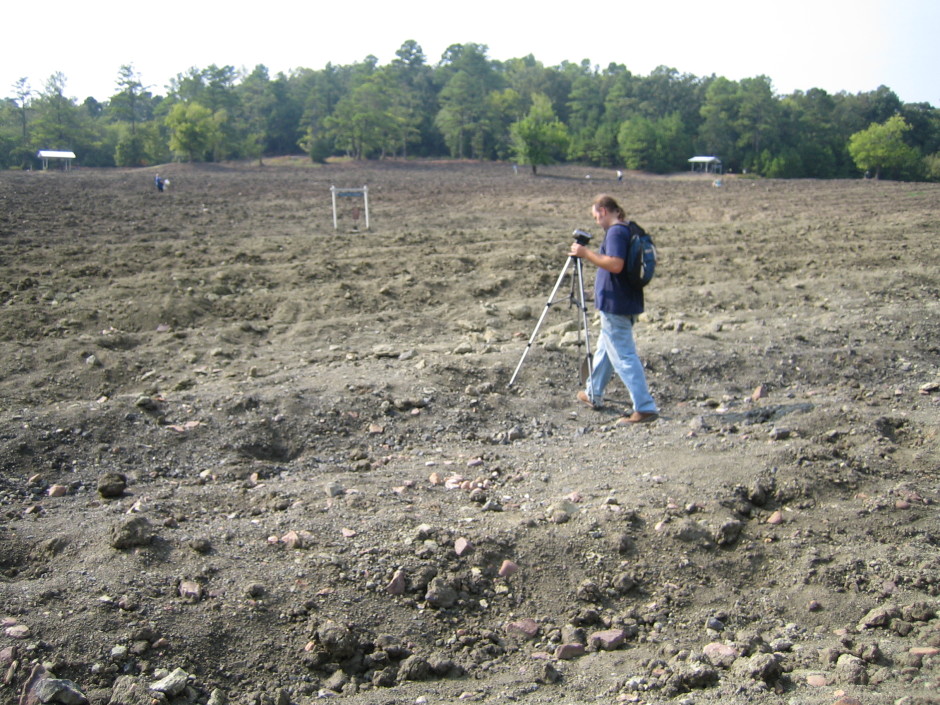
Either way, the Crater of Diamonds State Park is a great place to visit and try your luck at finding a precious stone. The chance of finding one of these stones is stacked against you, but if you happen across one of those rare 2+ carat stones, the Associated Press would like to acquire your photo posing with the stone.
Related posts:
Rock Hounding for Agates in SouthWest Texas
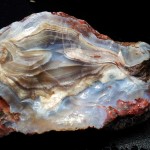
Rock Hounding West Texas for Agate and many other great finds
By Erin Balzrette
for Katy Rock Shop
http://www.katyrockshop.com
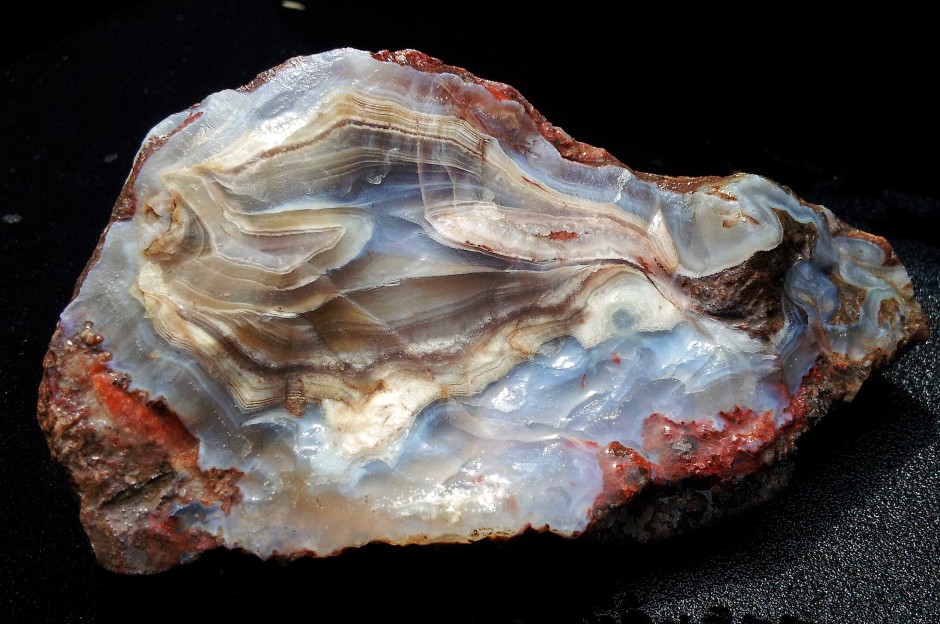
Above: Banded Agate from the Alpine Texas area
After rock hounding in Texas with a guide as amazing as Frank Roberts of Austin, Texas, Dawn and I felt ready to go it alone. Also, we begged Frank to come if we got lost or could not identify what we were seeing, and he emailed us all weekend to be sure we were safe. Like I said, we “went it alone”, with Frank on stand-by. We grabbed a copy of The Gem Trails of Texas by Brad Lee Cross and decided to head out.
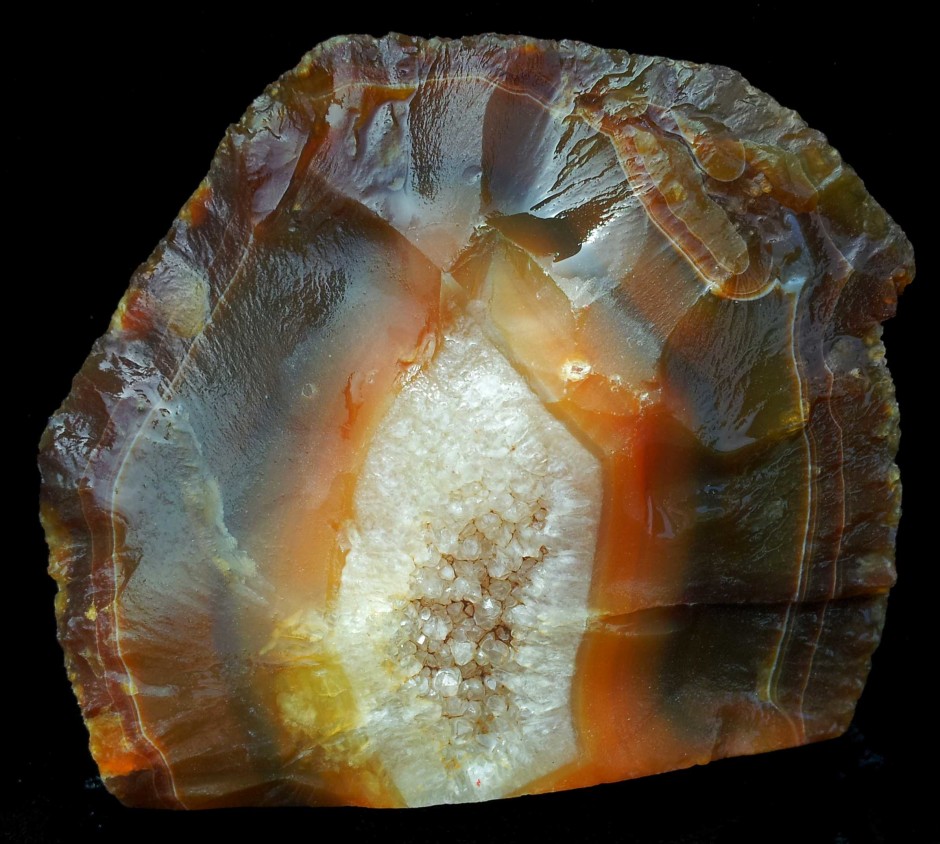
Above: Classic Agate from the Alpine Texas area
I called Paul at Moonlight Gemstone, of Marfa, TX, (432-729-4526) Bruce Huff, of Katy Rock Shop has a great respect for his beautiful work as do I, and I could not wait to see it for myself, and meet him. The Marfa agate is breathtaking. Paul Graybeal has exclusive rights to the private property in which most of Marfa agate is found. He explained that access to for us to do some hounding would not be possible. He keeps names or locations of land owners who place trust in him to protect their land from sought after agate to himself. It is easy to see why he protects the agate he does. It should be protected, and the land owners have the right to feel their trust has been in no way misplaced. Instead, he invited us to come see him work! This was an incredible offer that I was not about to miss! Paul is thoughtful, generous, patient and kind. I was as impressed by the man, as I was by the work he did, and the agate that surrounded us. Spending the afternoon watching him work, letting us work with him, learn from him, was and experience I will not forget.
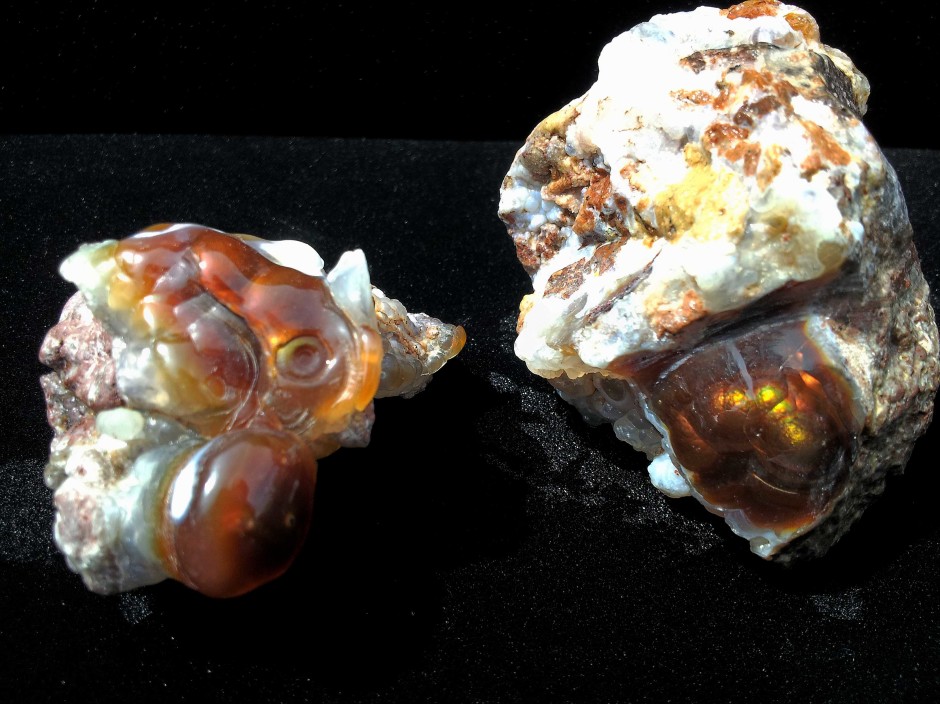
Above: FIRE AGATE from the Alpine Texas area
We couldn’t wait to get to Woodward Ranch (WoodwardRanch.com) famous for the beautiful red plume agate only found there. There is so much more to find at the ranch! The Labradorite is a clear yellow! Opals that are gorgeous, and what she calls “yard art” is some of the most beautiful I have seen. (Yard art … no charge!) $6.00 a person, you are given a detailed map, a quick learner’s course, and shoos you before it gets too hot! When you return she counts it out, $6.00 a lb. for agate. We each left paying 18 dollars, 2 lbs. of agate, and many more lbs. of “yard art” so beautiful I am thrilled to have found it. A few items I collected from this trip are on my website. She was a delightful woman who spoke of her late husband Trey in a way that made you want to sit all day and talk to her. I, like so many others, are so grateful that Woodward Ranch is still operating and allowing others to see the wonder it has to offer.
Terri Smith of Alpine, TX, emailed to explain that she will set up Agate “Hunts” for you, a group, or family, in the fall. THE FALL when it’s….cooler? Terri is the logical one here. And so we will go back in the fall and go to the Ranches able to be hounded at that time on the tours given. The email was very nice and suggested that we try the book I had bought for the journey. I was grateful for the advice, and that I had picked the right book! I have heard only great things about Terri and her extensive knowledge of the area and experience.
“The Gem Trails of Texas Book” by Brad Lee Cross, was for our purposes to the mile, correct and accurate in its description of findings, and location. We found beautiful Jasper at the picnic table Jasper sight 8 miles from Marathon. Exactly as the book said. Amazon is one seller that carries the Gem Trails Series.
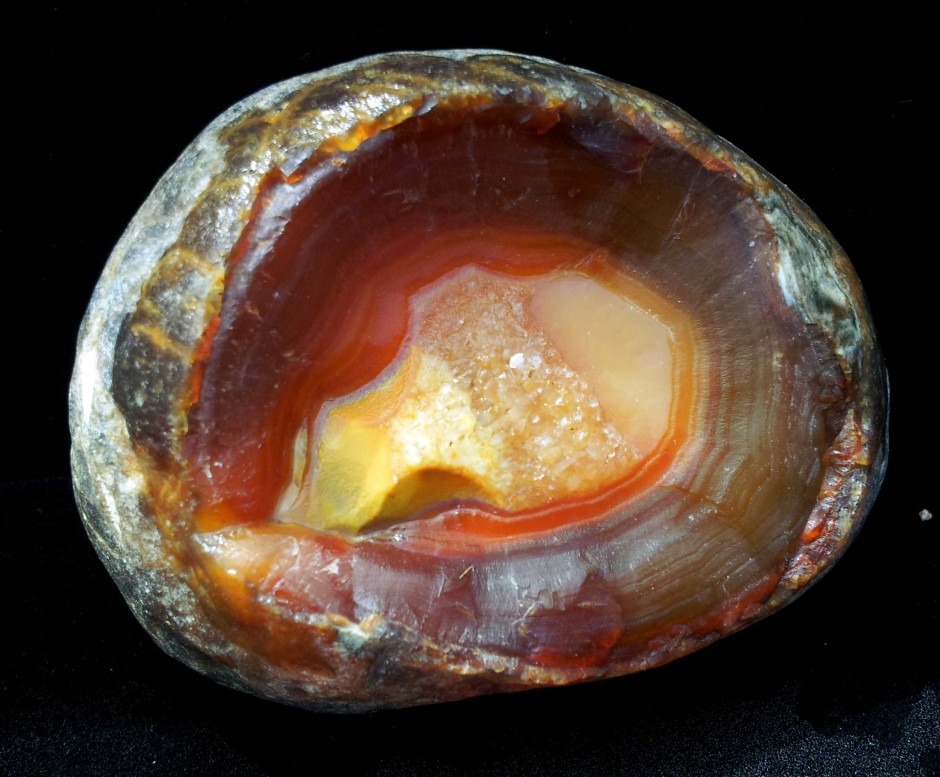
Above: Iron Rich Agate Geode from the Alpine Texas area
The West Texas Agate was a trip we will never forget, filled with beautiful surprises showing in each piece you see from that area. While visiting the Katy Rock Shop, you will see pieces from all over Needle Peak, Woodward, Marfa, and so much more and it is all there waiting to show you the beauty of West Texas.
Please find links to Katy Rock Shop, Terri Smith, Moonlight Gemstone, Woodward Ranch, Frank Roberts, and more at my website www.treeclimbersjewelry.com. Pieces I collected during this trip are displayed on the site as well.
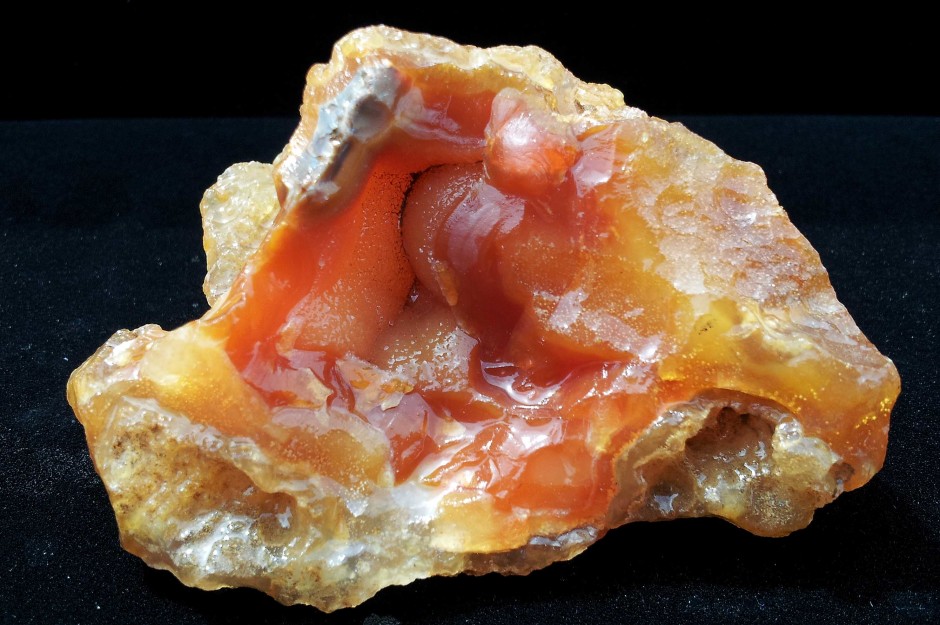
Above: Iron Rich Carnelian Agate from the Alpine Texas area
Here at WhereToFindRocks.com we love using Hotels.com to find places to stay while out rockhounding!
And you never know when that hole in the ground is going to require working after hours on, so with Hotels.com,
No hotels.com Change or Cancel fees on lodging bookings!
So, find a hotel around Marfa, Texas or Alpine Texas and get out and collect some Agates!
Related posts:
Collecting Tourmaline in Colorado – Brown Derby #1 Field Trip
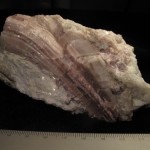
Philip M. Persson
3139 Larimer St., Denver, CO, 80205
perssonrareminerals.com
Exploration Geologist

When it comes to Colorado pegmatite’s, most people think of the vivid and prolific smoky quartz and ‘Amazonite’ feldspar combinations or perhaps fluorite or topaz crystals from the Pike’s Peak batholith, which can be seen in collections all over the world. Tourmaline is certainly not a species that comes to most collector’s mind’s from the Rocky Mountains, yet Colorado does contain several unusual and interesting pegmatite’s of the ‘LCT’ (lithium-tantalim-Niobium) type which contain fairly high-quality (though not ‘gem’ in the pocket sense) tourmaline crystals along with other rarer species. The most notable and certainly the most studied of these deposits is the Brown Derby #1 Pegmatite, located in the Ohio City/Quartz Creek District, approximately 18 miles northeast of Gunnison in the high mountains of Central Colorado. First mentioned by Eckel (1933) and later by Staatz and Trites (1955) in their exhaustive study on the Quartz Creek Pegmatite District, this locality has long been of interest to both collectors and mineralogists. In recent years, however, due to a combination of property access issues, remoteness, and a shift in focus of Colorado collecting to ‘dig’ localities for smoky quartz, amazonite et cetera, the Brown Derby seems all but forgotten. This article is not an attempt to eclipse or duplicate the already extensive literature on this locality, but rather provide a modern and collector-oriented perspective on this fascinating deposit.
Figure 1: Map showing location of Gunnison in Central Colorado (‘A’), with inset from Hanley et al. (1950) showing the Quartz Creek Pegmatite District, with the Brown Derby #1 Deposit marked with red star.
The Brown Derby #1 Pegmatite is the largest and most mineralogically-complex of a group of over 5 semi-parallel, dike-like pegmatite bodies which are situated on the western slope of a fairly prominent ~9400 foot high hill above the small settlement of Ohio City, approximately 18 miles northeast of Gunnison, Colorado, and 180 airline miles southwest of Denver. (Staatz & Trites 1955). According to Cerny (1991)’s pegmatite classification scheme, these are classic ‘LCT’ (lithium-tantalum-niobium) type deposits, and contain the geochemical and mineralogical characteristics of such deposits. They intrude ~1.7 billion year old metadiorite and associated metamorphic rocks of the Idaho Springs group, the Precambrian basement complex which covers a large portion of the State. Geochronology work by Heinrich (1967) and others found the pegmatite’s to be syngenetic to metamorphosis of the host rocks ~1.7 billion years ago, and they intruded as large sheet-like bodies parallel to the internal foliation and structure of the host rock. They strike N/NE and dip gently into the steep southeast hillside at 20-35 degrees (Heinrich 1967). The largest 3 pegmatite’s of the Brown Derby group all display exceptional mineralogical and geochemical zoning which is typical of most large LCT-type deposits, with the #1 Dike exhibiting the highest mineral diversity.
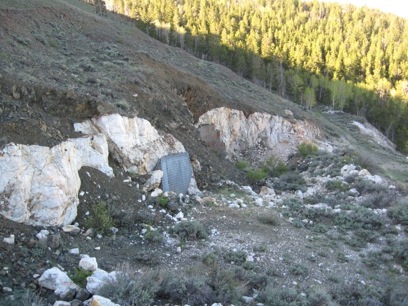
Figure 2: Looking Southeast along the strike of the Brown Derby #1 Pegmatite; large metal grate visible in center of photo is covering one of the underground drifts leading to a large stope on the core of the deposit. (Photo copyright Rudy Bolona/mindat.org)
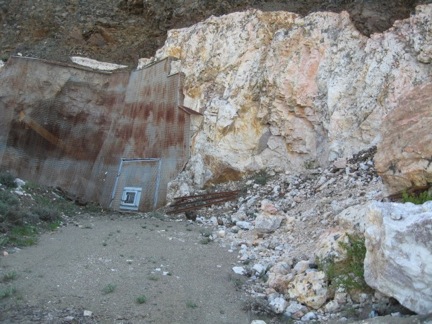
Figure 3: The Entrance to the #2 Tunnel, or main adit of the Brown Derby #1 Pegmatite, showing the sharp contact between pegmatite (white rock) and overlying metadiorite (dark gray) at the hanging wall contact. (Photo copyright Rudy Bolona/mindat.org)
The #1 Pegmatite was developed from the early 1930’s through the 1970’s and was mined principally for the lithium content of lepidolite, along ceramic-grade feldspar, minor beryl, and a somewhat substantial production of microlite, a tantlum species, though it is unclear if the resulting microlite concentrate was ever processed (Heinrich, 1967). It is presently divided into two properties in legal terms; a large surface exposure with associated dumps, which sit on National Forest/BLM land and are open to mineral collecting, and a fairly small underground portion which is owned by a group which identifies themselves as ‘Precious Offerings Mineral Exchange, LLC’ and is based in Boulder, Colorado. They are involved in Bureau of Mines-mandated remediation work on the underground workings of the Brown Derby #1 Mine, and as their willingness to allow collectors underground is not presently known. The author does not want to encourage activity which may compromise their remediation efforts; therefore this article will focus on specimens and species which can be collected from surface dumps and exposures, of which there are many. Hopefully in the future, the owners of the underground mineral rights will allow collectors to participate in their efforts to recover specimens from this unusual deposit.
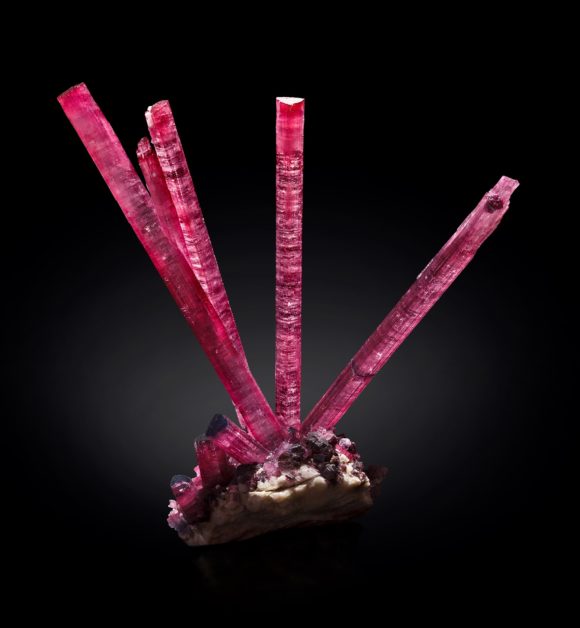
While Tourmaline crystals like this can not be found here, you can see plenty of amazing photos by clicking on this photo of a Brazilian Tourmaline cluster!
The Brown Derby Mine is best approached from U.S Highway 50 from a small turnoff approximately 6 miles east of the small settlement of Parlin and 17 miles east of Gunnison. Turn north here onto Forest Service road 802, also locally marked as the 44 Road. From here, continue north ~1.5 miles, bearing right at the ‘Y’ onto 802 north where some small granitic-looking outcrops start to become visible on your right. Continue on this fairly good dirt road north/northeast past a small stream crossing (may not be passable to passenger cars after recent rain or in the spring) and ~1 mile after the stream crossing, bear left at another fork up an obvious large ‘humpback’ like sagebrush-covered hill, passing a cattle fence (please respect local ranchers and close gate after your drive through!). Continue on this steepening road for another ~1.5 miles over somewhat rough terrain (4 wheel drive/AWD necessary, though high clearance is not mandatory for this section) until you reach a large flat ridgeline with small aspen trees in a grove on your left. This is a good camping spot. Continue until the road apparently disappears into the sage rush, then pick up another fairly good dirt road leading steeply downhill to the left/west towards now fairly obvious white pegmatite mine dumps below you. Continue down past several switchbacks to an eventual right turn through an open gate to a mine access road leading past an abandoned shack where core samples were stored/examined. The large dumps below you and the large gated adit to your right are the Brown Derby #1 Mine.
Tourmaline: Tourmaline is found in an impressive range of colors and several species at the Brown Derby #1 Mine. Of primary interest to collectors are large crystals and sprays of Elbaite variety Rubellite, which ranges from a dull whiteish-yellow color to choice ‘hot pink’ crystals reminiscent of Transbaikal, Russia or Stewart Mine, California rubellite crystals in color. While generally not gemmy, rare crystals to several cm. are found frozen in lepidolite and cleavelandite matrix, which do show gemmy, clear sections that could potentially yield small gems. An early 1970’s Denver Post article reported gem-quality elbaite in small amounts from the Brown Derby Mine (Eckels 1997), but the author has not seen any of this material in collections or institutions. Most impressive and aesthetic are radiating ‘sprays’ of parallel to sub-parallel pink Rubellite crystals set in coarse purple lepidolite matrix, with individual rubellite crystals up to 15 cm. or more in length. Early reports indicate that in several ‘pods’ in the core of the pegmatite, ‘logs’ of elbaite tourmaine crystals up to 30 cm. long showing ‘watermelon’ zoning with rubellite surrounding an elbaite core were found. The author has personally seen well-formed crystals up to 20 x 5 cm. in place. Also interesting are elbaite crystals which are either partially or fully psuedomorphed by lepidolite or muscovite, which are locally common. Large masses of tightly intergrowth elbaite crystals showing an amazing color gradation from lime-green to yellow to pink to reddish within a single crystal were also found fairly commonly (Staatz & Trites 1955). Staatz et al. (1955) looked at the geochemical variations within these crystals as a guide to color and color gradation, as well at petrogenesis of the pegmatite as a whole. Schorl is also found fairly abundantly at the Brown Derby #1 Mine, where it occurs in the wallzone and outer intermediate zones of the pegmatite, generally in subhedral to poor crystals, sometime radiating outward into the metadiorite.
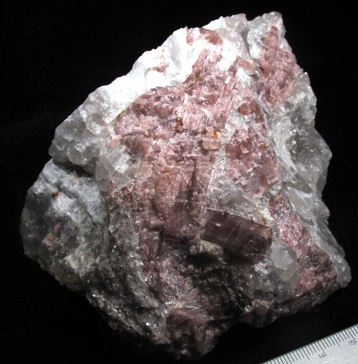
Figure 4: 4 cm. long, slightly gemmy hot-pink Rubellite tourmaline crystals in quartz with partial rubellite crystals surrounding it, Brown Derby #1 Pegmatite.
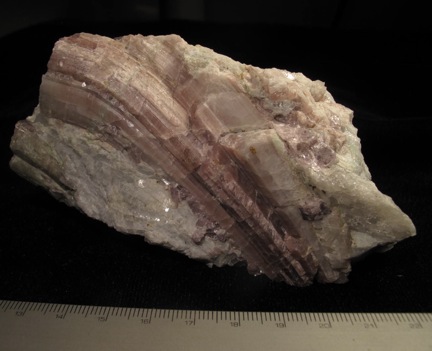
Figure 5: Naturally ‘curved’ Rubellite tourmaline crystal in Cleavelandite and lepidolite. Curvature resulted from tectonic movement in pegmatite during crystallization. Scale in cm.
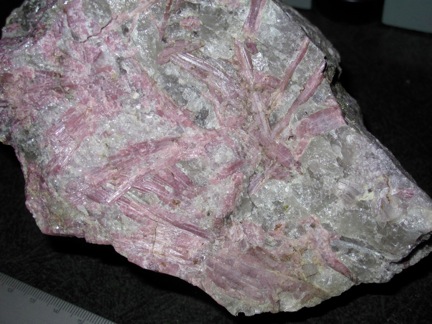
Figure 6: Spray of radiating pink Rubellite crystals to ~5 cm. in fine-grained lepidolite and quartz, similar to Stewart Mine, California material. ~15 cm. field of view.
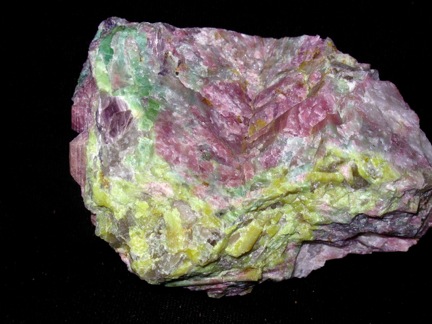
Figure 7: Good example of massive to coarsely-crystalline ‘polychrome’ tourmaline with gradation from pink to green to yellow, showing some translucent to slightly gemmy sections. Field of View 15 cm. across.
Lepidolite: Second after tourmaline in interest to collectors, and arguably more famous from the Brown Derby Mine is Lepidolite, the violet-colored lithium mica, which occurs here as ‘books’ and crystals to over 10” across! Books of lepidolite several inches across are common, and even 6” crystals are not unusual. Masses of nearly solid lepidolite 5-10 feet across can be observed in places in the pegmatite. Lepidolite along with other mica’s at the Brown Derby Mine were studied by Heinrich (1967), who also noted muscovite, zinnwaldite, and polylithionite, though the occurrence of the latter is questionable. In addition to the large tabular hexagonal ‘books’, lepidolite also occurs as large masses of fine-grained, equigranular crystals to several mm., which generally host more unusual species such as microlite or monazite. Finally, an unusual variety known as ‘ball lepidolite’ occurs locally in hemispherical masses up to 15 cm. composed of rounded, subparellel crystals, which supposedly have been worked into cabachons and other lapidary items. All lepidolite from the Brown Derby #1 Mine shows a handsome rich purple color and a generally bright luster.
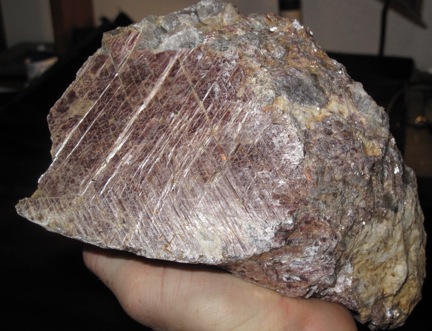
Figure 8: Large books of Lepidolite to 15 cm. across in quartz-cleavelandite pegmatite, hand for scale.
Monazite-(Sm): In addition to fairly common mineral like elbaite and lepidolite, the Brown Derby #1 Mine is also unusual in it’s concentration of more unusual rare earth element (REE) species. Arguably the most interesting of these is the recent discovery of Monazite-(Sm), though the possibility of this species at the Brown Derby Was first noted over 50 years earlier by the always astute E.M Heinrich (1960), who analyzed several monazite samples from the Brown Derby #1 Mine containing >10% Samarium(!) Colorado field collector and REE specialist Rudy Bolona collected several specimens of brownish-red massive Monazite associated with white Cleavelandite feldspar and lepidolite from a single boulder on the dumps in 2009, and subsequently has a sample sent to Dr. George B. Morgan at the University of Oklahoma, who analyzed it to be the very rare species Monazite-(Sm), found only at 3 other localities worldwide. While all monazite samples from the Brown Derby #1 Mine analyzed by Heinrich (1960) appear to contain enough Sm to qualify as Monazite-(Sm), Monazite-(Ce) also occurs at this deposit, so it is not safe to assume that all monazite collected at the Brown Derby #1 is Monazite-(Sm). Monazite-(Sm) occurs at the Brown Derby #1 Pegmatite as subhedral masses to crude crystals up to ~6.5 cm. across, typically embedded in fine-grained lepidolite with cleavelandite feldspar and quartz. The Brown Derby #1 occurrence may represent the best locality in the world for this rare species, and new finds of this rare mineral are possible on the extensive dumps.
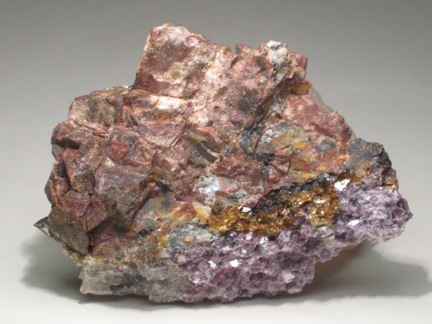
Figure 9: Massive reddish-brown Monazite-(Sm) (analyzed) with purple lepidolite, 6.8 cm. across. (Photo copyright Rudy Bolona/mindat.org)
Pollucite: The Brown Derby #1 Pegmatite represents the only Colorado locality for this rare cesium species, which occurs as two large, ~30 cm. wide massive pods in the central core zone of the pegmatite, along with large crude crystals of opaque topaz, cleavelandite, and quartz (personal communication with Rudy Bolona, September 2009). No crystallized material is known, nor has this mineral been reported from the dumps.
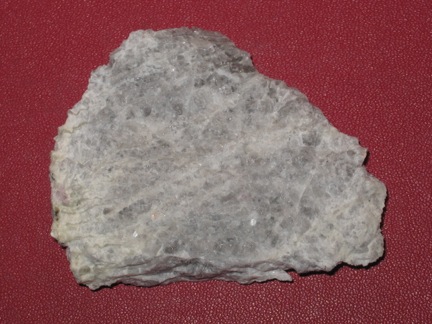
Figure 10: Massive white crystalline Pollucite, 6.5 cm. across. (Photo copyright Rudy Bolona/mindat.org)
Stibiotantalite: Stibiotantalite is a rare Antimony Tantalum Niobium Oxide species found in LCT-type pegmatite’s and was first described from the Brown Derby #1 Pegmatite by Heinrich & Giardini in 1957. It occurs as subhedral to poorly euhedral crystals generally 1-2 cm. but rarely up to 5 cm. associated with the secondary Tantalum species Rynersonite as a white to cream surface alteration of the stibiotantalite. Heinrich & Giardini found stibiotantalite on a large boulder on the dumps of the #1 Pegmatite, and thought that possibly all the stibiotantalite in the #1 pegmatite was contained in this single block, a large mass of cleavelandite, topaz and lepidolite from the core margin core. However, recent finds of small Stibiotantalite crystals by Colorado collectors on the dumps would argue otherwise.
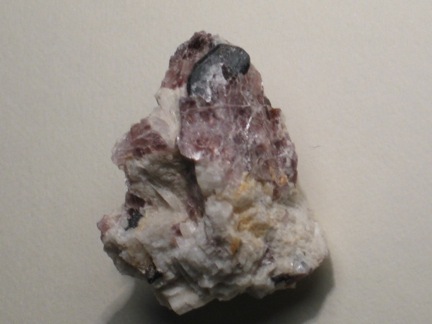
Figure 11: Well-formed 8 mm. long Stibiotantalite crystal on lepidolite-cleavelandite pegmatite, collected recently on the dumps. (Photo copyright Rudy Bolona/mindat.org)
Columbite-(Fe): Columbite-(Fe), the Fe-analogue of the Niobium oxide species Columbite, is found in several assemblages at the Brown Derby #1 Pegmatite. In the core margin zone of the pegmatite, it is found with Cleavelandite feldspar, quartz, and mica minerals as large, crudely euhedral crystals to 10 cm. In the border zone of the pegmatite, especially towards the hanging wall contact with the metadiorite, it is found as small (<5 cm.) grains and crude crystals associated with reddish albite/perthite, Euxenite-(Y), and Monazite-(Ce). Nowhere at the Brown Derby deposit is Columbite-(Fe) an especially common nor conspicuous constituent, however it does occur through a wide portion of the pegmatite.
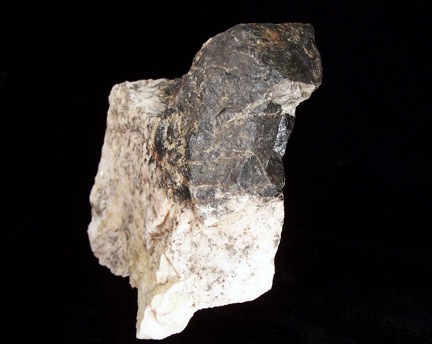
Figure 12: Partial crude crystal of Columbite-(Fe) in albite, 8 x 6 cm. (Photo copyright Dean Allum/mindat.org)
Euxenite-(Y): A glassy green metamict Rare Earth species, previously identified as Betafite in some literature, is now believed to be Euxenite-(Y) (Heinrich 1967). Euxenite-(Y) is restricted in occurrence at the Brown Derby pegmatite to a core-margin albite replacement near the upper north margin of the core, but may exist in other unrecognized or mined-out zones as well. It occurs here as metamict masses to 4 cm. in weathered red albite with schorl and columbite-(Fe), and is highly radioactive.
Monazite-(Ce): Monazite-(Ce) occurs at the Brown Derby #1 pegmatite in several assemblages, making non-quantitative distinguishing from Monazite-(Sm) difficult to impossible. It is found as fairly sharp euhedral crystals to ~2.5 cm. in red albite with columbite-(Fe), probably from an analogous assemblage to the aforementioned Euxenite-(Y) zone. The Harvard University Mineralogical museum has several excellent crystallized specimens, one of which (HMM #104814) is pictured here.
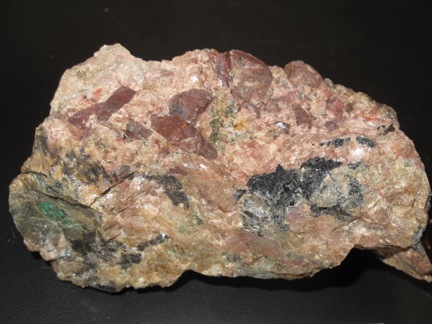
Figure 13: Well-formed crystals of Monazite-(Ce) to 2.4 cm. in perthite-albite-biotite pegmatite, Harvard Mineralogical Museum #104814.
Microlite: Microlite, the complex tantalum oxide species, is known from several zones of the Brown Derby #1 Pegmatite and was one of the significant economic minerals of this deposit, though the present distribution of microlite in the dumps and in-situ would suggest otherwise. This is probably due to the fact that microlite occurred in concentrated ‘shoots’ or elongated pods in fine-grained lepidolite-quartz-cleavelandite pegmatite, a mode of occurrence similar to that at the famous Harding Pegmatite in New Mexico. These ‘shoots’ were mined selectively for their microlite content, and ~1200 pounds of Microlite was concentrated and stockpiled for processing, though it is unclear if this material was ever actually sold (Hanley 1950). Hanley also estimates that ~9,000 lbs. of microlite remained at the time of his study in 1944 at the Brown Derby #1, though it is unclear how much of that has been mined since. Mineralogically, microlite forms small crude to somewhat euhedral octahedral crystals to 1 cm. with a resinous brown to black luster and distinctive radiation ‘burn halo’s’ in the surrounding lepidolite. These crystals are often quite radioactive and may in fact be uranomicrolite.
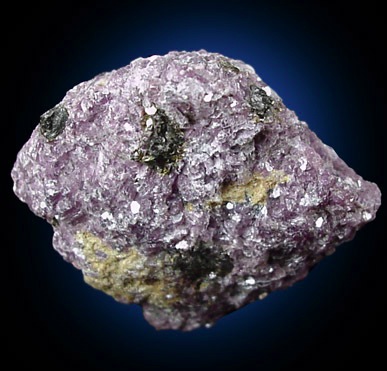
Figure 14: Microlite in crude 3-4 mm. crystals in fine-grained purple Lepidolite; specimen 4 cm. across. (Photo copyright John Betts/mindat.org)
Other accessory species: For the sake of brevity as well as the fact that they do not occur in ‘collector-quality’ crystals, other species such as Topaz, Beryl, Garnet, and Bismutite will not be discussed in detail here. Suffice it to say that they are present at the Brown Derby #1 Pegmatite, and a quick search of the already extensive literature on this deposit will yield many interesting references.
In closing, the Brown Derby #1 Pegmatite remains one of the more interesting and unusual pegmatite deposits in Colorado, and unlike many similar localities, a large portion of the dumps as well as surrounding prospects remain both on public land as well being as accessible to vehicles. The Brown Derby #1 deposit is also unusual in that while it continues to yield excellent, aesthetic specimens of relatively common minerals such as Rubellite tourmaline and lepidolite, finds of extremely rare species such as Monazite-(Sm) have also been made recently. If you plan to visit from Brown Derby #1 Pegmatite, please be respectful of local claim holders and property owners and exercise safety and common sense around the large dumps and potentially dangerous mine faces and outcrops. With persistence and luck, this locality should continue to yield great mineral specimens for many years to come.
References
1.) ‘Mica’s of the Brown Derby Pegmatites, Gunnison County, Colorado’, Heinrich, E.M, The American Mineralogist, Volume 52, July-August 1962.
2.) ‘A New Lepidolite Deposit in Colorado’, Eckel, F.B., American Scientific Society, 16, pp. 239-245.
3.) ‘Lithia Pegmatites of the Brown Derby Mine, Gunnison County Colorado’, Hanley, John B., 1946, American Mineralogist 31, 147.
4.) ‘Pegmatite Investigations in Colorado, Wyoming and Utah: 1942-1944’, E.M Heinrich et al., USGS Professional Paper Paper 227, 1950.
5.) ‘Stibiotantalite from the Brown Derby #1 Pegmatite, Colorado’, Heinrich, E.M & Giardini, A.A., American Mineralogist 45, pp. 728-731, 1960.
6.) ‘The Quartz Creek Pegmatite District, Gunnison County, Colorado’, Staatz, M.H. & Trites, A.F., USGS Professional Paper 265, 1955.
7.) ‘Paragenesis of the Topaz-Bearing Portion of the Brown Derby #1 Pegmatite, Gunnison County Colorado’, Rosenberg, P.E., American Mineralogist 57, 571-583, 1972.
8.) Mindat.org, accessed 8-01-2013 to 8-15-2013.

Related posts:
Cascade Canyon Ruby Crystals – A Los Angeles Hidden Gem
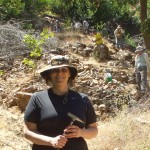
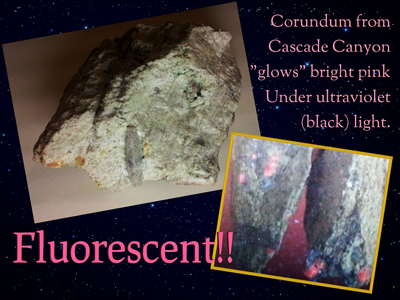
Cascade Canyon, located exactly 1.7 miles southwest of Mt. Baldy, is the home to many interesting, if small, minerals and veins of interesting polishable minerals. Collecting around the top and bottom of the canyon, we have found various qualities and sizes of corundum var. ruby along with small veins of beautiful, if hard to come by, pieces of lapis. In addition, we have found minerals that the area is not well known for, including small dravite crystals, epidote, diopside and uv reactive calcite.
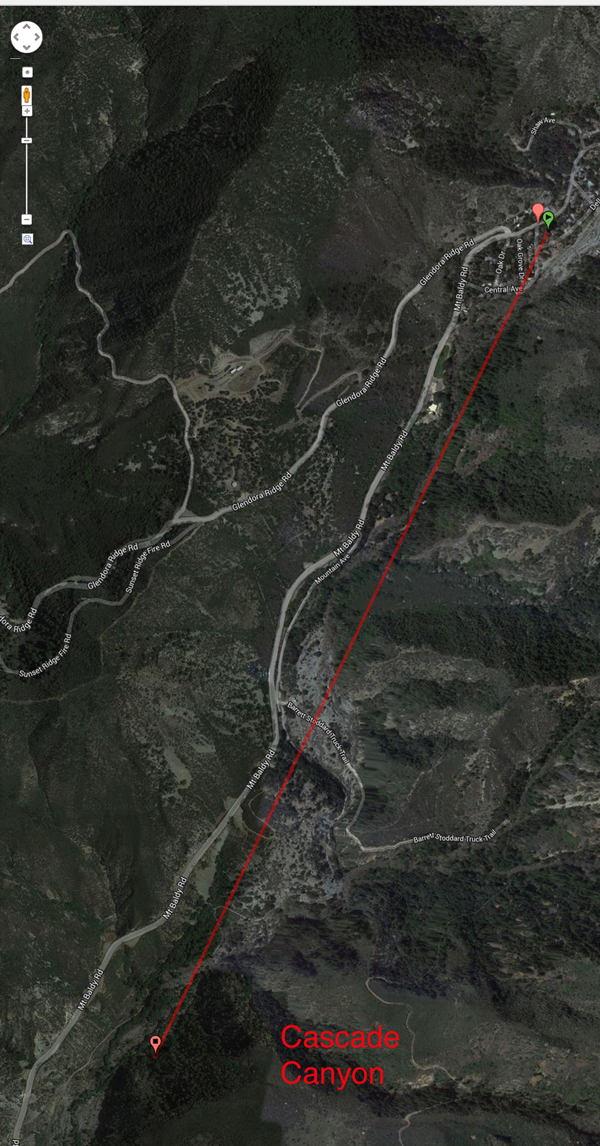
The lapis deposit is near the top of the mountain, with no access that would be considered even reasonably obtainable by anyone who is not well versed in mountain climbing. In addition, the area of the deposit was covered in an avalanche years ago. Anyone attempting to reach this deposit would be doing so at risk of life itself. In the upper streams of cascade canyon, before it turns into what would be impassible for most, bits and pieces of lapis can be found. Most people we have interviewed who have collected there in the past are happy with one visit to the location.
On Barrett-Stoddard Road, though closed to vehicle traffic, you can find interesting mineralization along the roadside, which is now a popular hiking/biking trail. Calcite veins with Diopside crystals have been located, however, the diopside is not crystallized well, with a melted appearance. The corundum locations along the roadside give the viewer a understanding that the deposit of “ruby” stretches along the entire mountainside.
Along the bottom of the canyon, on the south side of cascade canyon, along the area where the mountain follows the river on the lip of the eastern mountainside. While boulders of ruby bearing matrix can be found EVERYWHERE along the mountainside, the most popular collecting location is a small canyon that dumped out the contents of several rockslides into the valley below, creating a field rich with broken chunks of rocks with small ruby crystals inside.
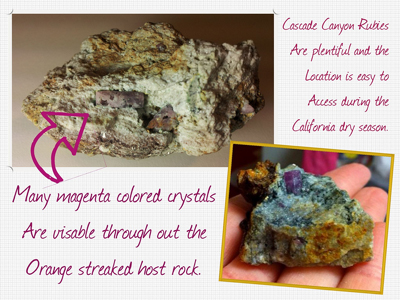
We were delighted to read Natalie Weisiger’s article about her trip to Cascade Canyon with the Gem and Mineral Council of the Los Angeles Natural History Museum. You can read about it, right here at http://omigems.com/blog/2013/07/california-corundum-from-the-ground-to-my-finger/ It is very interesting to read about the California ruby coming from the ground and into a piece of jewelry. You can certainly believe that is one unique piece of jewelry!
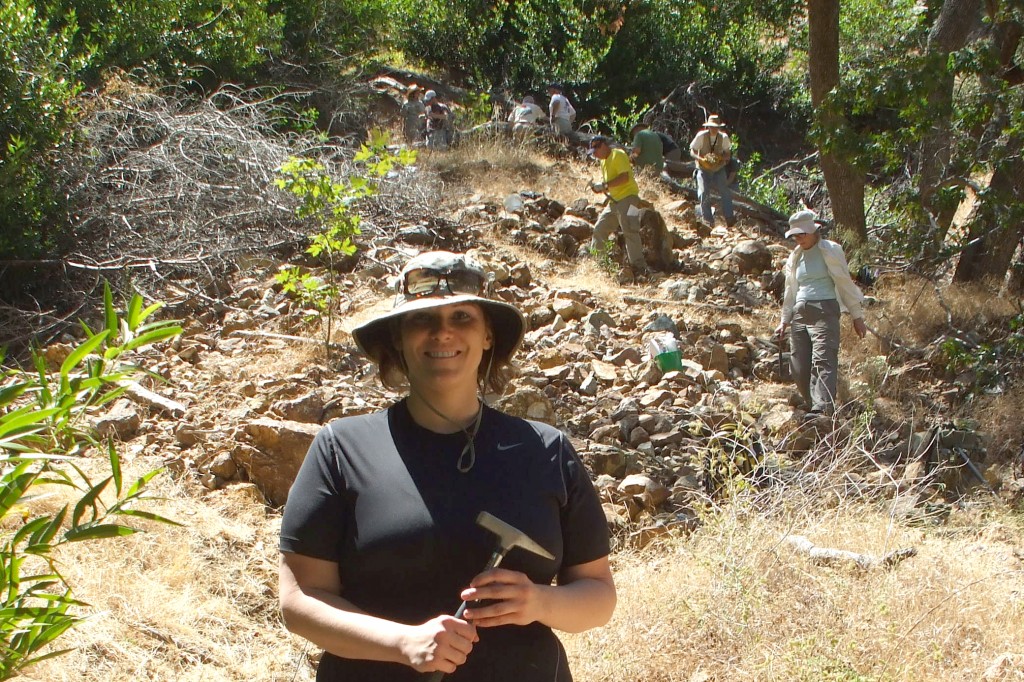
Natalie Weisiger in front of the landslide pile of ruby bearing rocks on the south side of Cascade Canyon
Related posts:
This “Living Rock” is as CRAZY as a talking mammal on two legs!
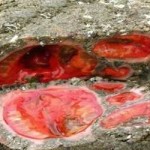
The Ancestors of Us All
By Jeremy Zolan
If you’re friends with scientists, nature lovers, or enthusiasts of everything strange, you may have seen the article Crazy living rock is one of the weirdest creatures we’ve ever seen by Grist making rounds on social media lately. Prominently featured at the top of the article is a picture of said creature, which is actually an ascidian called Pyura chilensis- piure if you speak Spanish, a member of a subphylum called the tunicates. Diverse in color and morphology, these primitive inhabitants of oceans worldwide aren’t part rock, but actually are very close relatives of vertebrates due to their peculiar nervous system. Although they are technically invertebtrates because they have no bones or cartilage, they possess a very primitive spinal cord called a notochord that renders them closer relatives to fish. In the larval stage, most tunicates look like microscopic fish or tadpoles and freely swim until they find substrate to attach themselves. When they do, they change shape into a sessile form with siphons similar to those of clams to feed on plankton in the water column. The tail of the larval tunicate shrinks, the notochord dissolves, and the body becomes enlarged. Some species such as the piure live in colonies of many individuals and some are invasive and have outcompeted native benthic fauna, especially those found in the Mid-Atlantic and New England region.
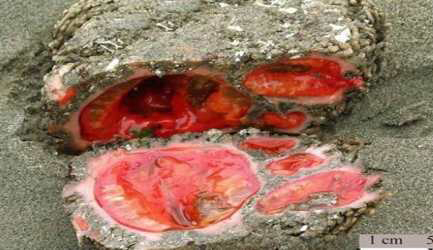
Typical cluster of Pyura clustered together, creating a meaty looking rock.

Pyura Chilensis being served as food
Equally as peculiar is the mysteriously high concentration of vanadium found in the tunicates. Vanadium is an unusual but not uncommon metal that exists in many brightly colored oxidation states. Usually, vanadium as the vanadyl cation (vanadium in its 4+ oxidation state double bonded to oxygen) is only necessary as a minor trace element in biology. Tunicates however have up to ten million times the amount of vanadium in their bodies that other living things do. They use it in the form of a vanabin- a vanadyl-protein complex possibly employed for oxygen transport. This is somewhat of a mystery; there is no scientific basis for this because tunicates another oxygen binding metalloprotein as well- hemocyanin, a blue copper containing complex found in many kinds of marine life. It is thought that this molecule could handle all of a tunicate’s needs for oxygen transport. Much research is being done in this field so we may know the answer.
Tunicates are also edible and while you may be unappetized by something that looks like the Horta from Star Trek, many Chileans, Japanese, and Koreans call them dinner. In Korea, they are typically eaten raw as hoe (raw seafood) with seasonings like soy sauce and chogochujang, a spicy chili paste. Koreans do use them in soups, stews and other dishes like bibimbap. In Chile, the rocklike piure are eaten raw with lime or in a soup which is a bit like a Chileno bouillabaisse. Tunicates are quite common on the seashore and though they may look extremely terrifying, in this day of farm to table eating and waste-not want-not ethos surrounding food, why get all squeamish over trying a bit of alien looking seafood?
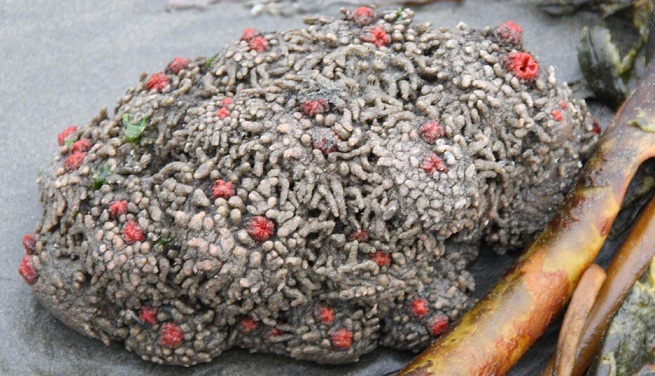
Pyura Chilensis cluster
References:
Michibata H, Uyama T, Ueki T, Kanamori K (2002). Vanadocytes, cells hold the key to resolving the highly selective accumulation and reduction of vanadium in ascidians. Microscopy Research and Technique. Volume 56 Issue 6, Pages 421 – 434
Tatsuya Ueki et al (2003). Vanadium-binding proteins (Vanabins) from a vanadium-rich ascidian
Ascidia sydneiensis samea
http://ir.lib.hiroshima-u.ac.jp/metadb/up/74006214/BBA_1626_43-50_2003.pdf
Related posts:
2013 Gilsum Rock and Mineral Show Report
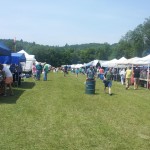
Show Report: 49th Annual Gilsum Rock Swap
by Jeremy Zolan – http://earthsurgery.tumblr.com
The Gilsum Rock Swap- http://www.gilsum.org/rockswap is one of the more popular New England mineral shows and is held in the rural town of Gilsum. New Hampshire. Gilsum is at the heart of an area very rich in pegmatites, many formerly mined for mica and beryl. New Hampshire has many great and diverse mineral localities. It is well known for its pegmatites which are both numerous and mineralized in rare species including several type localities most numerously found at the Palermo No. 1 Mine http://www.mindat.org/loc-3942.html. The miarolytic granites in the White Mountains region have produced many large, well crystallized pocket specimens of smoky quartz, amethyst, microcline, topaz, and rarer minerals such as arfvedsonite and danalite. Low temperature hydrothermal veins in the southwest corner of the state have produced fine fluorite crystals of a deep apple green color, notably from the William Wise mine- http://www.mindat.org/loc-4521.html.The Gilsum Rock Swap is an awesome way to celebrate the amazing mineralogy that New Hampshire has to offer.
In addition to being one of the few outdoor mineral shows in the region, a very large percentage of the material offered by vendors attending has been found locally. It’s also a great opportunity to catch up with field collectors and learn about recent finds and new localities. Swapping is encouraged at this show, so people often show up with their own personal finds to show off and trade. There were also two talks by Steve Garza on prospecting for mineral specimens and one by Bill Petronis on how to find Herkimer diamonds. I think it is great that the focus of the presentations is teaching practical skills in finding mineral specimens. The Gilsum Rock Swap is one of my favorite mineral shows and is still going strong after it’s 49th year.
This year’s Gilsum Swap was the first mineral show I attended as a dealer, however I did also take much time to look around and talk to local collectors. I am always amazed at the abundance of fine, local material available for unbeatable prices at this show; proof of that was the stock of Tom Minnich. Tom is an avid field collector and member of the Keene Mineral Club. He has collected many fine specimens throughouth New England, New York, and Nova Scotia.
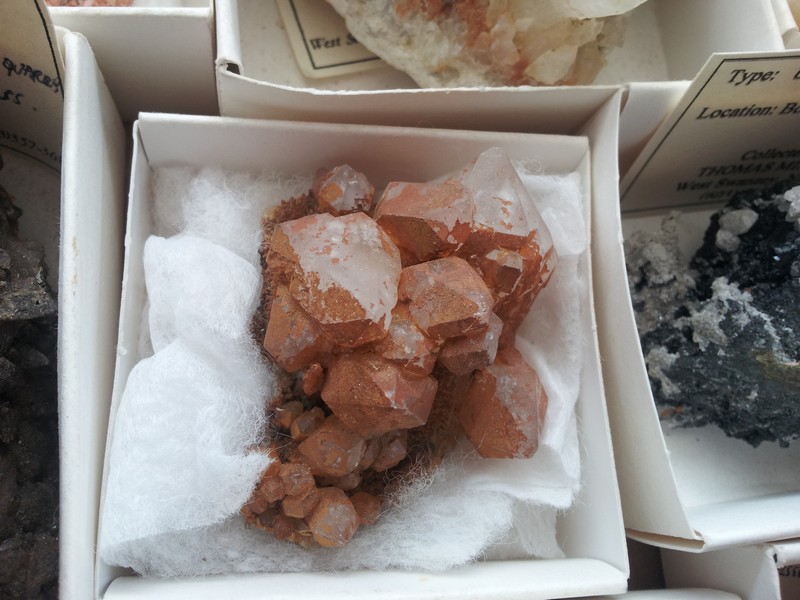
A nice quartz cluster from Chesterfield Hill, Keene, Cheshire Co., New Hampshire. Specimens from here aren’t well known but quite nice. Some pretty big scepter quartzes have been collected from this near monomineralic vuggy low temperature hydrothermal quartz vein deposit in Clough quartzite. Tom is the guy to go to for these specimens.
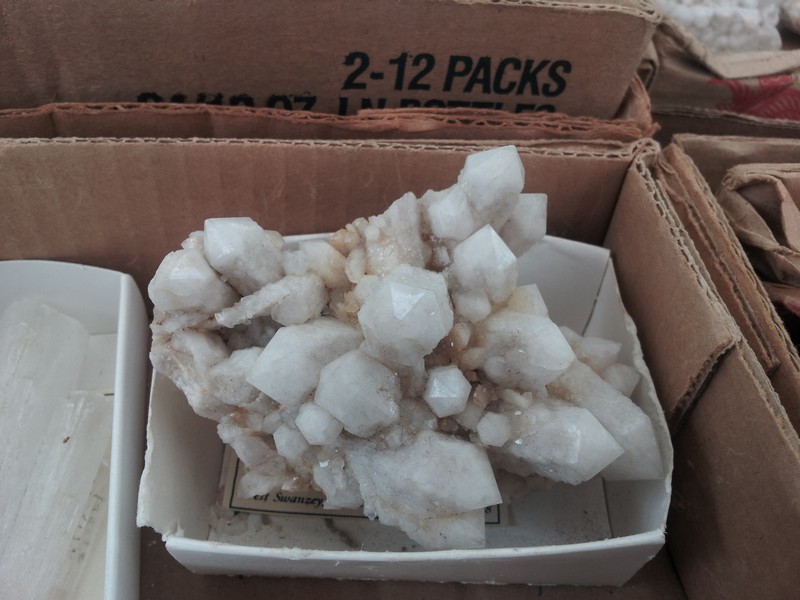
Another nice quartz specimen from Diamond Ledge, Stafford, Connecticut. I really loved the aesthetics of this piece.
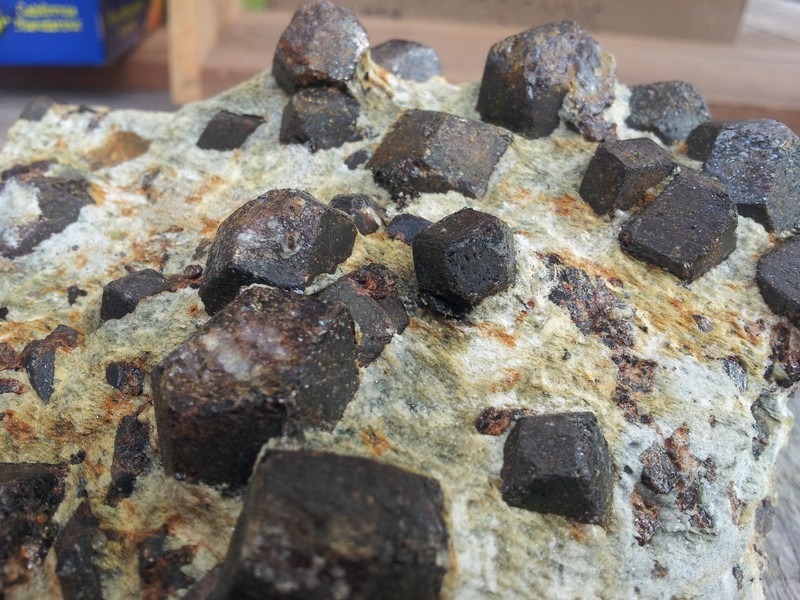
Tom also had this great large cabinet specimen from the now closed Green’s Farm Garnet Mine in Southbury/Roxbury Connecticut. Here’s a closeup view. This past year the property received a new land owner that does not approve of collecting in the mine. It’s a real loss for Connecticut’s mineral heritage- this used to be THE PLACE for taking people just getting into mineral collecting considering the abundance of well formed garnets at the locality.
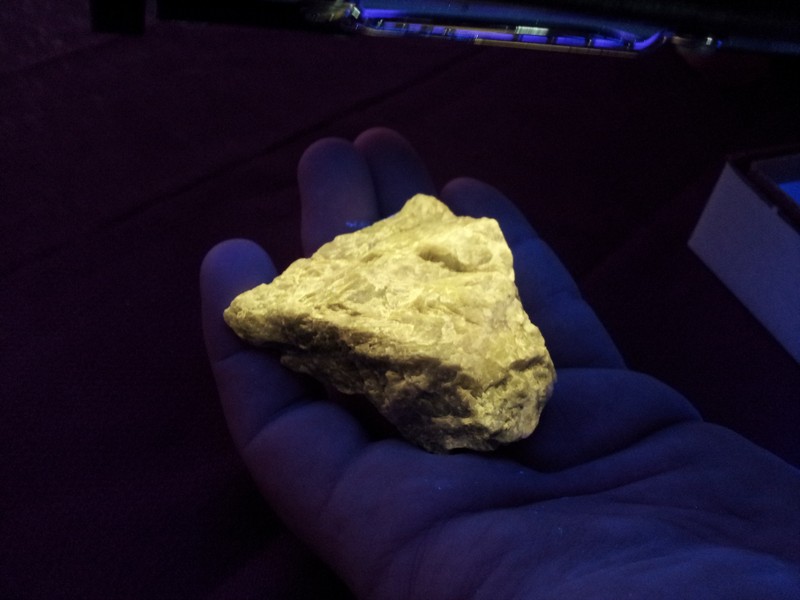
There weren’t many new local finds from New Hampshire at the Gilsum Swap but Patrick Bigos from Midnight Minerals (http://midnightminerals.com/) had large, vibrant yellow fluorescing pieces of fluorescent manganapatite from the Ham and Weeks Quarry in Wakefield, NH. Yellow fluorescing manganapatite is found in many New England pegmatites but these specimens from Ham and Weeks are very large and brightly fluorescent.
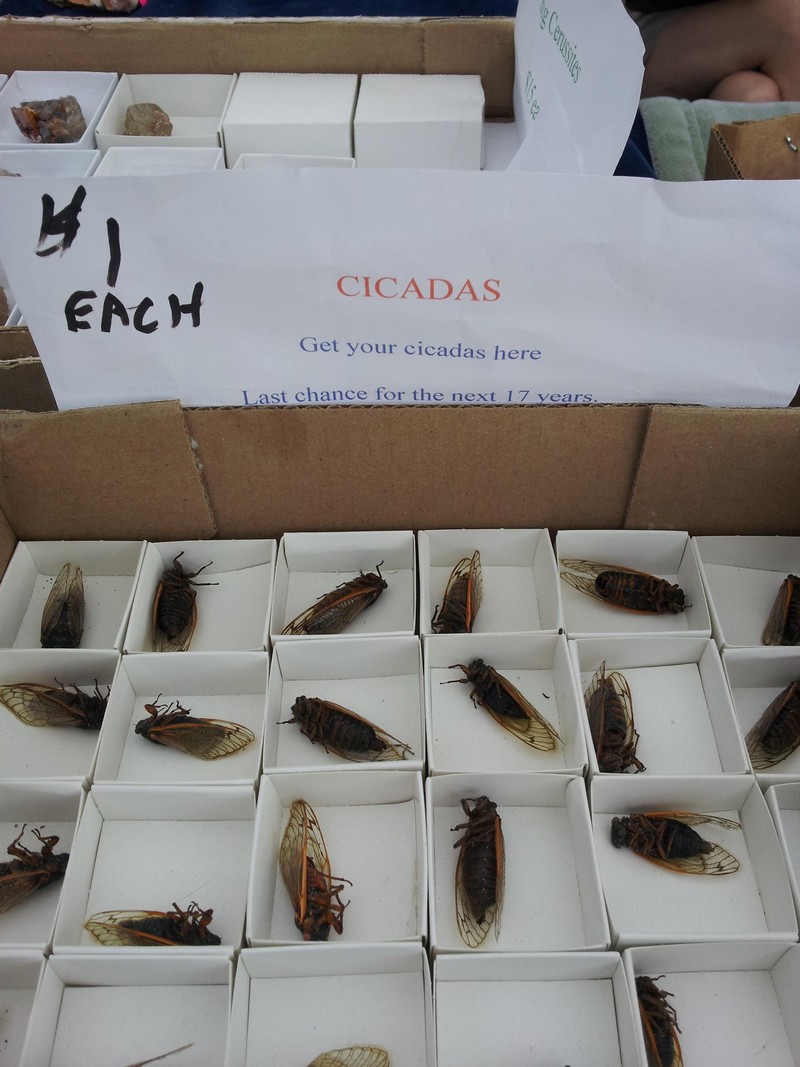
A rare chance to get your own seventeen year cicada!
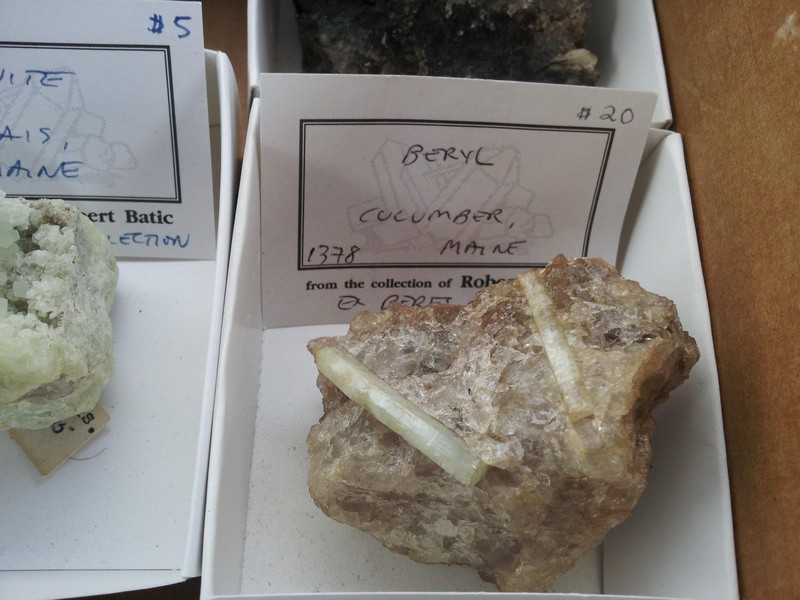
Here’s a specimen of beryl from an odd locality- Cucumber, Maine!! Robert Batic had bits and pieces from several old local collections at the show featuring many interesting locality pieces and some old classics too.
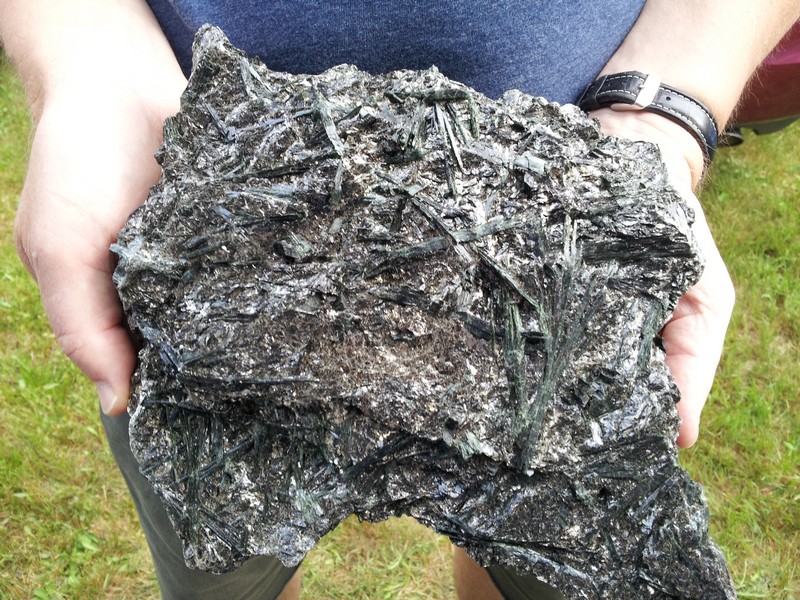
Mr. Batic also had this huge actinolite specimen from the Carlton Talc Mine in Chester, VT. Some big crystals on this one!
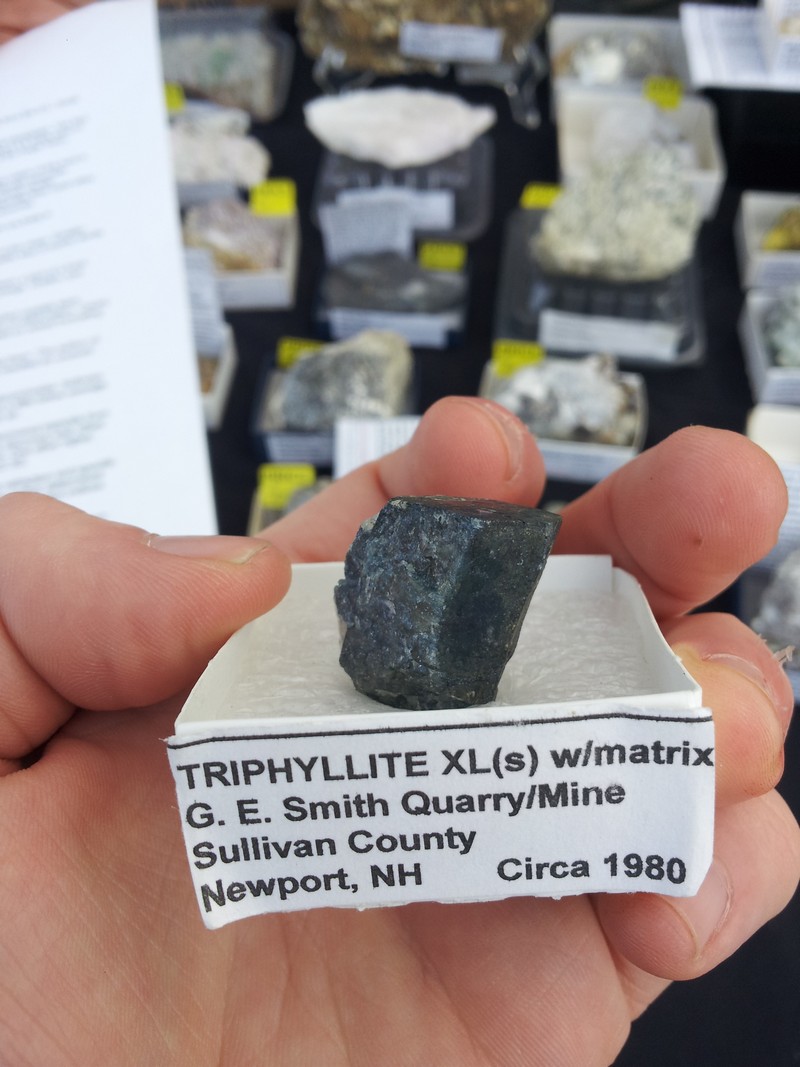
Friends from Mindat Linda and Don Kauffman of Lindon Mineralogy had a lot of esoteric New England material. Of particular note was this small well-formed triphylite crystal from the G.E. Smith Quarry in Newport, NH.
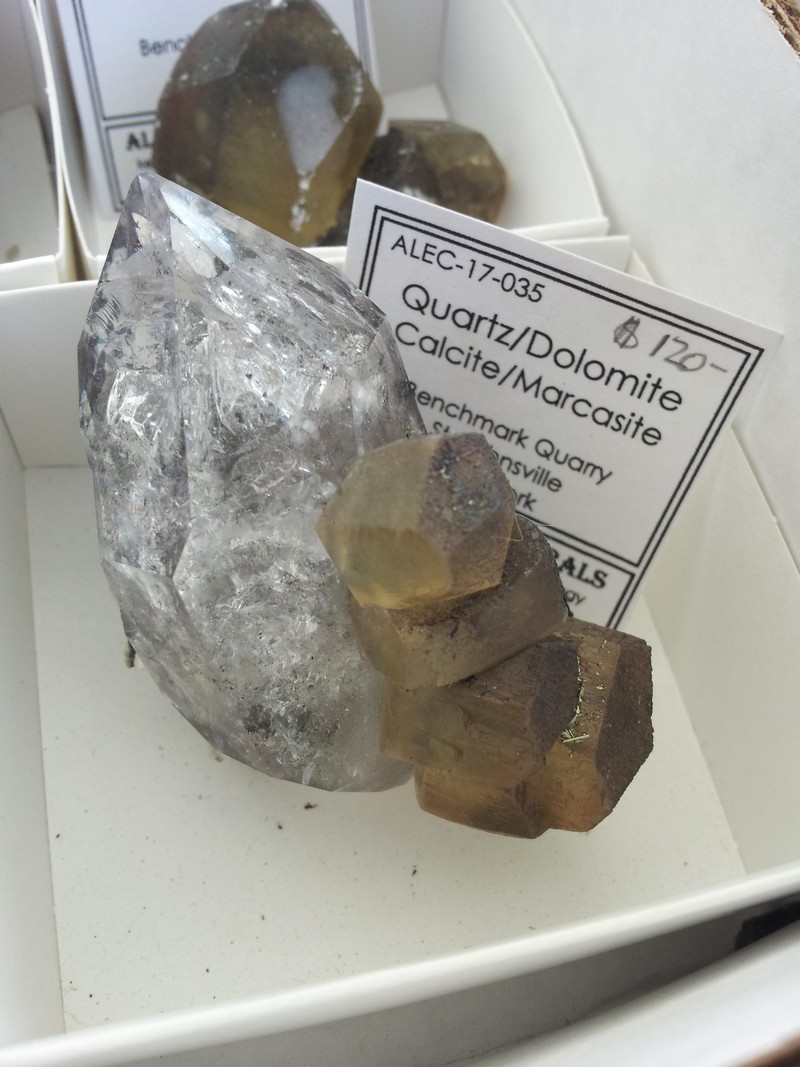
Rocko Minerals had quite a few awesome Herkimer diamonds with calcite, dolomite, and pyrite from the Benchmark Quarry. These came from an old and very fine collection of Herkimer material. This locality formerly produced amazing Herk combination specimens but is now totally off limits to collecting. It’s tragic that amazing pieces like this are now just tossed into the rock crusher!
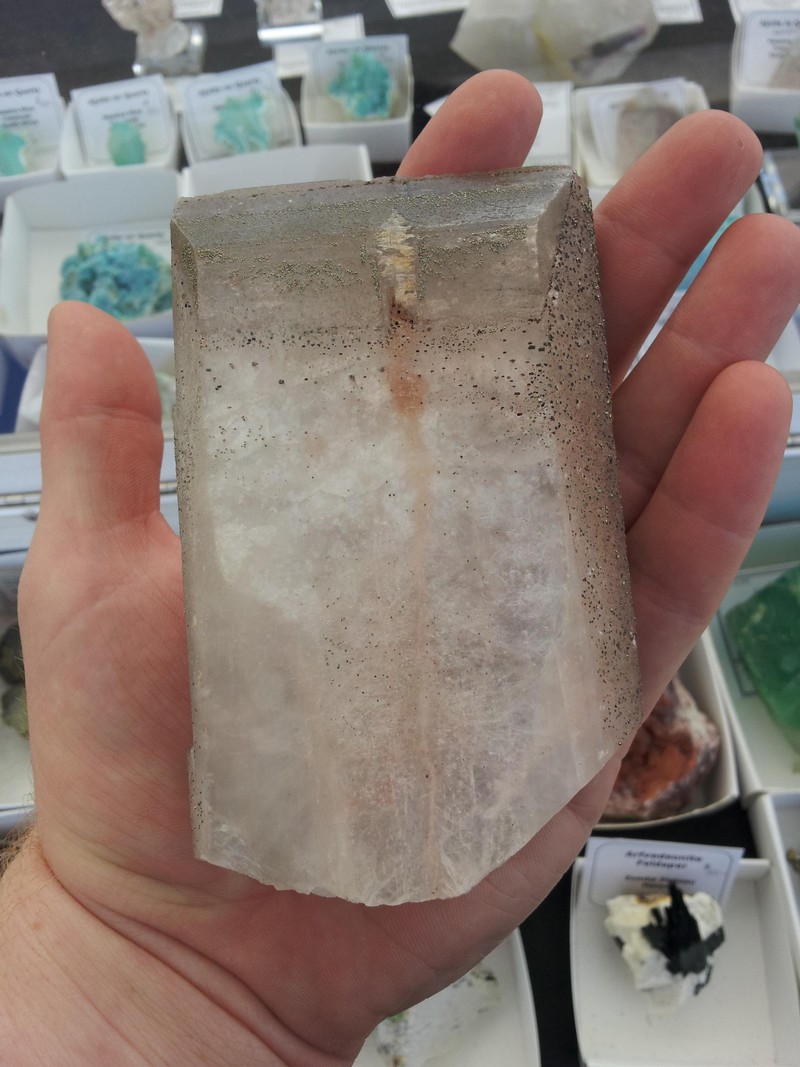
Rocko also had this huge baryte crystal with pyrite from the Niobec Mine in Quebec- this carbonatite hosted niobium mine is famous for giant crystals of baryte. This is a pretty good one.
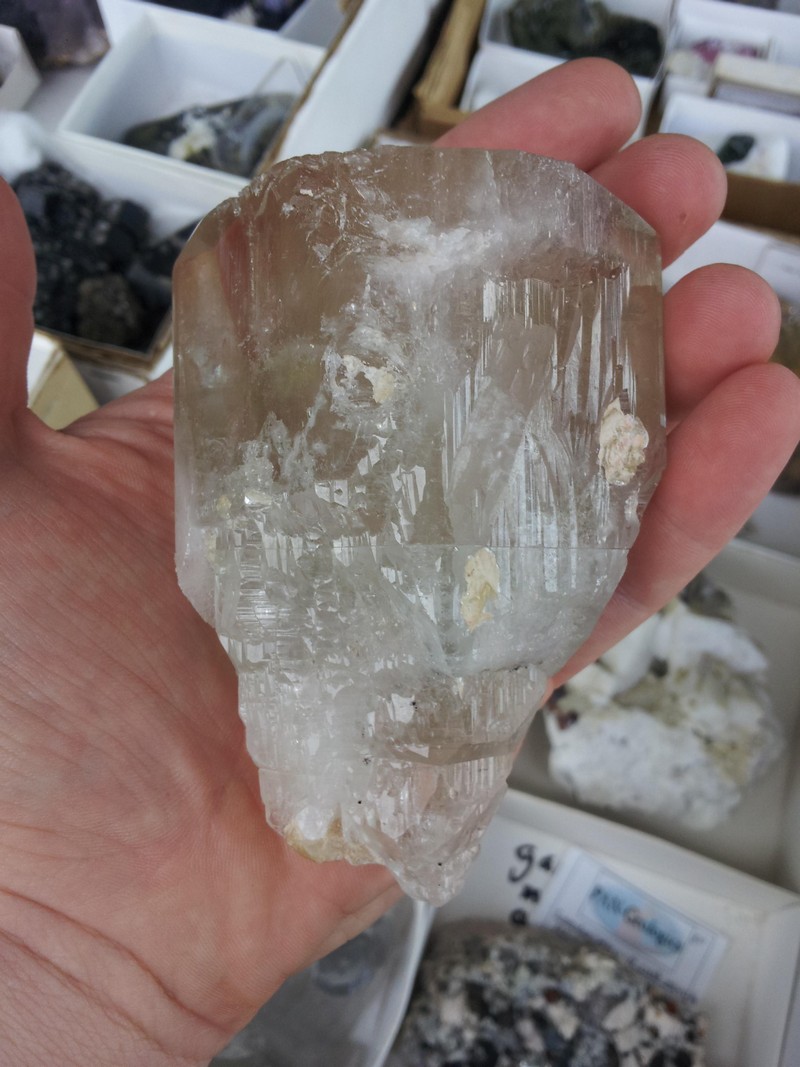
My former mineralogy and petrology professor Dr. Peter Nielsen of Keene State College showed me this wonderful scepter topaz from the Kandahar Mine in Braldu, Pakistan
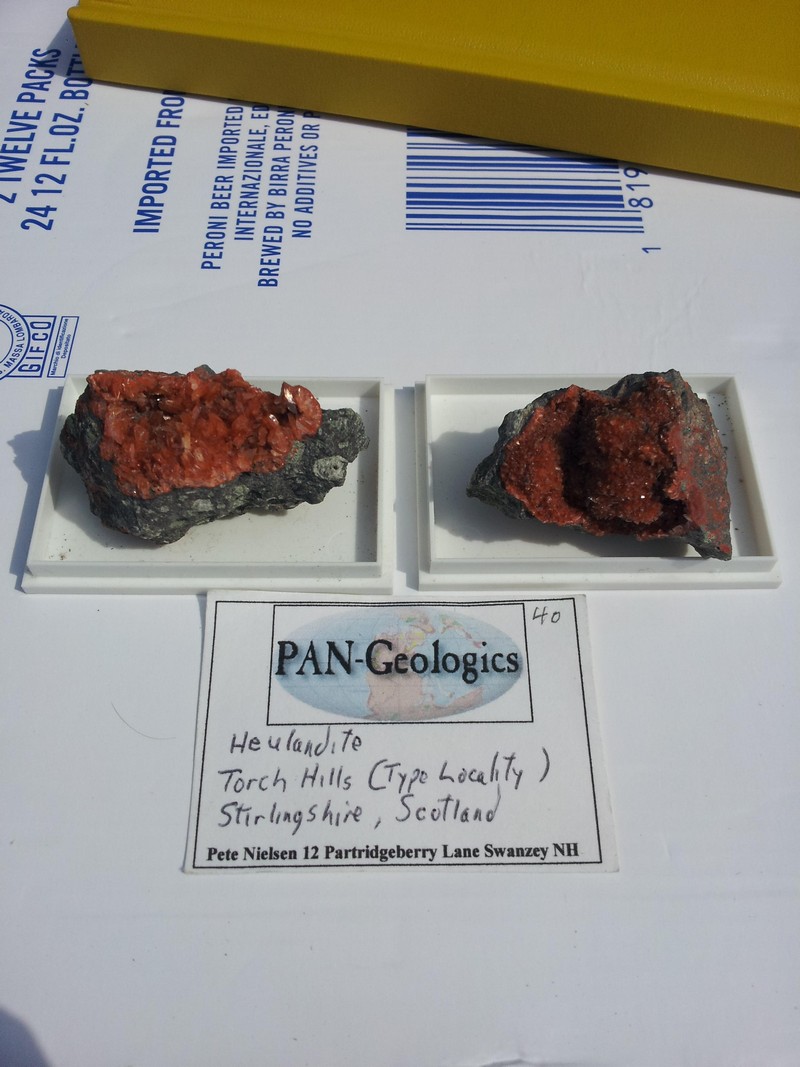
Dr. Nielsen knows that I enjoy unusual specimens more than anything else, so he showed me these two great specimens of Heulandite-Ca from the type locality of Torch Hills, Scotland. I’ve never seen specimens from this locality in person! Apparently they were collected within a day’s time from the base of a dam when the water levels were unusually low.
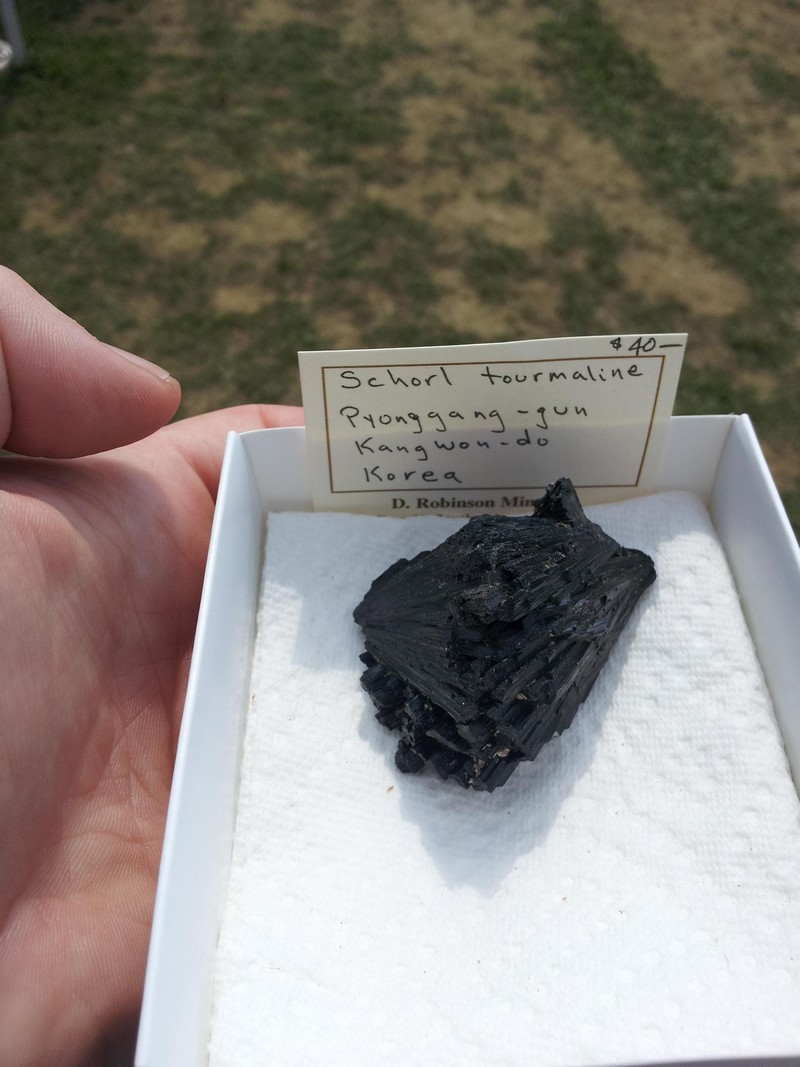
D. Robinson Minerals usually has amazing things from unusual localities. My favorite that he had were his Korean specimens. Here’s a schorl that was collected right outside of Pyongyang before the Korean War.
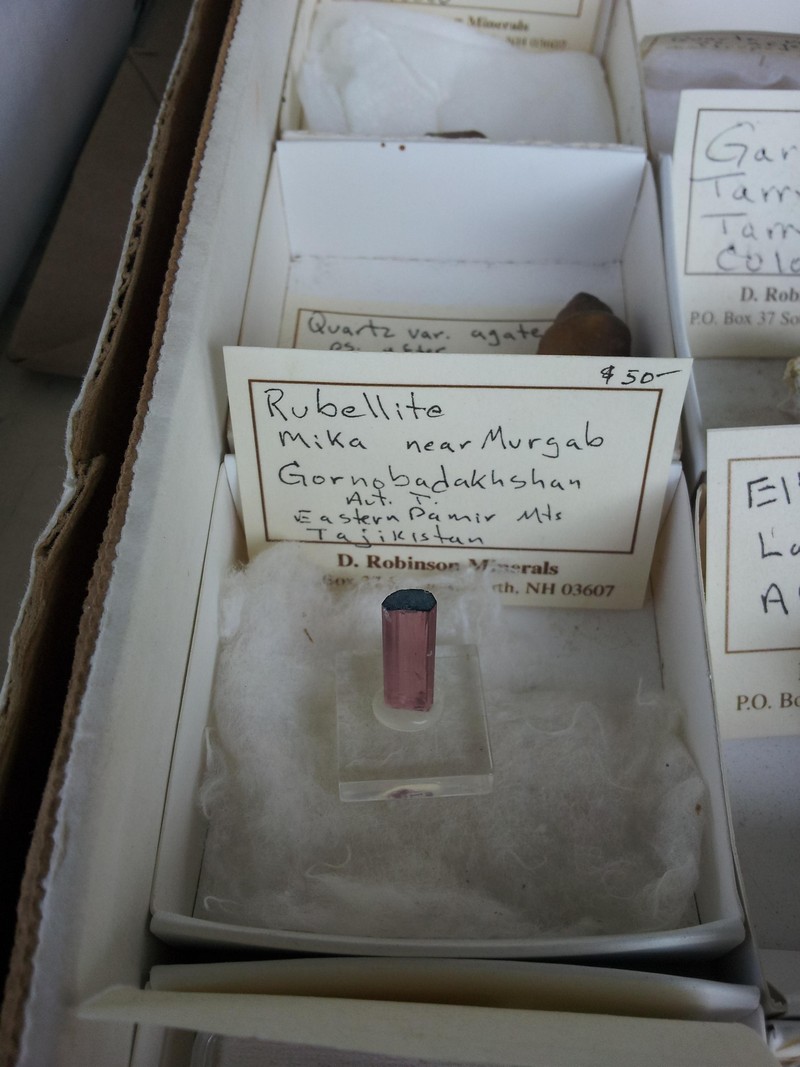
The Pamir Mountains in Tajikistan have some rich pegmatites that unfortunately don’t produce many specimens. This tiny rubellite with a foitite (not proven but likely) cap show the kind of potential the region has.
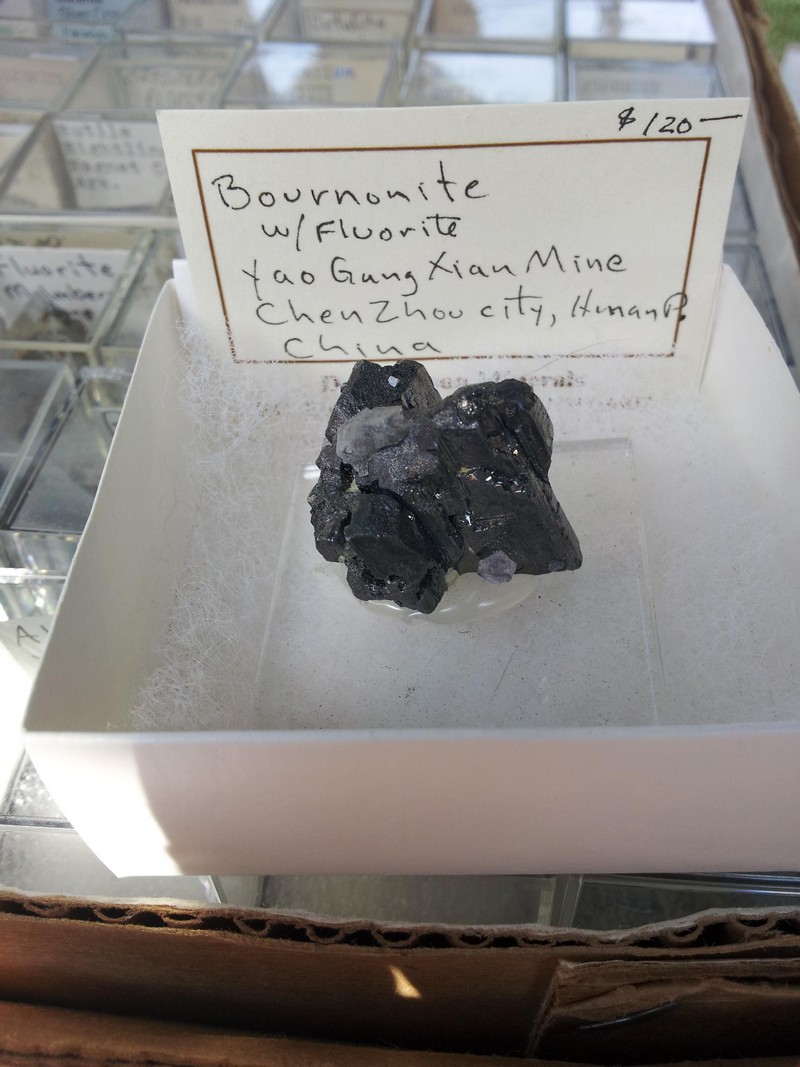
Doug also showed me this Yaogangxian piece that featured both twinned bournonite and twinned fluorite crystals!
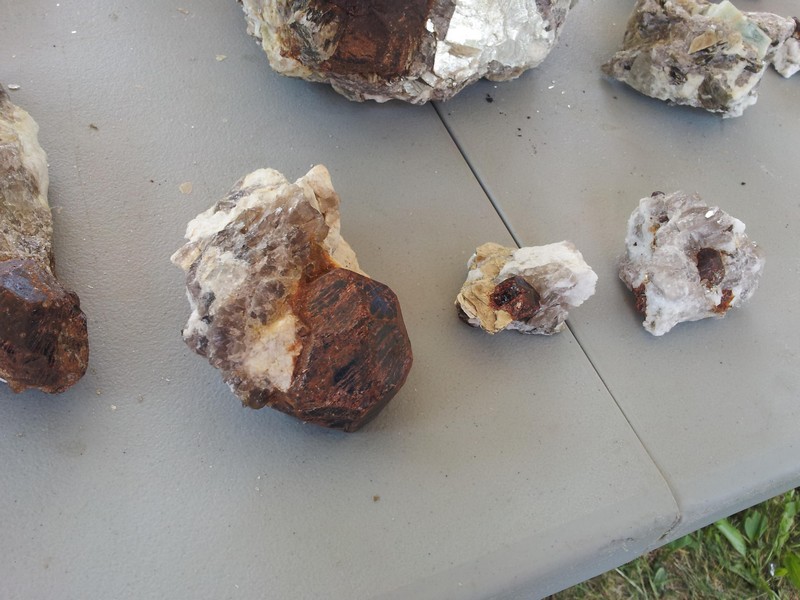
Wayne Corwin of Toveco is an avid Mindat member and always a familiar attendee of the Gilsum Swap. Wayne mines the Tripp Mine in Alstead, New Hampshire for aquamarine specimens and gem rough. He also encounters specimens of other material such as almandine garnets and schorl at this mine. He showed me some especially large trapezohedral almandines in matrix.
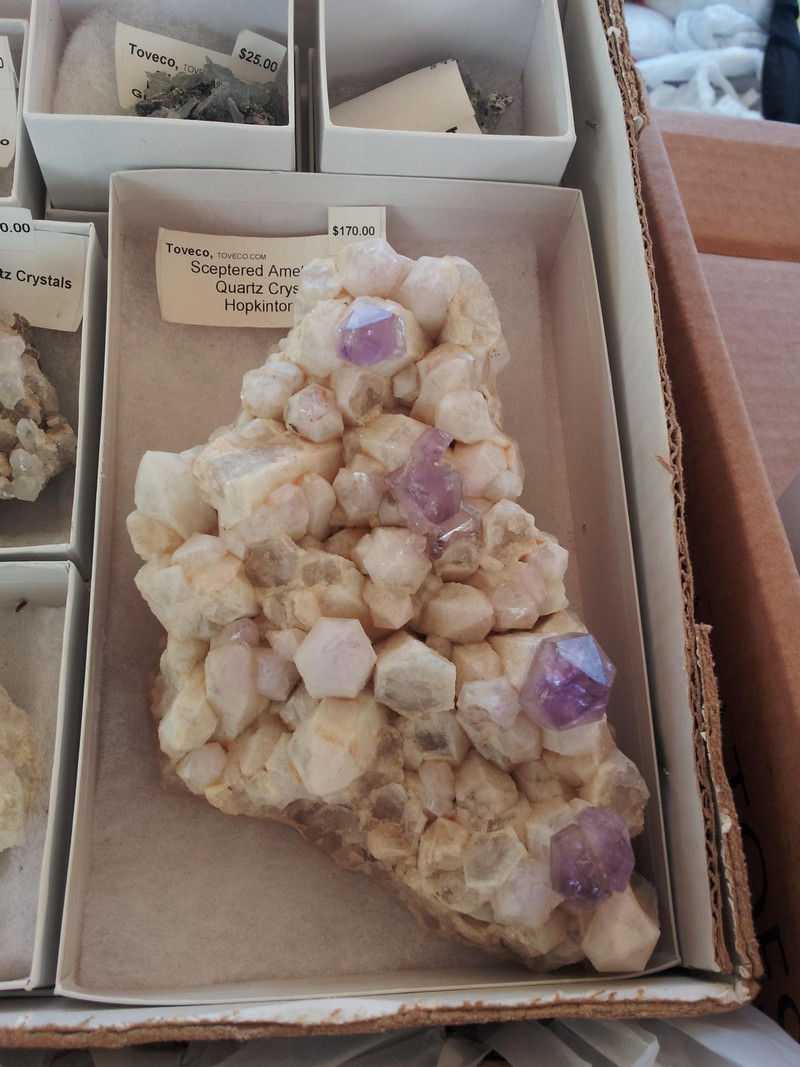
Jim Tovey of Toveco had several specimens of amethyst from Hopkinton, Rhode Island at his booth. This large cabinet specimen was probably the best of them
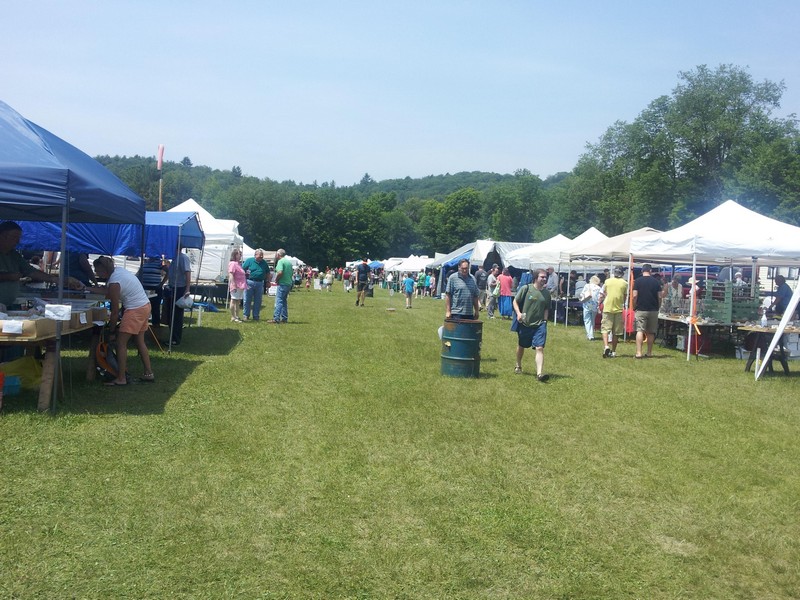
The 49th Annual Gilsum Rock Swap was yet again a great event! Although it was not as busy as it has been in previous years, it was still a lot of fun. Some pros: strong emphasis on locally sourced material and a great place to talk to other collectors to learn about New England mineralogy and mineral collecting. Quaint, peaceful setting in a small New England town. Cons: There were no booths primarily focused on swapping despite the name. In previous years, the show sponsored collecting trips to local pegmatite mines. Now unfortunately, most if not all the pegmatite mines in the vicinity of Gilsum are technically off limits to mineral collecting. You can buy maps to many of these localities at the show but you can’t actually visit most of them. I’d like to see accessibility to these localities change in the future. Celebrating the local pegmatite mines is the reason why there is a mineral show in Gilsum, after all.
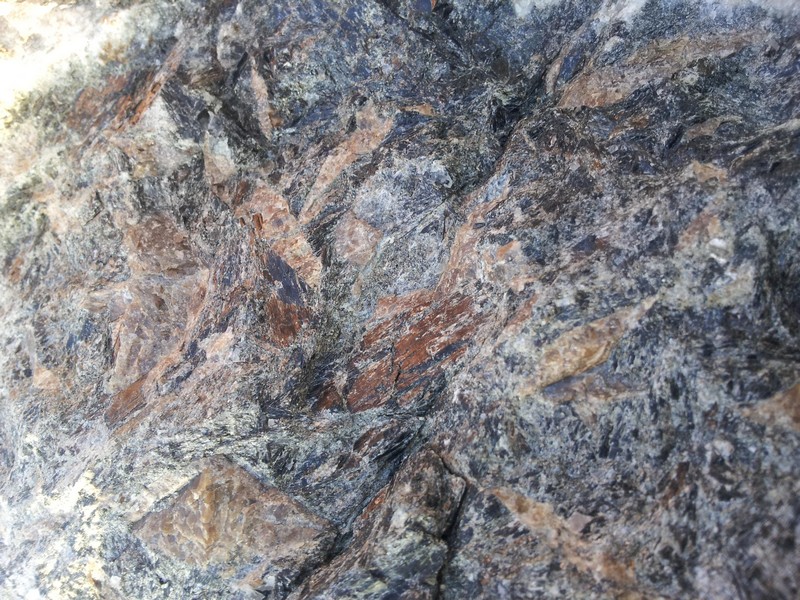
On my way home to Connecticut, my collecting partner Mike, and I found a new locality for titanite crystals at a large construction site near Waterbury, CT. Above you can see many orange brown titanites to 4cm in a coarse grained amphibolite matrix. They were also granules of purple fluorescent scapolite associated with the titanite. I just thought I’d throw this picture into the report because it was such an interesting find!
Here at Wheretofindrocks.com, we encourage all of our visitors to visit a local rock show! You can be sure, there is one around your area at some point in the year! Check out the BEST Rock and Gem Calendar online on The-Vug.com
Related posts:
When the weather is warm, St. Lawrence County is one of our favorite New York Locations for collecting!
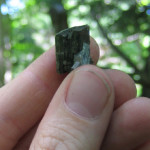
Thinking about the East Coast quite a bit, our minds are set on the display cases for the NY/NJ mineral show in Edison New Jersey, April 12-14. We found ourselves involved in organizing all of the cases, nearly 50 six foot tall wall cases, filled with great minerals from the NorthEast, New York, New Jersey and Connecticut. The trees are blooming here in Southern California and it makes me wonder what it is like in St. Lawrence County, one of our favorite collecting regions in the United States. Well, as of the end of March, 2013, it looks like Potsdam is still getting the occasional snow flurry. So, keep an eye out for days of sunshine and take a trip to St. Lawrence County, a real wonderland of minerals.
The-Vug.com published an issue of their printed magazine on St. Lawrence County and Chester County Pennsylvania, two diversely mineralized areas popular to collectors of the 1800’s. Because of the remoteness of St. Lawrence County, many of the locations for collecting are still available to collecting. Specifically, the deposits on Selleck Road and Power’s Farm, located a short distance from the college town of Potsdam, offer interesting crystals to those who make the trip.
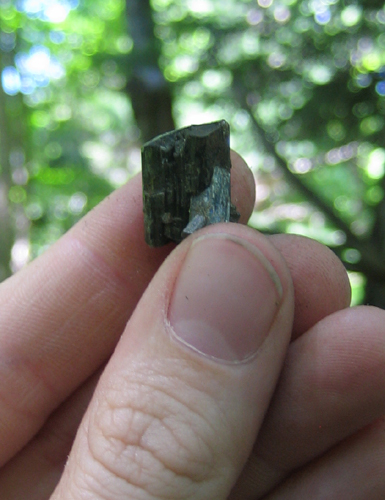
Tremolite from Selleck Road
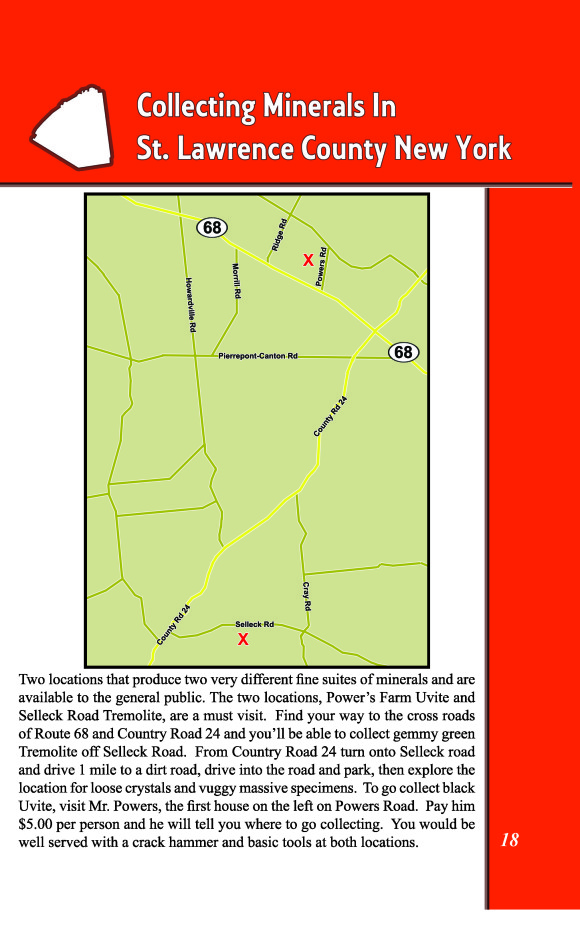
The Tremolite is abundant and easy to collect, you can simply roam the forest floor and find several different styles of crystals. The more uncommon find at this location is the brown dravite tourmaline crystals. Either way, I would enjoy spending another day or three at this location.
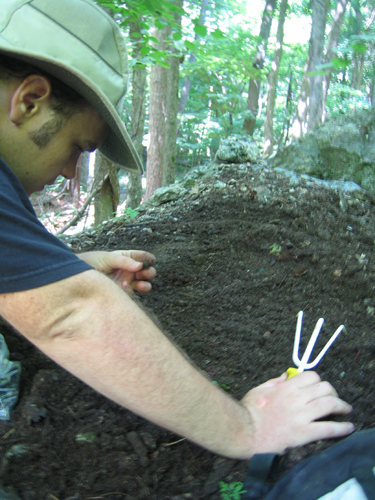
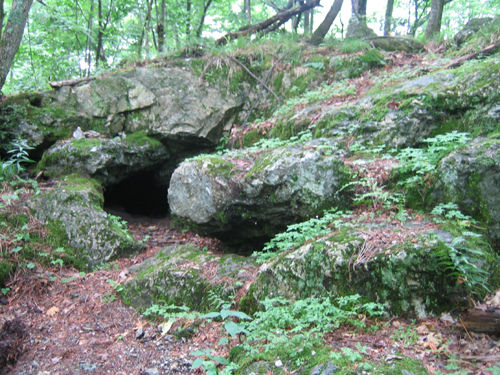
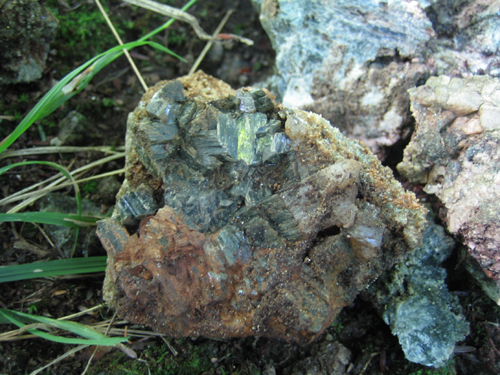
To the north a few miles, Power’s Farm is the home to one of the most famous New York locations, the classic black Uvite tourmaline crystals are found.
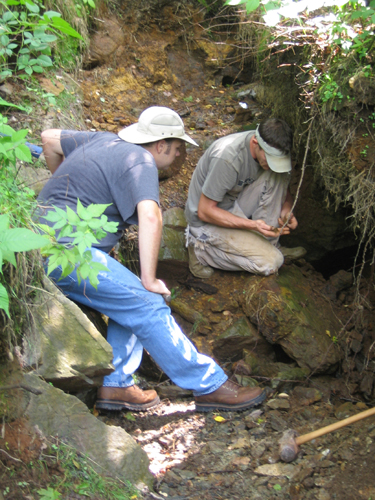
You can read more about it in the book reprint of The-Vug.com Magazine, which is available for purchase at this link, it is very colorful and inexpensive!
You can read that issue, online, hosted by WheretoFindRocks.com by clicking the magazine cover.
Hotel rooms in Potsdam are available on Hotels.com, a great town to visit!
Related posts:
“liquid-like magnetic flow” found in the mineral Herbertsmithite
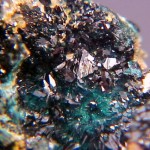
Quantum Spin Liquid, a third type of magnetism, was demonstrated in December of 2012 by a team at MIT, in the form of synthetic herbertsmithite. Herbertsmithite is believed to be a two-dimensional quantum spin liquid: a solid material whose atomic spins continue to have motion, even at absolute zero temperature. This exciting research has potential to improve technology, another wonderful scientific advance related to the study of mineralogy. While this form of magnetism is limited to the pure synthetic herbertsmithite, the minerals found in nature are quite interesting in their own right.
We noticed a beautiful example of this rare mineral available on eBay by the seller MineralMan999. This sample shows some big crystals for the typical material.
You can use this link to search for samples of Herbertsmithite on eBay
This uncommon Copper Zinc Hydroxide Chloride named to honor Dr. G. F. Herbert Smith (1872-1953) of the Natural History Museum, London, England, who discovered the mineral paratacamite.
The blog “Nanoscale Views”, written by Douglas Natelson, had the best article about understanding quantum spin liquids in a easy to digest fashion. On the subject of the experiments,
So what did the experimenters do? They grew large, very pure single crystals of herbertsmithite, and fired neutrons at them. Knowing the energies and momenta of the incident neutrons, and measuring the energies and momenta of the scattered neutrons, they were able to map out the properties of the excitations, showing that they really do look like what one expects for a quantum spin liquid.
You can read his entire article HERE
